An International Tour organised in conjunction with our friends at Oriole Birding. We managed a record (for this tour) 266 bird species seen, plus another 5 heard only, in the space of just a week and only in coastal Gambia within easy reach of our base at one of the tourist hotels by the beach. A nice easy introduction to West African birding. If you like what you read, we already have dates for 2024 – you would be very welcome to join us next year!
FRIDAY 17TH NOVEMBER – Hazy sunshine, 34C
We met at Gatwick at 6am, in good time for our 8.30am Titan Airways flight down to Banjul. The plane was a little late leaving due to problems with congestion at the airport, but we made up time on the flight and landed at 2.40pm, twenty minutes ahead of our scheduled arrival time. As we came into land, we passed a few Hooded Vultures and taxiing to the terminal our first Speckled Pigeon flew past and there were lots of Little Swifts around the building. There was a bit of a queue inside to pay the airport tax, but by the time everyone was through security, our bags were all waiting for us.
We were soon on board the air conditioned coach and on our way to our accommodation at the Senegambia Beach Hotel. The new road to the airport is still not finished, but large sections of it are at least now open, and traffic just diverts onto the red dusty side roads to get round the sections which haven’t yet been completed. On the journey, we saw more Hooded Vultures, Yellow-billed Kites, Pied Crows and Speckled Pigeons, with Laughing and Red-eyed Doves on the wires, to get our trip list started. A couple of Green Monkeys were hanging around the entrance to the resort where we dropped off another couple before we got to ours.
We checked in and had a short time to get ourselves sorted out, before we met up with our local guide for the first couple of days, Modou Taal. We had an hour or so to explore the extensive hotel grounds before it started to get dark, and even though it was hot, it was nice to get out birding after a long day travelling. There were so many new birds, it was hard to keep up at times! We got a proper look at some of the raptors, pigeons and doves we had seen earlier from the coach and added Common Bulbuls, Beautiful Sunbirds and White-crowned Robin-Chats.
The area by the hotel wall was particularly productive – a flock of Long-tailed Glossy Starlings which came down onto the grass was joined by Greater Blue-eared and Bronze-tailed Starlings, and our first Broad-billed Rollers were perched in a tree above us. Lots of birds were coming down to drink in a small culvert and included our first Red-billed Firefinches and Blue-cheeked Cordon-bleus, African Thrush and a Mourning Collared Dove. A pair of Western Red-billed Hornbills were feeding young in a hollowed out palm trunk, two Northern Black Flycatchers were swooping out of the trees and a Hamerkop perched obligingly on the wall.
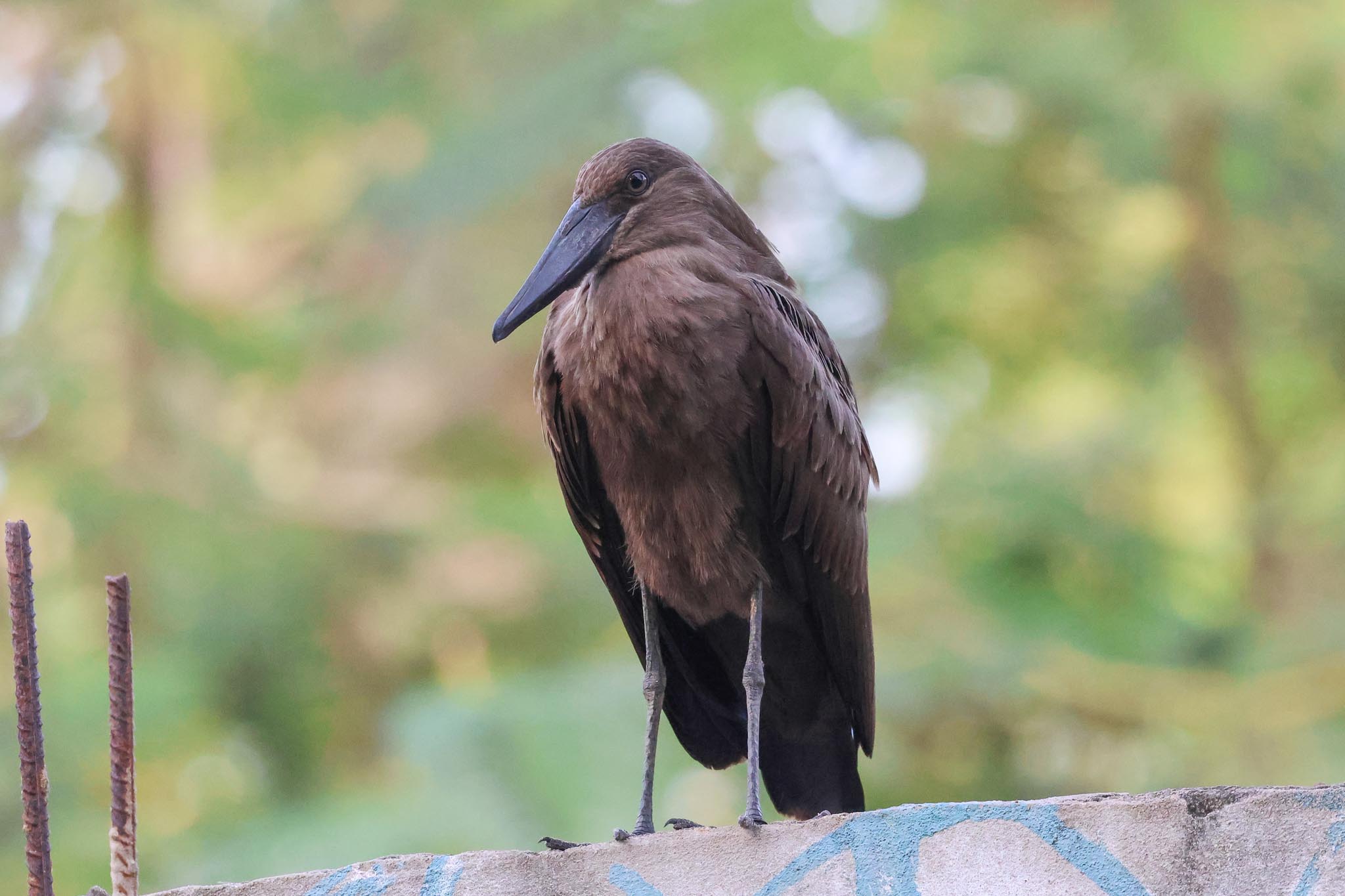
A young African Harrier-hawk flew over and then an adult perched nicely for us on the top of the fence. A flock of White-faced Whistling Ducks flew round over the trees beyond the wall and a few African Palm Swifts hawked back and forth overhead. Continuing round, we added a small flock of Blackcap Babblers feeding in the grass, followed by a Woodlark Kingfisher which eventually posed nicely. We rounded it all off nicely with a Yellow-crowned Gonolek in the trees on the other side of the compound.
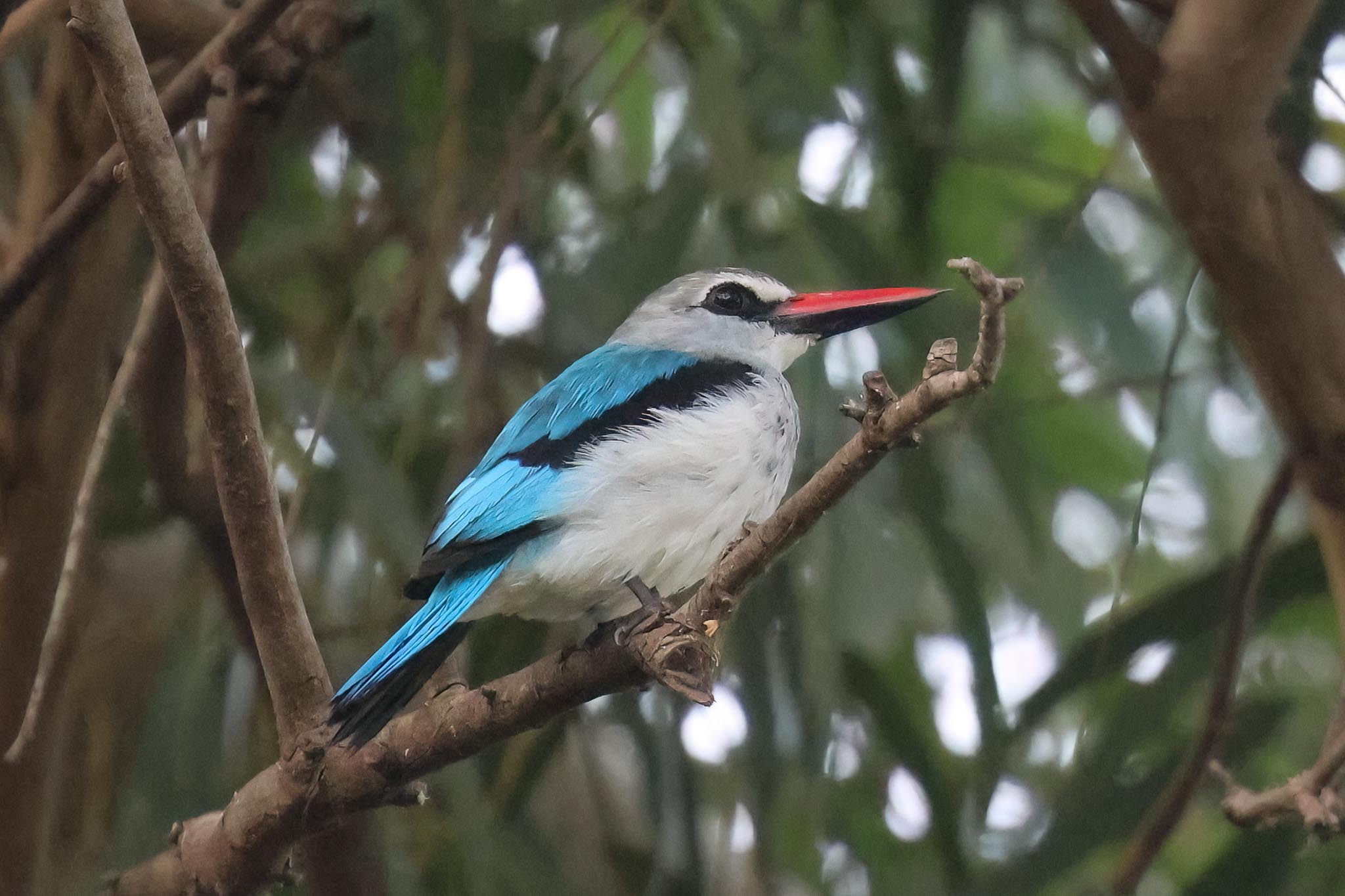
We had a chance to change some money and buy some bottles of water now and then retired to our rooms for a short break to freshen up. We met again for a quick drink before dinner down by the pool, a wide selection of different dishes at the buffet. It had been a long day, so after a quick run through of the day’s list up by the bar, we retired for the night.
SATURDAY 18TH NOVEMBER – Hazy sunshine, light breeze, 36C
We met at 7am for breakfast, as the restaurant opened – it is important to get away and make the most of the cooler early morning hours here, before it gets too hot. After breakfast we met Modou again outside the hotel along with our bus and driver who would be with us for the next few days. It was just a short drive down to Kotu, but with a new road being built here now there was more traffic to negotiate along the bumpy verges. A couple of Blue-bellied Rollers were on the wires by the road.
We disembarked just before the bridge and stopped to scan the fields. A large flock of Village Weavers came up out of the rice, there were several Bronze Mannikins and a couple of Zitting Cisticolas in the near edge of the fields and a Fanti Sawwing flying round in front of the mangroves just behind. A Spur-winged Lapwing was calling noisily behind us, a Woodland Kingfisher was perched in a bush and various doves were feeding on the dusty verge. A couple of Senegal Coucals flew past and looking up, an African Darter circled over, its long, snake-like neck stretched out in front.
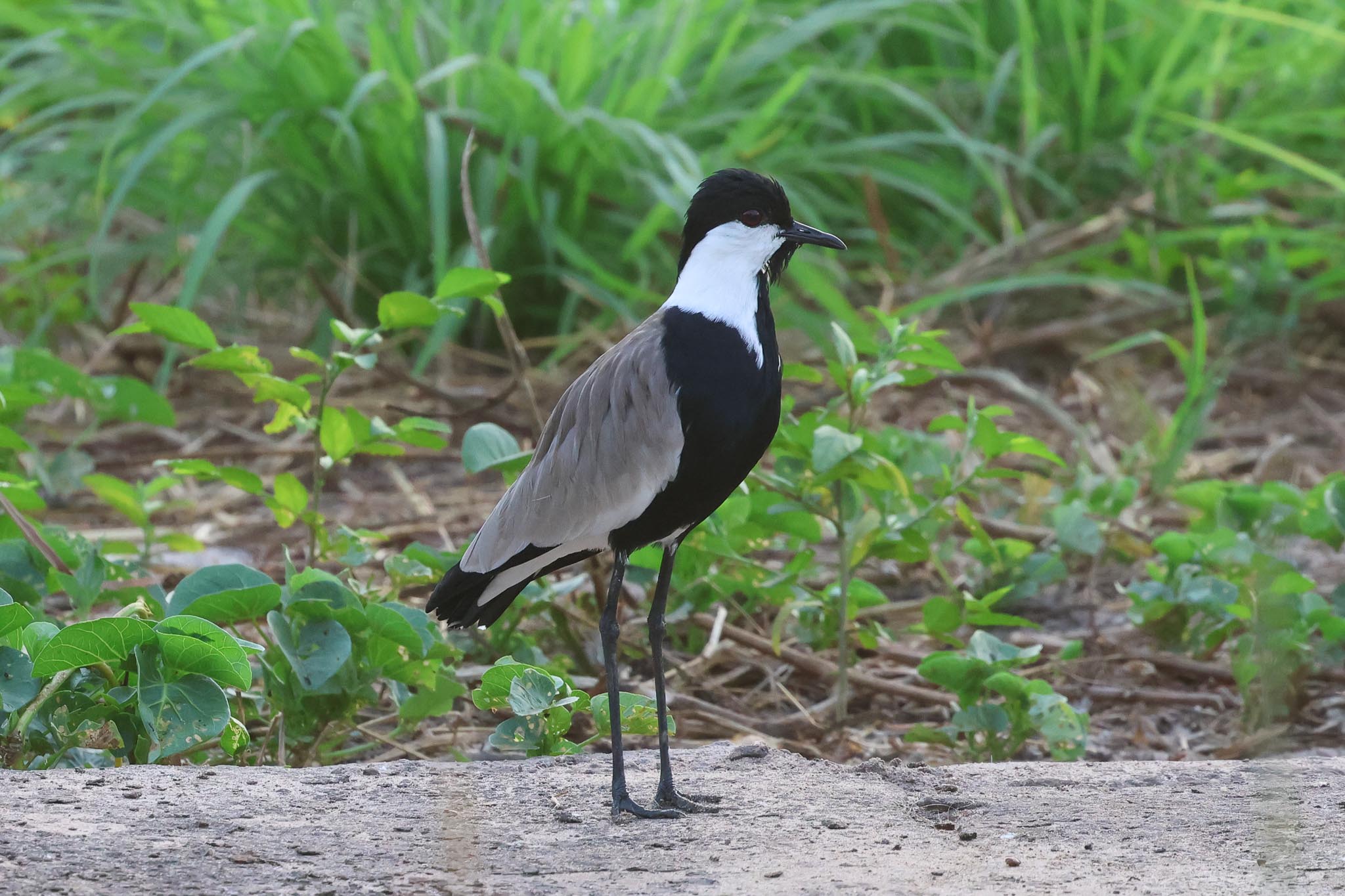
We walked the short distance on down to the famous Kotu bridge, where immediately we could see several Pied Kingfishers and a much smaller Malachite Kingfisher perched on one of the posts in the water. A monster of a Giant Kingfisher then flew in and right past us, over the road, and a Blue-breasted Kingfisher landed on the pipe across the creek just behind us. Five species of kingfisher already, and it wasn’t even 8.30am!
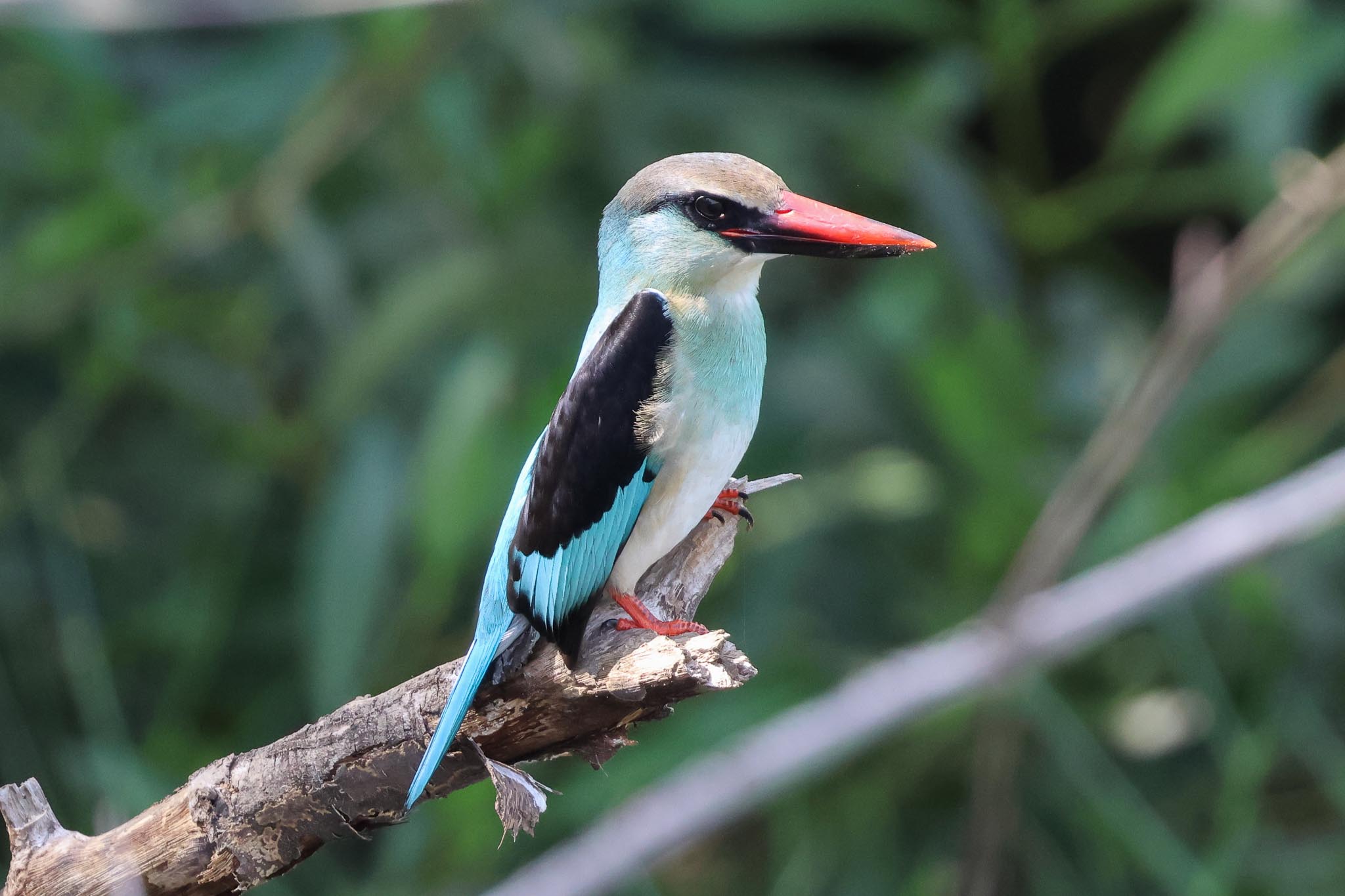
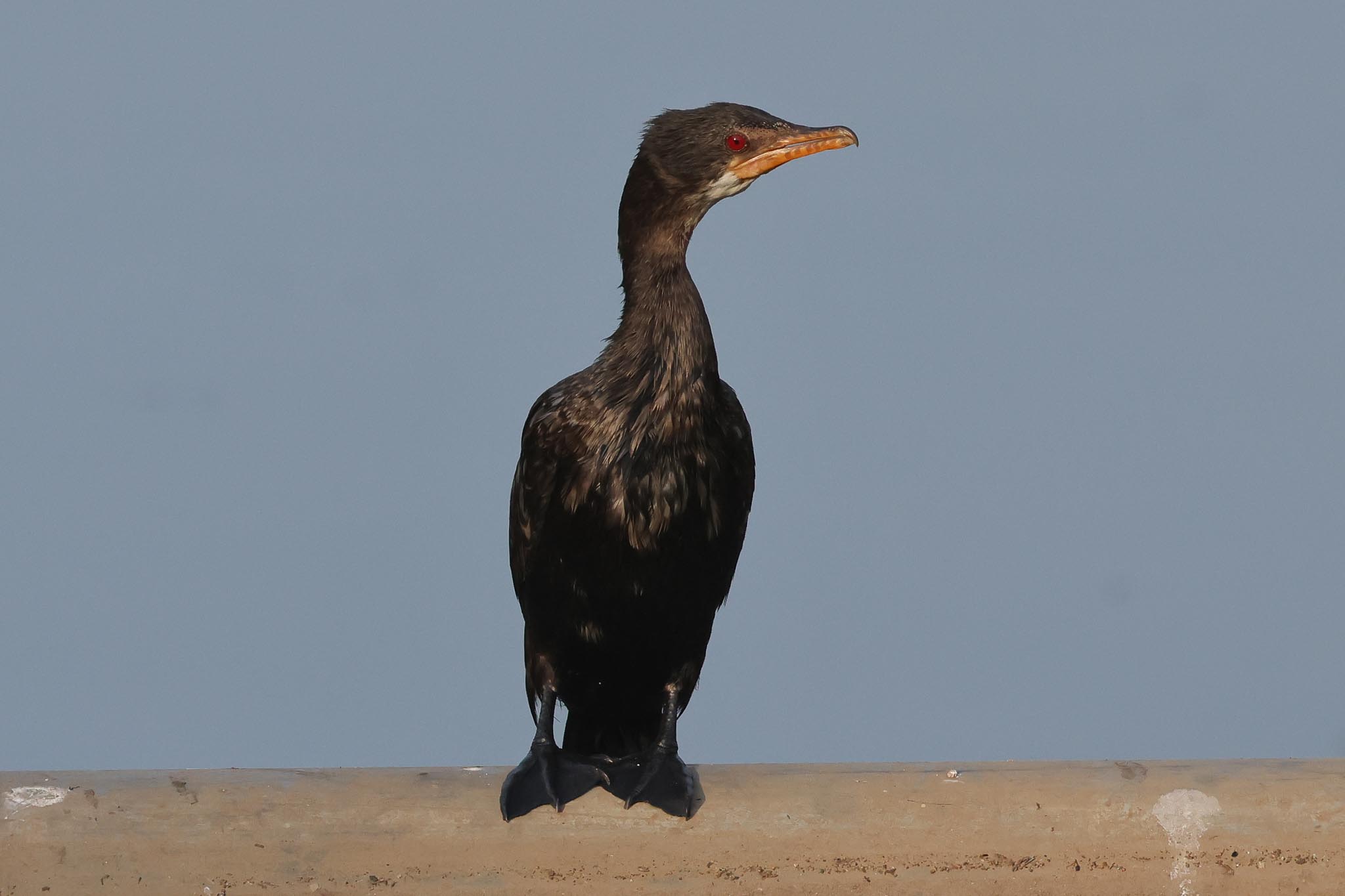
There was a nice selection of waders on the mud here too – several Whimbrel, a couple of Greenshank, a Grey Plover and a Common Sandpiper, all Palearctic migrants, our first reminder that many of the birds we see at home in the summer months come here for the winter. We saw our first Senegal Thick-knees too, and a couple of Black-winged Stilts flew over. A couple of Long-tailed or Reed Cormorants were swimming in the creek and drying their wings on the small dead trees and a Western Reef Heron was feeding on the edge of the mangroves. Several Wire-tailed Swallows were perched on the wires above us and hawking round over the water and a Red-chested Swallow flew past.
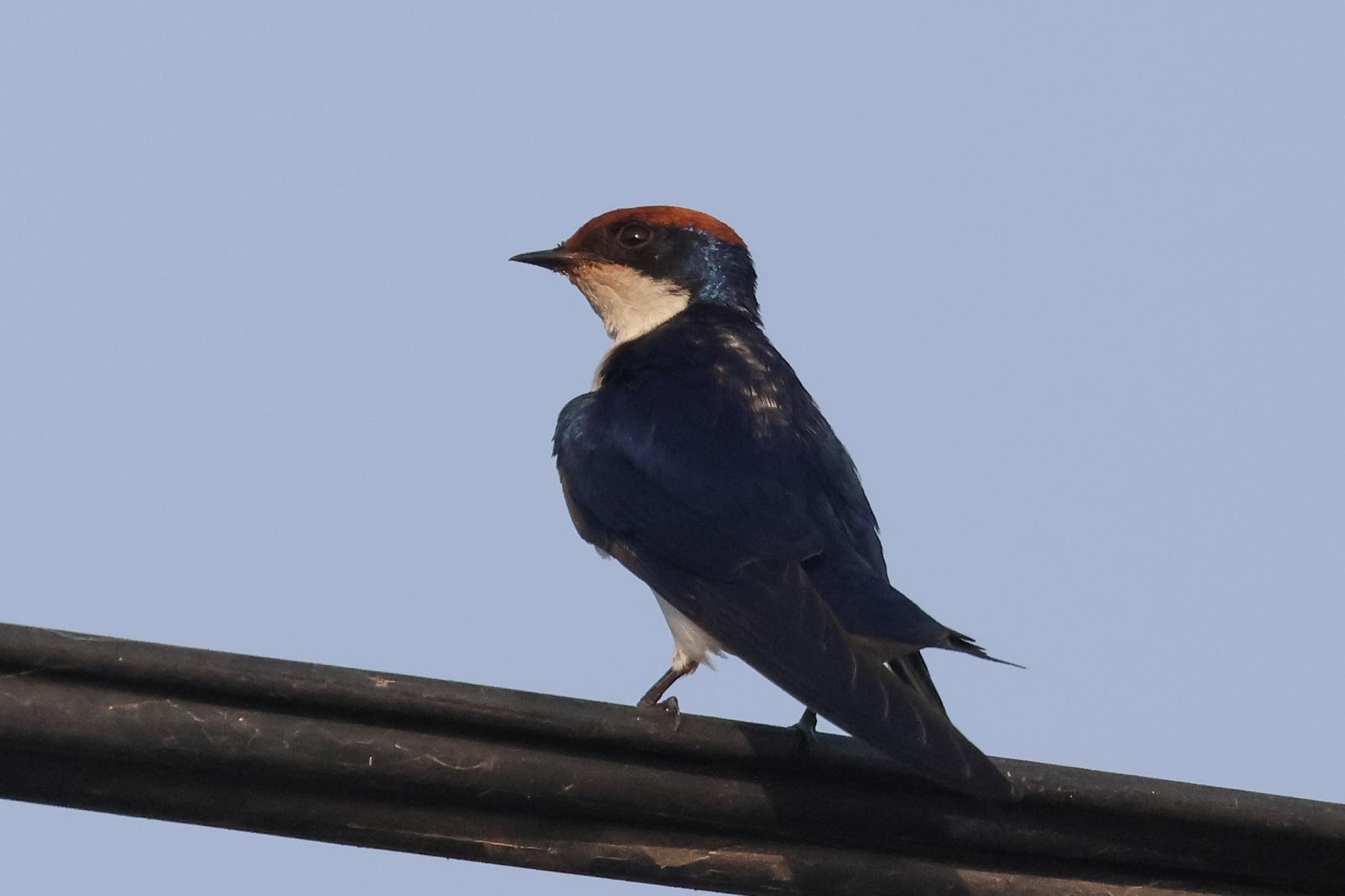
Walking back to where the bus had dropped us off, we took the small nature trail which goes in through the edge of the mangroves. We could hear Oriole Warblers calling, but couldn’t see them. Then on the edge of the mangroves, Modou heard a Golden-tailed Woodpecker so we stopped to see if we could find it. At first, it remained well hidden but with a bit of perseverance it eventually flew in and landed in the top of the mangroves and then up onto a nearby palm trunk. A scarce species here. When we eventually moved on, a couple of Little Bee-eaters were perched in the mangroves just beyond and a pair of Oriole Warblers finally showed themselves too.
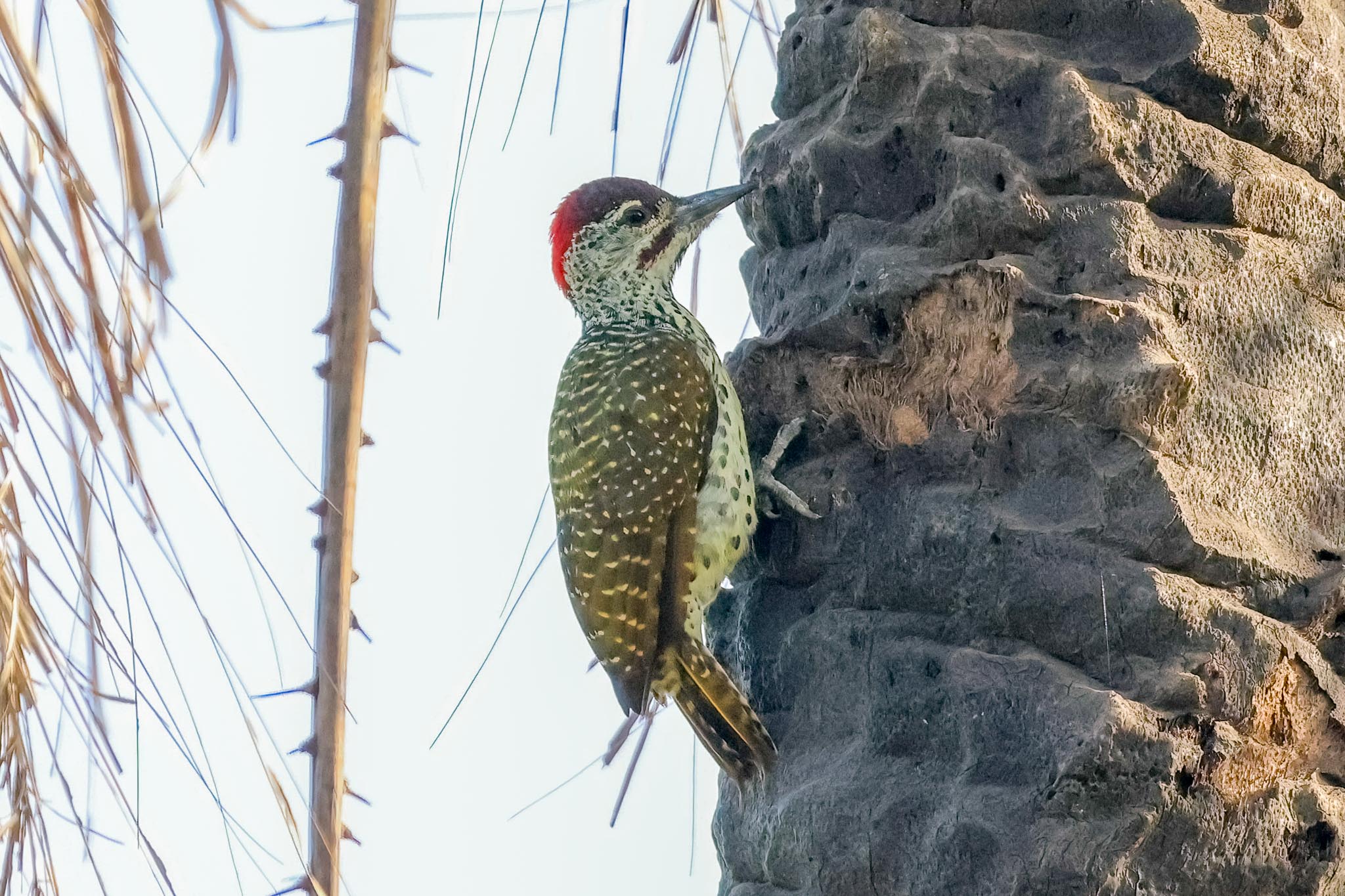
Continuing up through the open scrub, small groups of Ring-necked Parakeets flew past calling. We stopped by a big tree to look at a Grey Woodpecker and a Fine-spotted Woodpecker which were both in the branches, and a pair of Bearded Barbets and then a Senegal Parrot appeared too. A couple of Levaillant’s Cuckoos flew round and eventually landed in the tops of the bushes and were followed by a pair of Yellow-crowned Gonoleks and a Fork-tailed Drongo.
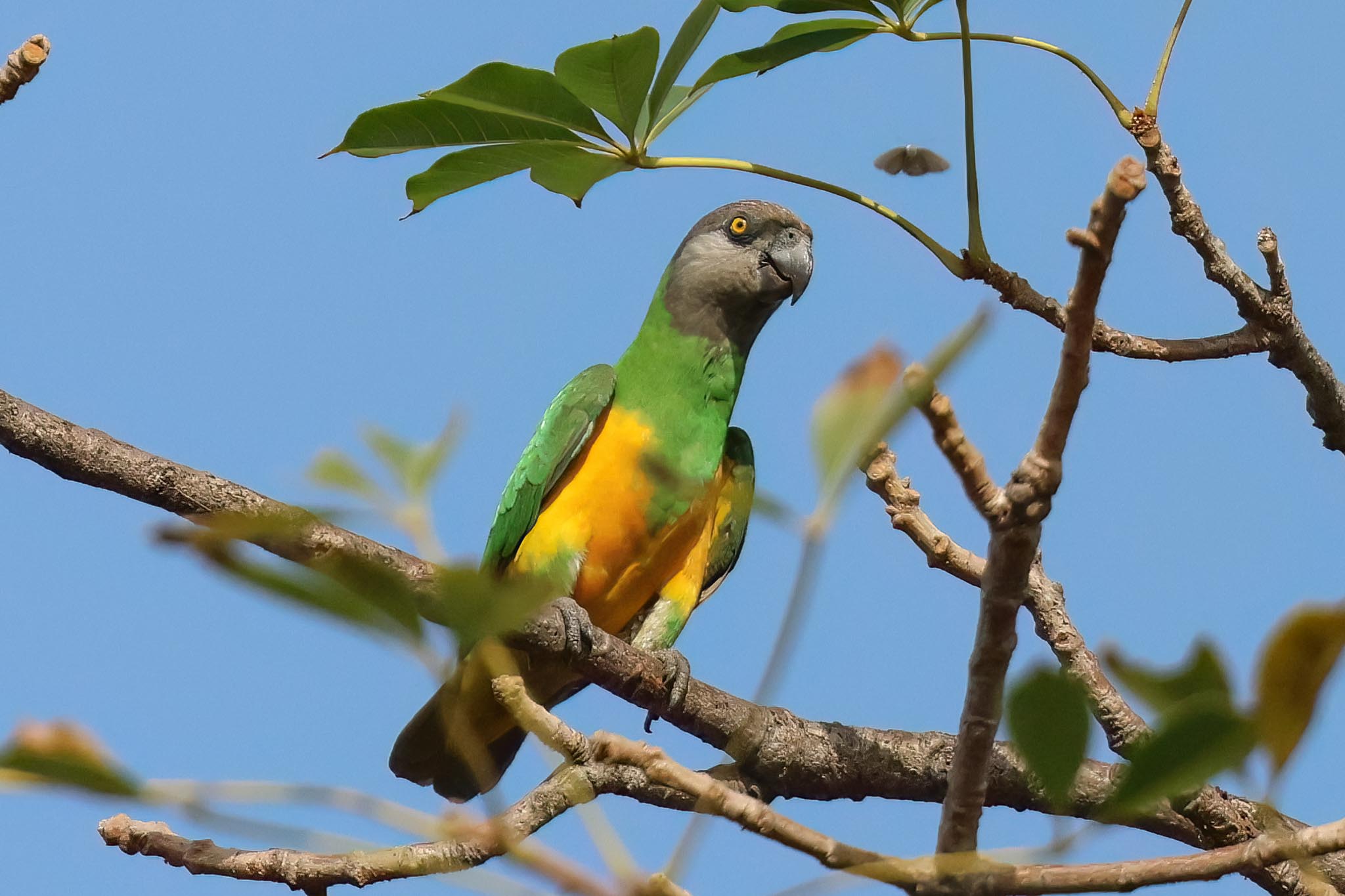
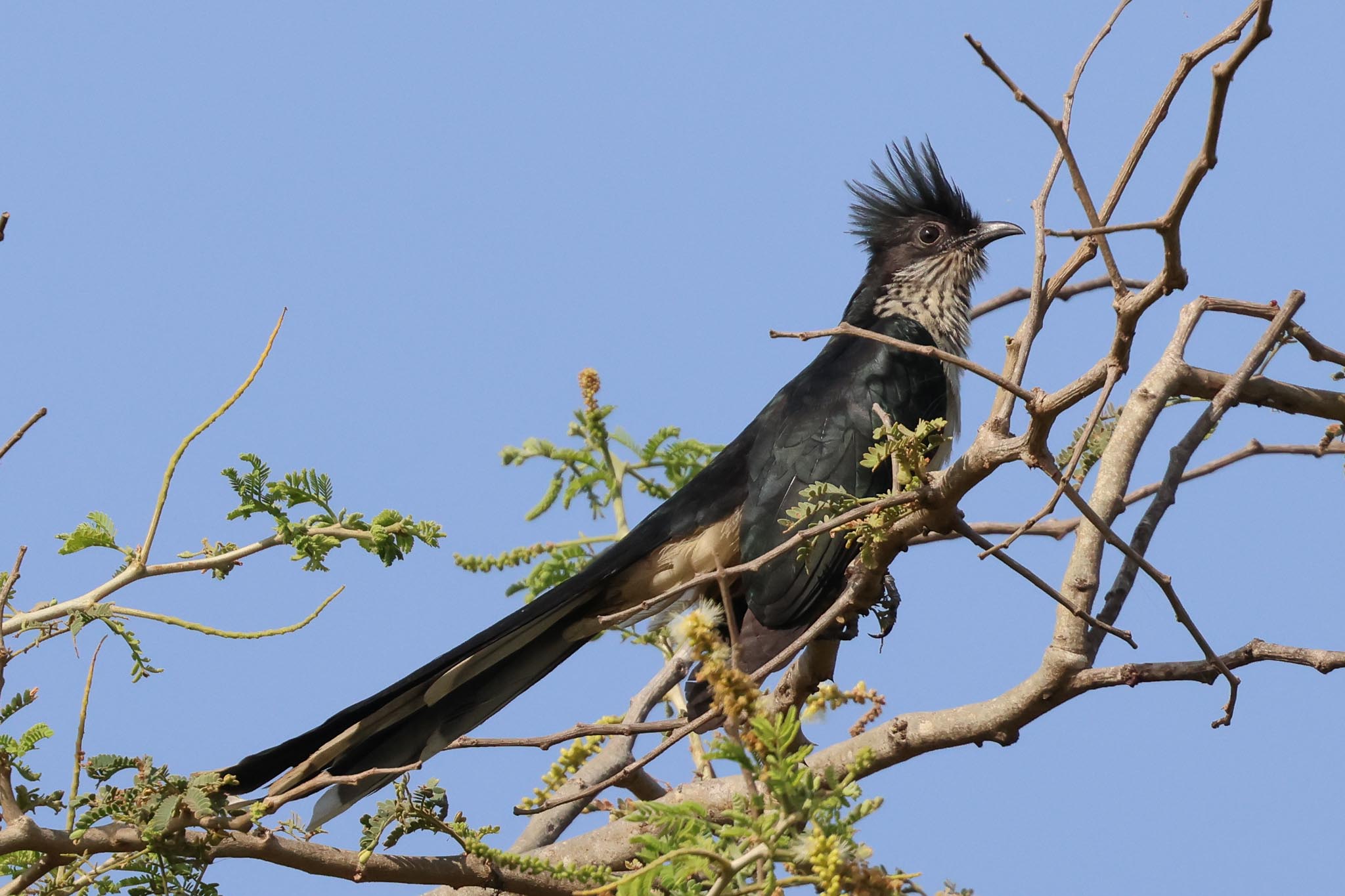
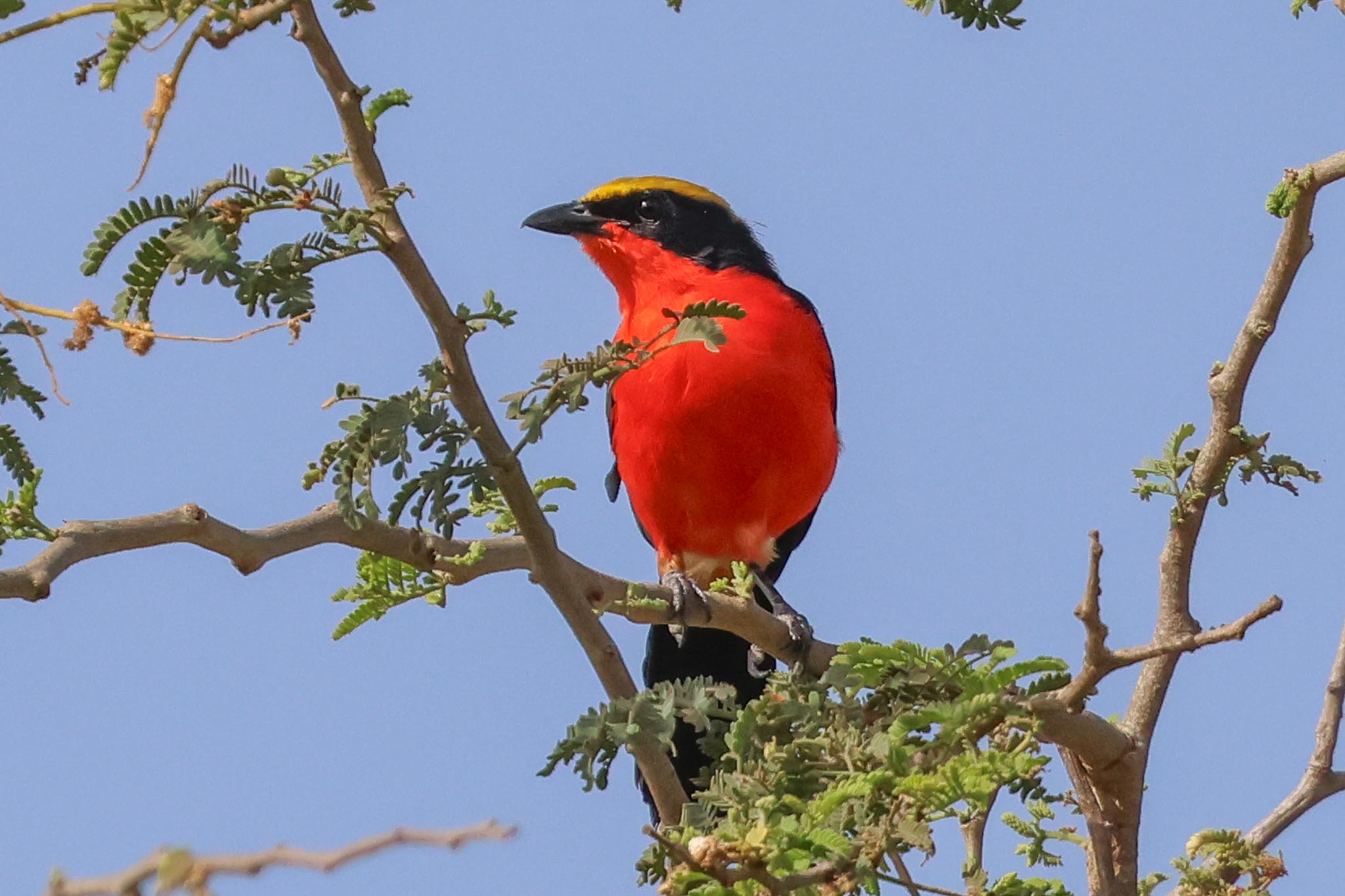
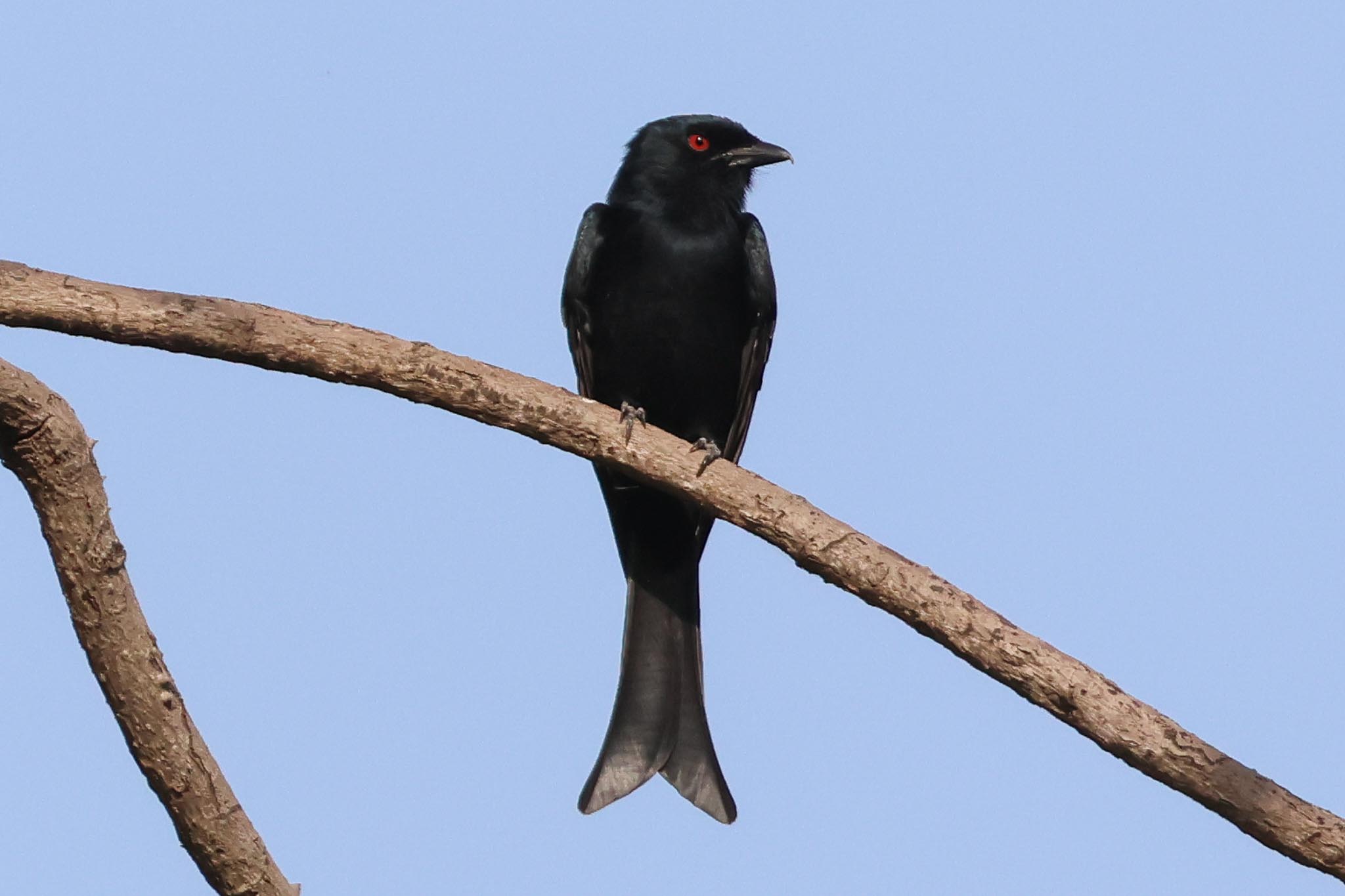
It was beginning to warm up now and the ubiquitous Hooded Vultures and Yellow-billed Kites were starting to circle up. A Shikra appeared out of the bushes, closely followed by a second and then two more. They started to circle together, then chased each other into the trees, two landing in the same tree where the woodpeckers had been earlier and scattering all the other birds which had been in there. We had great views of an adult and juvenile Shikra in the scope now. A Woodland Kingfisher flew across in front of us, and the Shikras set off after it, chasing it out from the tree where it had landed and straight into the thick bushes right behind us, with one of the Shikras still in close pursuit!
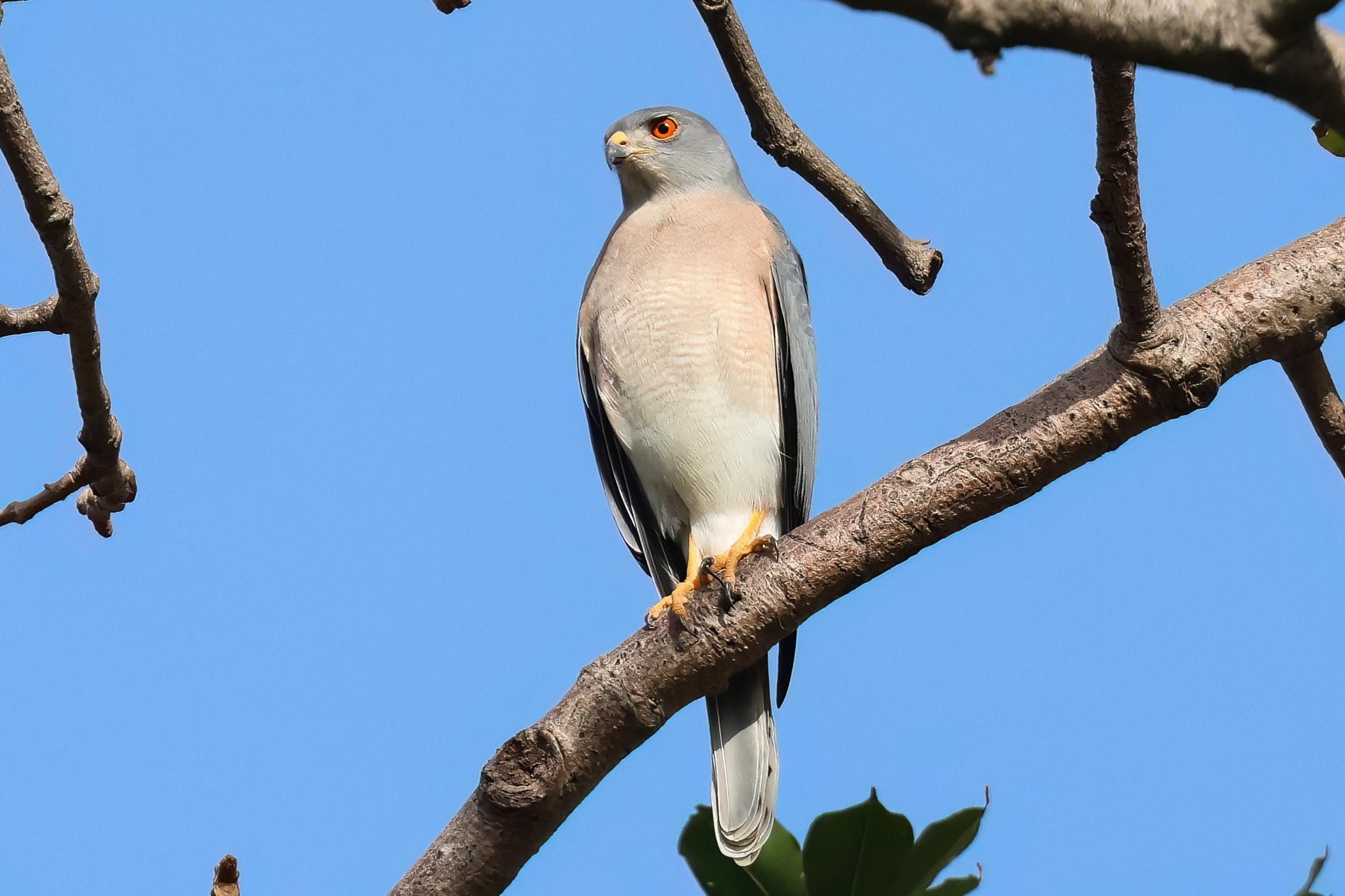
Into the trees further up and another Blue-breasted Kingfisher posed nicely in the shade, then we walked up through the cultivations and out into the sewage works beyond. There were lots of butterflies and dragonflies in the vegetation and lots of Spur-winged Plovers on the bunds. One of the settling pools was full of water and dozens of Little Swifts were flying over and dipping down to the surface to drink.
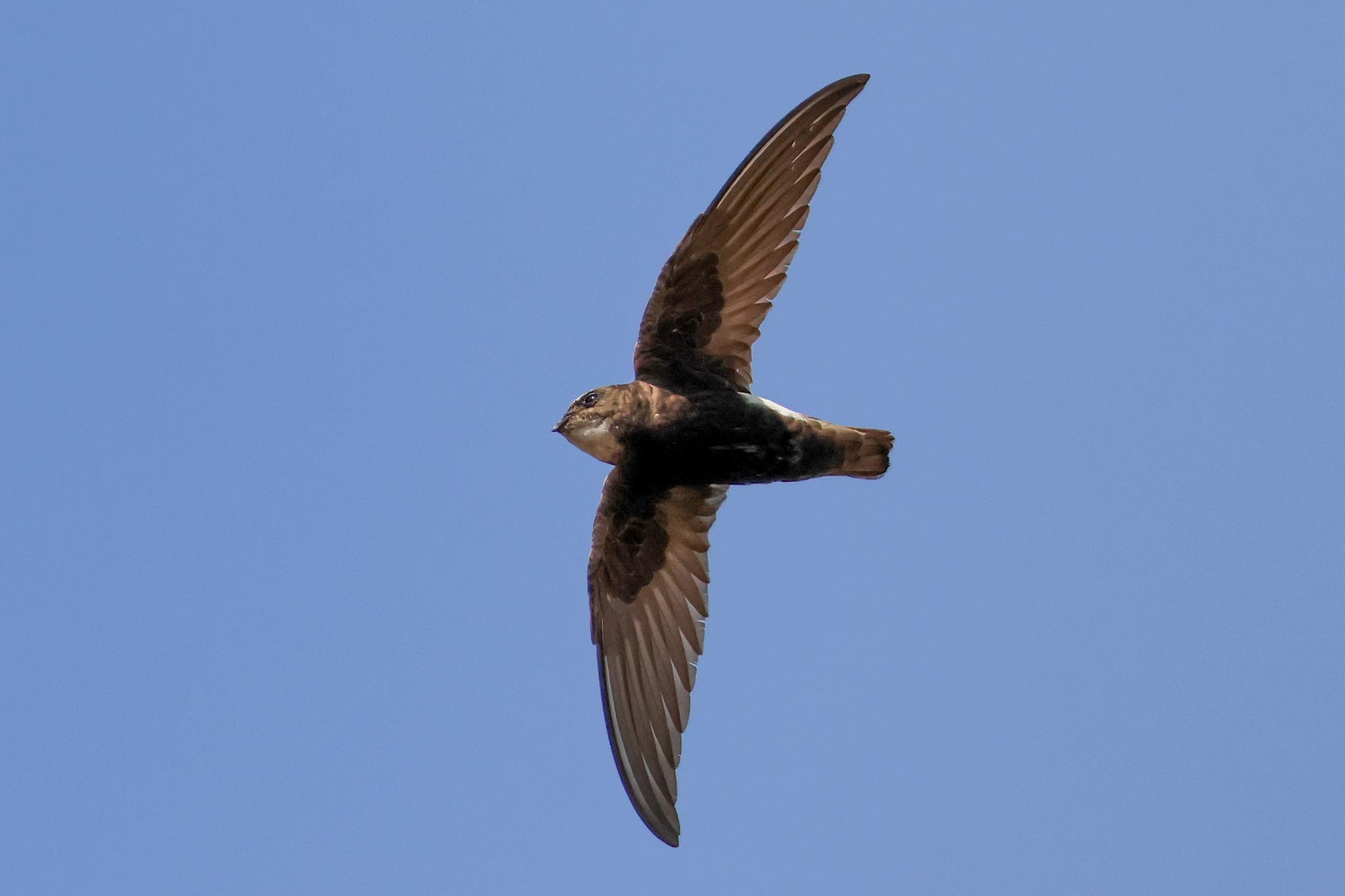
More Black-winged Stilts and a couple of Common Sandpipers were along the concrete edge at the back. In the empty and vegetated pool the other side of the bund, a young African Jacana was walking around in the flowers. Modou heard a Klaas’s Cuckoo and we could see it distantly in the trees across the pools. He whistled it in and after a couple of passes overhead, it landed in the top of a bare tree much closer to it, great views of its shining metallic green upperparts in the sunshine.
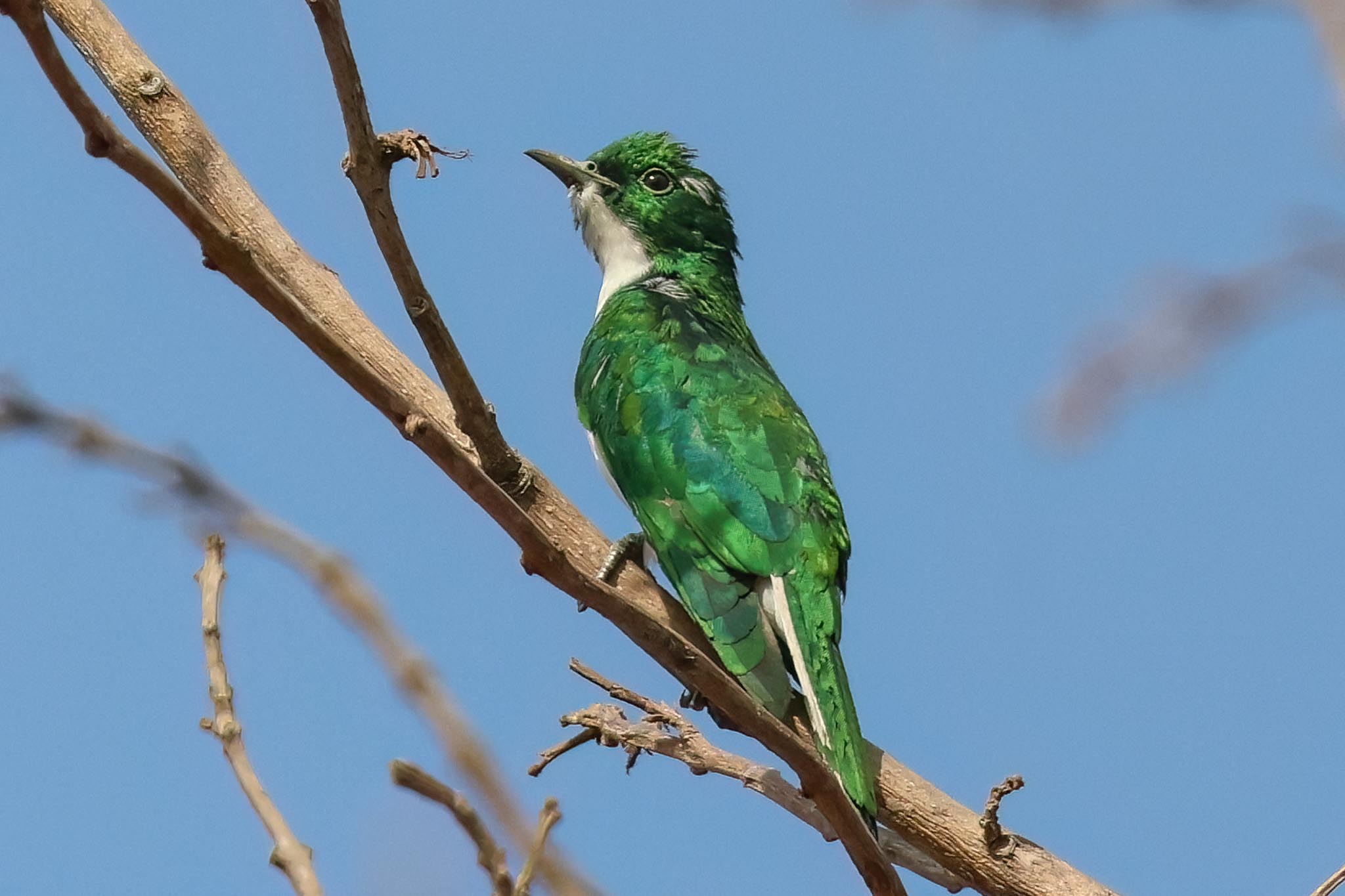
As we walked back towards the road, we stopped in the trees and a bit of whistling produced replies from two Pearl-spotted Owlets, one of which we found in the branches above the path.
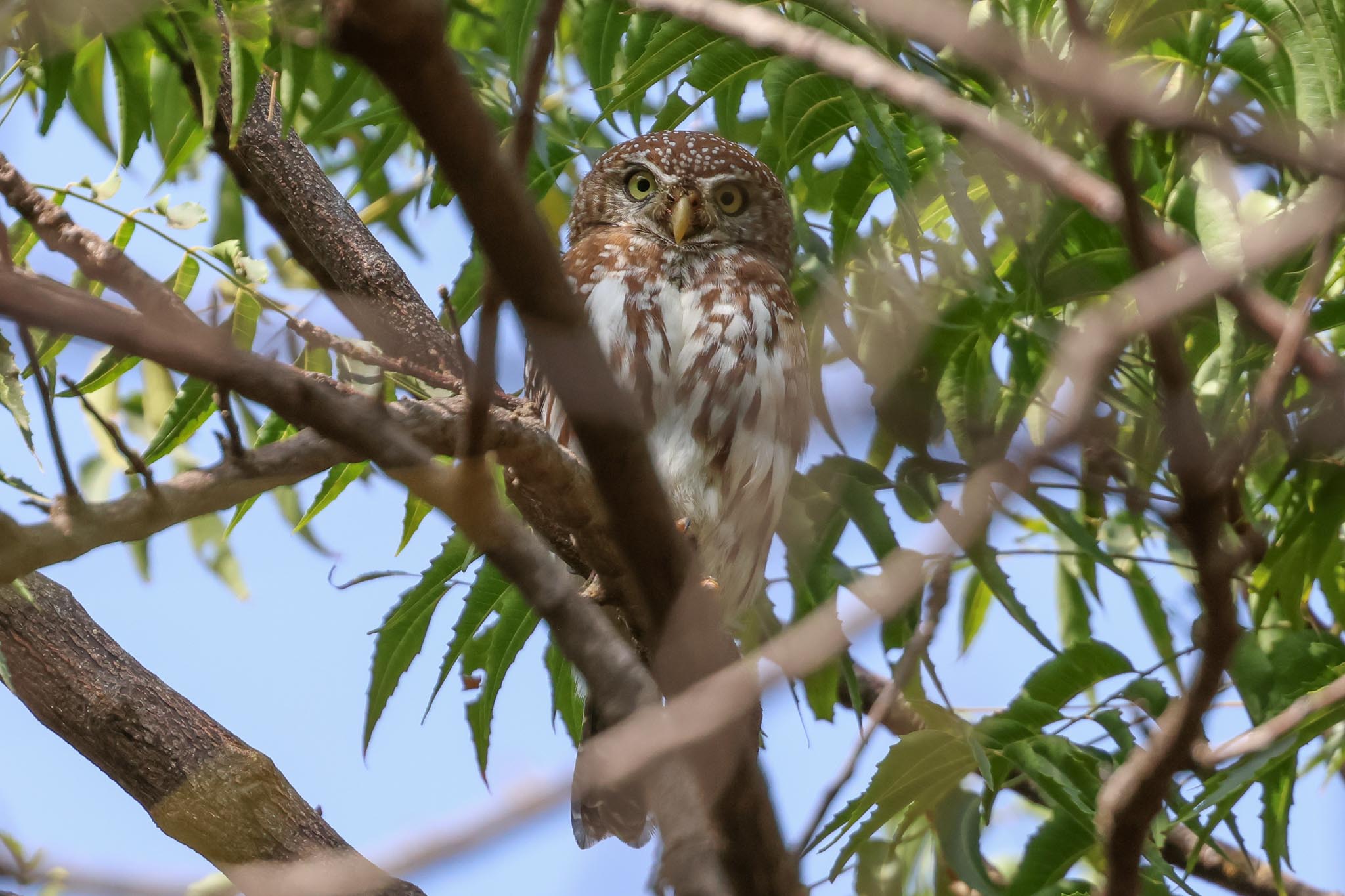
We walked down the road back towards the bridge. A couple of Green Monkeys ran across and first another Shikra and then an Osprey appeared with the cloud of circling Yellow-billed Kites. Down at the junction, a Hamerkop was in one of the fields. A couple of Agamas were on the trunk of a tree and three Vinaceous Doves were on the wires beyond, and then a Yellow-fronted Tinkerbird called, and flew in behind us, landing in the tree next to the road. We could see the holes in the branch where it nests, exactly where we had seen it last year.
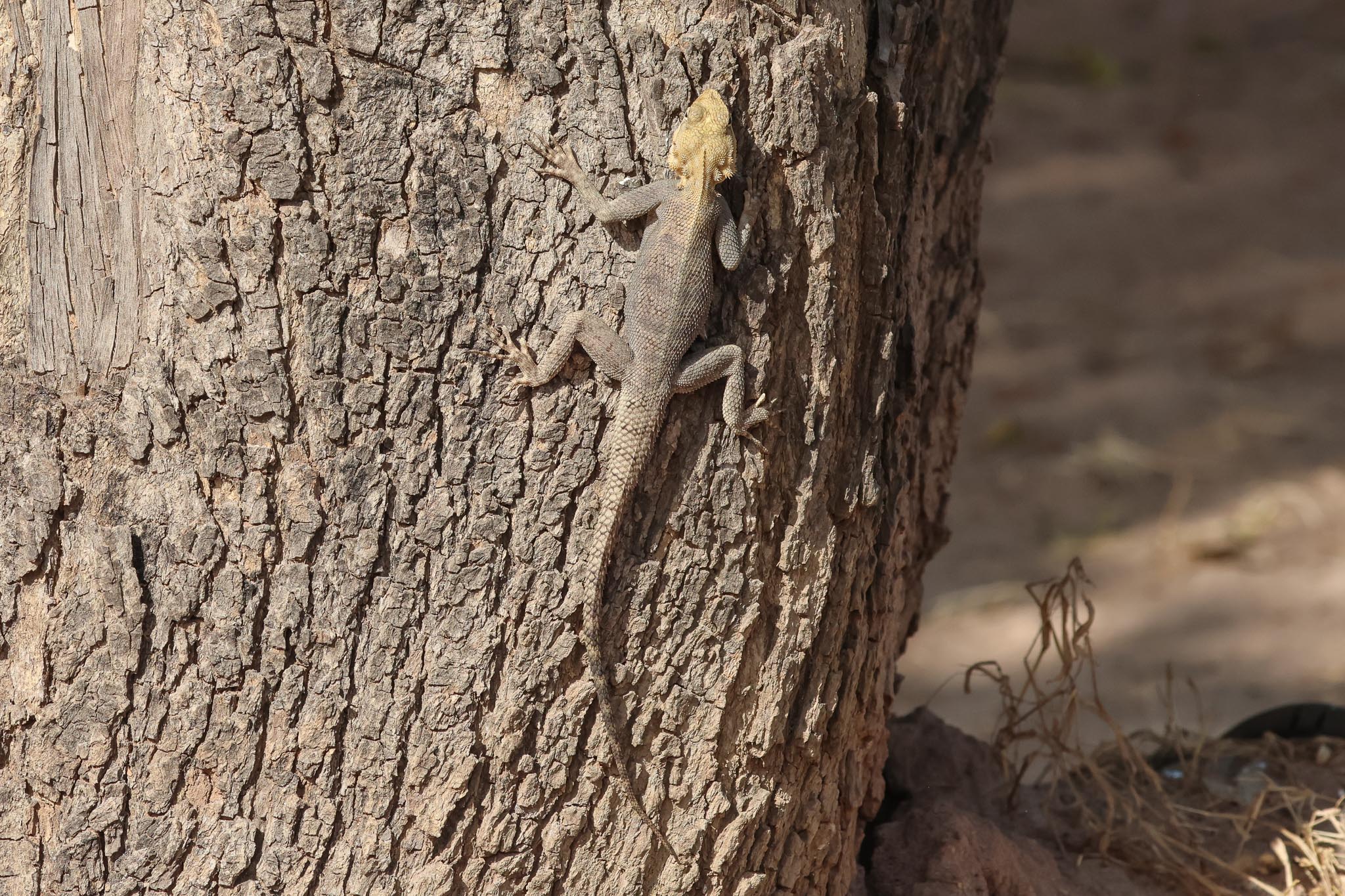
Down at the bridge, the tide had come in so there wasn’t as much to see now. A Black Heron flew over but dropped into the mangroves out of view and two Blue-cheeked Bee-eaters flew over high, calling. So, after a quick stop at the bus to refill our water bottles, we walked over to the start of the Cycle Track where a single Great White Egret was feeding out in the rice fields. Not far along the Track and a pair of Variable Sunbirds appeared in the trees, followed a little further on by a female Red-bellied Paradise Flycatcher above our heads. The vegetation was full of butterflies and several huge Citrus Swallowtails flew in and out of the bushes by the path.
When we heard Double-spurred Francolin calling nearby, we took a small path which cut down into the edge of the fields, but they flew up ahead of us and quickly dropped down again out of view in the rice beyond. Cutting in along another path, a small pool sandwiched between the Cycle Track and the roadworks has several rather incongruous large and brightly coloured models of animals in the water. There were a couple of Black-winged Stilts, a Greenshank and a Common Sandpiper on the muddy edges and a Western Reef Heron stalking the shallows. Back to the main track and a little further on, two Namaqua Doves were perched in a bush and didn’t seem to mind as we walked right past.
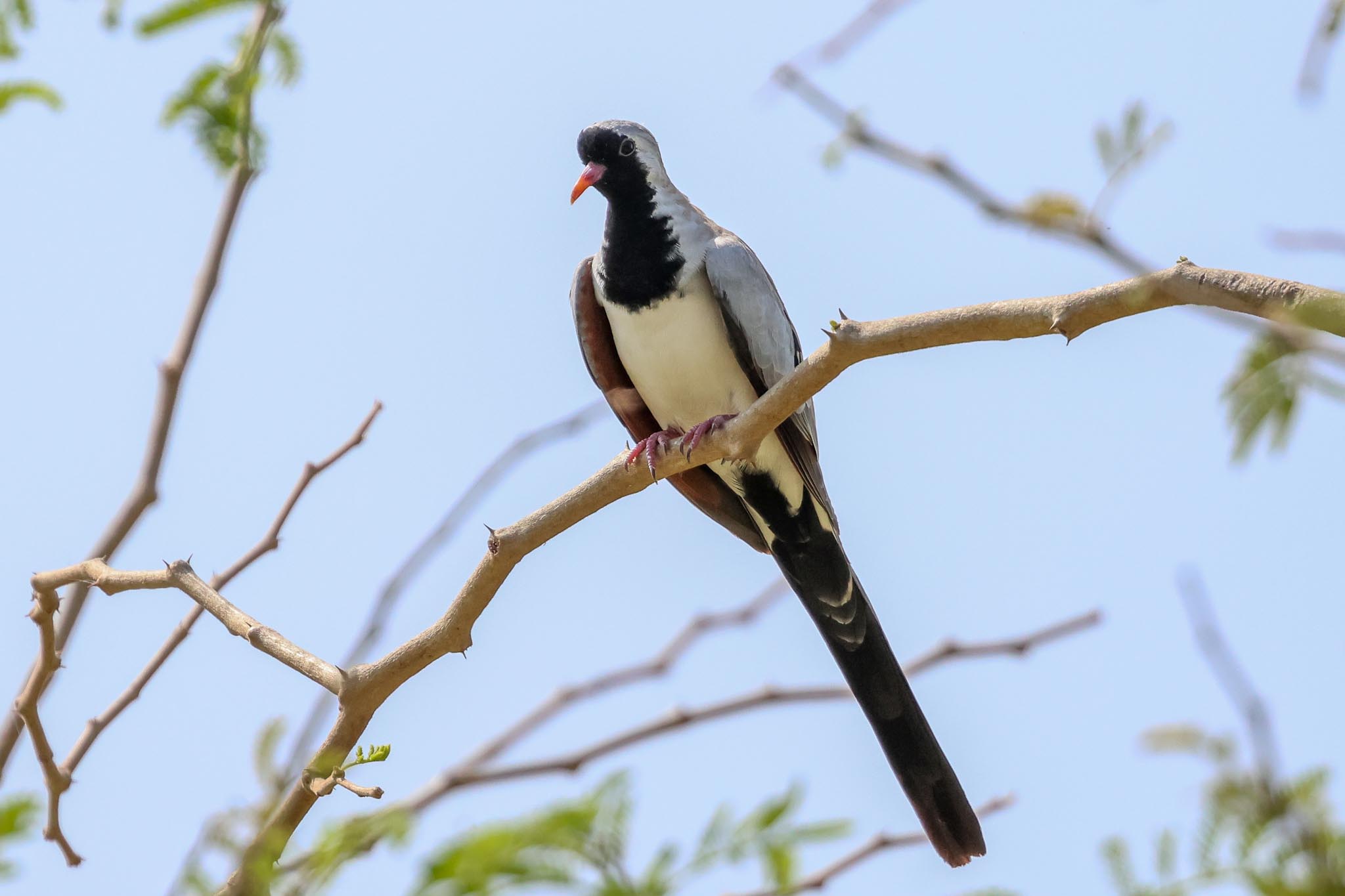
It was after midday already and getting quite hot now, so we turned to head back. We took a short detour down the track to the Palm Beach hotel – a Western Plantain-eater posed on a palm ahead of us and down at the end we scanned out over the beach to the sea beyond, where several Sandwich Terns and one or two West African Crested (formerly Royal) Terns were flying past in the distance and a White-breasted Cormorant closer too. Back to the bus and we made the short drive back to the Senegambia for lunch.
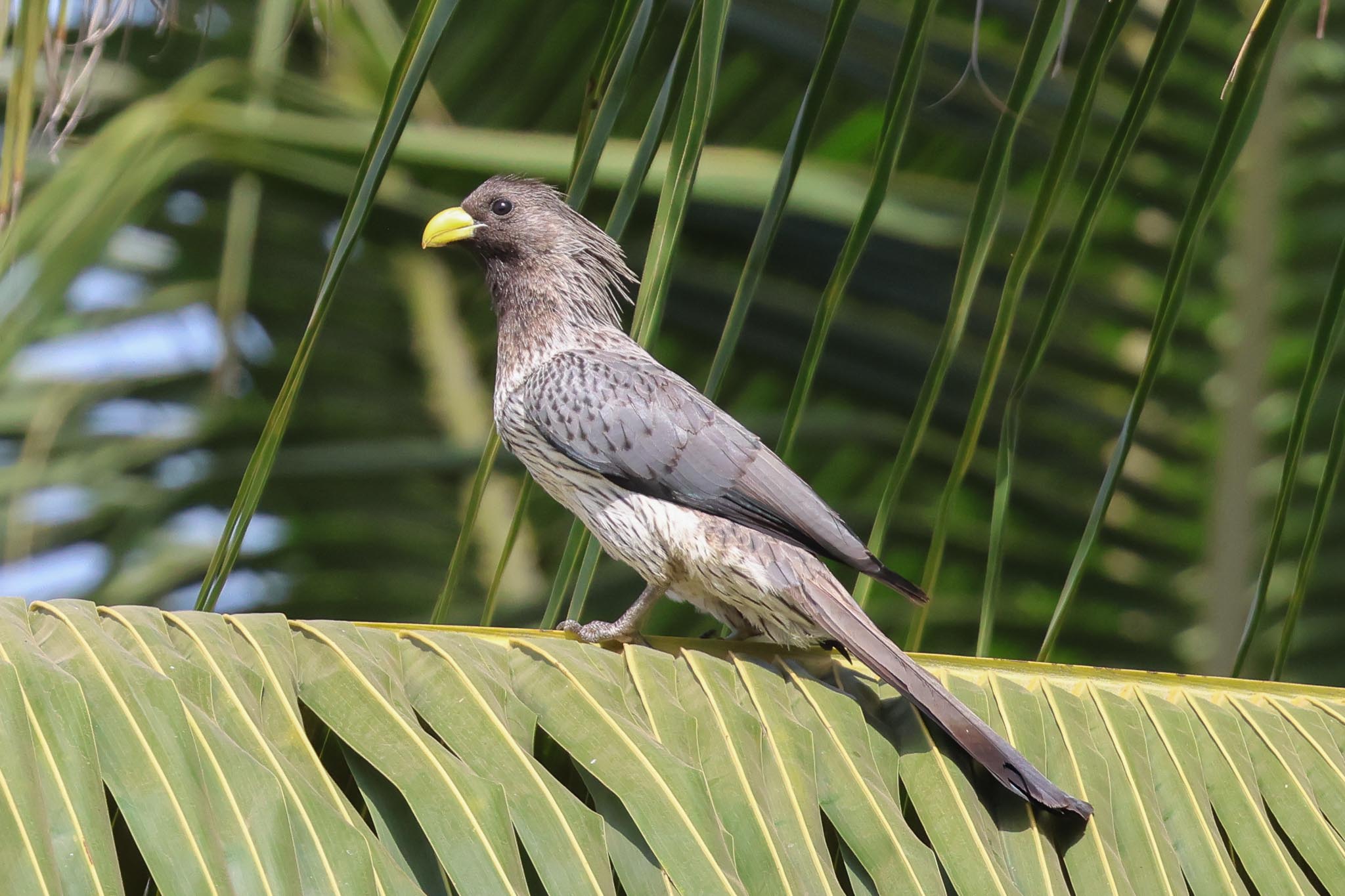
We ate down at the beach bar, where the catch of the day was a particularly popular option, fresh grilled fish with rice or chips and a local spicy sauce. A cricket ran across the terrace at one point with a Cattle Egret in close pursuit and the cricket very sensibly dived under our table and disappeared under the bags and feet. The Cattle Egret waited patiently just a few feet away from us staring under the table and stalking round to different angles. It took some time for the cricket to come out, but eventually when it did emerge the Cattle Egret promptly grabbed and swallowed it. Patience pays off!
After an hour or so break, we met at the bus again at 3pm. We drove just beyond Kotu and stopped on the side of the dusty roadworks where we got off the bus and cut in on a small path through the ricefields. A Woodland Kingfisher flew across and an African Harrier-Hawk flew up into the palms ahead of us. A flock of starlings flew in too, and Modou pointed out a couple of Splendid Starlings in with the commoner Bronze-tailed this time. We could just see them occasionally in the crown of one of the palms, picking the fruits, before all the starlings flew off over the fields.
An African Grey Hornbill flew in and landed in the trees and then an African Grey Woodpecker appeared from round the back of a dead palm trunk ahead of us. From further along, we looked back and could see the woodpecker excavating a hole, its head appearing from time to time and throwing out bill-fulls of shavings. A Black Heron was perched on a stick above the rice, staring intently down at the water below and a pair of Tawny-flanked Prinias eventually came up out of the thick grass by the path.
We came out of the ricefields and onto the edge of the golf course. A Wattled Lapwing was hiding in the vegetation by a patch of mud on the edge of the mangroves, with several Little Bee-eaters perched up in the bushes nearby. Just beyond, a large flock of glossy starlings was accompanied by several White-billed Buffalo Weavers. We were looking into the sun from here, so we walked round onto the next fairway and looked back so we could get a much better view. They kept dropping down onto the edge of the fairway to feed, and in among the Bronze-tailed Starlings we could see some smaller, greener ones – Lesser Blue-eared Starlings. A Small Verdant Hawkmoth was a surprise find when it landed on one of the group.
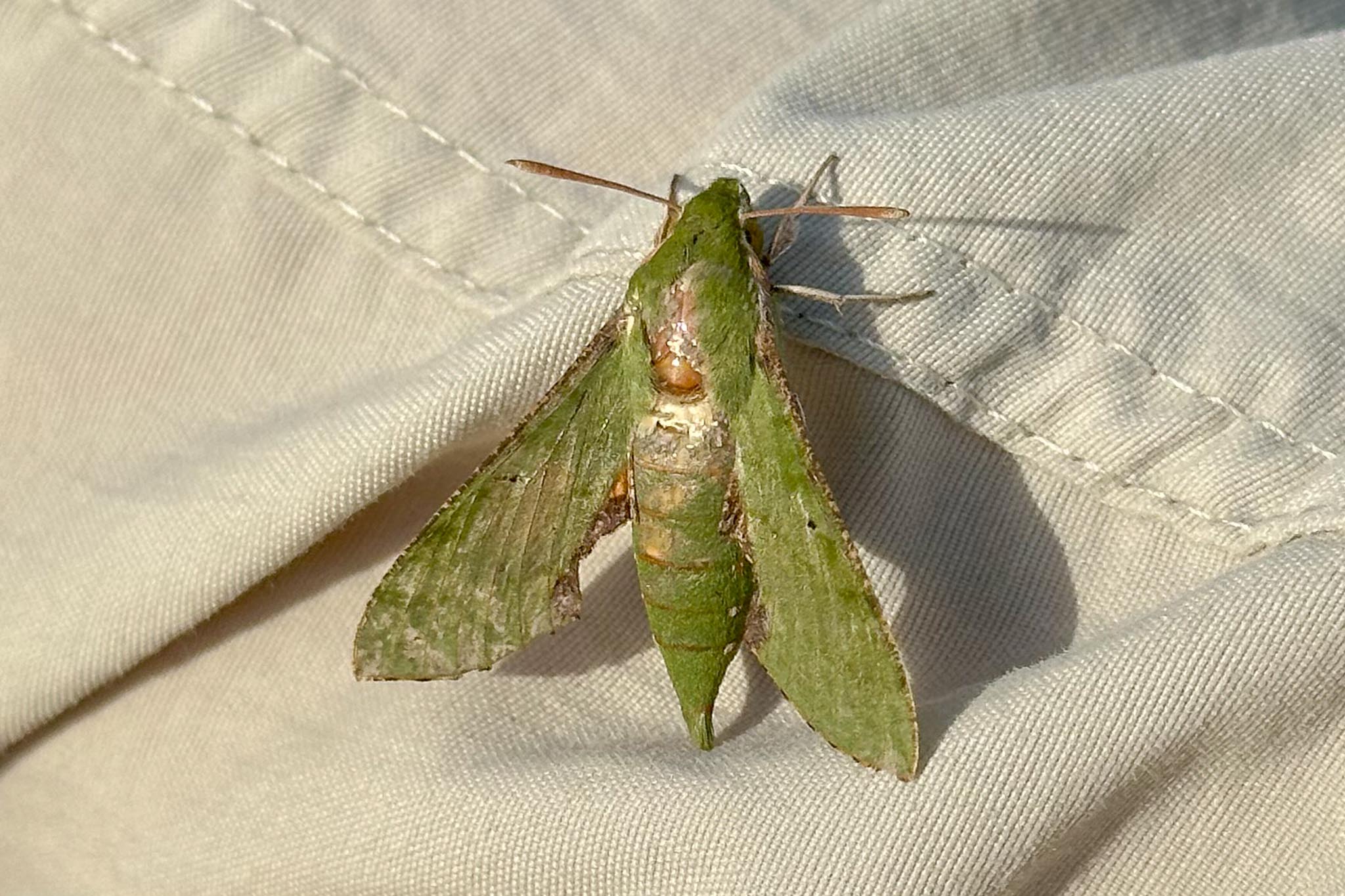
One of the greens is set on a small island in the mangroves, surrounded by a muddy creek – lots of hazards for the golfers! We walked over the bridge onto the island and scanned the creeks – there were several more Senegal Thick-knees in the mangroves, a couple of Oriole Warblers perched in the branches and a flock of Black-necked Weavers appeared before flying out past us. A Pied Kingfisher hovered over the creek by the bridge, eventually catching a rather large fish which it proceed to beat against a branch while we watched it in the scope.
Back onto the golf course and a flock of Piapiacs came out of a palm tree above us. Several Swallow-tailed Bee-eaters were hawking from the branches in the trees by the next fairway, so we walked over for a closer look. Then we cut across the creek again on another bridge, where several Splendid Sunbirds were in the mangroves now including one young male starting to develop some irridescent patches. The light was starting to go now, so we made our way back round on the nature trail to the bridge. Several orange & black Blister Beetles had gathered in the tops of the grasses by the path and a Squacco Heron was lurking in the mangroves.
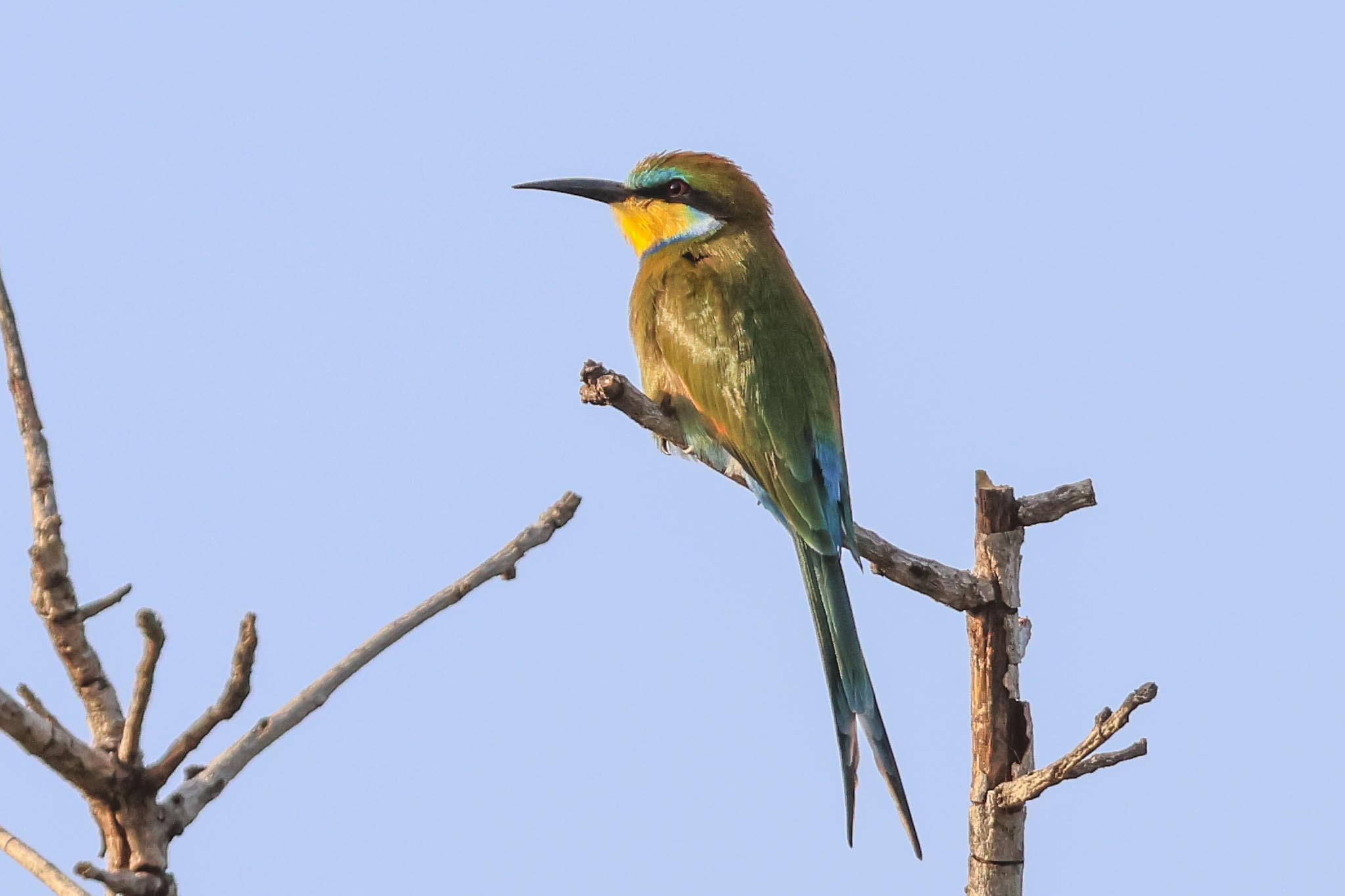
Back at Kotu bridge, the tide had gone out again. A Giant Kingfisher was lurking along the edge of the mangroves now but again we were looking into the sun. It dived into the water and caught a fish, landing back in the bushes, so we tried to cut in on a small path to the opposite side of the creek where the light would be better, but another couple with a guide were ahead of us and they flushed it before we got there. A Whimbrel was rather bizarrely perched on the wires over the creek instead! We went back to the bridge and sat looking the other way, with the light behind us. A couple of Pied Kingfishers were perched on the dead trees close in front of us, occasionally diving down to the water to fish, a Malachite Kingfisher shot past and a Western Reef Heron paraded up and down in the shallows right in front of where we were sitting. A lovely place to sit and to end our first full day here.
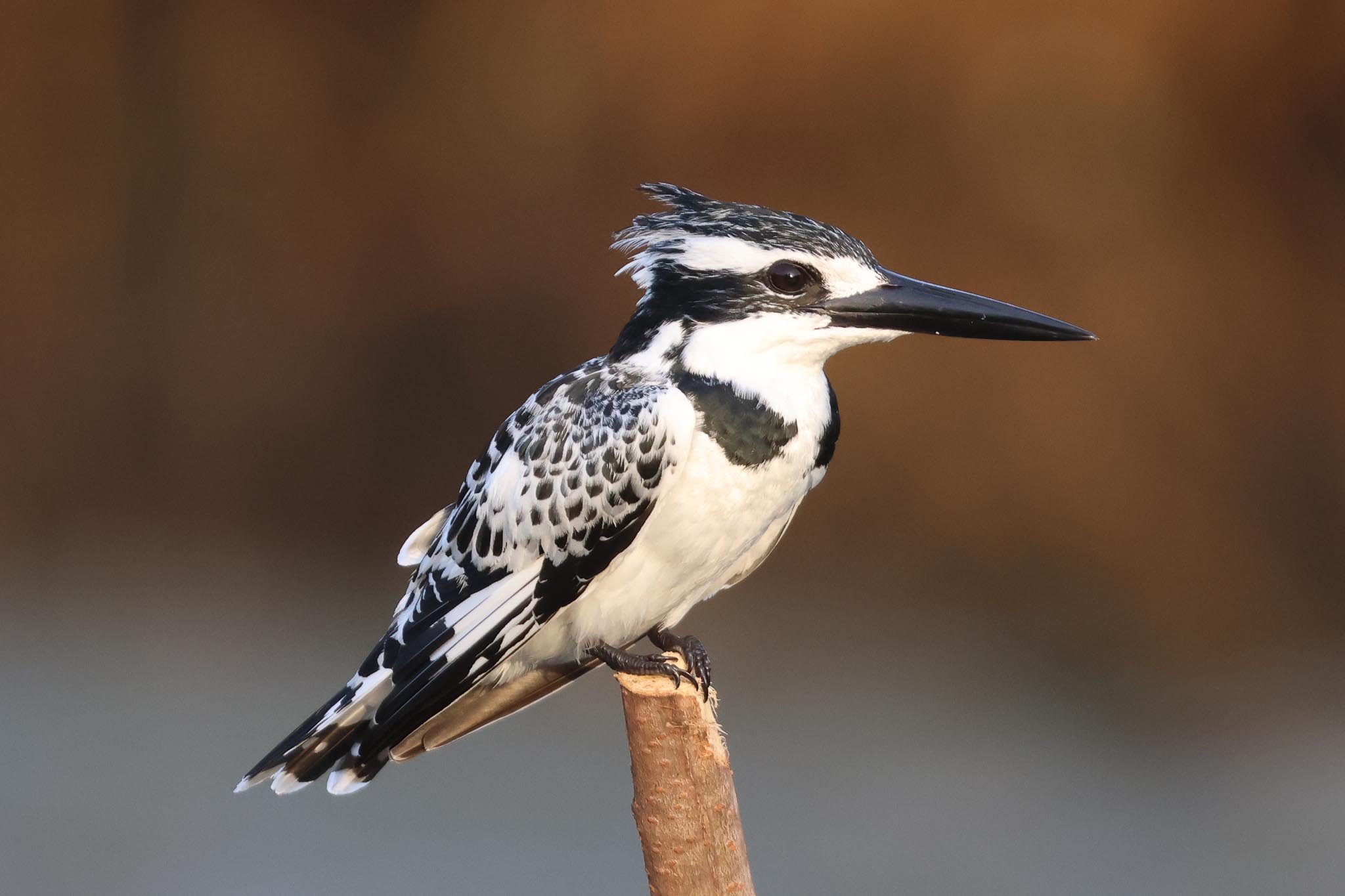
As we walked back to the bus, several Red-billed Firefinches and Red-cheeked Cordon-bleus were feeding on the dusty verge and a couple of Yellow-crowned Gonoleks worked their way through the bushes. It was a short drive back to the Senegambia again and after a break to freshen up, we met for a quick drink before dinner – barbecue night tonight at the buffet. Once the entertainment started up, we retired to the bar up by reception where we could actually hear to do the list.
SUNDAY 19TH NOVEMBER – Clear, humid, still, 35C
After breakfast, we met Modou Taal again outside the hotel at 7.30am and boarded the bus for the short journey to Brufut. We turned off the main road down along the narrow dusty streets through the village and out past the rubbish tip where lots of Hooded Vultures and Cattle Egrets were gathered with a couple of donkeys. We parked on the edge of the woods and disembarked, and were met here by Anthony, a local forest guide who would accompany us for the morning. Stopping first to scan the trees around the bus, we found several Brown Babblers, a Western Olivaceous Warbler and our first Snowy-crowned Robin-Chats. Walking down along a side track between half-built houses, a Northern Grey-headed Sparrow was singing from the top of a telegraph post and a male Northern Red Bishop dropped into a nearby overgrown garden. We waited a minute to see if it might reappear, but all we saw now were lots of Village Weavers flying in and out.
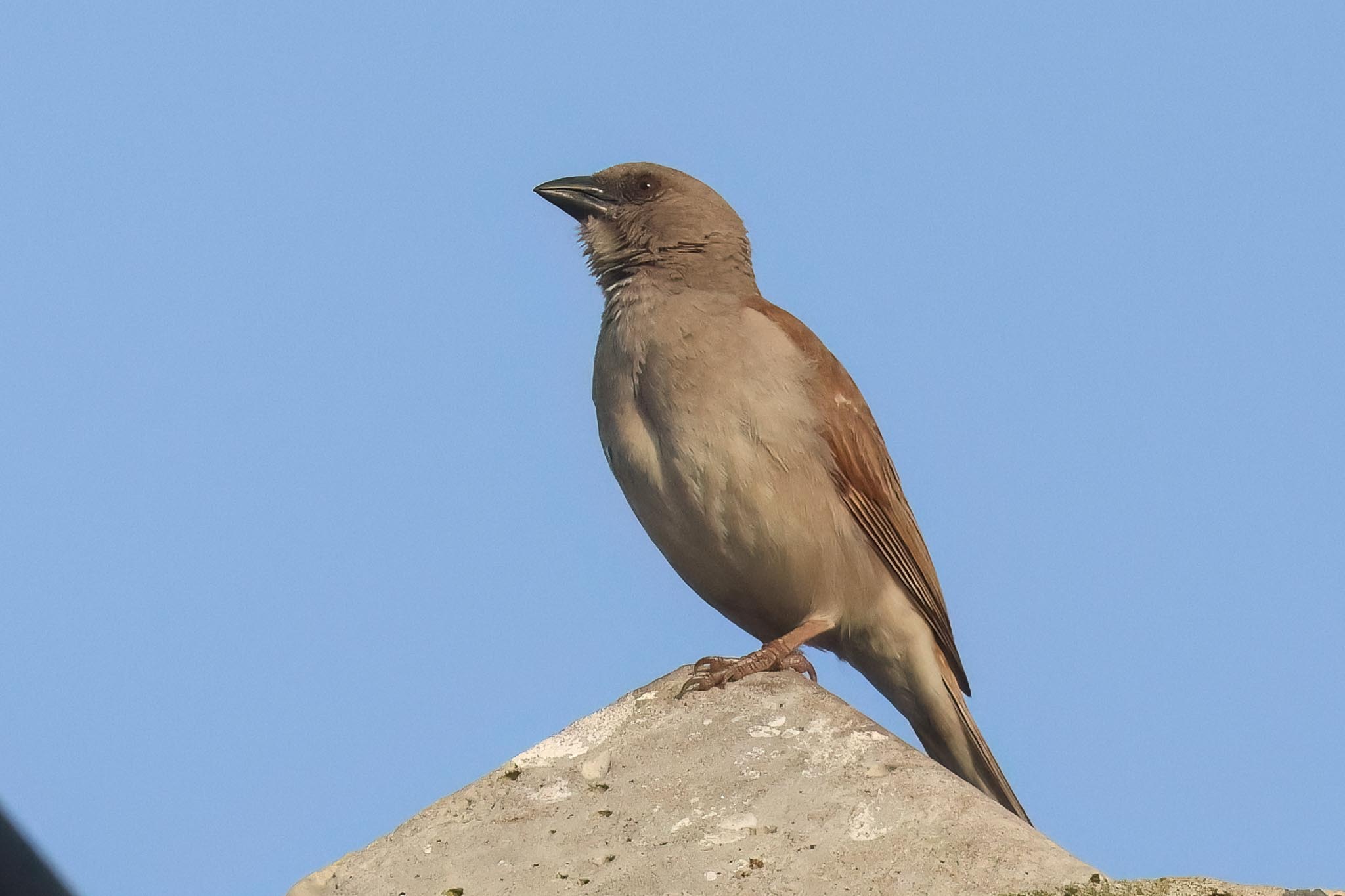
Then Anthony heard a Grey-headed Bushshrike calling behind us so we went back out onto the main track. There was no sign at first, and we had to content ourselves with our first Blue-spotted Wood-Dove feeding on dusty patch of ground, a Shikra in a nearby tree, and a Palm-nut Vulture which flew across the track further up. Modou eventually found the Bushshrikes and they moved quickly through the trees back towards where we had parked, before stopping in the top of one where we could get good views through scope. Several Splendid Sunbirds were flitting around in a fruiting tree above us.
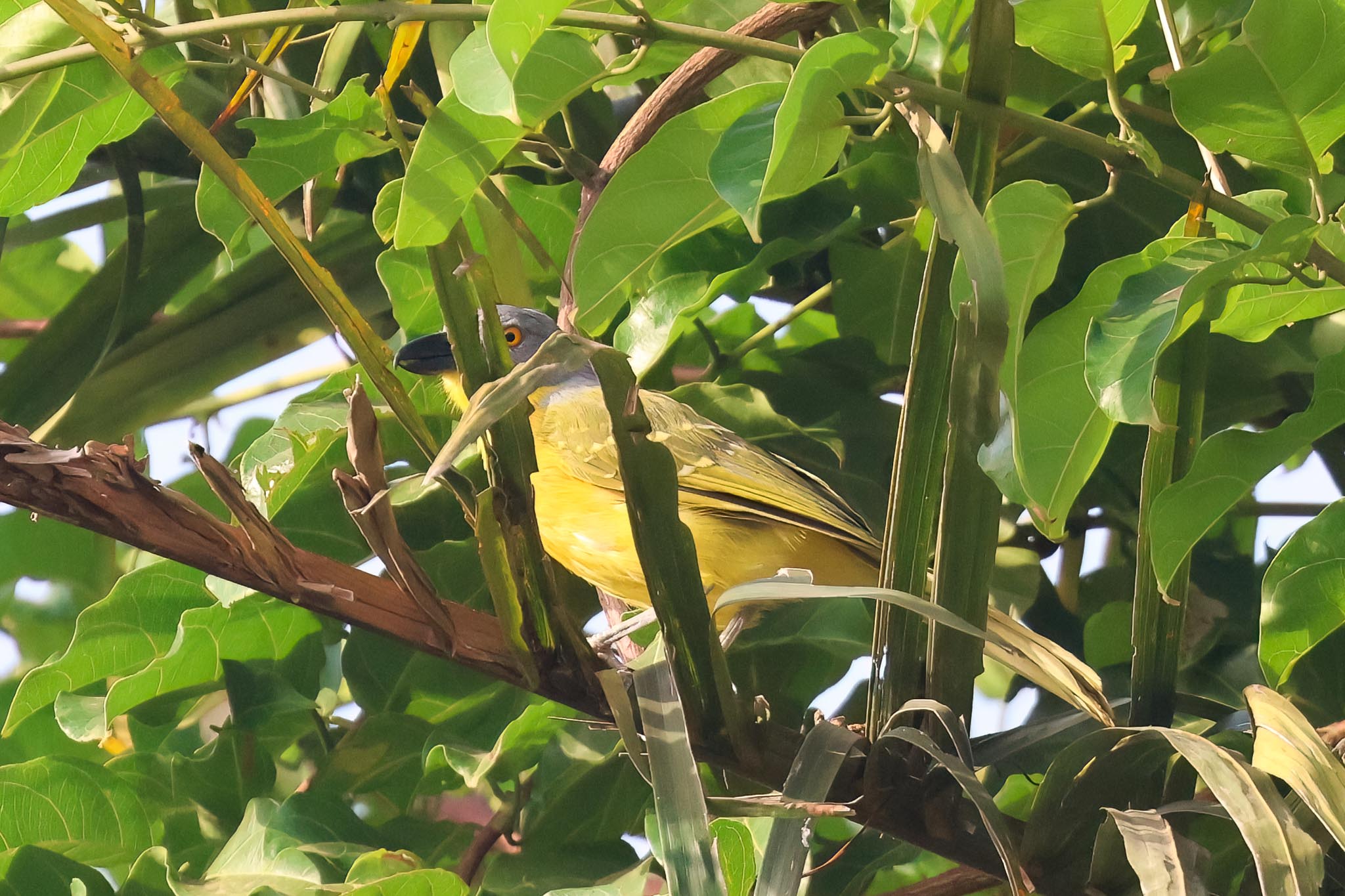
Back to the side track past the houses, we walked in further now, down along the edge of the forest. Some Green (Guinea) Turacos were calling ahead of us but first we stopped to look at a Double-spurred Francolin which posed nicely on the wall the other side of the track.
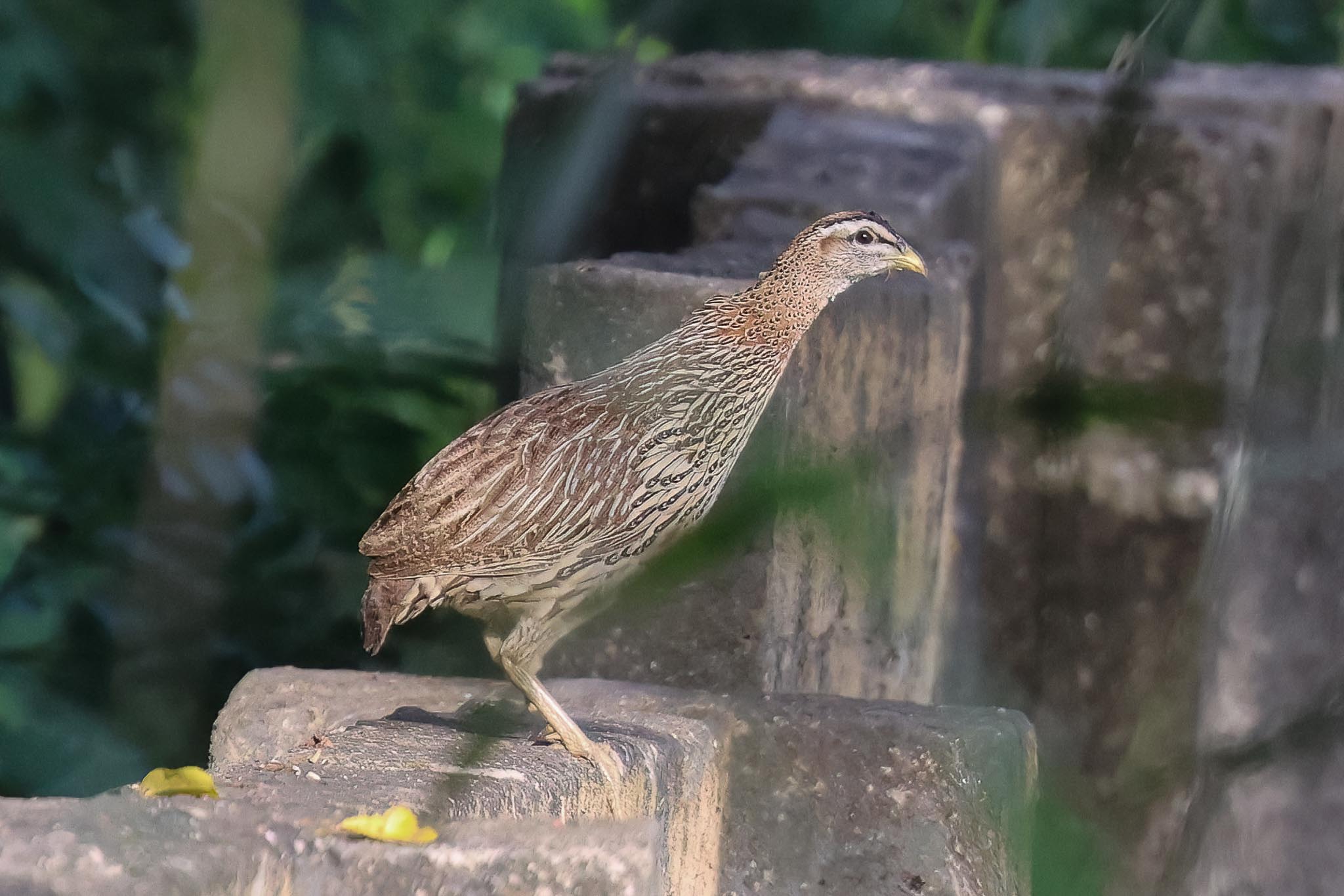
Then continuing along the edge of trees, we found the Turacos in the trees above the path, but they were moving quickly back and forth in the leaves and hard to get on, three or four of them. Eventually they landed briefly in a tree where we could get a look, then flew out over the path and disappeared into the trees in the walled garden beyond. As they came back in over our heads, we could see the red in their wings. A Lesser Blue-eared Starling perched up with the Bronze-tailed Starlings in the garden, lots of Senegal Parrots flew in and out of the trees, and a couple of Western Plantain-eaters perched up in the tops. As we started to walk back along the track, we noticed movement in the top of another tree on the edge of the forest and after a few seconds a very smart Violet Turaco stuck its head out. Two turacos to start the day!
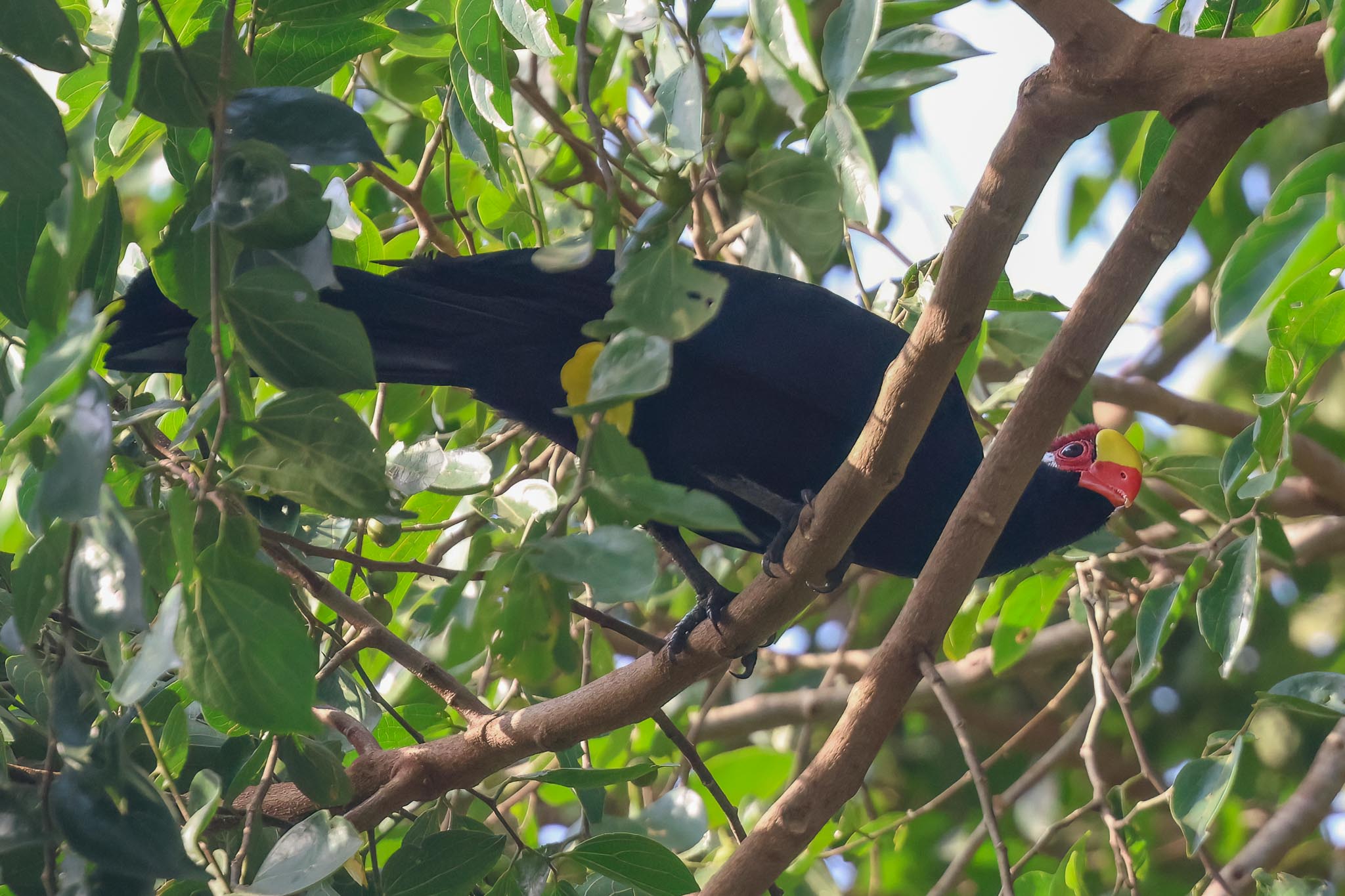
Out on the main track again, a Grey-backed Camaroptera was singing now and showed nicely in a nearby tree but a Grey Kestrel flew over without stopping. We cut in the other side of the track through part of the village, mostly half-built houses and overgrown building plots. A Singing Cisticola and Little Weaver were perched in a bush by the path, lots of butterflies fluttered through the undergrowth, Beautiful and Variable Sunbirds flitted past and a Black-billed Wood-Dove was picking around in a dusty plot.
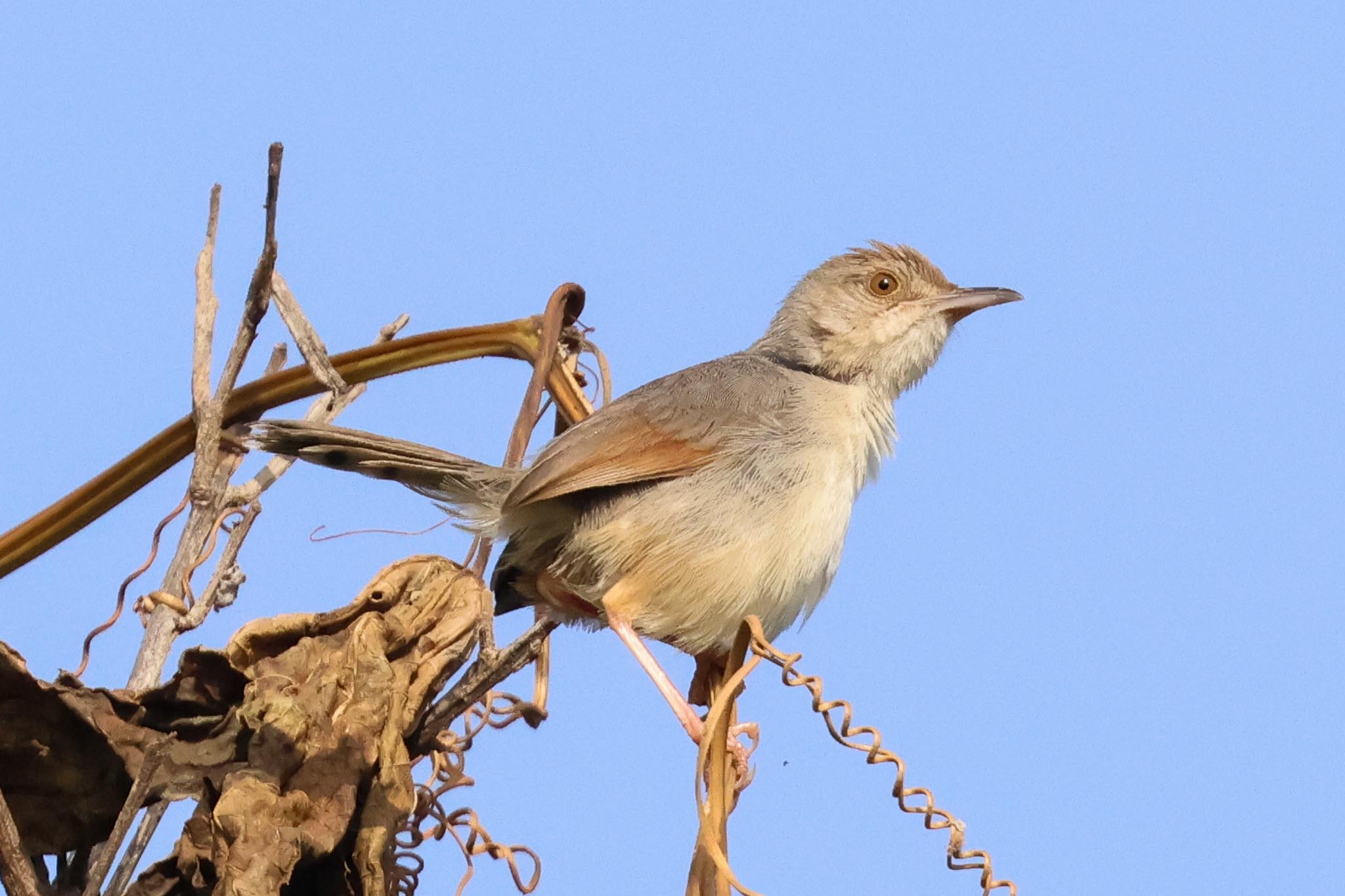
The overgrown building plots here are a good place to look for bishops and it didn’t take long to find our first male Black-winged Bishop which posed nicely for us in one of them. It was a slightly surreal location though, with us stood in the sun on one side of the street, looking over the heads of several men sitting in the shade below the wall in front of us – they must have thought we were mad! Then a little further on, a male Northern Red Bishop appeared and showed better than the one we had glimpsed earlier, now allowing us to appreciate the differences between the two species.
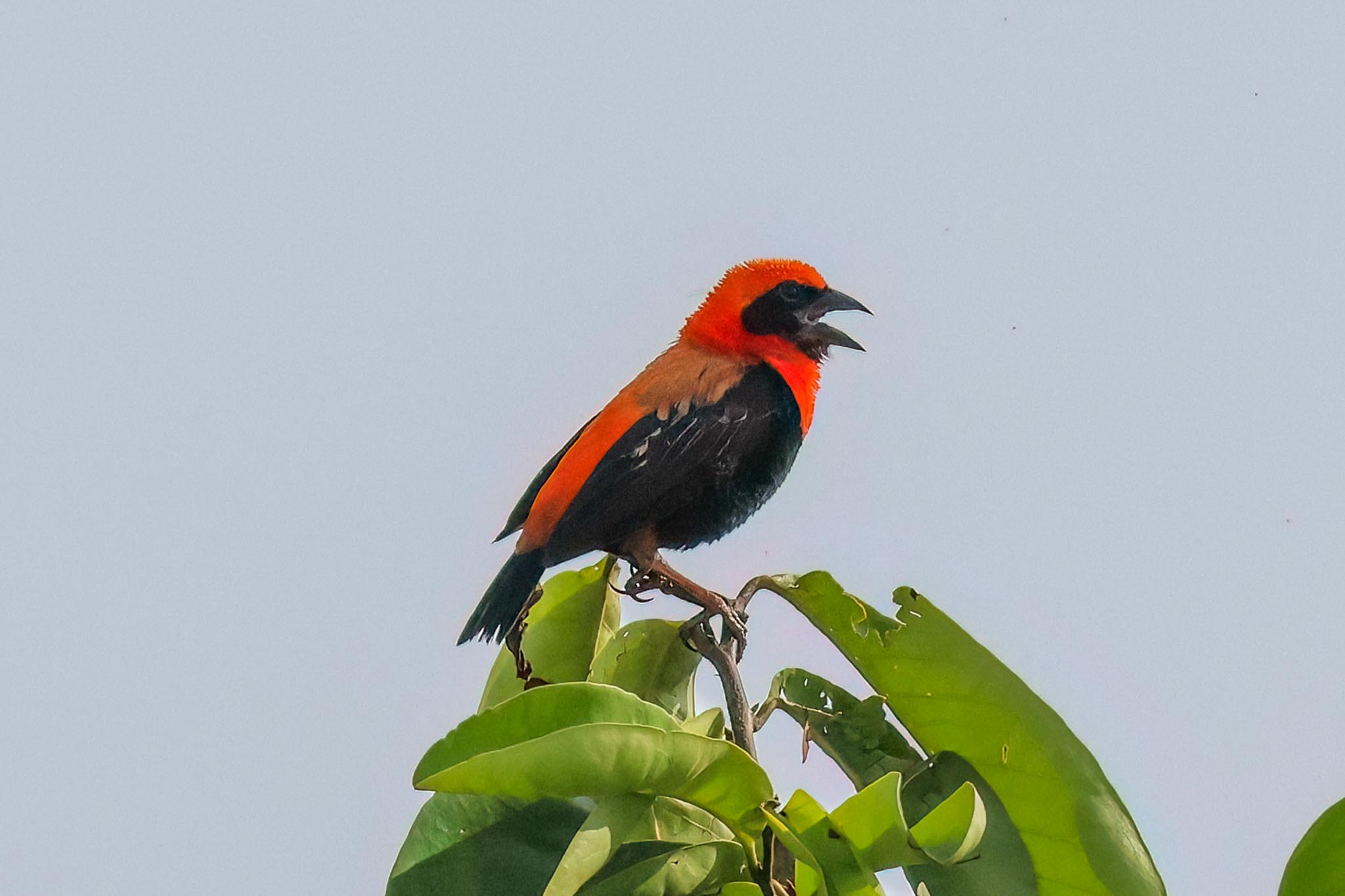
Continuing on, a Whistling Cisticola was singing from the top of a bush and back out onto the main track, Modou heard a Black-crowned Tchagra and we eventually found it perched in another overgrown building plot. Lots of Red-billed Firefinches were feeding on the dusty verge by the track and a pair of Tawny-flanked Prinias appeared on the edge of the woods the other side.
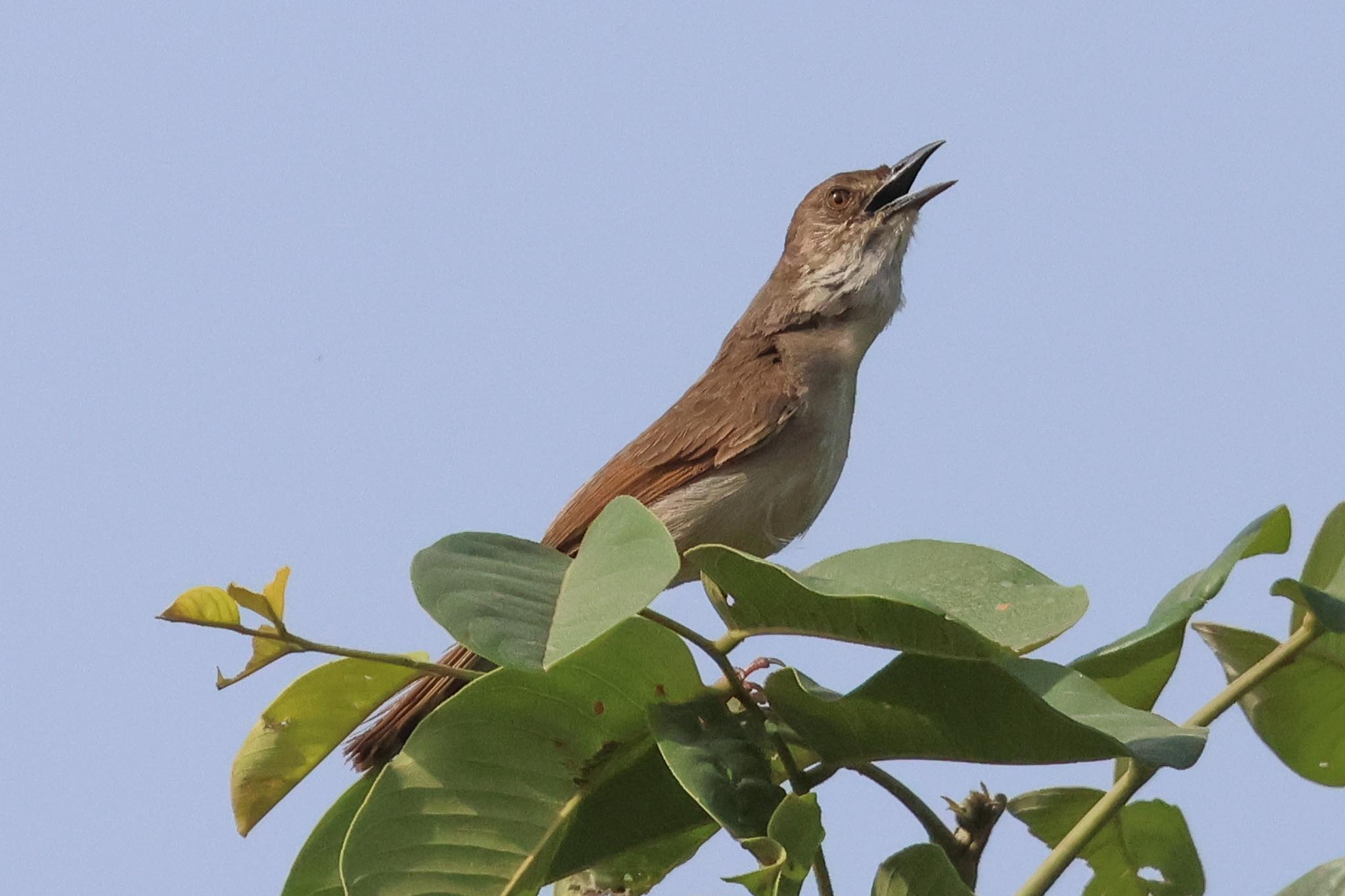
It was already hot and feeling much more humid today. Thankfully we didn’t have far to walk to get to the drinking pots, where we could sit for a while in the shade and get ourselves a cold drink, while watching the birds coming to drink at the pots full of water. It was quiet here at first, when we sat down, with just a few Laughing Doves displaying and sun-bathing on the ground but slowly, more birds started to come in – Common Bulbuls and Brown Babblers, an Oriole Warbler and a young Snowy-crowned Robin-Chat, an African Thrush, a couple of Yellow-crowned Gonoleks, and a pair of Black-necked Weavers.
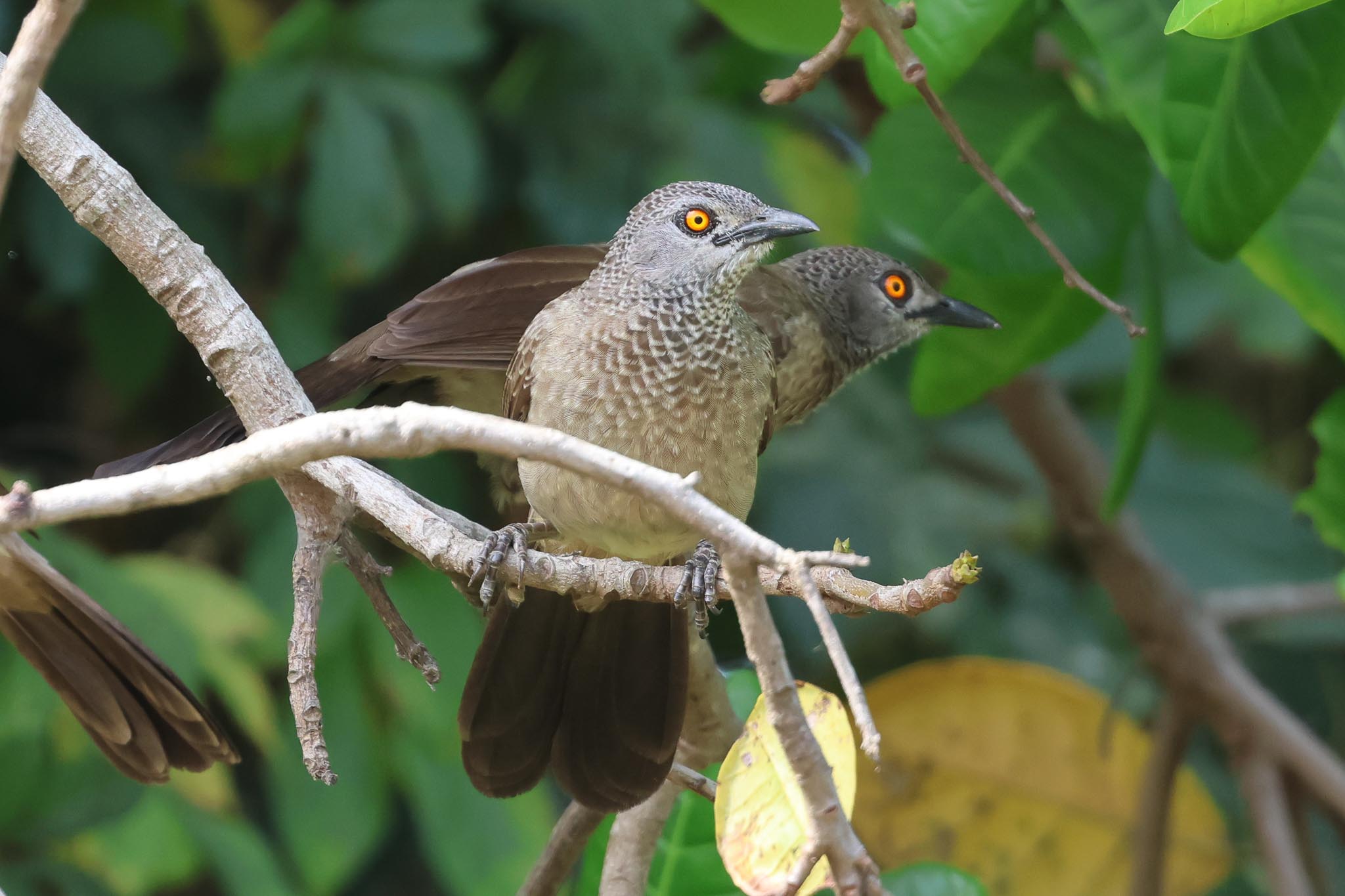
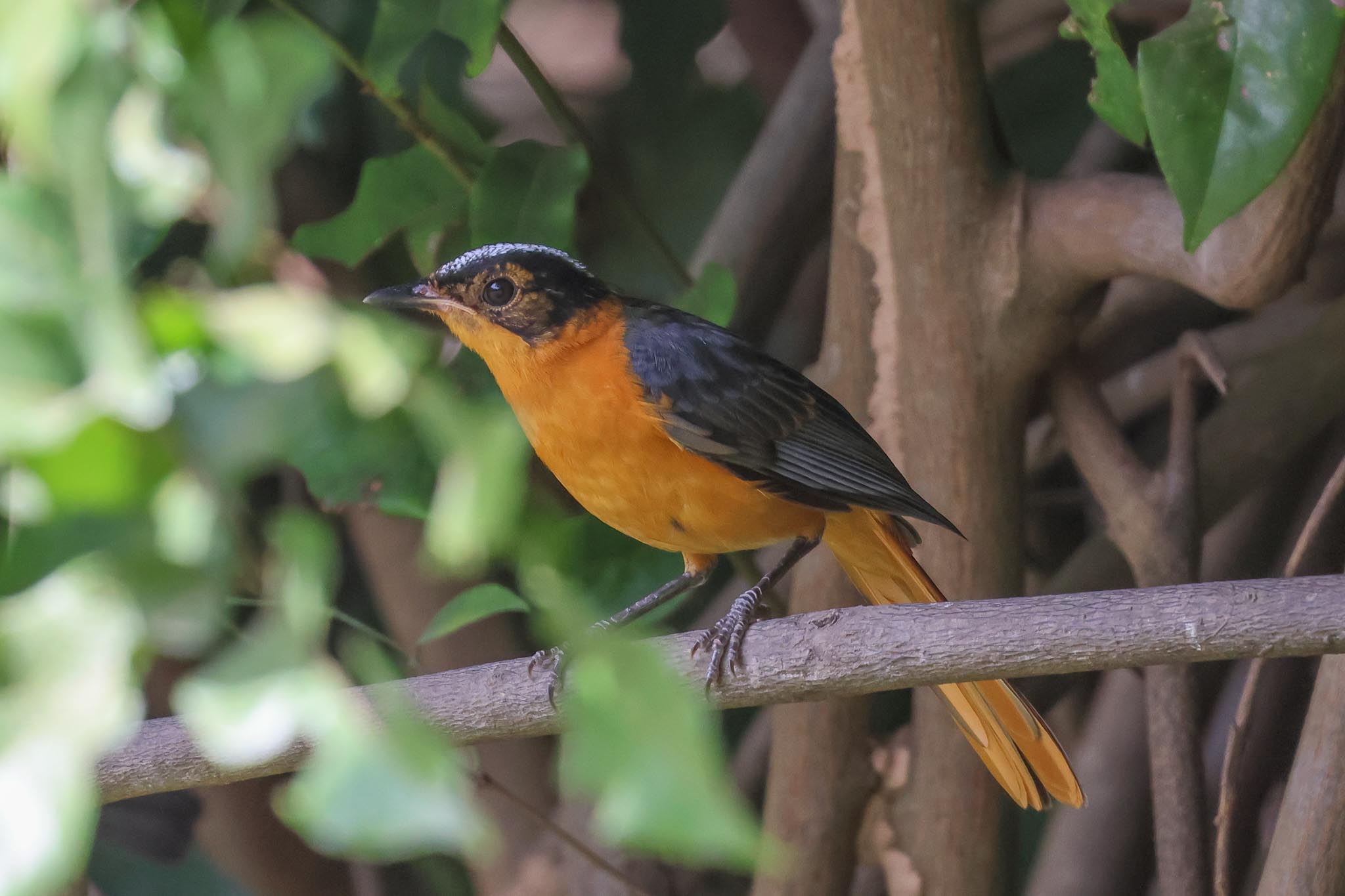
A pair of Lavendar Waxbills came in to drink at the pots, along with a little group of Red-cheeked Cordon-bleus, as did another Green Turaco, but the latter was very nervous, sat in the trees for a while and was then spooked by passing lorry on the track outside before it got a chance to get a drink.
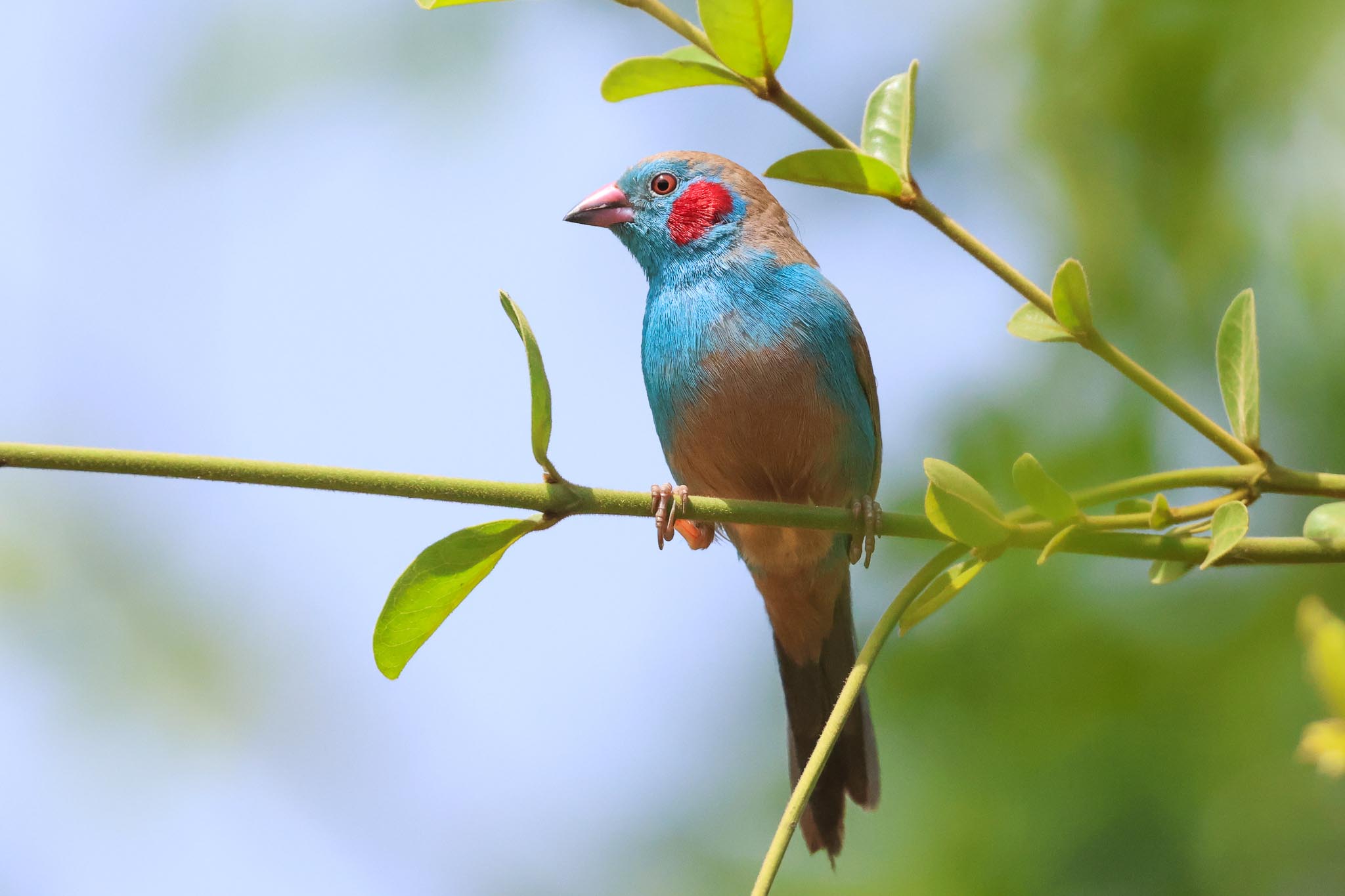
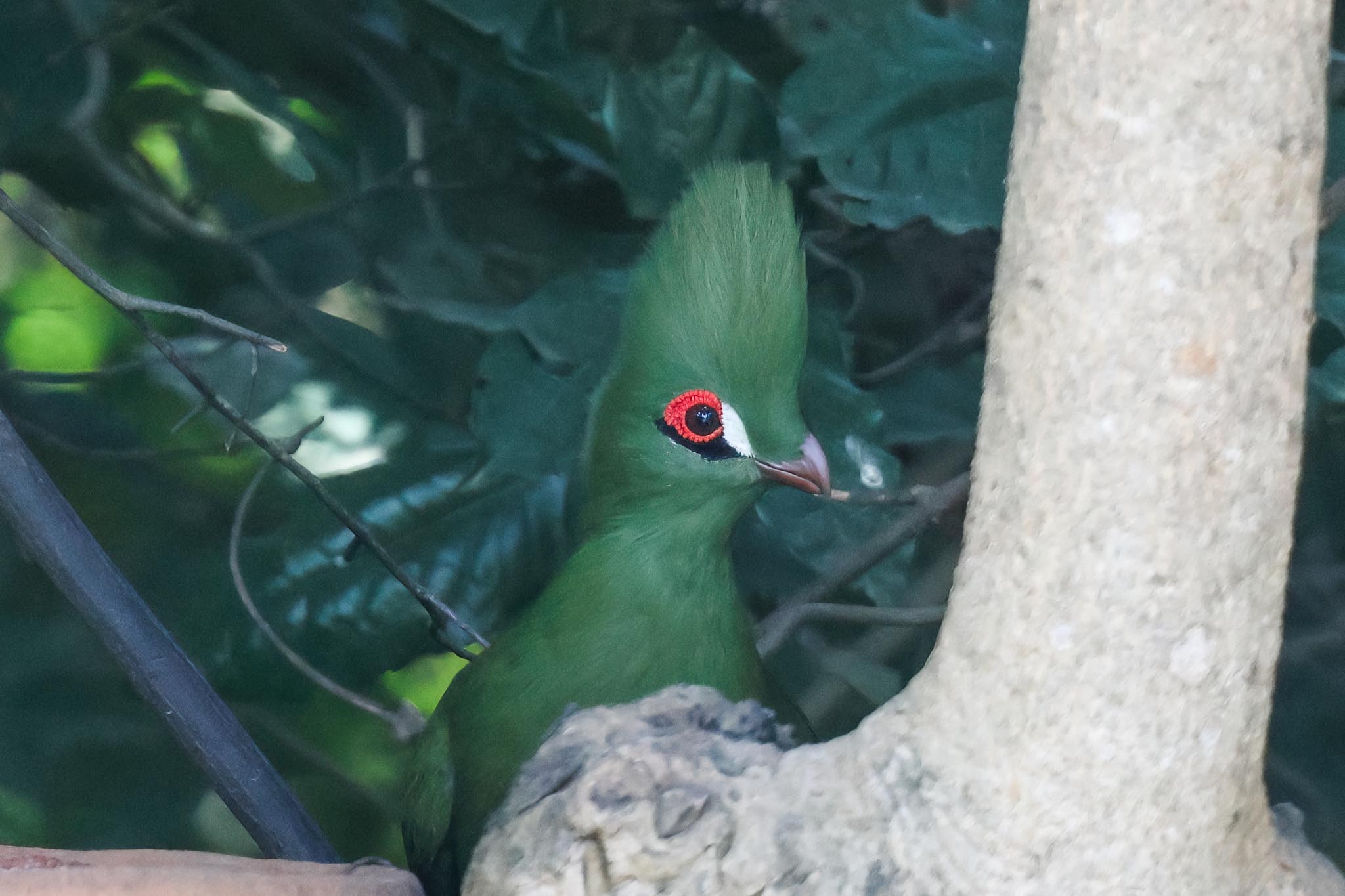
After a rest, Anthony led us deeper into the forest. A Lanner circled with the Hooded Vultures high above us as we turned down various paths and eventually cut in to the undergrowth, where Anthony pointed to the ground ahead of us. A pair of Long-tailed Nightjars was roosting in the leaves on the floor under the bushes, and we took it in turns to look at them through a gap in the trees. Given how camouflaged they are, it is amazing how they always find them!
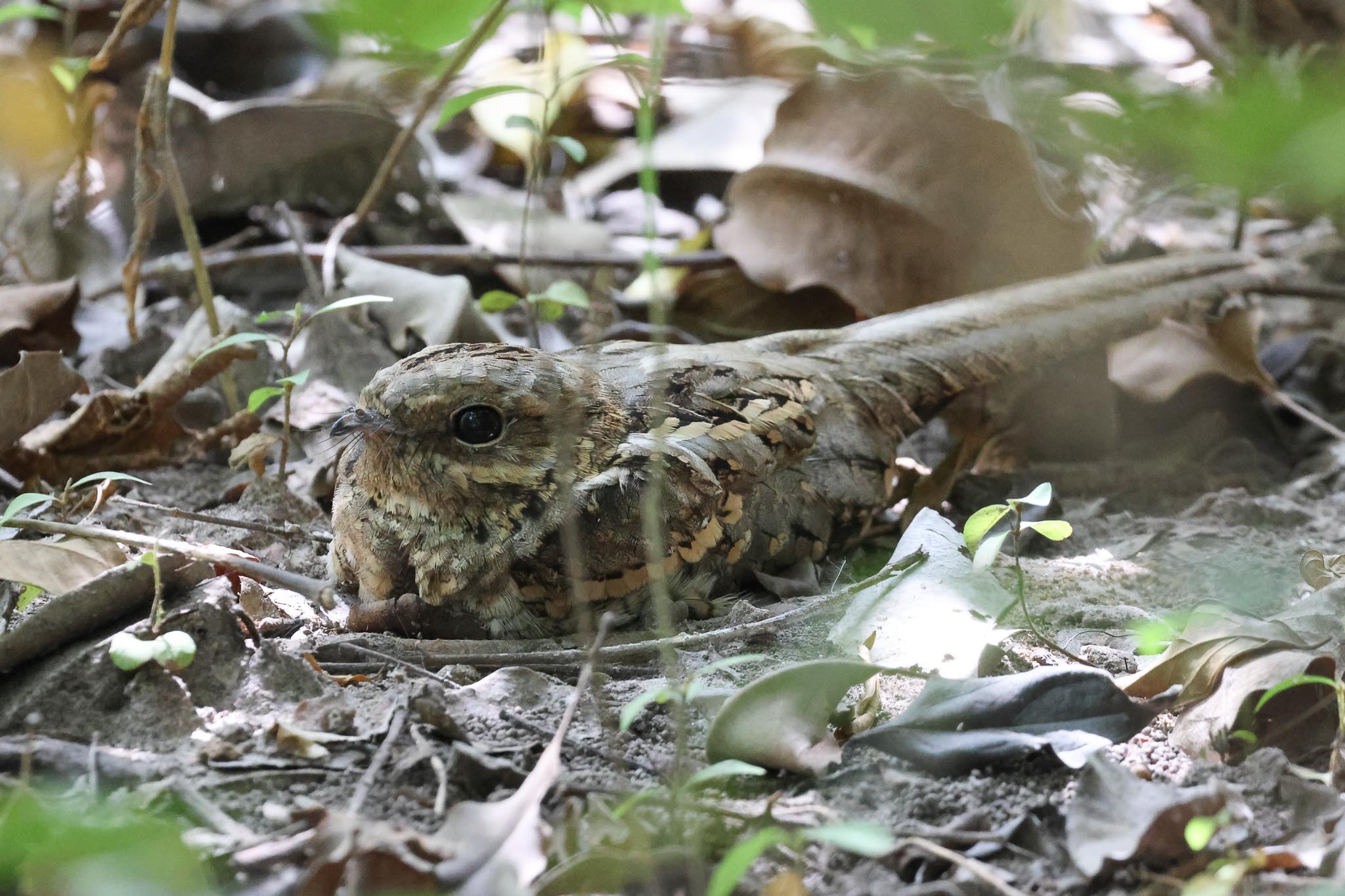
Making our way back to the drinking pots, we sat down in the shade again while everyone settled up for their earlier drinks. It was worth the extra few minutes we spent here, with a Greater Honeyguide and a Purple Starling now coming in to drink, an African Pygmy Kingfisher coming in for a bathe and our first Gambian Sun Squirrel in the trees.
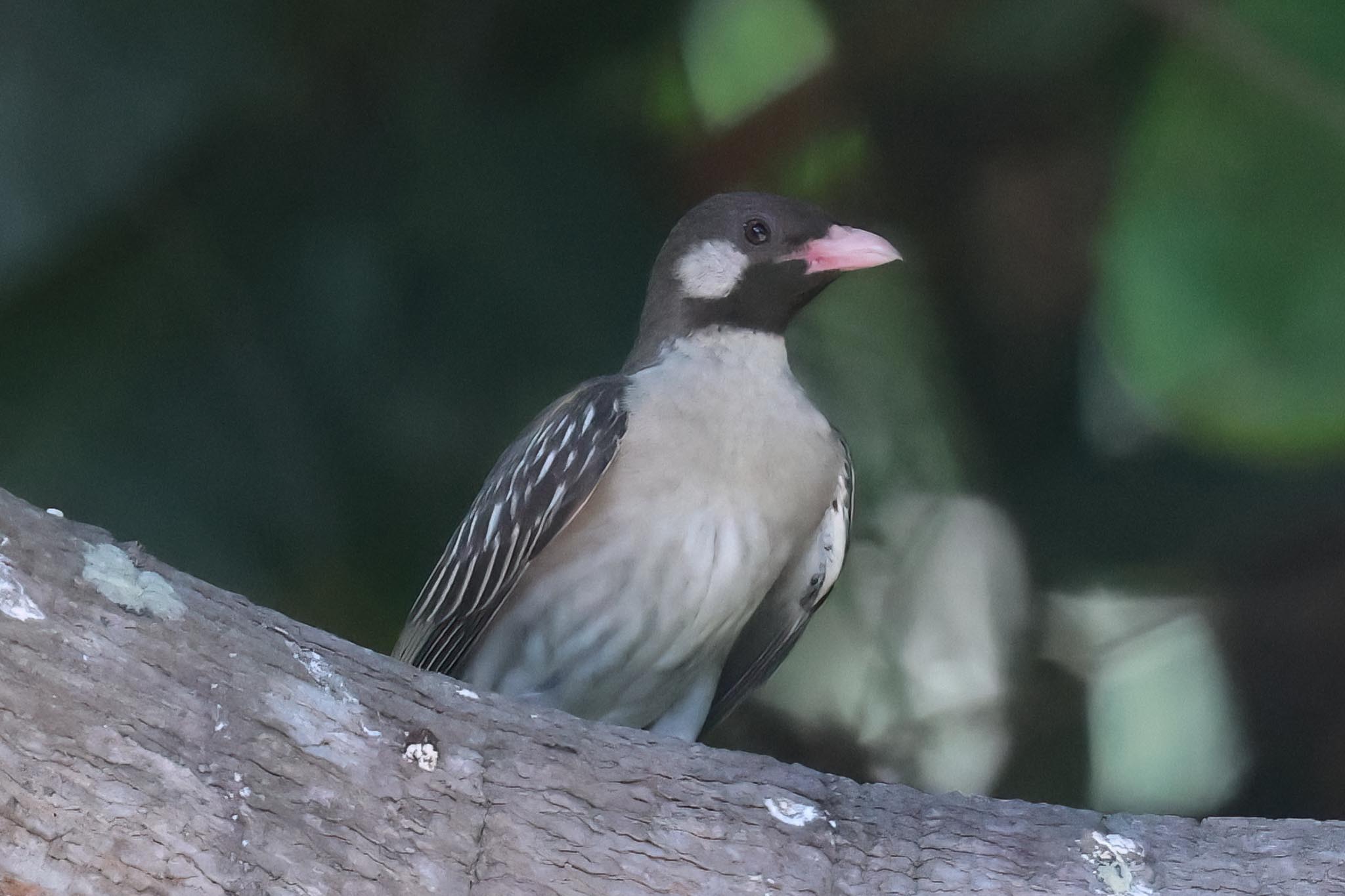
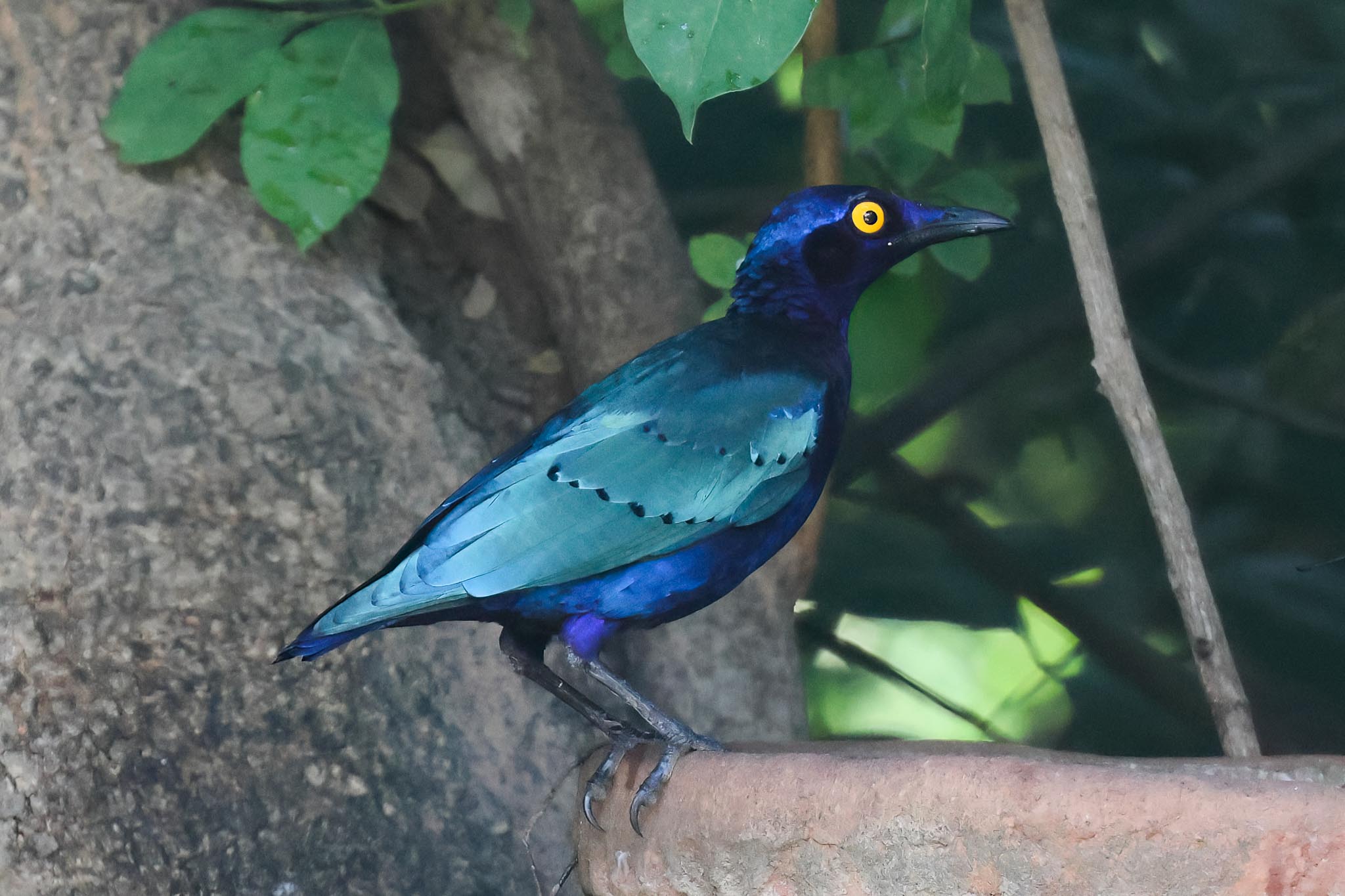
Back out on the main track, our bus was waiting for us and we headed over to Tanji Ecolodge for lunch. We had a bit of time beforehand to sit in the shade and watch the comings and goings at the drinking pots and shallow pool here. We hadn’t sat down long before we picked up a Western Bluebill in the bushes just behind the pool, our main target here. Unfortunately, it disappeared back in before everyone could see it, and as we waited to see if it might reappear a succession of other birds came in to drink and bathe – Common Bulbuls, Firefinches, an African Thrush, another Snowy-crowned Robin-Chat. A male Blackcap appeared briefly in the trees, another Palearctic migrant here for the winter, followed by a more exotic African Paradise Flycatcher. Lunch was a delicious local buffet of grilled chicken and fish with rice or chips and spicy sauce.
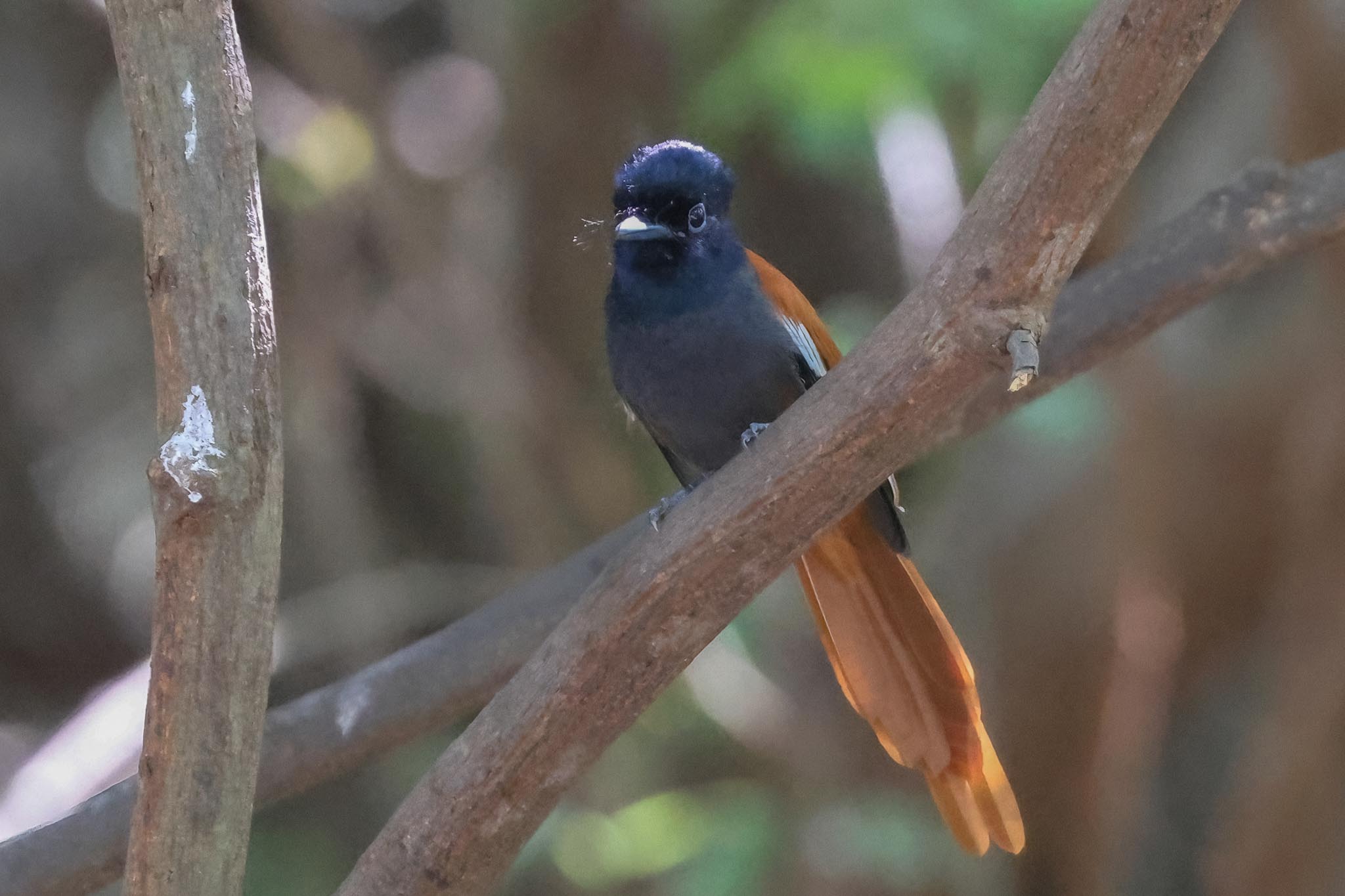
We could still see over to the pots, so we kept one eye on them while we ate, and we had only just finished when we noticed the Western Bluebill back on the ground behind the bathing pool, although it quickly flew back up into the bushes behind. We left the table and went back to the chairs overlooking the pots. It never came out again into full view, but eventually we all got to see it, moving round in the bushes behind. A second Bluebill appeared too, a plainer juvenile this time, and it too would not come in to drink while we were there. A Green-headed Sunbird showed a little better, though it was nervous due to one of the local cats which insisted on sitting by the pool until it was fed.
While we had a break to use the facilities, we had a quick look out towards the sea behind. Several Green Monkeys were at the back of the camp and a selection of butterflies including a Green-banded Swallowtail were feeding on the flowers behind the beach. Out over the water, we picked up distant Sandwich Tern, Grey-headed Gull and Lesser Black-backed Gull flying past.
It was just a short drive to the nearby Tanji Bird Reserve. As we walked in from the side of the road, it was still hot in the middle of the afternoon. We could hear Viellot’s Barbets calling, and Modou found a pair in the top of a bush which we got in the scope. When they dropped down, a Common Whitethroat hopped through the branches below. A Brown-throated Wattle-eye called too but had gone quiet by the time we had looked at the Barbets. More African Palm Swifts zoomed around overhead and we could hear Blue-cheeked Bee-eaters calling distantly over the trees.
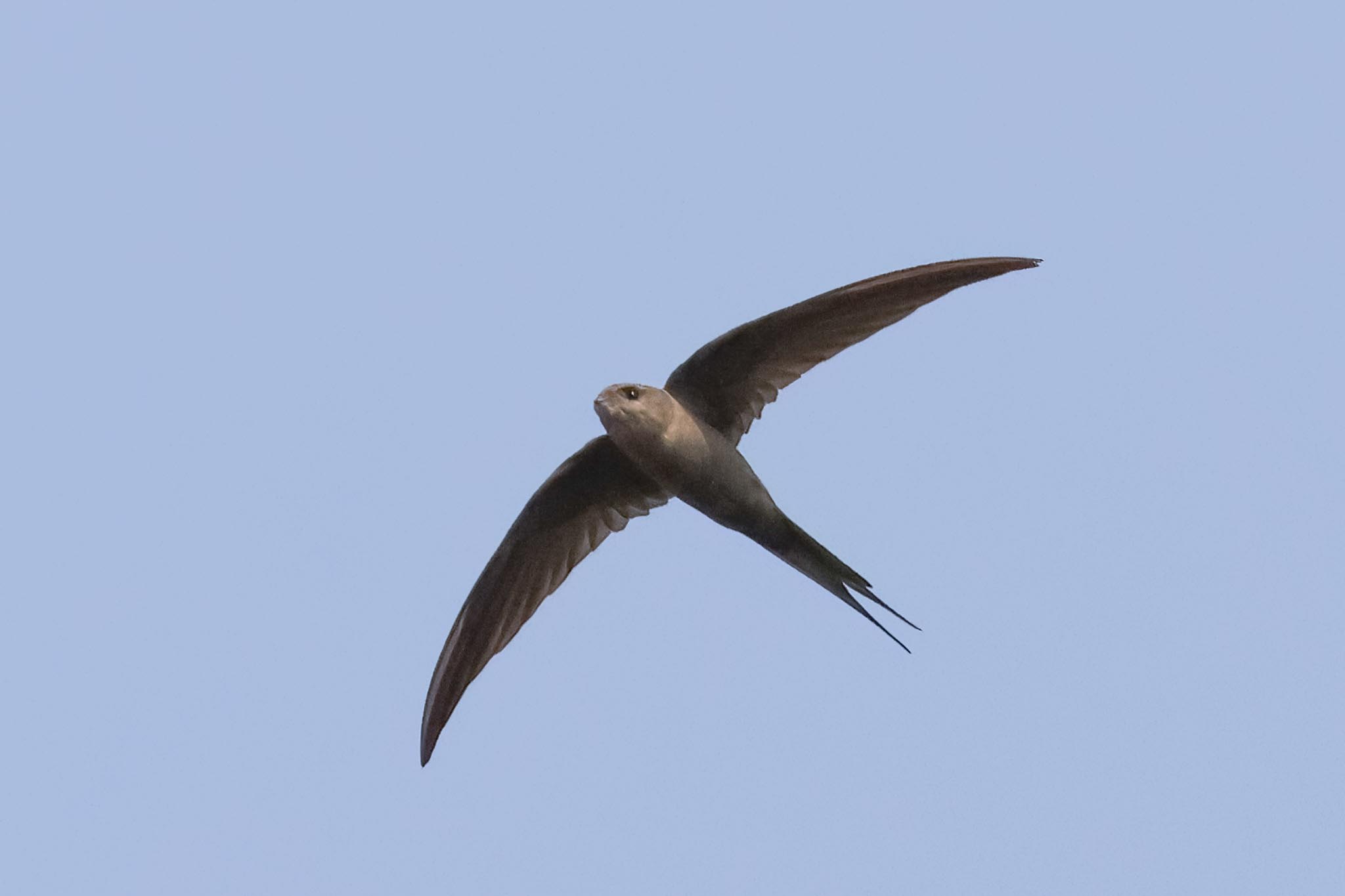
Lots of Caspian Terns flew back and forth overhead from the direction of the beach, and we noted a couple of West African Crested Terns flying up over the beach beyond. Several Ospreys flew back and forth too, and we found another Lanner circling with two of them inland from the road. Modou saw something drop down in the grass ahead of us and wasn’t sure at first what it was. As we walked over to see if we could find it, a Four-banded Sandgrouse flew up in front of us, a very nice bonus. An African Pygmy Kingfisher perched briefly in some trees.
We had one last stop we wanted to make today along at the beach, so we met the bus back on the road for the short drive down to the start of the village. We walked in, sidestepping the piles of rubbish, down through where people were processing and smoking lots of small fish. The beach beyond was covered in Grey-headed Gulls, feeding on large quantities of dead fish which were washing up on the shore.
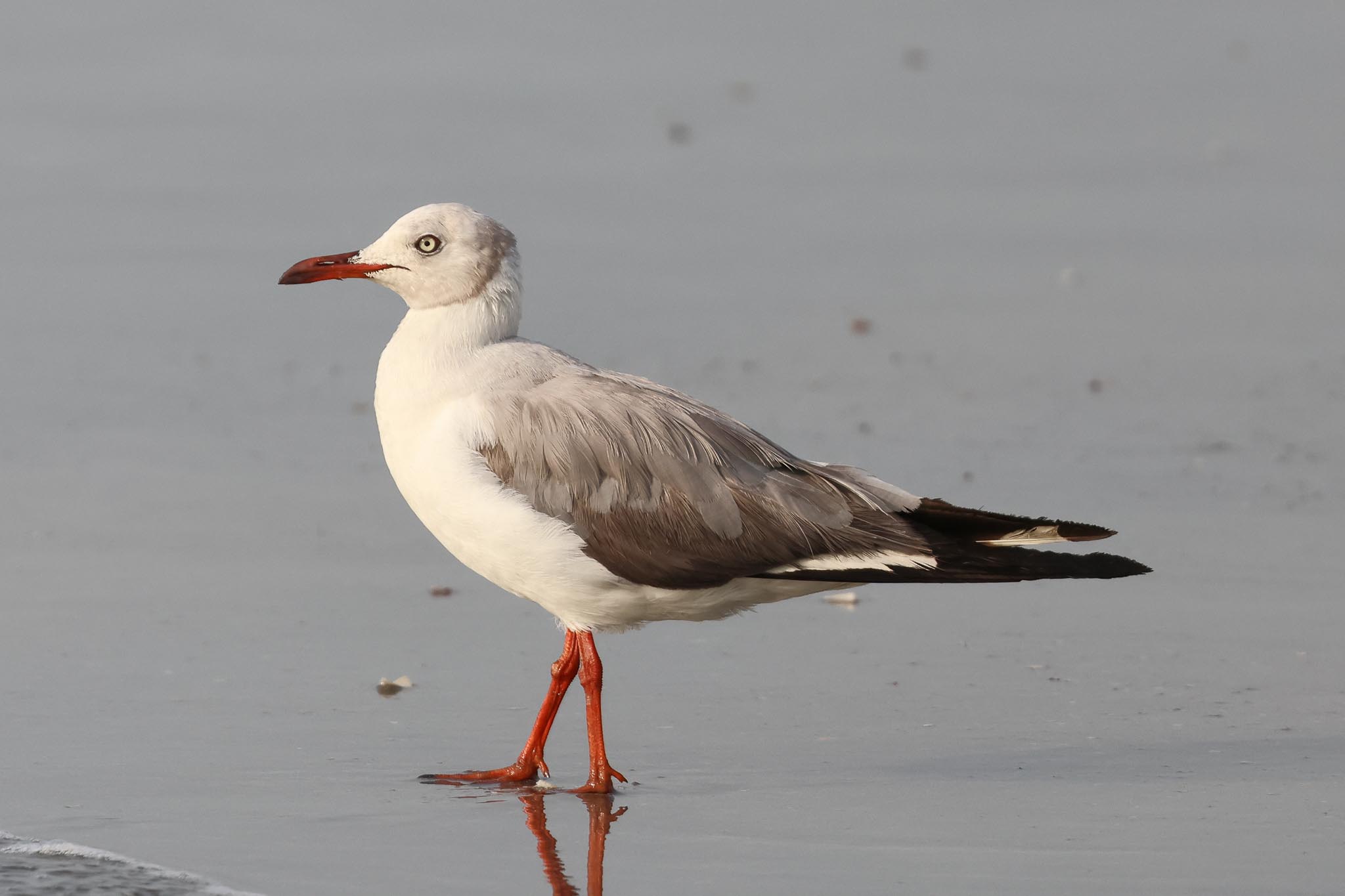
Lots of Caspian Terns were patrolling up and down over the water in front of us, along with several West African Crested Terns (formerly known as Royal Terns, but recently split from the American species which now takes that name). A few Common Terns of various ages were in with them and we eventually found a Sandwich Tern too, perched with the gulls on the gunwale of one of the fishing boats moored further out.
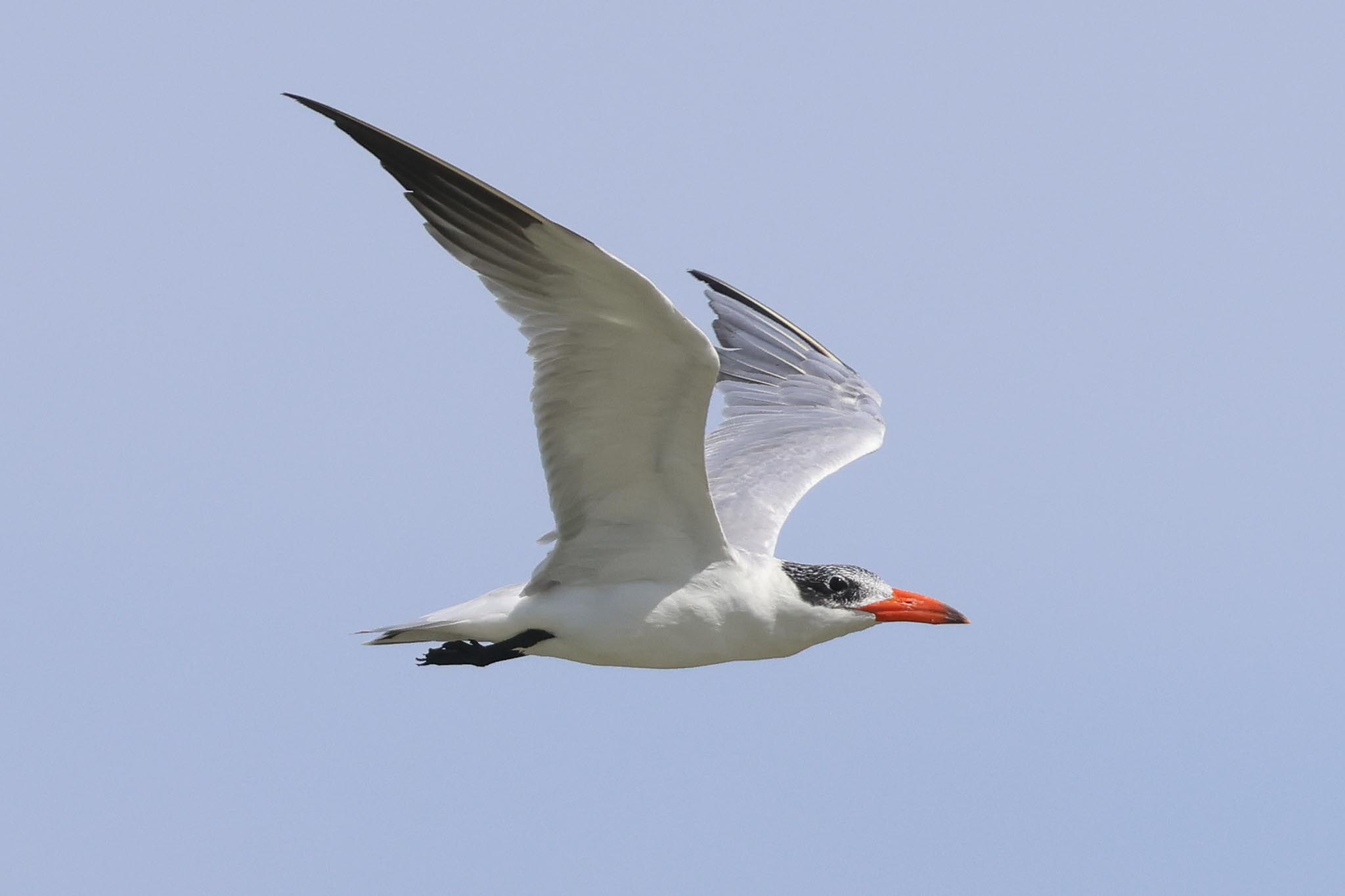
There were a few waders familiar to us from back home here too – Bar-tailed Godwits on the beach, Turnstones feeding in amongst gulls, and little flocks of Sanderling flying up and down. As we walked up the beach, Yellow-billed Kites were coming down to grab dead fish from the beach or water ahead of us, and several Pied Crows were scavenging on the sand. A succession of White-breasted Cormorants (treated by some authorities as a species in its own right but by others as a sub-Saharan race of Great Cormorant) flew back and forth overhead.
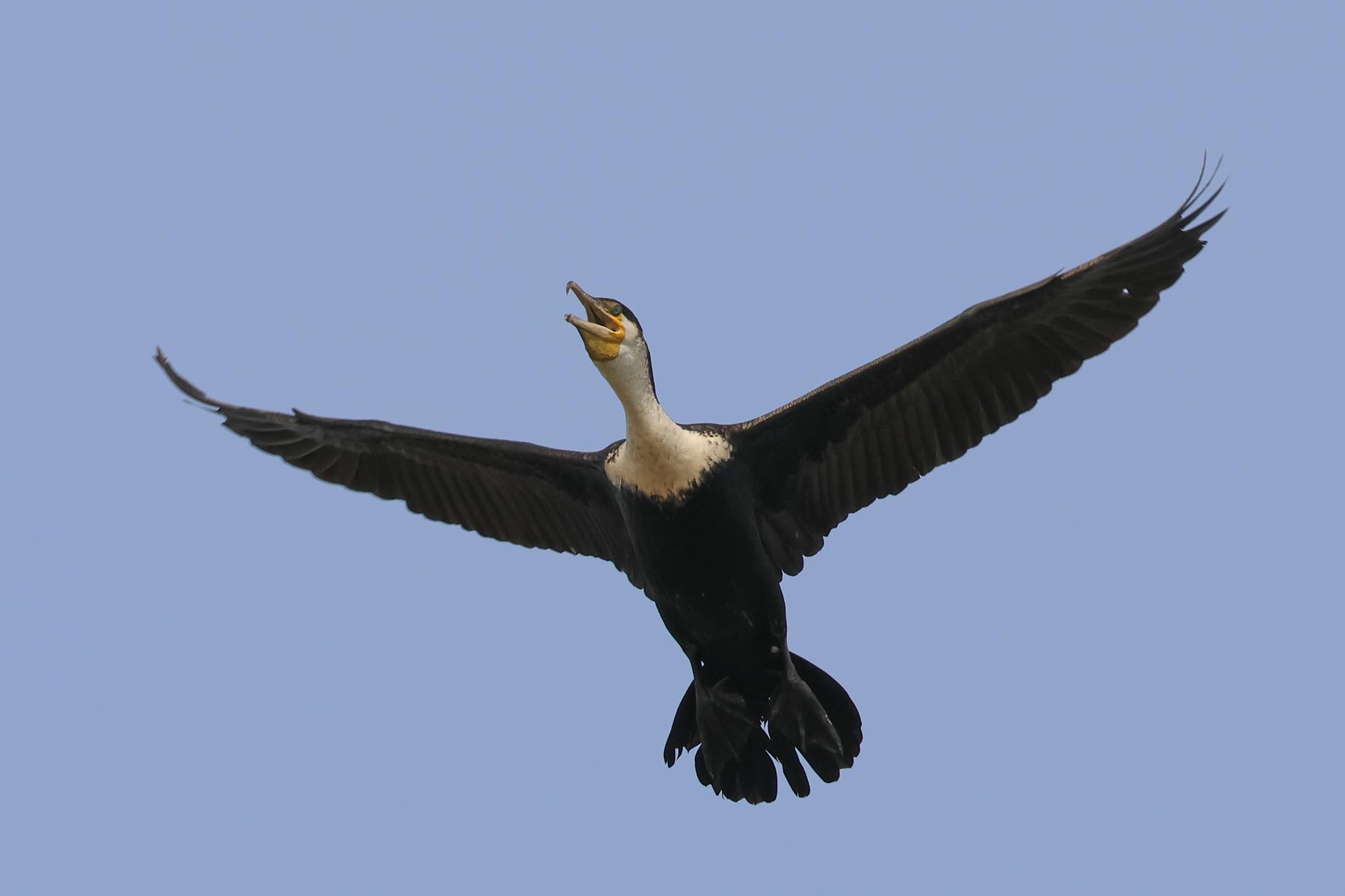
We walked up to the pools at the far end of the beach, where several Ringed Plovers, Greenshanks, Whimbrels and more Turnstones were to be found on the mud. A single Common Redshank was lurking on the edge of the mangroves, along with a Grey Plover, a Senegal Thick-knee and several Spur-winged Lapwings. A large roost of gulls and terns on the islands was flushed by someone jogging up the beach just ahead of us, but several of the birds landed back down again, mostly Caspian Terns and a single 1st winter West African Crested Tern, Grey-headed Gulls of various ages, and both Great White and Little Egret in with them.
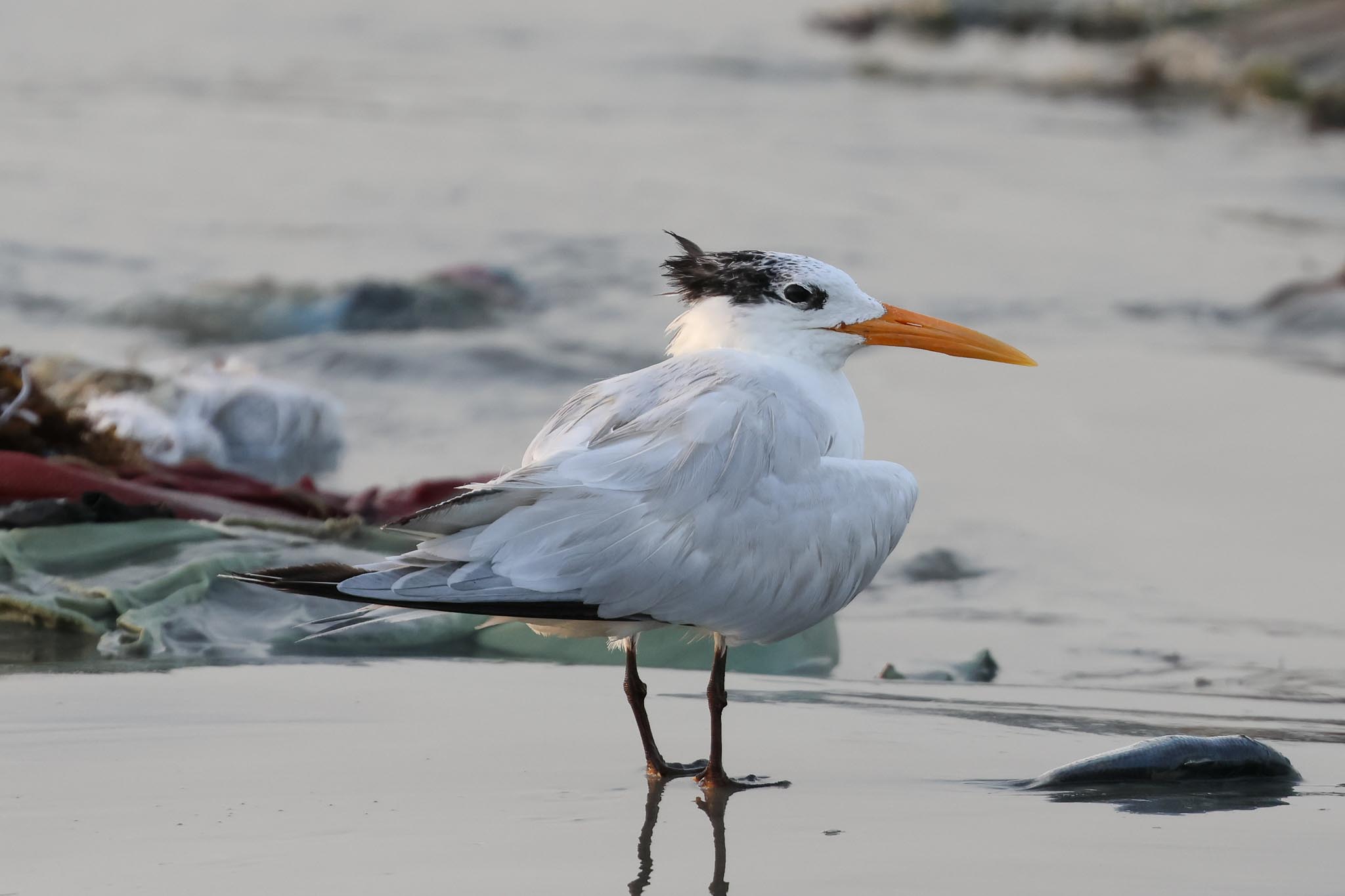
As we walked back down the beach, the sun was starting to go down. A Cattle Egret was picking around the racks of smoked fish back on the edge of the village. It was a fairly quick drive back to the hotel tonight, and after a short break, we met as usual for the buffet dinner served down by the pool, and then a quick run through of the list afterwards up at the bar.
MONDAY 20TH NOVEMBER – Cloudy, humid, light breeze, 32C
A change of guides today, and we met Modou Jarju at the bus at 7.30am this morning, who would be with us for the rest of the trip. The journey down to Farasuto took about an hour before we turned off the main road down through the village and out into the open overgrown cultivations beyond. We pulled up at a junction in the track and got out. Walking on, we came across some overgrown foundations of a typically unfinished building by the path, where a couple of Little Bee-eaters were flicking in and out of the bushes. A Diederik Cuckoo appeared just behind, along with a Willow Warbler, the first of several we would see out here this morning. Several Orange-cheeked and Black-rumped Waxbills dropped down onto the low walls and then down to the bare ground below.
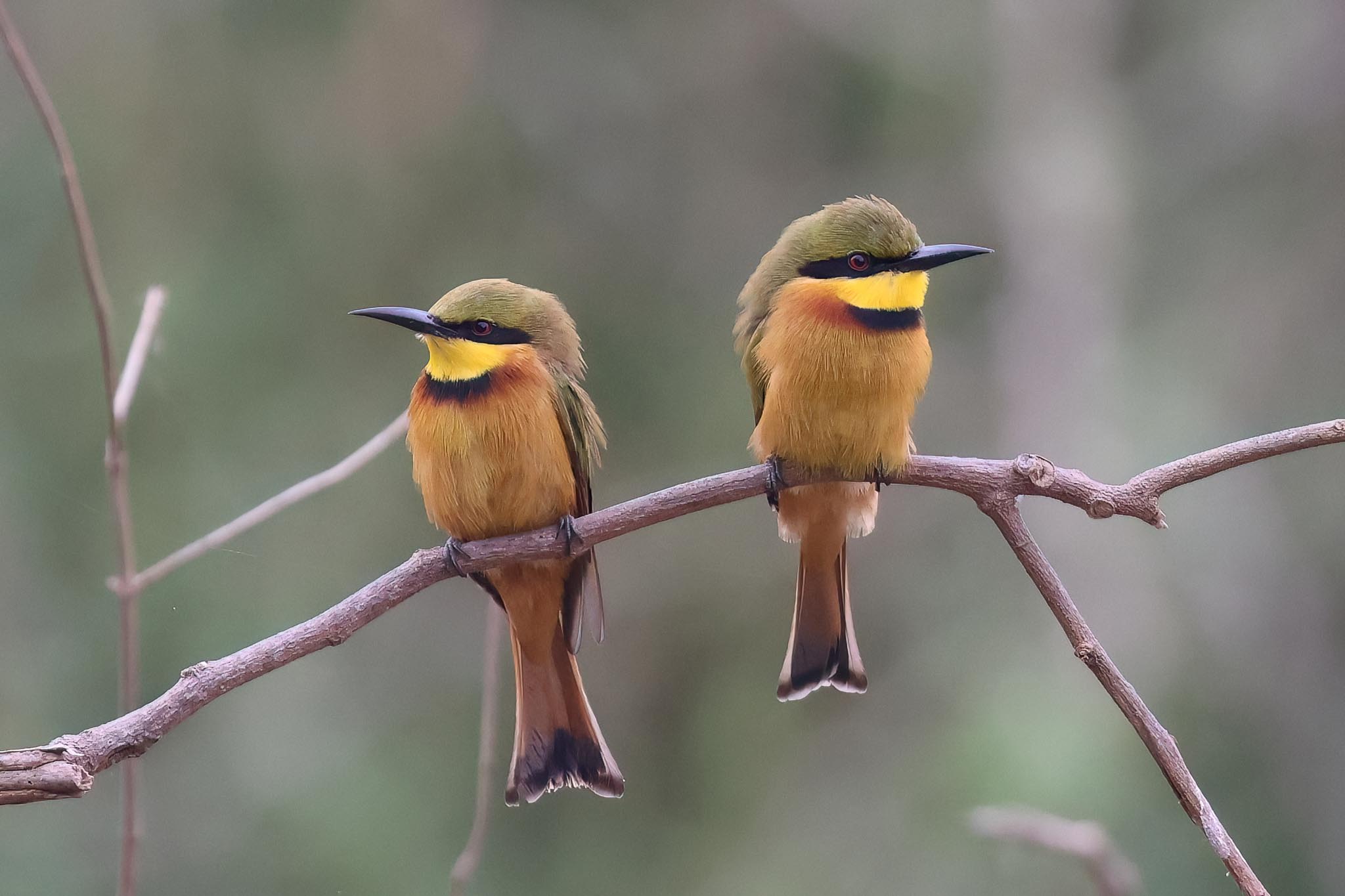
Further on, a couple more young Diederik Cuckoos flew ahead of us and we stopped to watch a Striped Kingfisher displaying in a nearby tree.
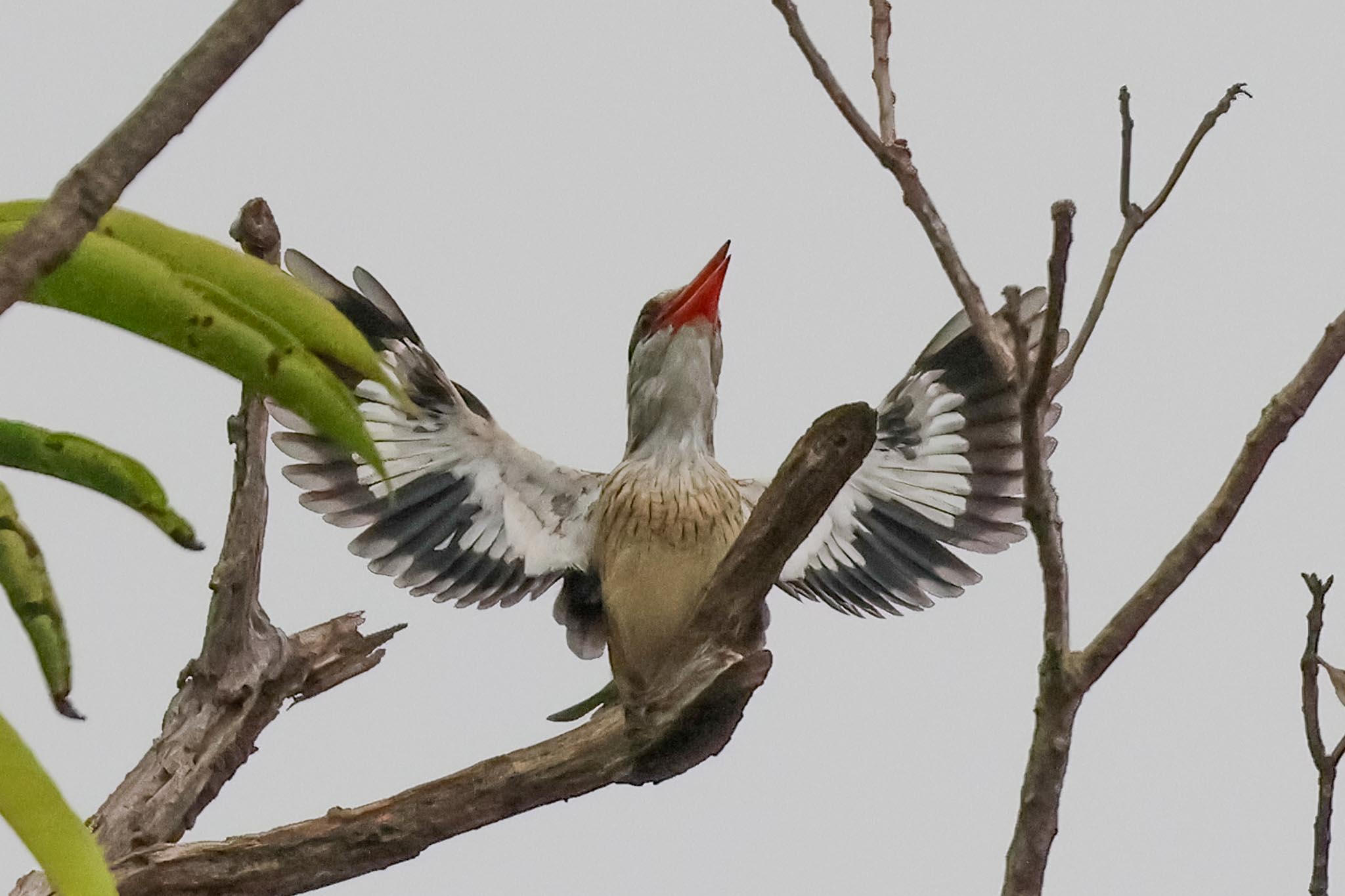
There were lots of birds here – Black-crowned Tchagra, our first Yellow-fronted Canary, Senegal Eremomela, Melodious and Western Olivaceous Warblers, Common Whitethroat, and Tawny-flanked Prinia. We could see two Bearded Barbets further up in the top of a tree and as we made our way out into the fields, we had a much closer view.
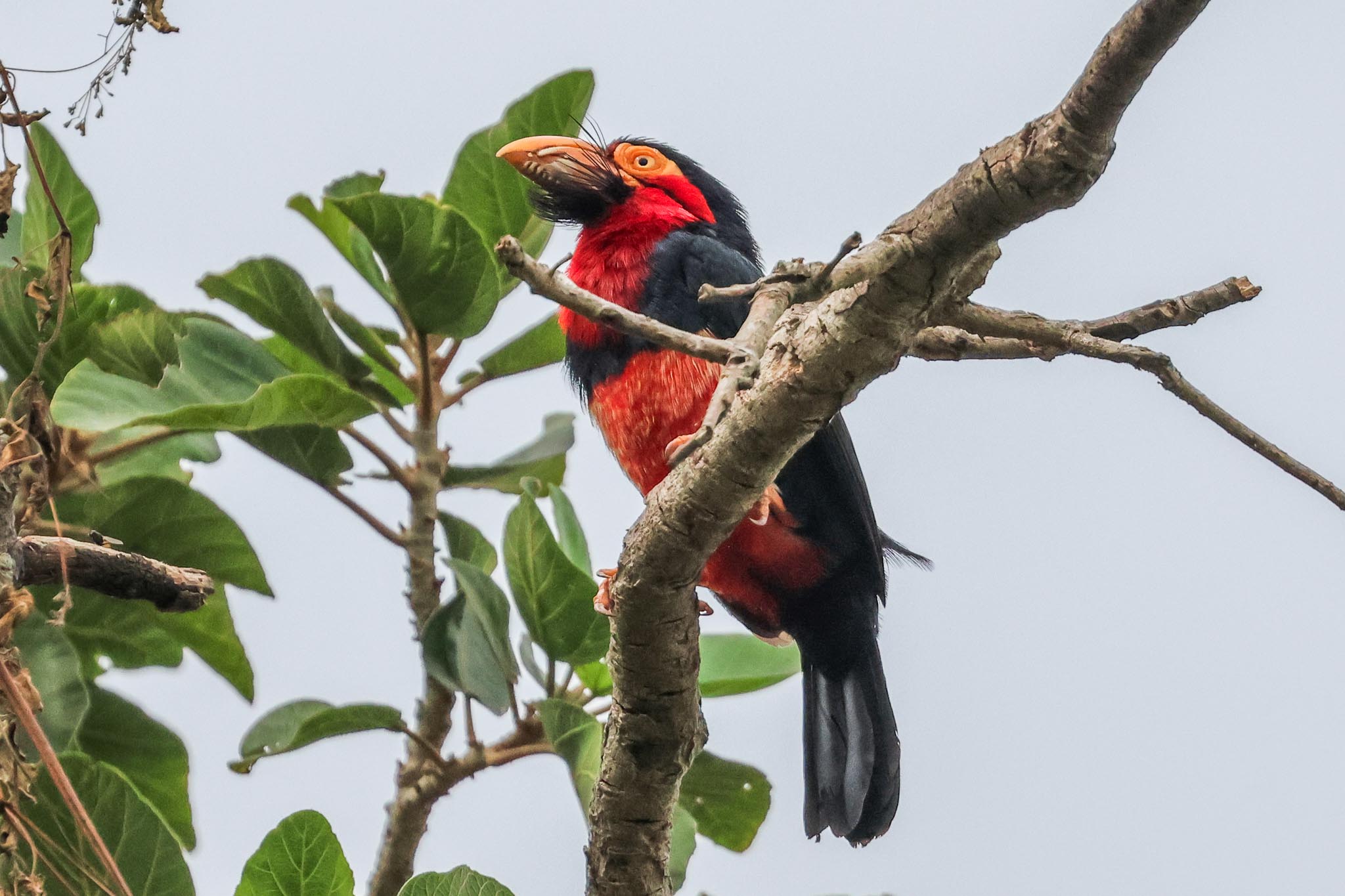
A distant Dark Chanting Goshawk was perched in one tree, two Abyssinian Rollers in another, and two African Harrier-Hawks circled up closer. Several Yellow Wagtails flew up into a bush in front of us. An African Golden Oriole, a young male, flew over and landed in a large tree and when we walked over for a closer look, we found a Western Bonelli’s Warbler in the same tree too.
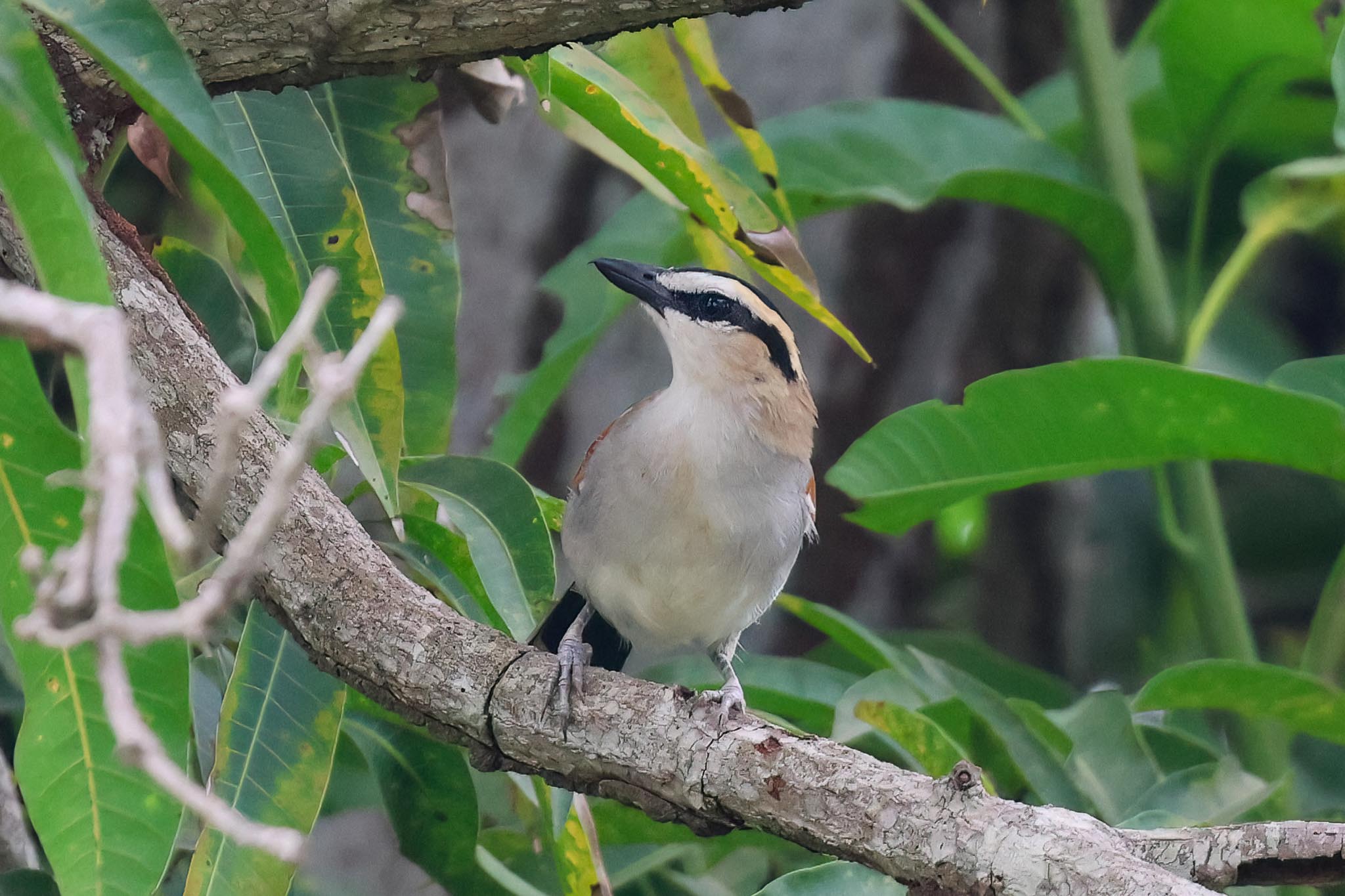
While we were watching those, Modou found a Yellow Penduline Tit and as we gathered to watch it in a nearby acacia a succession of warblers came in too, plus our first Northern Crombec. As we walked back to the main track, a Striated Heron flew past and a flock of Wattled Lapwings came up from the fields and we stopped to watch a Red-winged Warbler singing in a nearby acacia. A couple of Orange-flanked Skinks were hiding in the leaves in the undergrowth by the path and scuttled off as we passed. We paused briefly to admire a giant Baobab Tree – we were informed it is the largest in the Gambia, and it was certainly an impressive size.
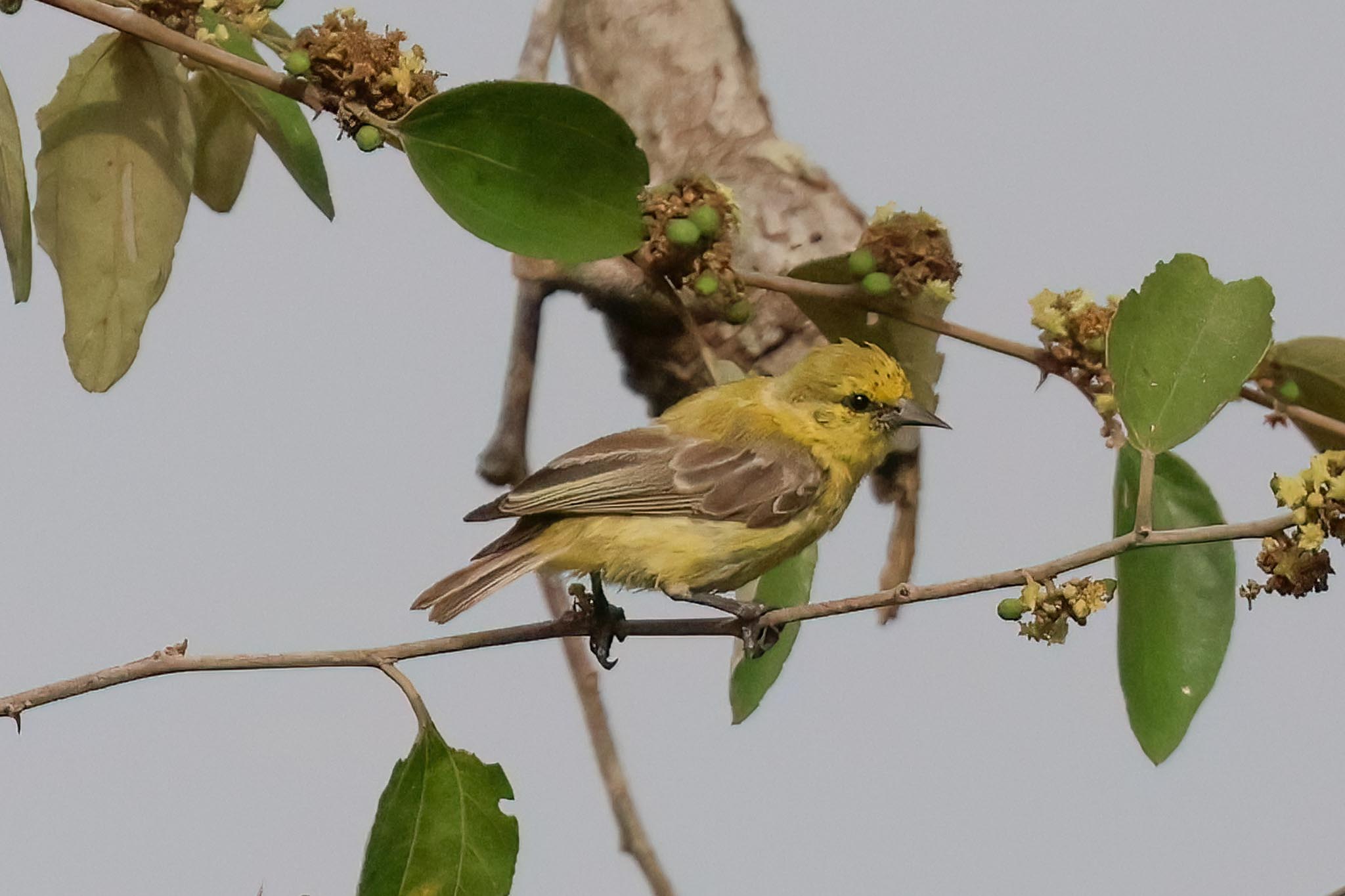
We took a small side path down through some more overgrown cultivations with Modou whistling the call of Pearl-spotted Owlet. More warblers came in to investigate, including a Chiffchaff and lovely close views of Western Olivaceous Warbler, plus Splendid and Beautiful Sunbirds.
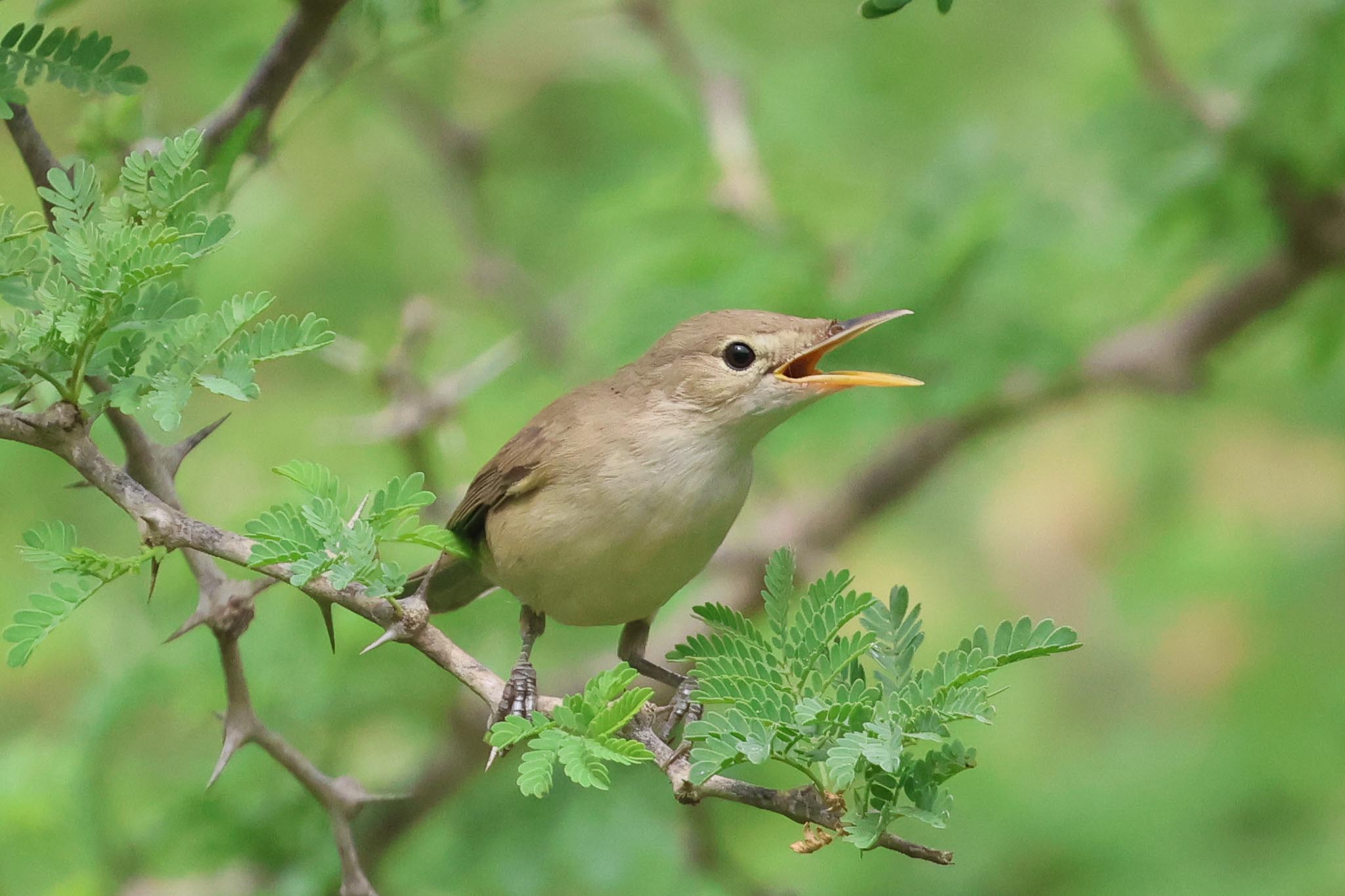
A Lesser Honeyguide flew in to the tree above our heads briefly, followed by another African Golden Oriole, this time an adult male.
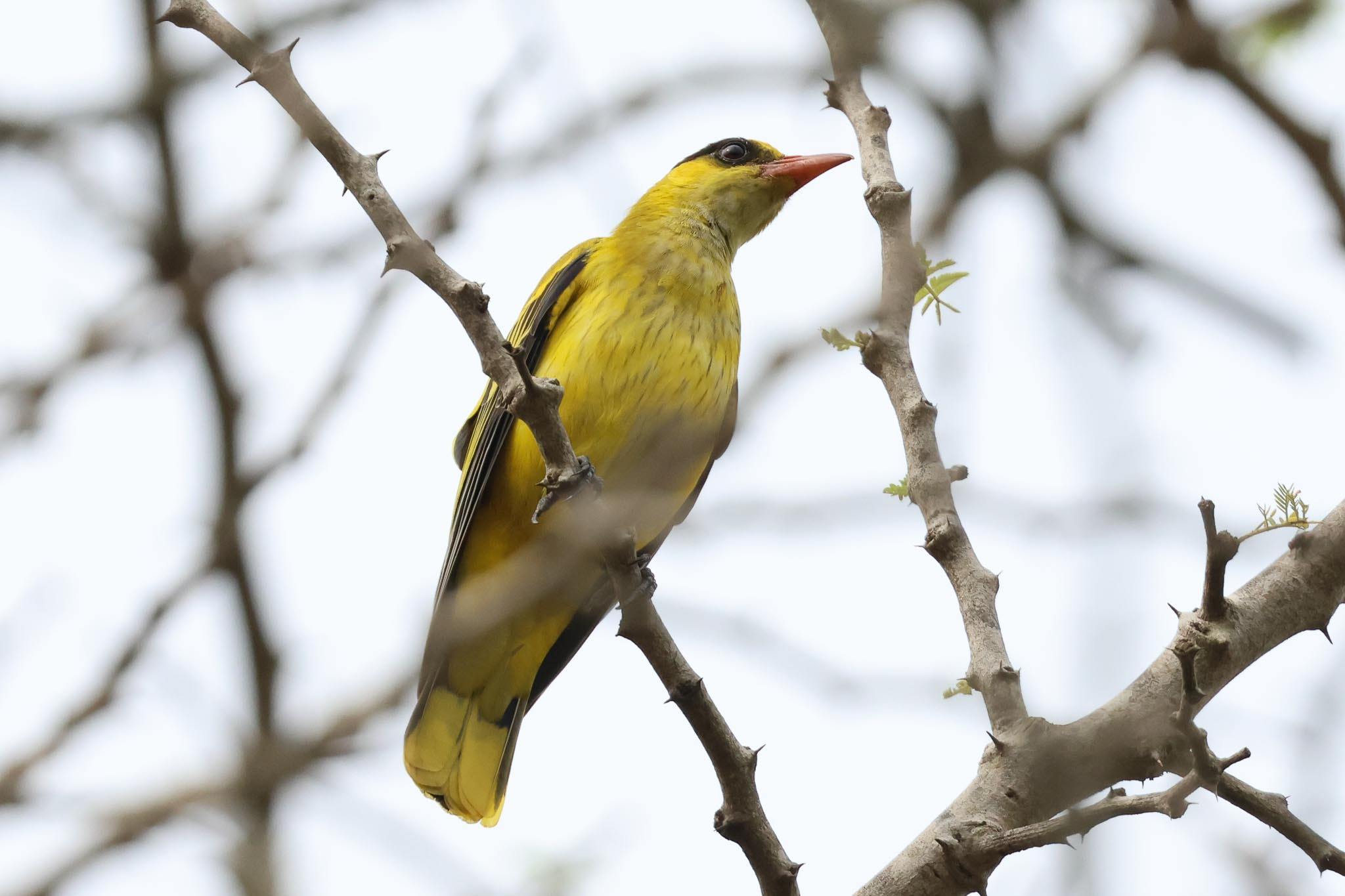
As we made our way now down towards the forest, we found a pair of Cardinal Woodpeckers in the trees by the track, some glossy starlings in a distant tree included Greater Blue-eared with the Bronze-tailed Starlings, and when we heard European Bee-eaters calling, we looked up to see one drift overhead.
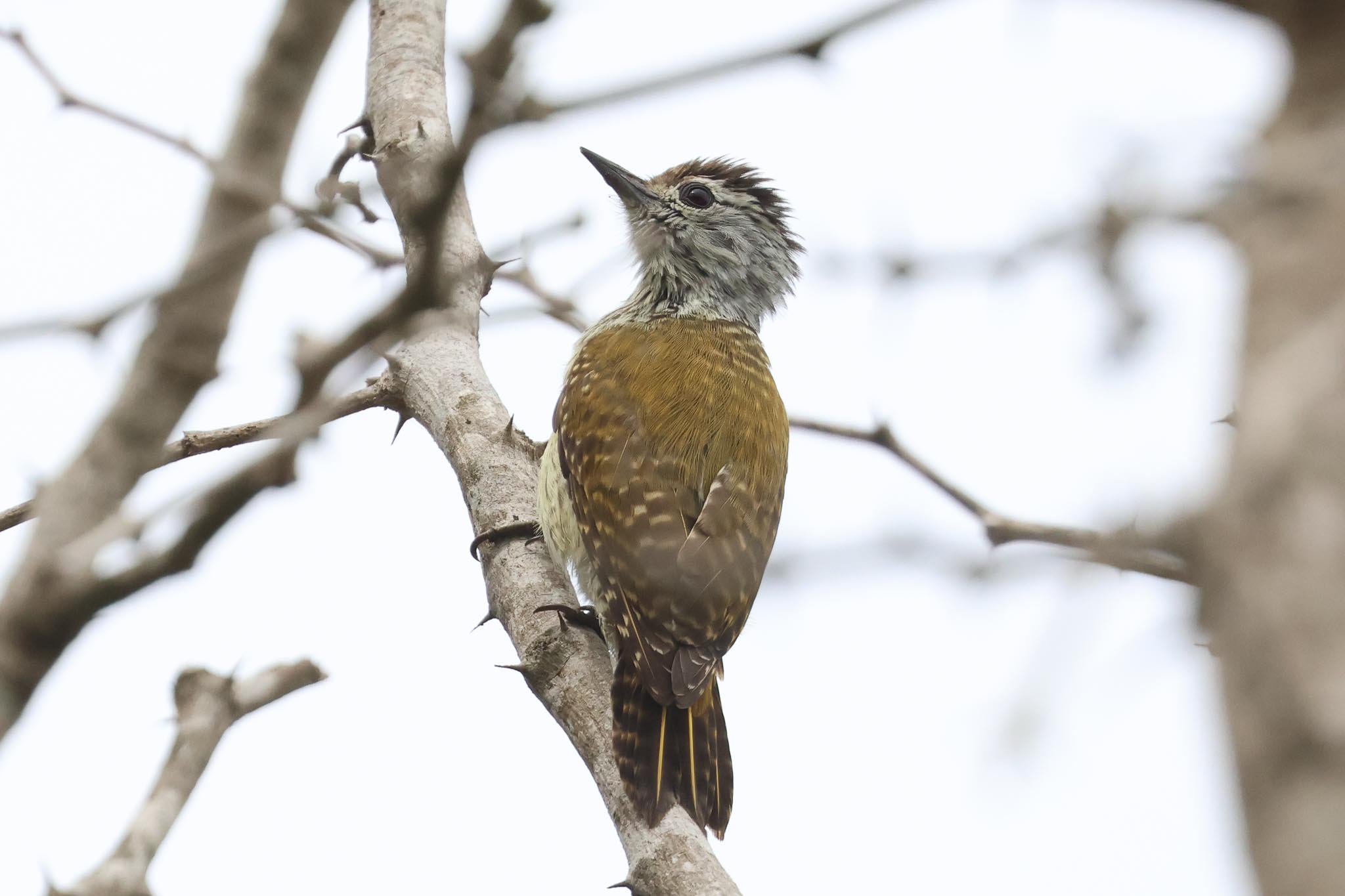
At the entrance to the forest, we sat down on the benches overlooking the drinking pots. We could hear Stone Partridges calling in the undergrowth and after a while three scuttled across the back of the clearing behind the pots and continued to lurk in the undergrowth the other side. We sat for a while and watched, with both Blue-spotted and Black-billed Wood-Doves coming in to drink, Grey-backed Camaroptera and then a Yellow-breasted Apalis flitting around in the trees above, along with a Little Greenbul which was perhaps unfairly awarded the prize for most boring looking bird of the day! We had heard them on previous days, but now we finally managed to see a pair of Brown-throated Wattle-eyes in the trees too. A West African Pied Hornbill briefly in the top of the trees behind was only seen by the leader, so didn’t count.
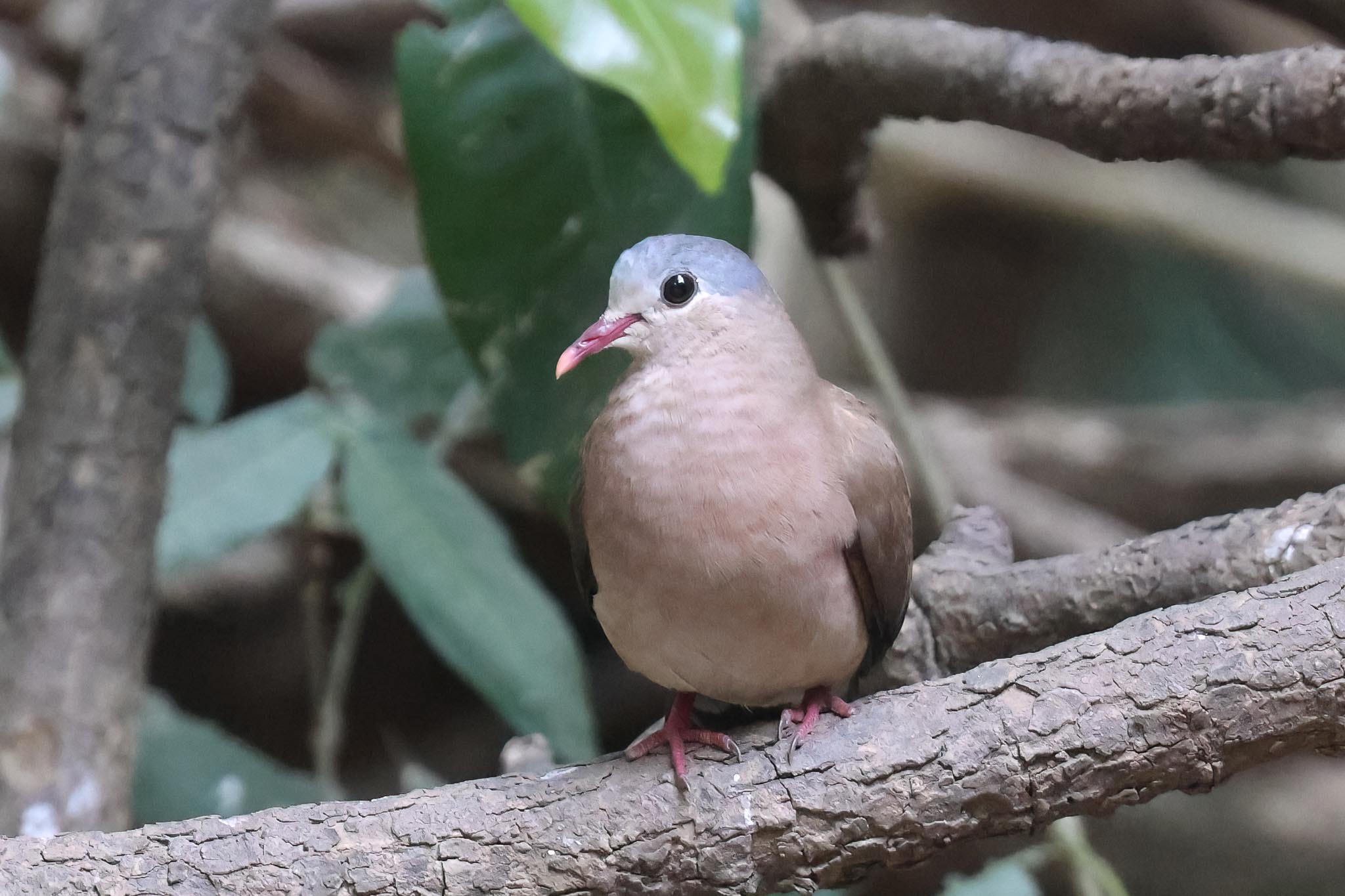
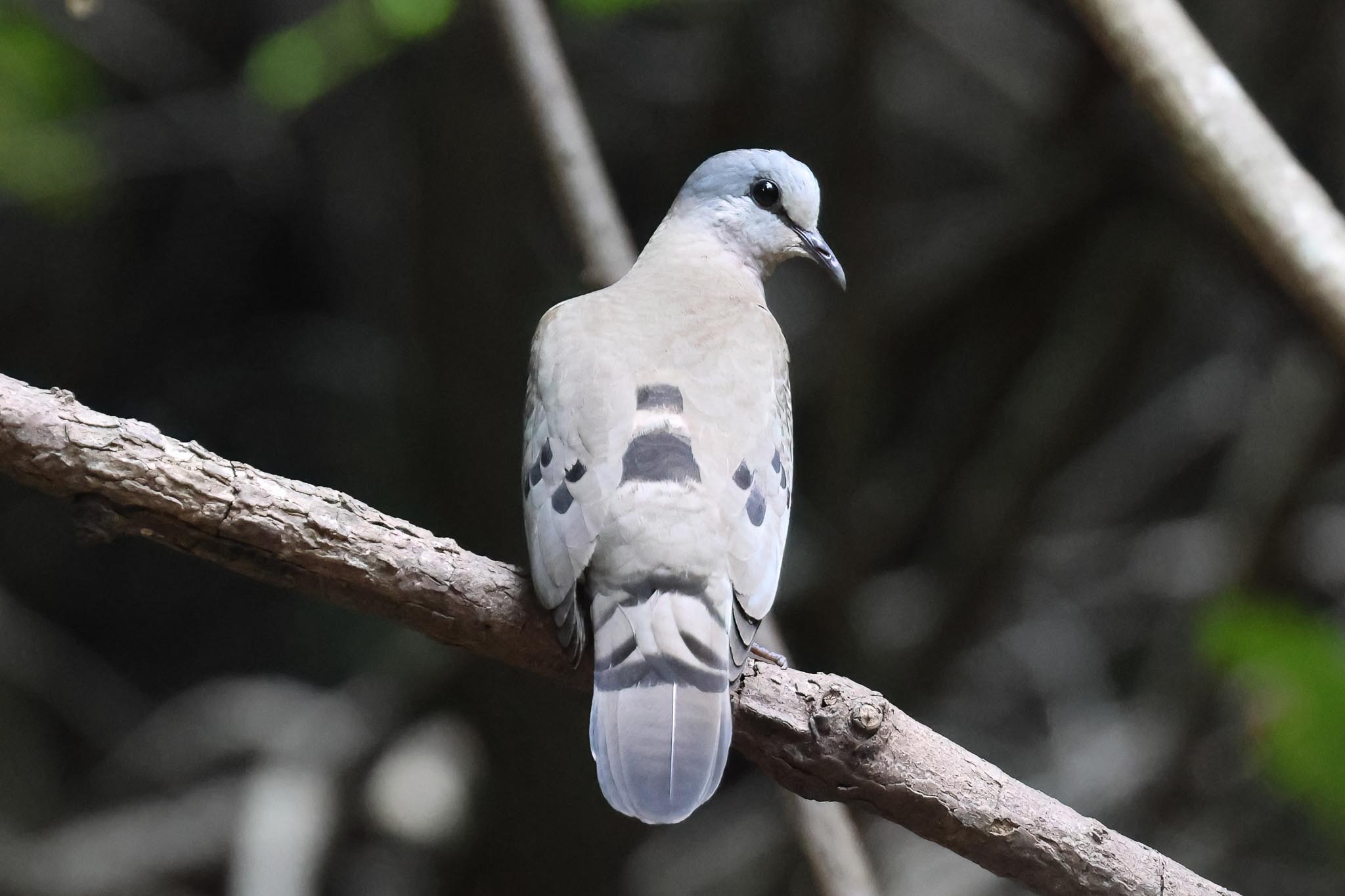
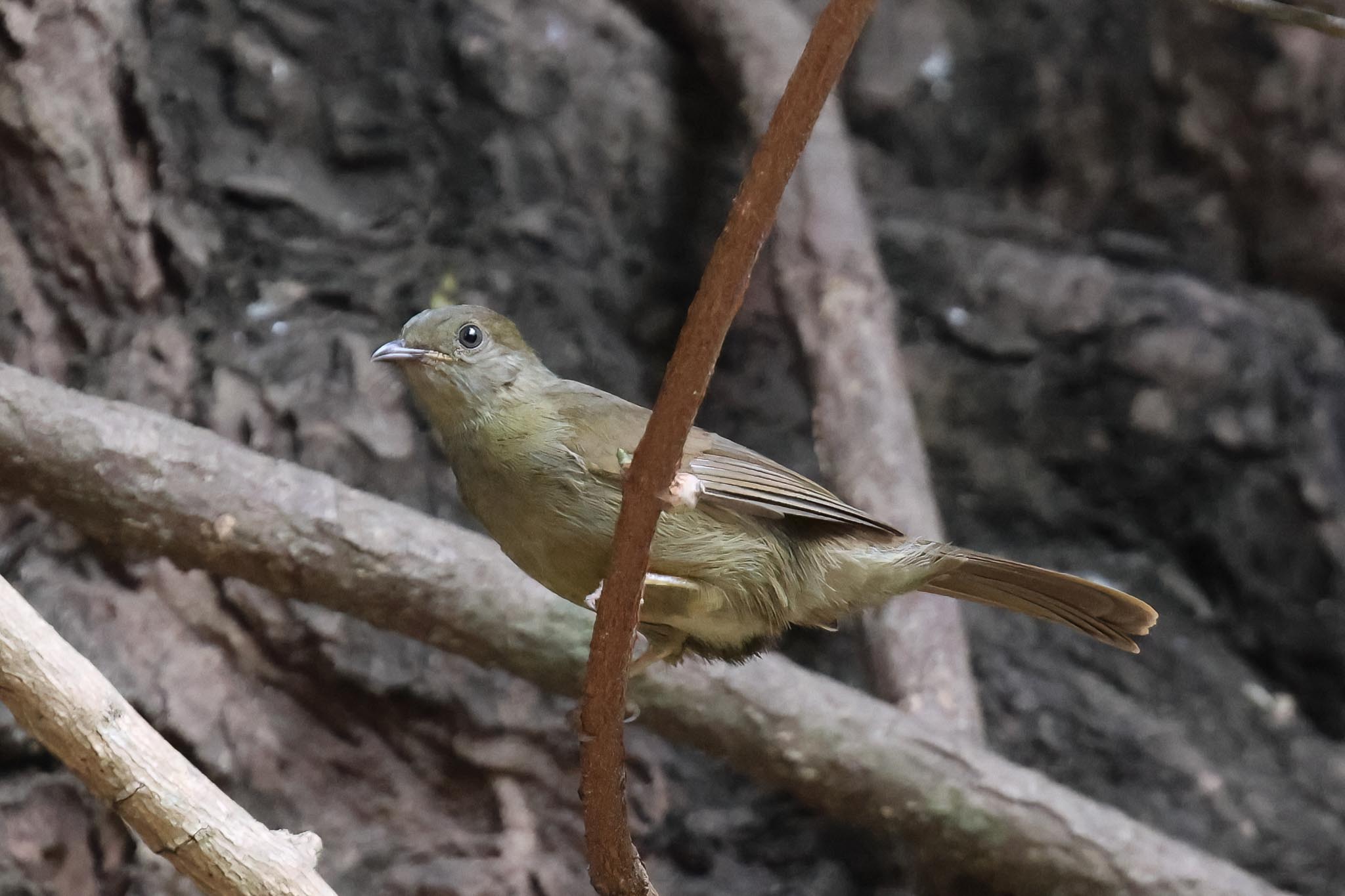
Setting off into the forest, we were joined by one of the local forest guides, nicknamed ‘Bob’. As we entered an area which is good for African Goshawk, we stopped and Modou walked on slowly ahead, scanning the trees. He found one, but twice it flew on before he could get a scope on it, before eventually it settled in view. Most of the group got to see it now, one at a time, until it flew again and disappeared into the trees.
White-backed Night Heron is one of the other specialities we hope to find here, but we were told that none had been seen at their usual roost site this morning. When we got to the edge of the mangroves, Modou and Bob walked on down one of the banks to check, while we waited. After just a few seconds, a whistle meant we were to join them, just in time to see a White-backed Night Heron walking through the branches overhanging the water and disappearing into the thick palms.
Back in the edge of the forest, we stopped to scan the trees. A large flock of Black-necked Weavers appeared, along with an African Paradise-flycatcher, a Grey Woodpecker and another Wattle-eye – like buses! After a short break for a drink back at the pots by the entrance, we had a quick walk down the main track to look for the Pied Hornbill. We didn’t have to go far before Modou located it and once the rest of the group had seen it, we could officially add it to the trip list. Back to the forest entrance, we got in the bus for a short drive round to a nearby area of secondary forest, where Bob led us in through the trees to where two Greyish Eagle Owls were roosting.
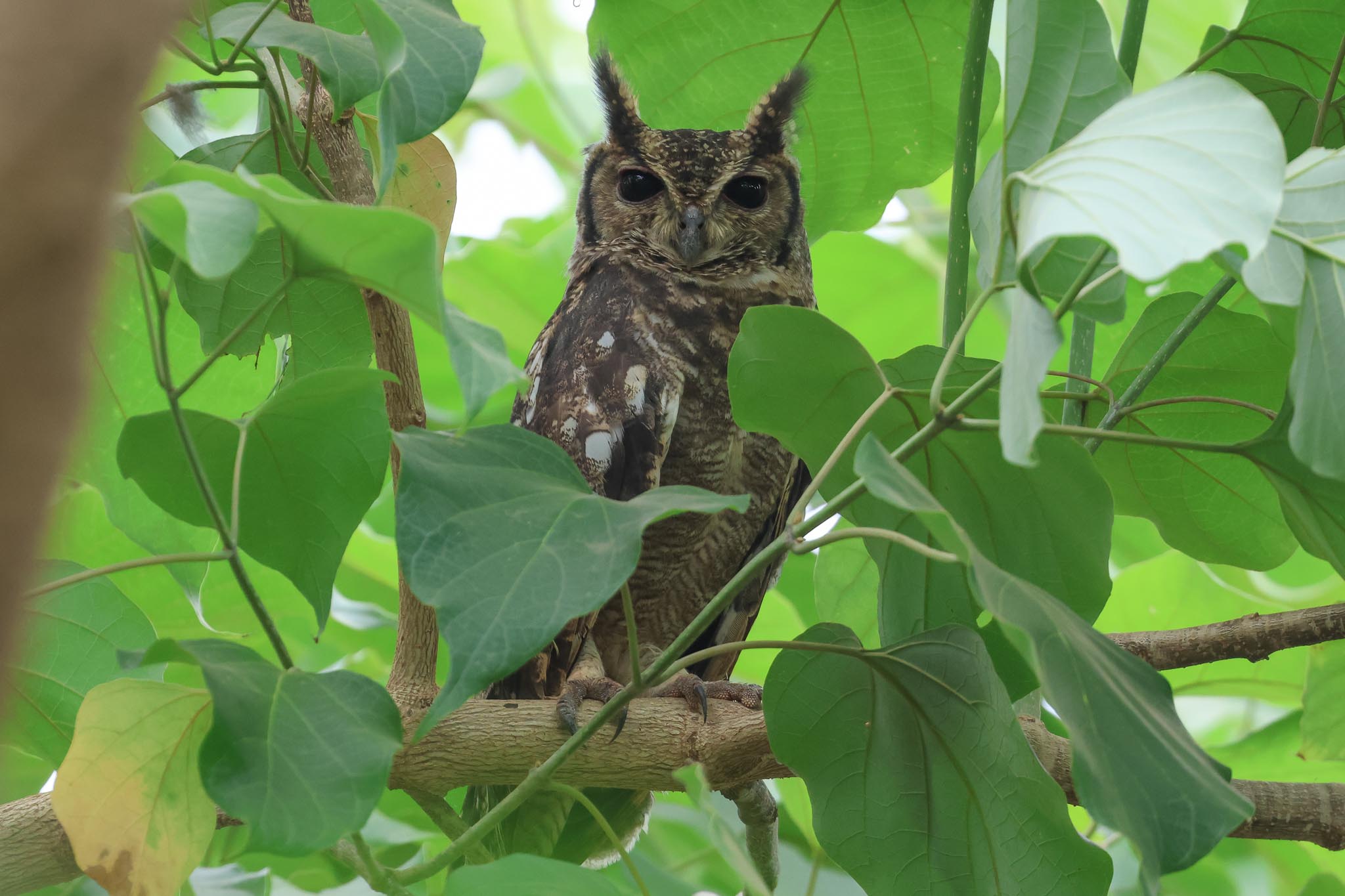
We said our farewells to Bob now and boarded the bus once more for the short drive on down to the jetty on the edge of the mangroves. After all the morning’s excitement, it was already 2pm and thankfully it was just a short boat ride across to Baobab Island for a late lunch. A Great White Egret and Pied Kingfisher were perched in the trees opposite the jetty and several Spur-winged Lapwings and Senegal Thick-knees were on the bank further up as we pulled up to the island. We walked over to the main lodge where several Mauritian Tomb Bats were roosting up in the roof, and sat down to another fantastic buffet of grilled chicken and fish, and rice with peanut sauce.
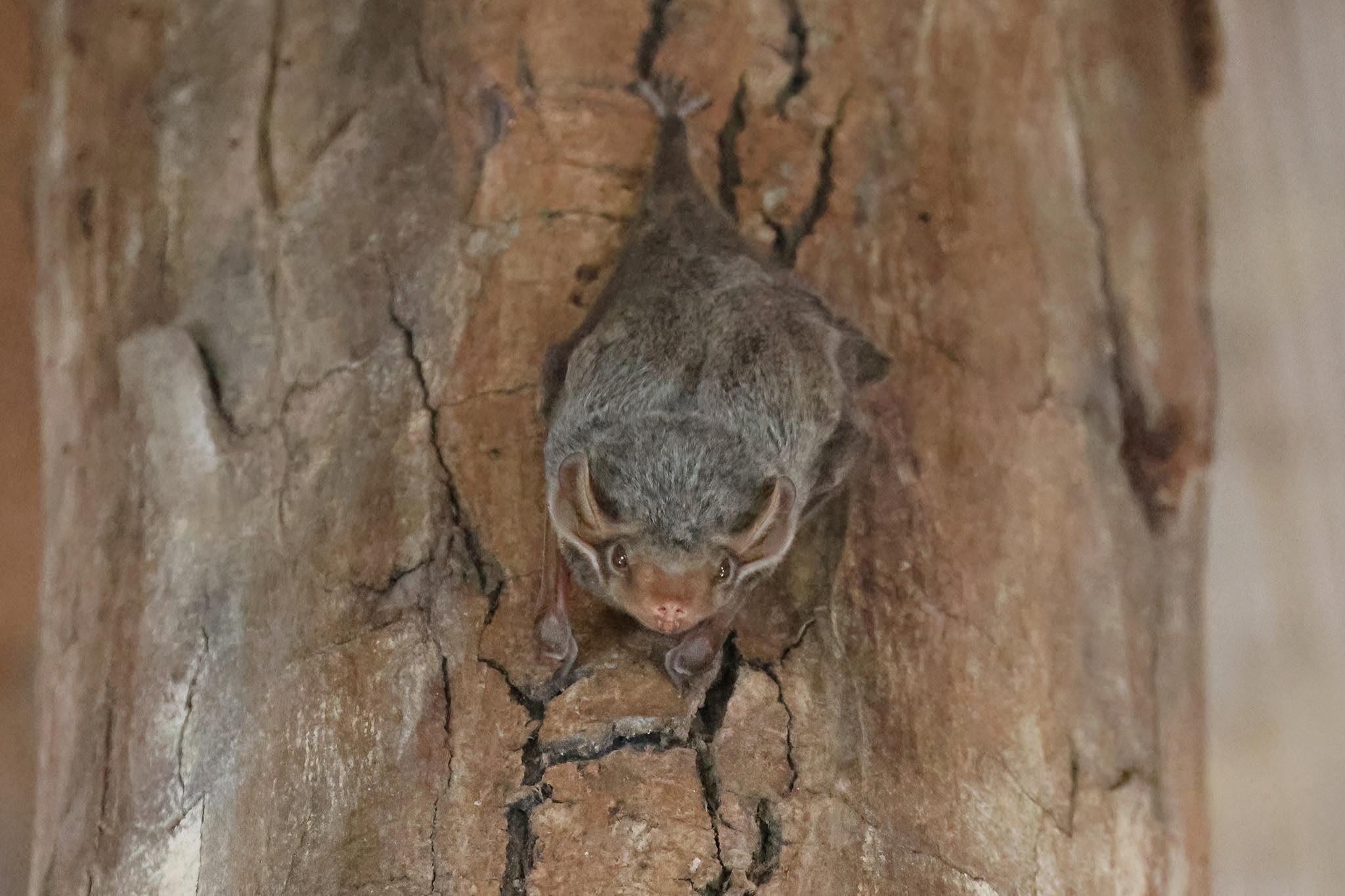
After lunch, some of the group flushed a Redstart from the bushes outside and a Shikra flew over and landed briefly in the top of one of the large baobab trees which give the island its name. While the group made use of the facilities, Modou went off to locate the resident African Scops Owl which showed very well in the edge of the mangroves. Then we boarded the boat back to the ‘mainland’, and on the journey across a Giant Kingfisher flew overhead.
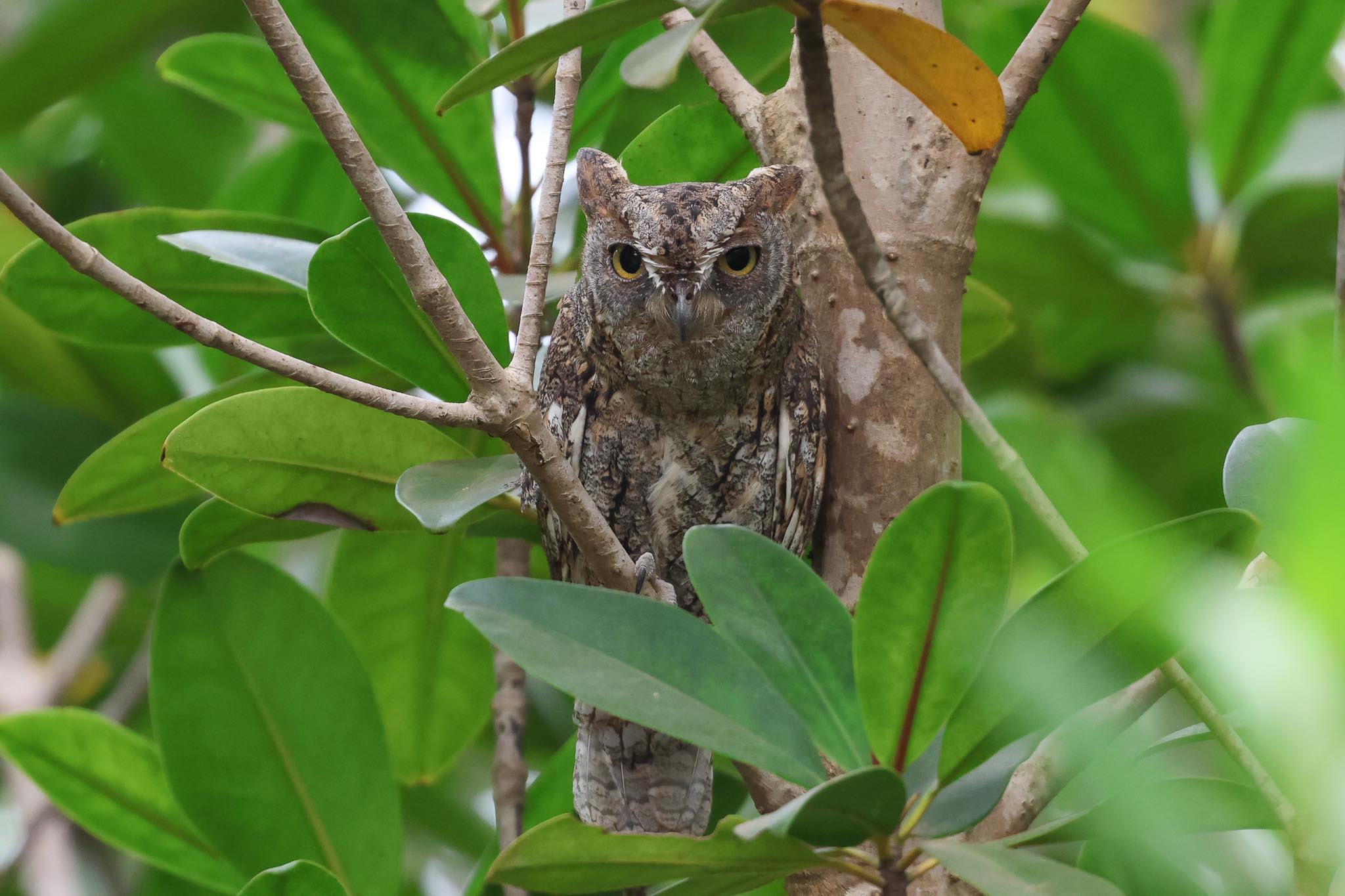
Our last stop of the day was at some nearby drinking pots which are a usually reliable site for Spotted Honeyguide, the scarcest of the three species of honeyguide in The Gambia. When we arrived, it seemed rather quiet and there were fewer birds than usual coming in to drink. While we sat in the hide and watched, there were a few waxbills, female bishops and Grey-headed Sparrows coming in. A male Common Redstart in the trees behind was a grip back for those who had missed the one earlier.
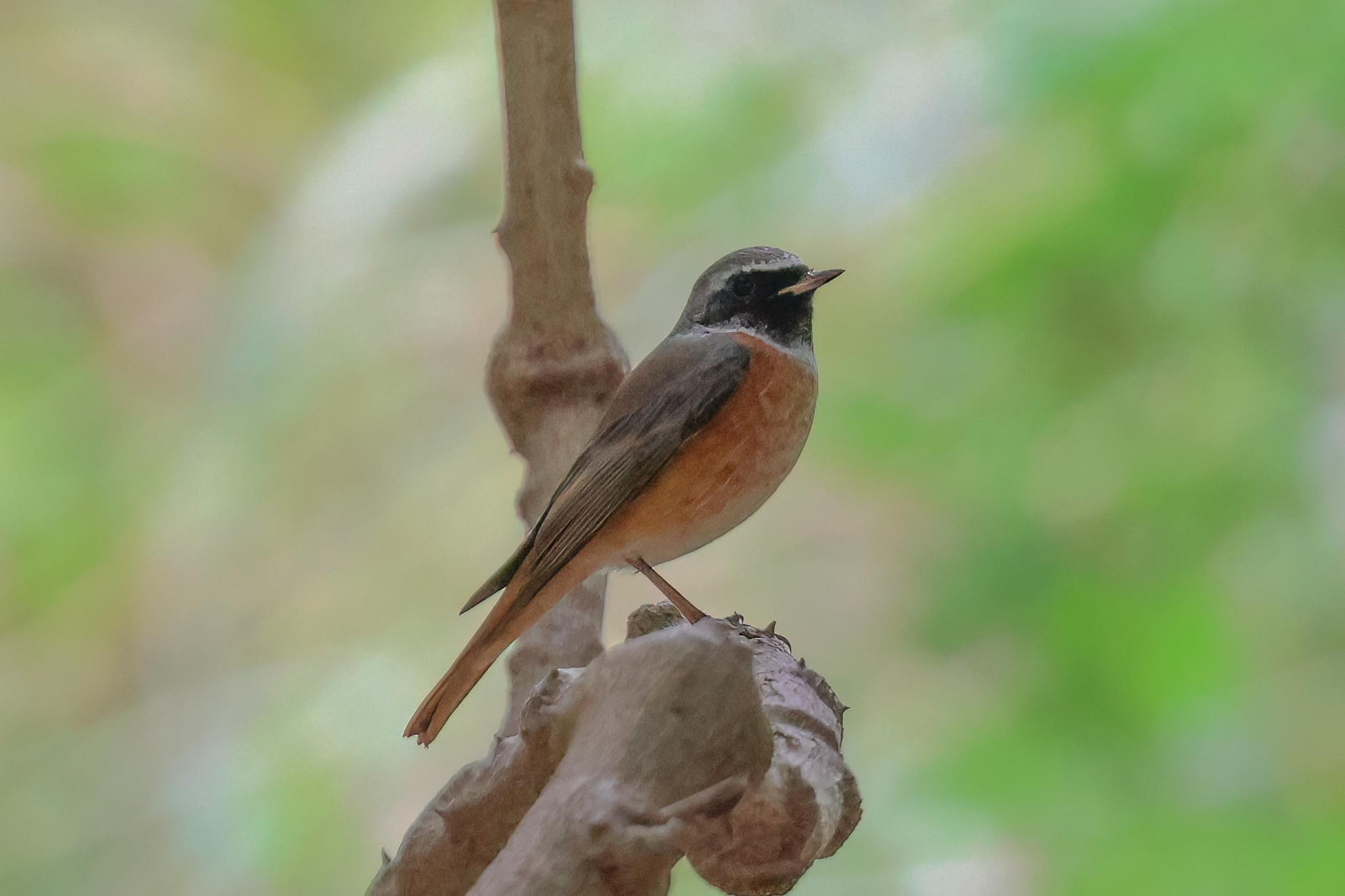
A smart male Northern Puffback dropped down through the branches briefly, and two Blackcap Babblers came down to the pots. Both species of Wood-Dove came down to the pools to drink, as did a Vinaceous Dove too. But there was no sign of the Spotted Honeyguide now and eventually we had to call it a day and head back.
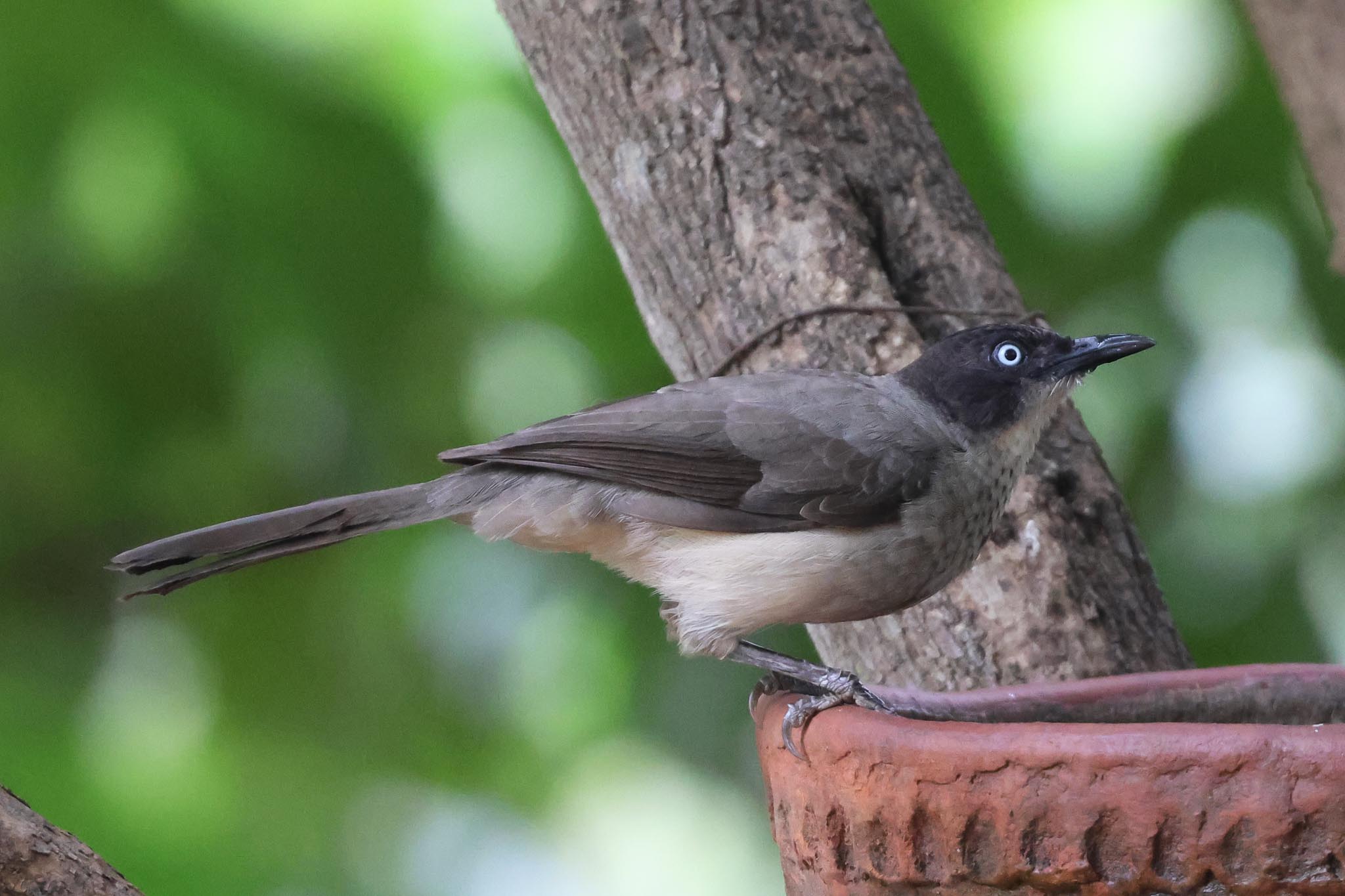
As we drove out through the fields, a Dark Chanting Goshawk was perched in the top of a tree by the track. Through the village, all the small children were waving at us as the bus passed through, as usual. Despite a bit more traffic tonight, we were still back to the hotel in good time to have a break, freshen up, and change some money for those who needed to, before we met as usual for dinner, and afterwards went through the day’s list.
TUESDAY 21ST NOVEMBER – Cloudy am, clearer pm, humid with light winds, 32C
It was to be a long drive down to the Senegal border today, so we were hoping to get away slightly earlier. The staff at the hotel restaurant were reluctant to let us start helping ourselves to breakfast any earlier than the official start time of 7.00am but we tried not to upset them whilst surreptitiously getting ourselves an early coffee or juice and still managed to get out to the bus 10 minutes before our usual meeting time. Unfortunately, we then found that Modou had a flat tyre and so didn’t get to us until 7.30am anyway. Thankfully the traffic wasn’t too bad getting away from the strip and we still got down to Sohm by around 9am.
Turning off the main road, we took a track out into the middle of some overgrown cultivations. As we got out of the bus, a Senegal Batis was calling nearby and eventually came in to the bushes by the track. There were not many other small birds though, perhaps not helped by two Dark Chanting Goshawks which repeatedly flew round low over the bushes right in front of us. Two Lanners flew away over the scrub away to our right and a Mottled Spinetail disappeared off to our left.
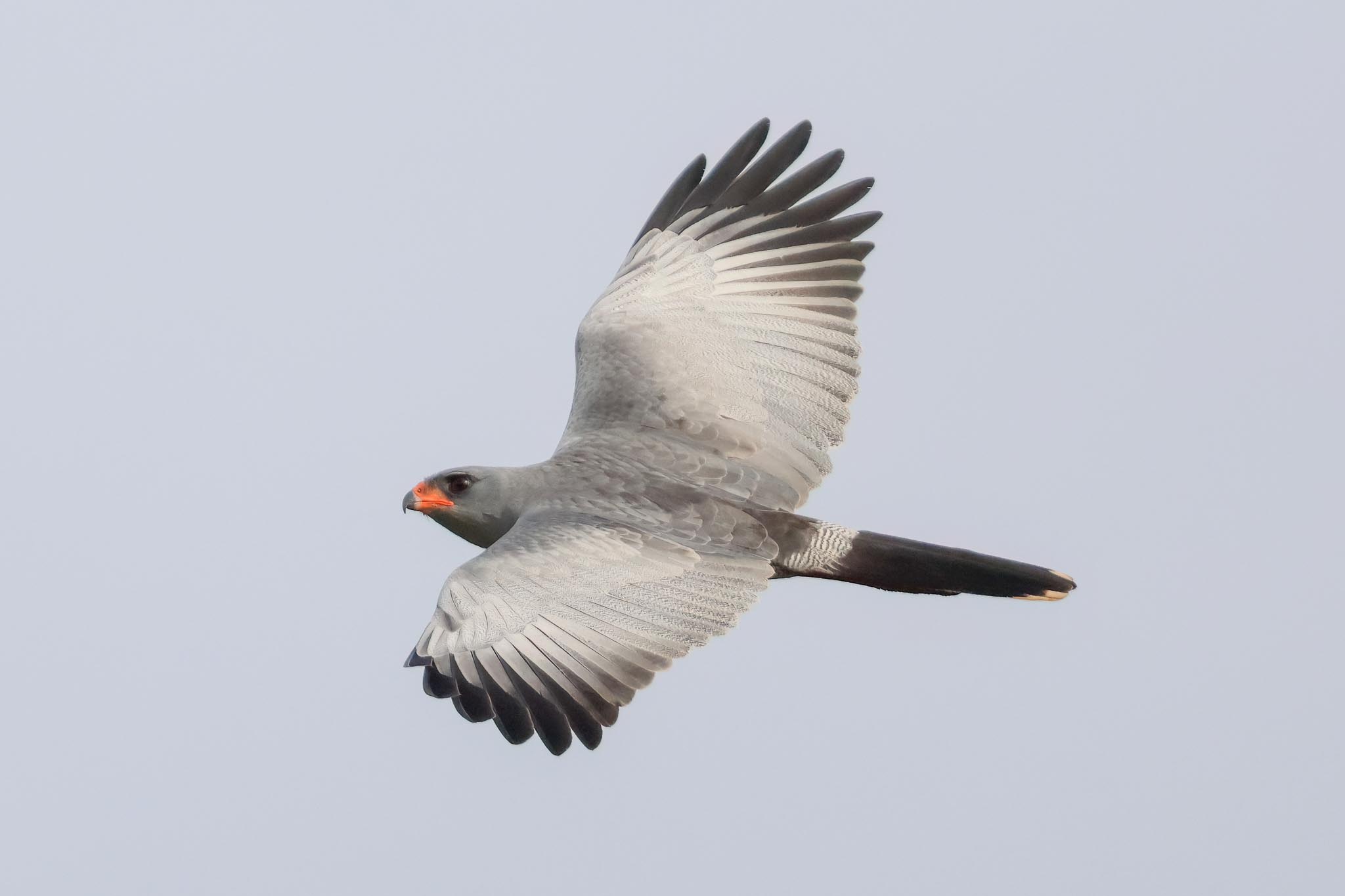
As we walked a short way along the track, a Copper Sunbird appeared in the bushes and when we stopped to look we found two – an adult and an immature male. The call of Pearl-spotted Owlet, which Modou is very adept at whistling, brought several other birds in to investigate too – including a Northern Yellow White-eye, a Garden Warbler, a Red-winged Warbler, a couple of Canaries and a Willow Warbler. A Pied-winged Swallow zipped over briefly, and a Pallid Swift appeared overhead with a flock of Palm Swifts.
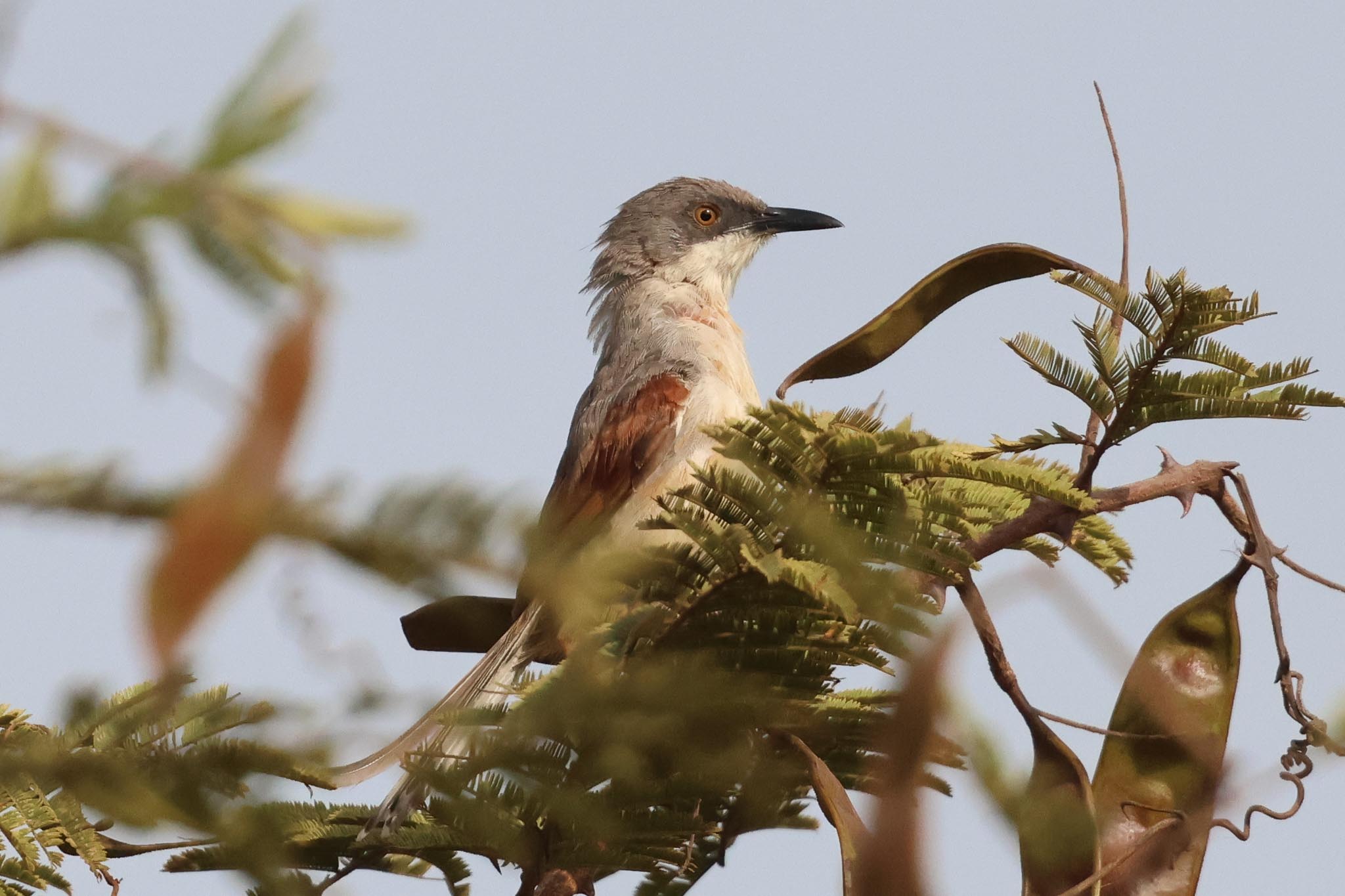
We turned in along a narrow path through the cultivations and out onto another wider track. We had seen lots of good birds in this area last year, but despite trying various calls it was disappointingly quiet here now, so we quickly decided to cut our losses and try somewhere else. Back to the bus, we drove a bit further on, and stopped by a patch of secondary woodland. As we walked down along the track skirting the trees, a flock of White-crested Helmetshrikes appeared, flying through the branches, in and out of the trees, looking down at us, and eleven eventually came out together. Smart birds with their punk white crests. A Mosque Swallow over the bushes the other side of the track was another new bird for the trip.
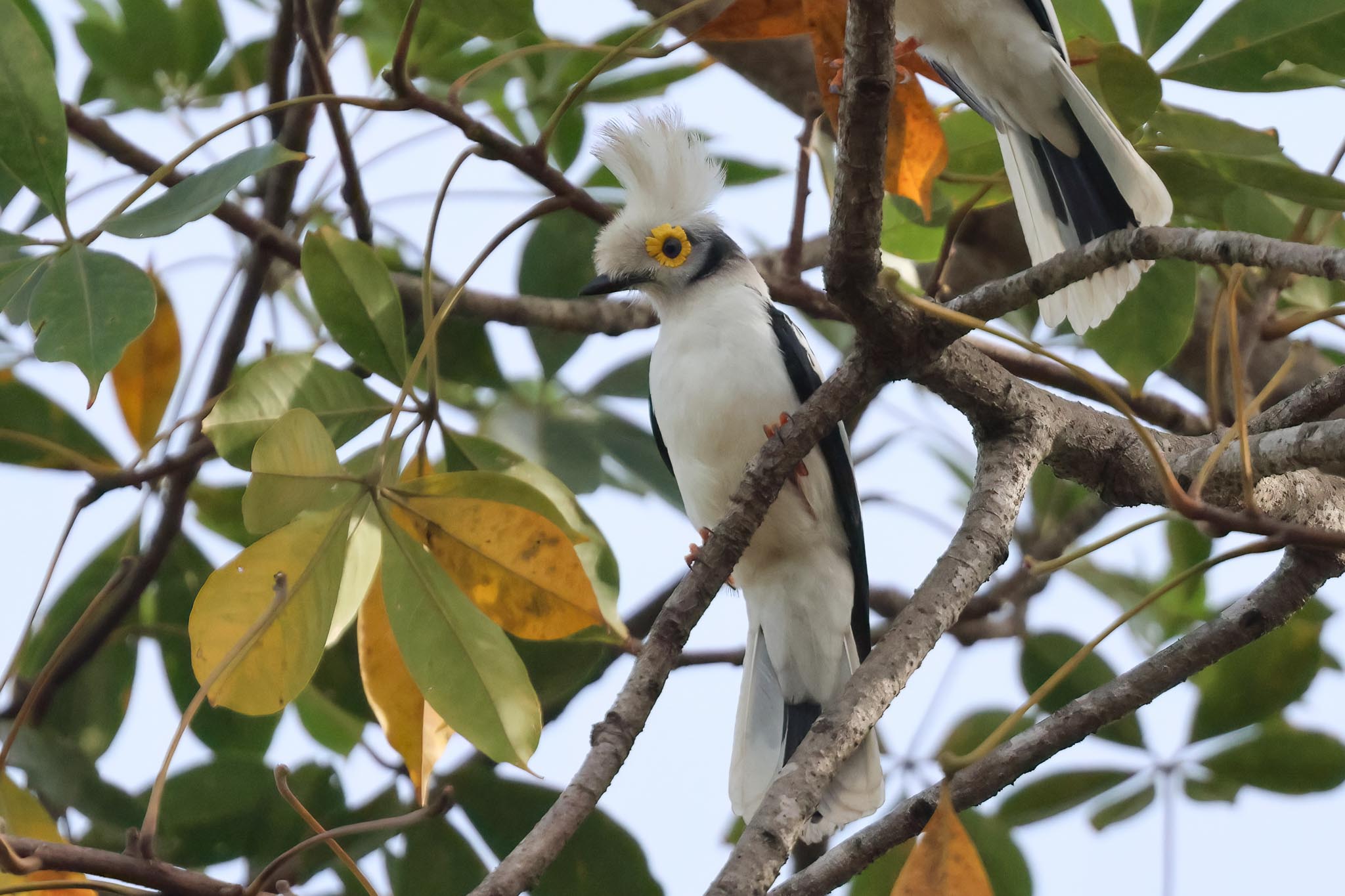
Cutting into the wood, Modou started to whistle Pearl-spotted Owlet again, and the Helmetshrikes immediately appeared once more, followed by a Western Violet-backed Sunbird, which was a bit tricky to see as it kept to the tops. Two Pearl-spotted Owlets responded as well, and one flew in, getting mobbed by the Helmetshrikes, before eventually giving up and flying off. An African Joker took a liking to Modou’s scope – a rather scarce butterfly in The Gambia.
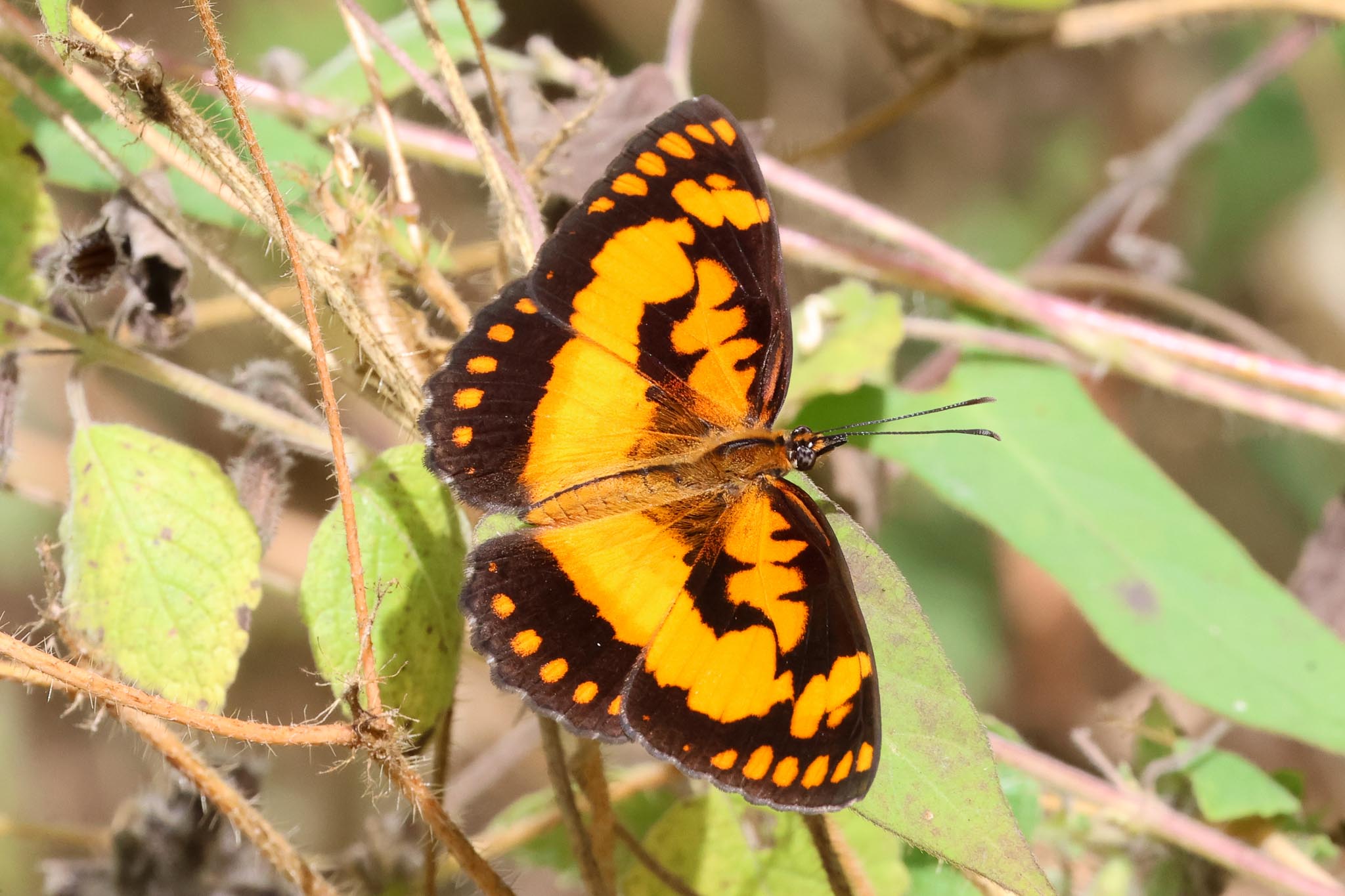
Back out of the wood, a Wahlberg’s Eagle drifted over high, going away from us all the time, before another then circled briefly over the fields beyond the bus with a Yellow-billed Kite. A smart Guineafowl butterfly landed on the track beside us.
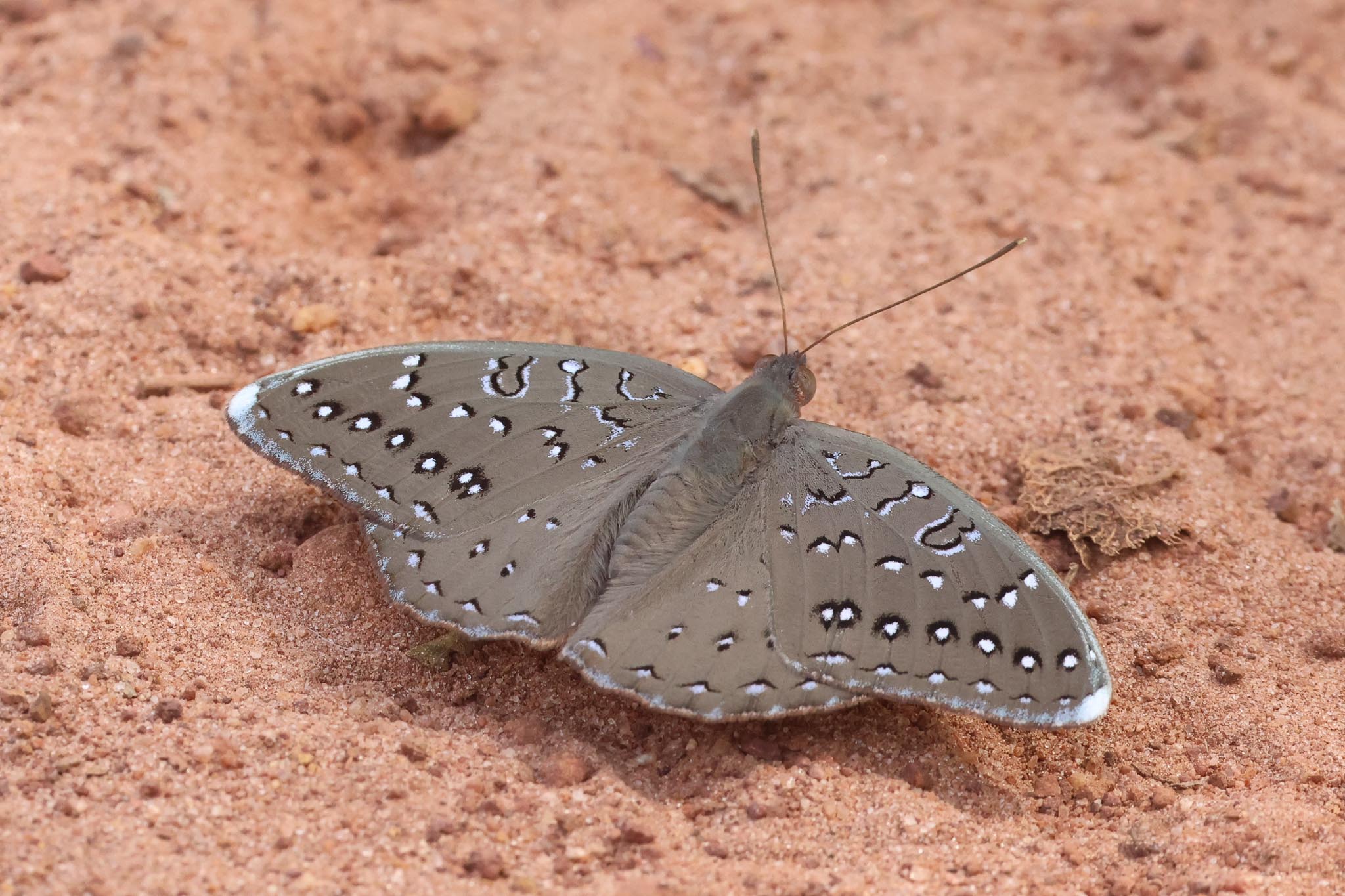
As we drove on, through the border customs post, there were a couple of Yellow-billed Oxpeckers on some cows by the track. We pulled up by a more open area of savannah woodland, grazed by more cattle, and got out of the bus for a walk. A pair of Blue-bellied Rollers were perched on some nearby trees along with a brief Rufous-crowned Roller. Several swallows hawking low overhead included a single young Barn Swallow and a few European Bee-eaters flew round above the trees too.
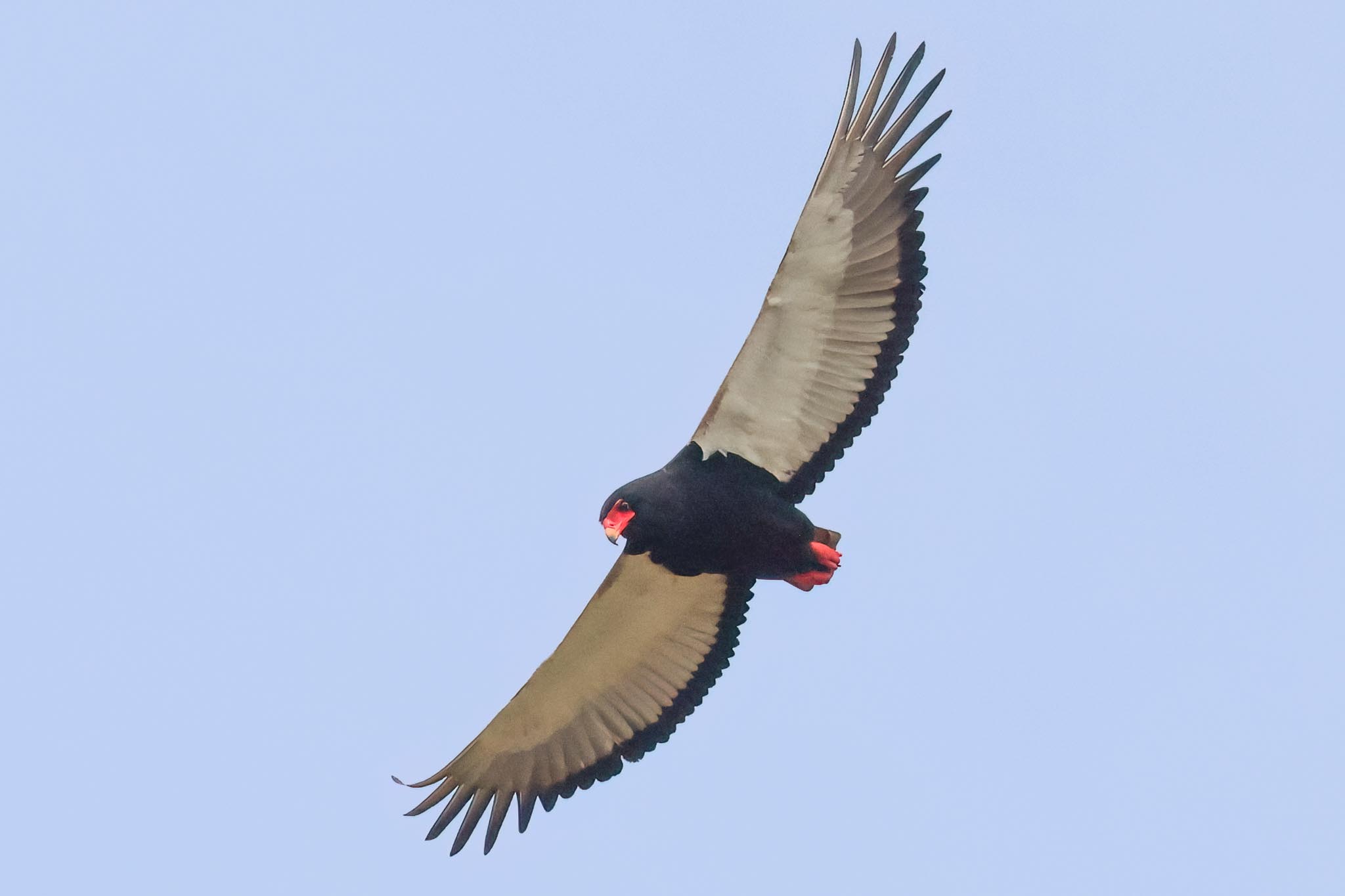
Bateleur was on the wanted list and we were not disappointed, as the first of at least two we would see here this morning now passed low overhead and then another circled round. It was warming up and a couple of Palm-nut Vultures flew up now, and a Pink-backed Pelican circled over high with a kettle of Hooded Vultures. Walking on between the trees, we found a family of Green Wood-hoopoes and a little further on, we came across a Black Scimitarbill as well, smaller and blacker than the Greens.
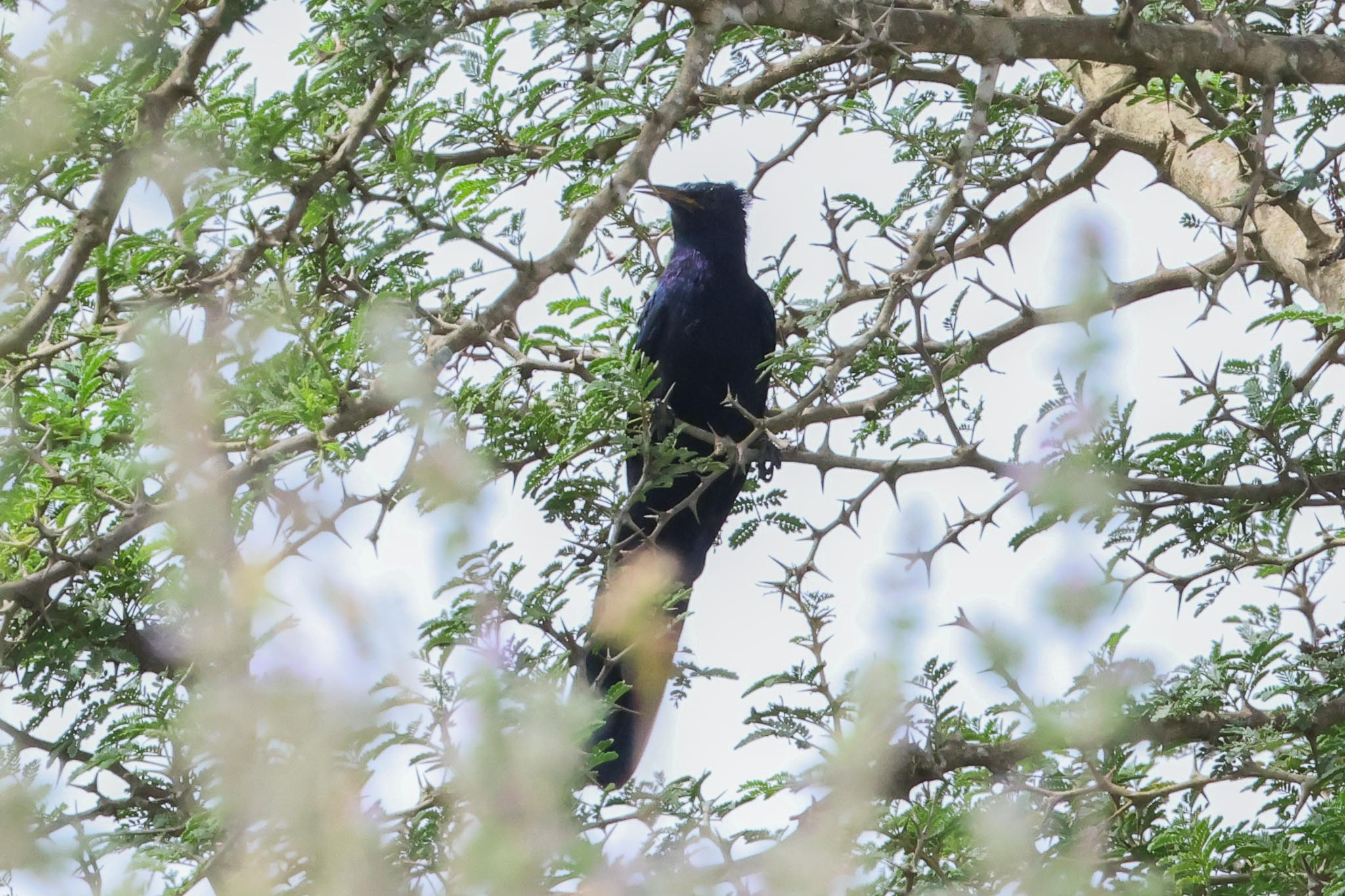
There is a small pool here and as we approached, several Wattled Lapwings flew round calling. A couple of Broad-billed Rollers were hawking repeatedly over the pool, along with one or two Fanti Sawwings, and a variety of birds were coming down to drink and perched in the nearby bushes. There were a couple of Pin-tailed Whydahs in with all the Bishops, though unfortunately no breeding males.
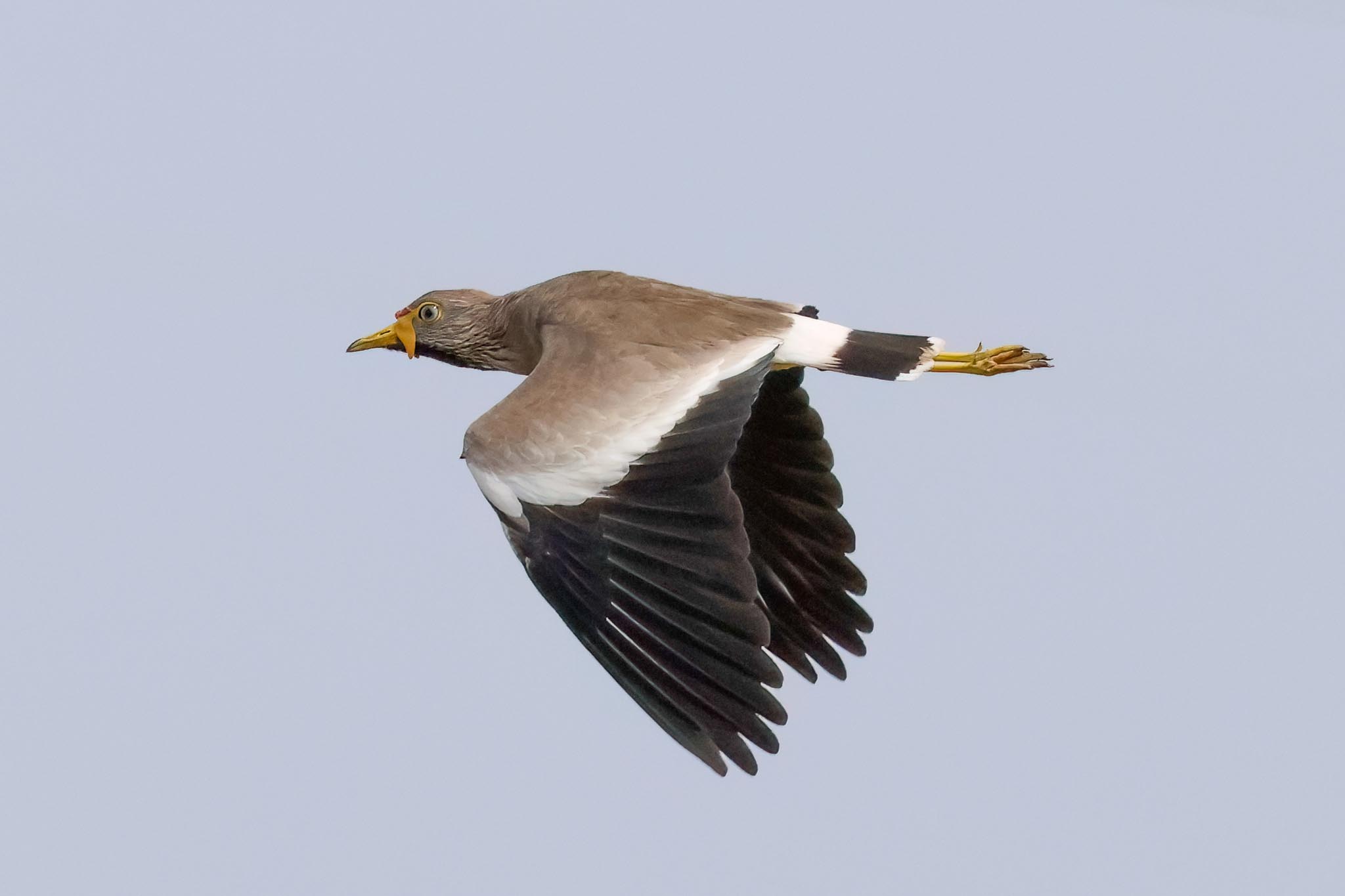
Lots of butterflies were feeding on some fresh dung on the bank – including several Angolan White Ladys, Veined Swordtails and an African Marbled Skipper. In the trees beyond, we found lots of Grey-headed Sparrows and several Village Indigobirds with them, another Oxpecker, this time perched in a tree (Treepecker?!), Northern Crombec, a pair of Senegal Eremomelas and two Fork-tailed Drongos flew over. Working our way back round towards the track where we had started, we heard a White-shouldered Black Tit calling, and eventually it showed well in the nearby trees, at one point joined in the same tree by a Brubru.
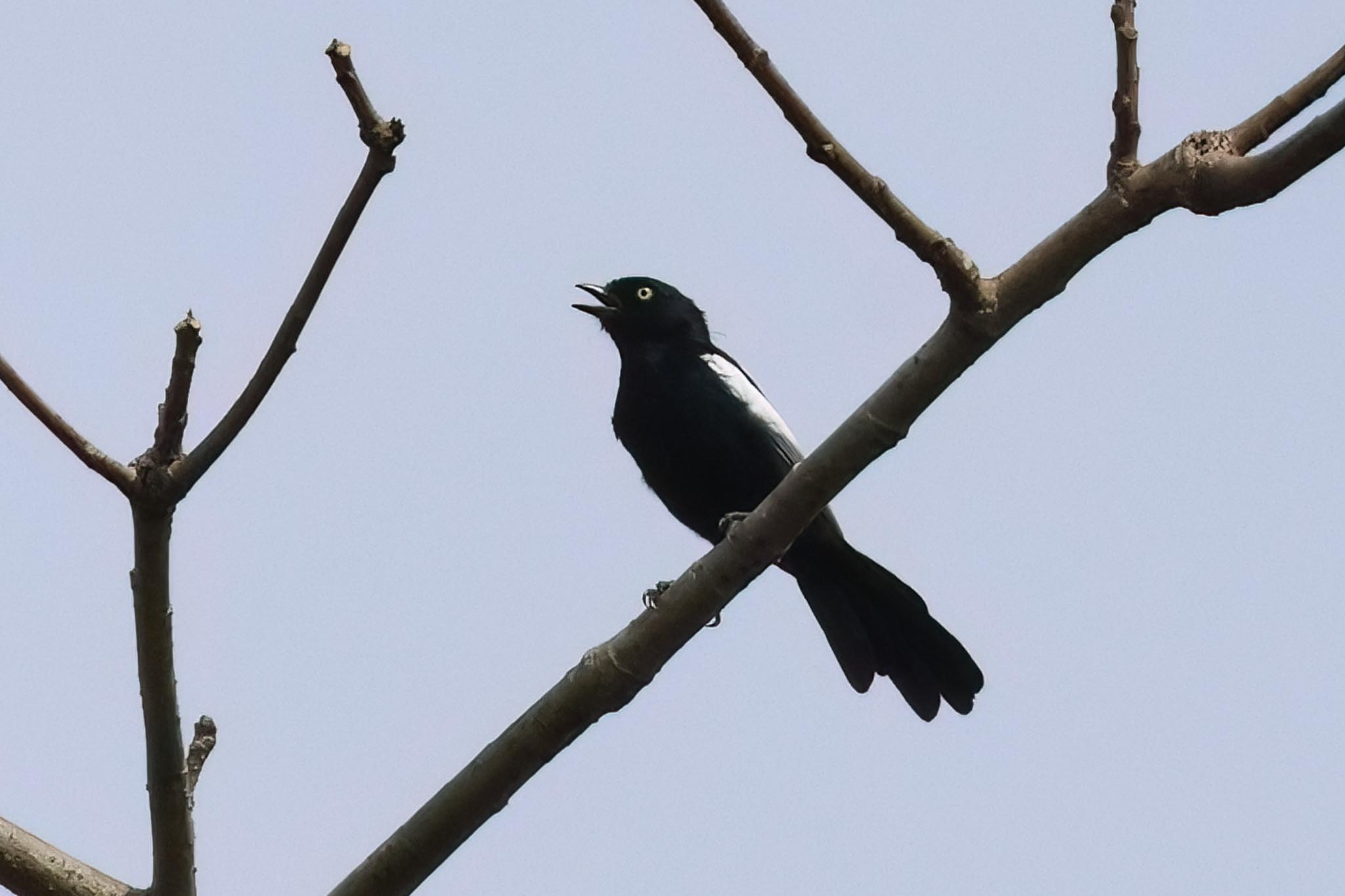
We stopped to look at a pair of Yellow Penduline Tits and a Wryneck flew up into the tree behind, another nice Palearictic migrant and uncommon here. Walking on, we came across a Swallow-tailed Bee-eater, Tawny-flanked Prinia and Lavendar Waxbill in the trees before we found ourselves back at the bus.
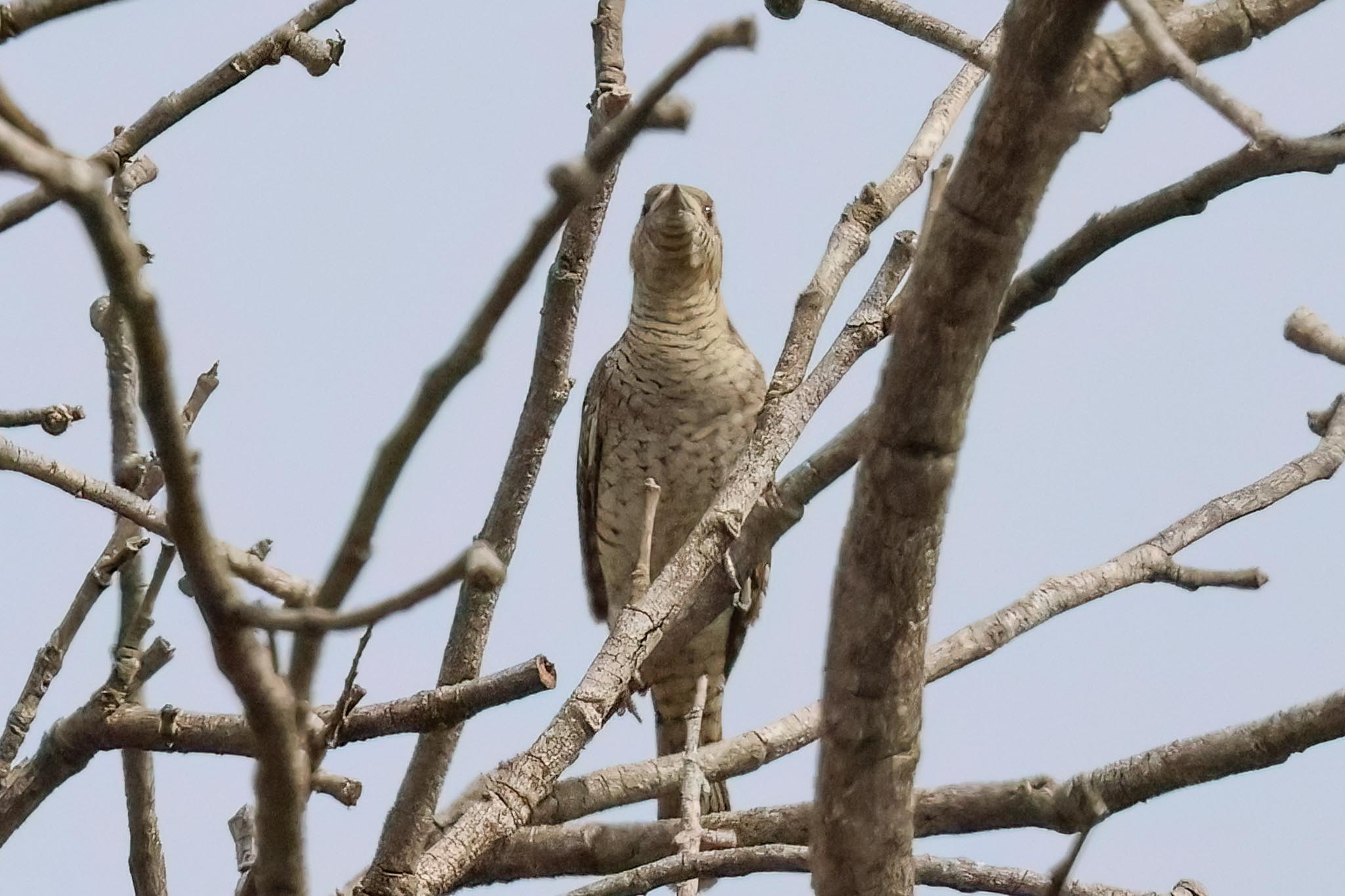
Rather than drive out the way we had come, Modou decided we should cut across through the scrub back to the main track. The bus driver did not look convinced, but expertly negotiated his way along a single track cattle path which wound through the bushes! Back on the main tracks, we stopped to look at a couple of Grey Kestrels which were perched on telegraph posts.
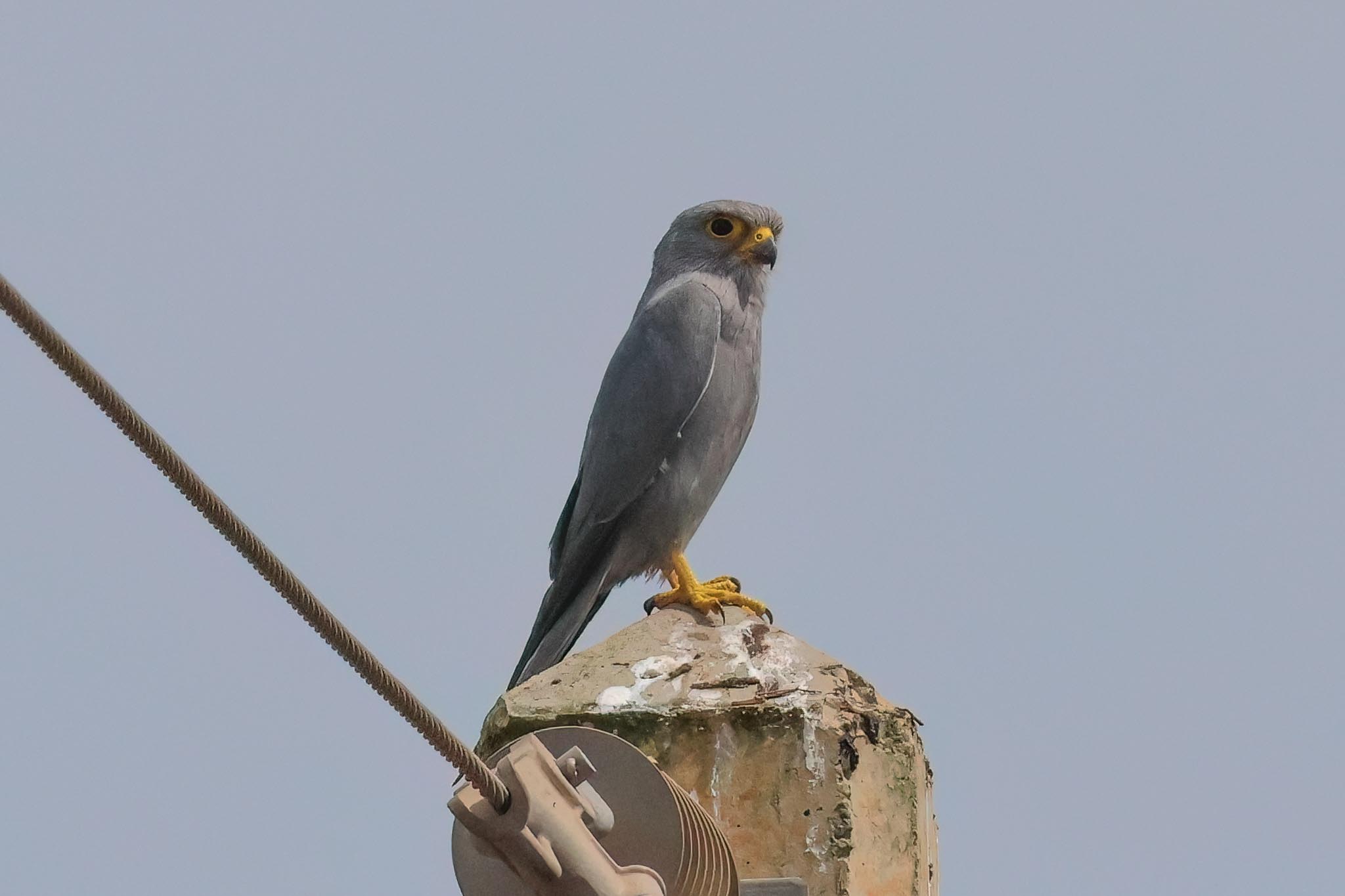
We drove on to a nearby lodge for lunch. As we settled in and waited for the food to be served, another Wahlberg’s Eagle drifted over and a couple of lizards were in the roof here today – a Senegal Mabuya and a more common Agama. Once again, we were treated to an excellent local buffet, of grilled chicken and fish, battered shrimp, rice and a couple of pasta dishes. Afterwards we had a little time to relax and explore grounds. Lots of Village Weavers were in and out of their nests in the trees behind the lodge, with a couple of males singing and displaying.
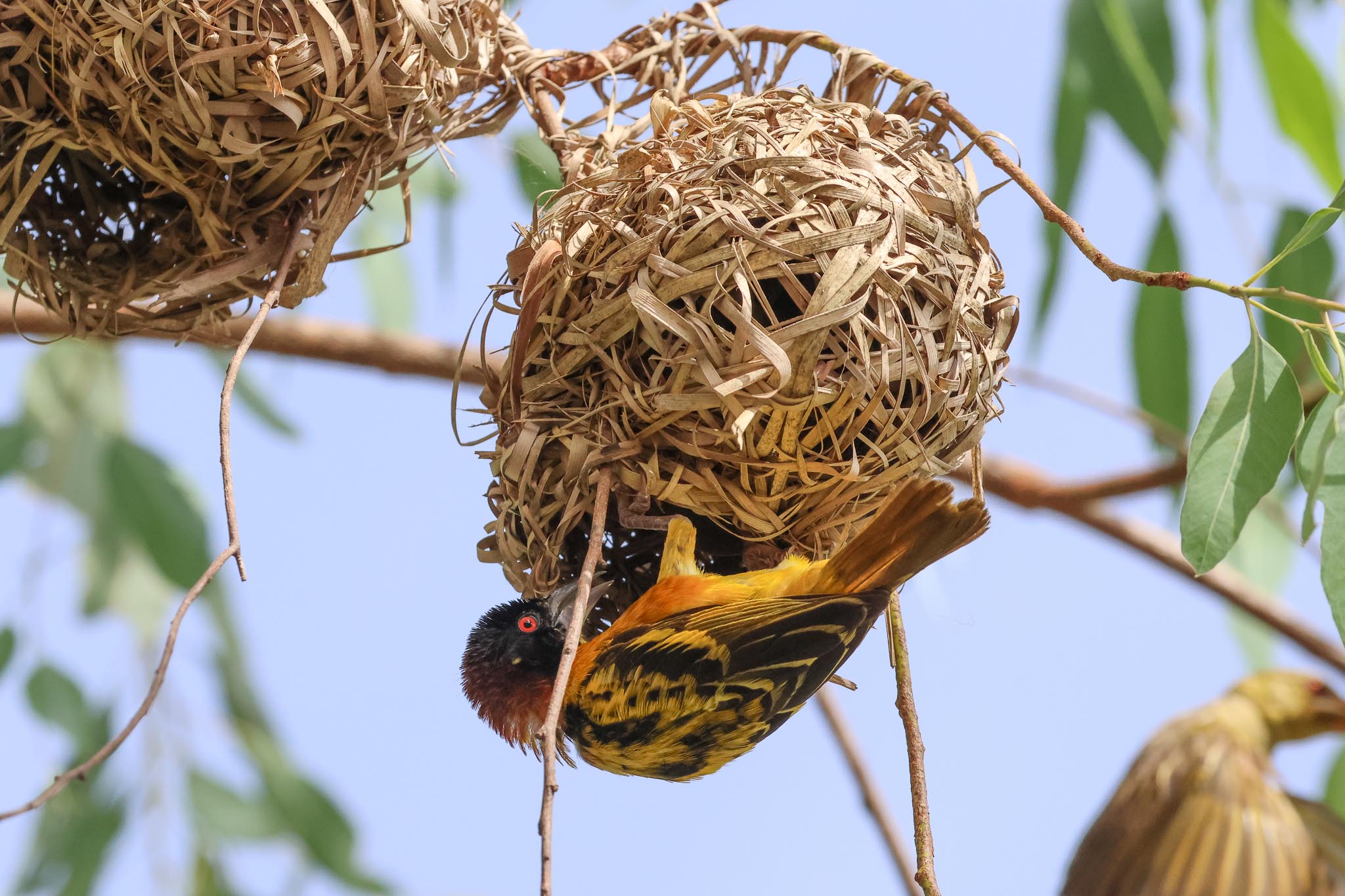
Two White-billed Buffalo-Weavers were feeding around the lawn beyond and a couple of Yellow-billed Shrikes were perched in the window of the lodges at the back. Two Purple Starlings flew over. Looking out over the ricefields beyond, a Marsh Harrier circled up, followed by a juvenile Harrier-hawk, and a Hamerkop flew over.

Afterwards, we had a quick walk down through the ricefields to the edge of the mangroves. A Spur-winged Lapwing and more Wattled Lapwings flew up from the mud and a Senegal Thick-knee dropped in. A couple of Pied Kingfishers zipped back and forth over the water and a Striated Heron flew past. With the tide coming in, Modou went into the mangroves first, round the edge of the water to see what he could find, shouting to alert us to two Brown-necked Parrots which came out and away over our heads.
He came back out to say he had found a Long-crested Eagle in a tree, which was a new bird for the trip, so we all now made our way round the edge of the water between the piles of oyster shells and from the other side of the bushes we could see it distantly in the scopes, over the far side of the rice fields, and see its distinctive long crest. A Black-headed Heron was perched in the top of a tree too. Afterwards, we cut across on another path through the ricefields back to the lodge, where another Brown-necked Parrot flew over and a couple of Senegal Coucals were in the bushes.
On our way back, we made a quick stop at Pirang-Bonto Forest. At the drinking pots by the entrance, a few birds were coming and going – African Pygmy Kingfisher, Little Greenbul, Brown-throated Wattle-eye, African Thrush and a group of Blackcap Babblers. One at a time, we went off to see the resident Northern White-faced Owl which was roosting in some trees not far away.
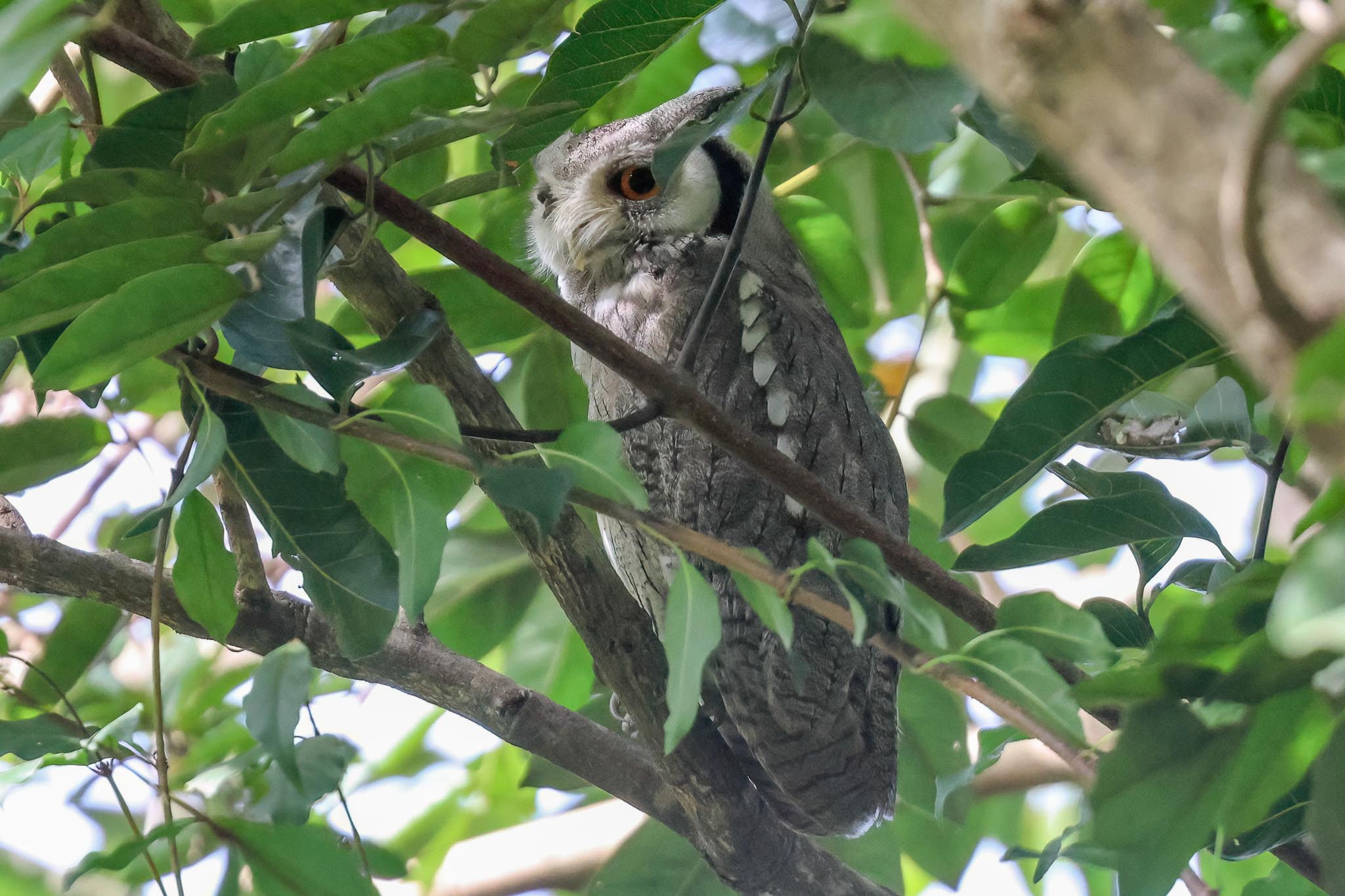
We were then taken in through the forest by one of the local guides. An African Green Pigeon was feeding high in the canopy over the main track and as we cut in along a smaller path, we stopped to look at a Spotted Honeyguide – good to catch up with one here, having missed it yesterday afternoon. We could hear a troupe of Guinea Baboons calling deeper in the trees.
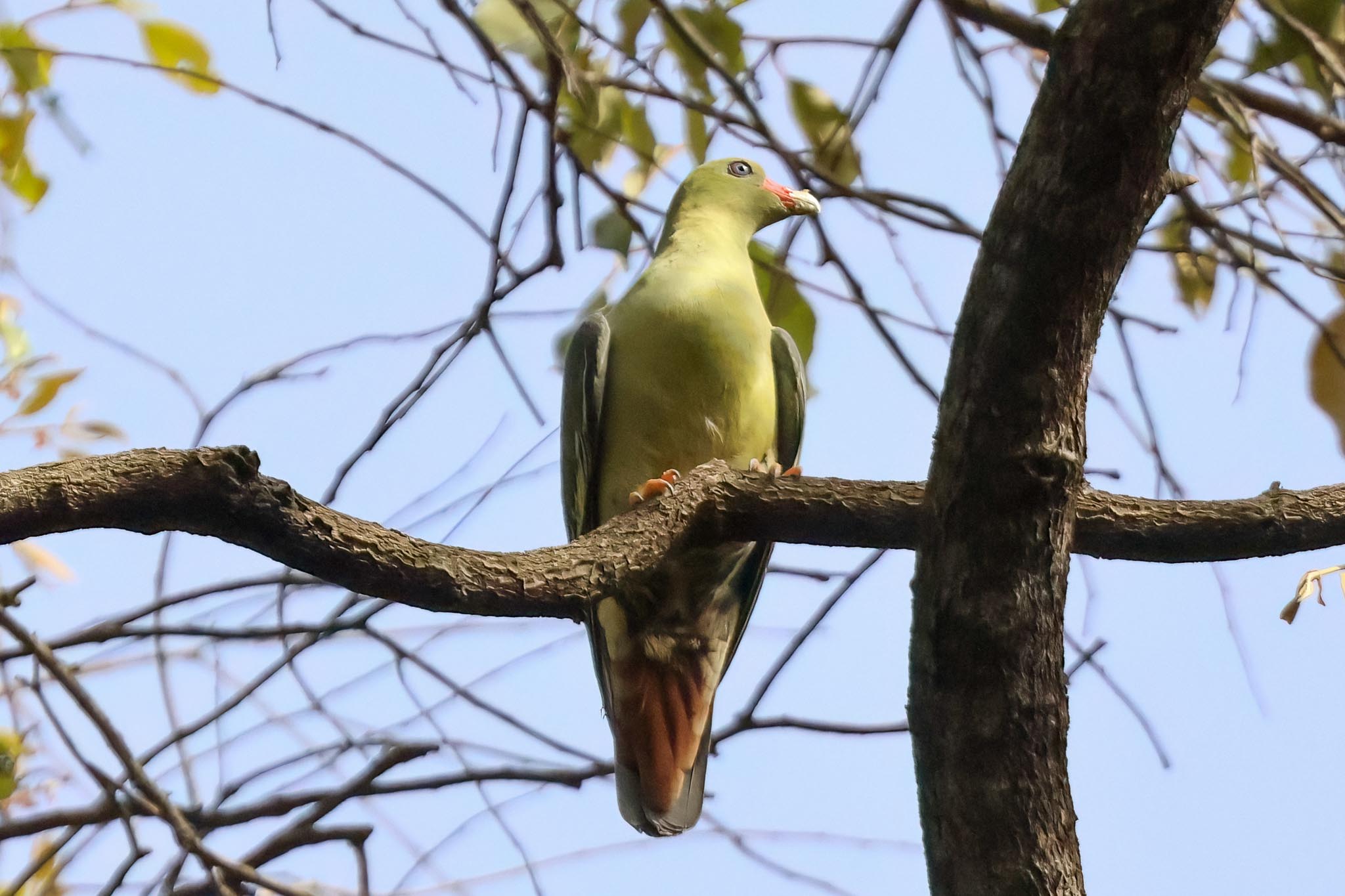
In the middle of the forest we stopped again and looked up to see the pink eyelids of two Verreaux’s Eagle Owls in a tree high above, looking back down at us. We got one in the scope for a closer look. An amazingly productive last stop to finish the day, less than an hour, and making it another two owl day! Back to the bus, it was a long drive back to the hotel but only took about an hour, giving us still time to freshen up before dinner.
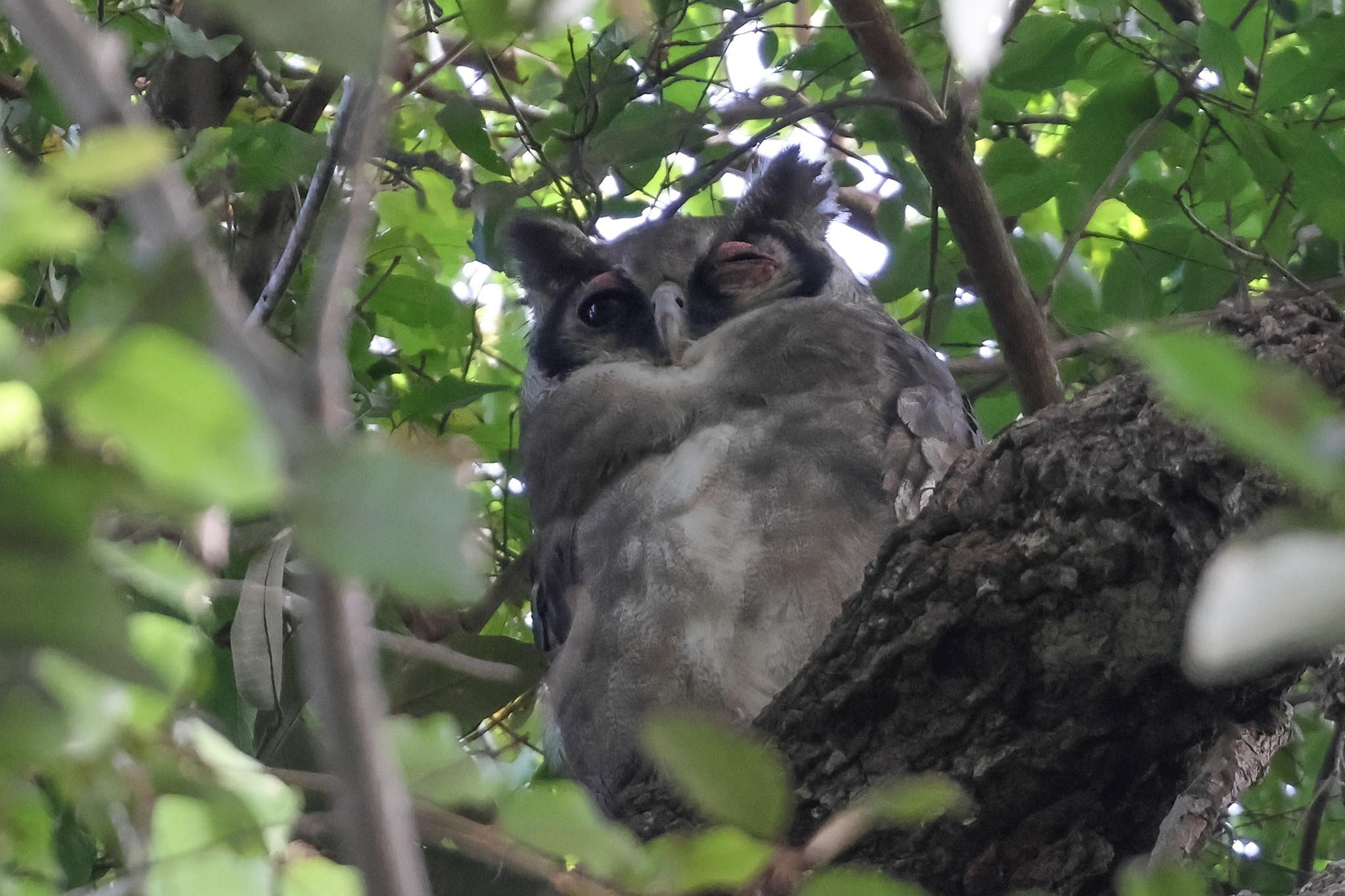
WEDNESDAY 22ND NOVEMBER – Sunny, patchy high cloud, fresh breeze, 35C
We did manage to get away at 7.20am this morning, and drove back down to Pirang, this time heading first for the shrimp farm. There were more Oxpeckers on the cattle as we drove out beyond the village and lots of swallows hawking overhead as we got out of the bus, including several West African Swallows, Red-breasted Swallows and House Martins.
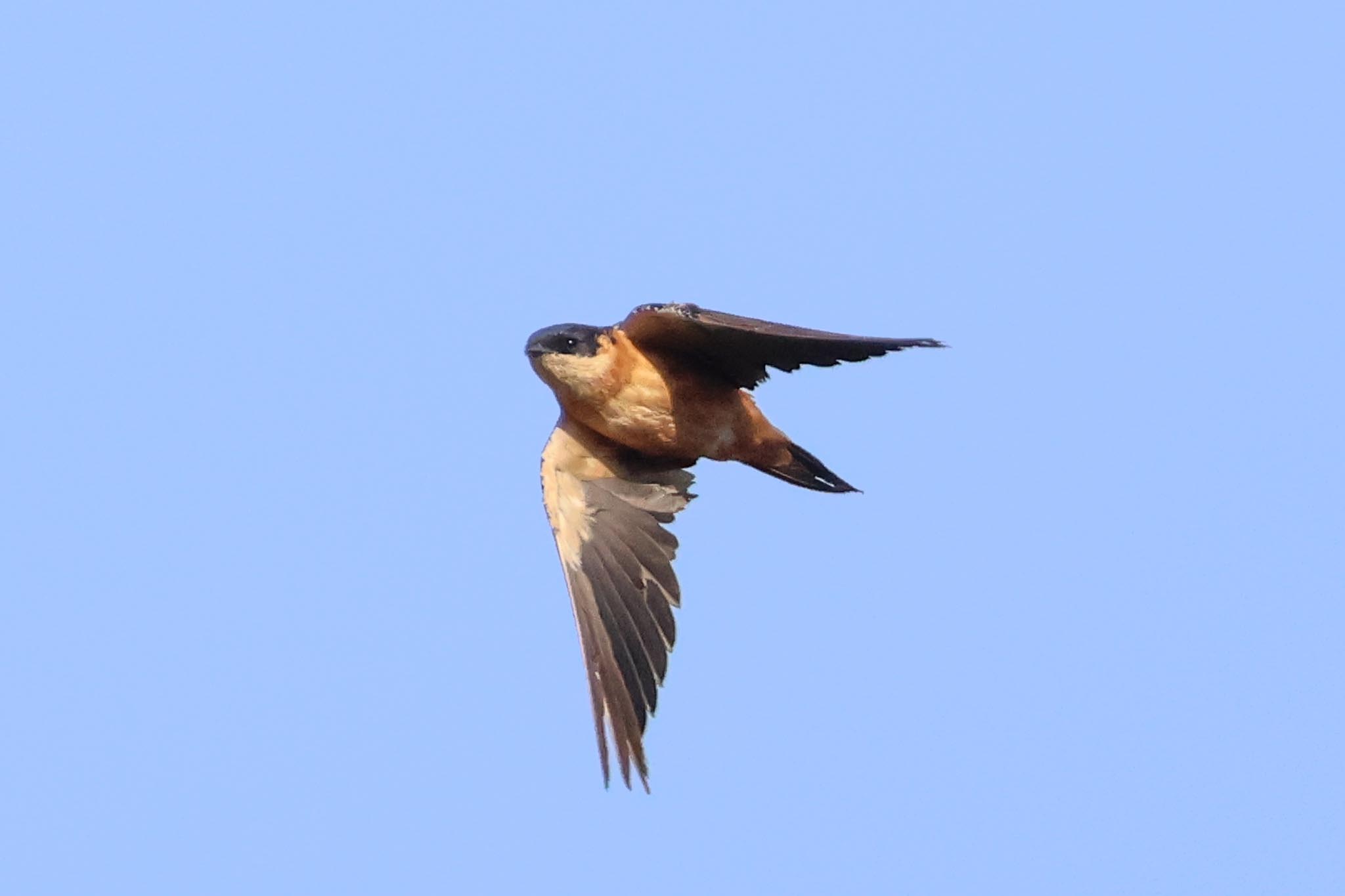
As we started to walk down between the pools, a few Black-headed Weavers were perched in the bushes and a Namaqua Dove landed briefly on the track. When a small dark heron flew away behind the bushes ahead of us we assumed at first it would just be another Striated, but from a little further up we could see it had landed in the top of a bush and it was actually a juvenile Dwarf Bittern. It remained perched in full view so we could get a really good look at it in the scopes.
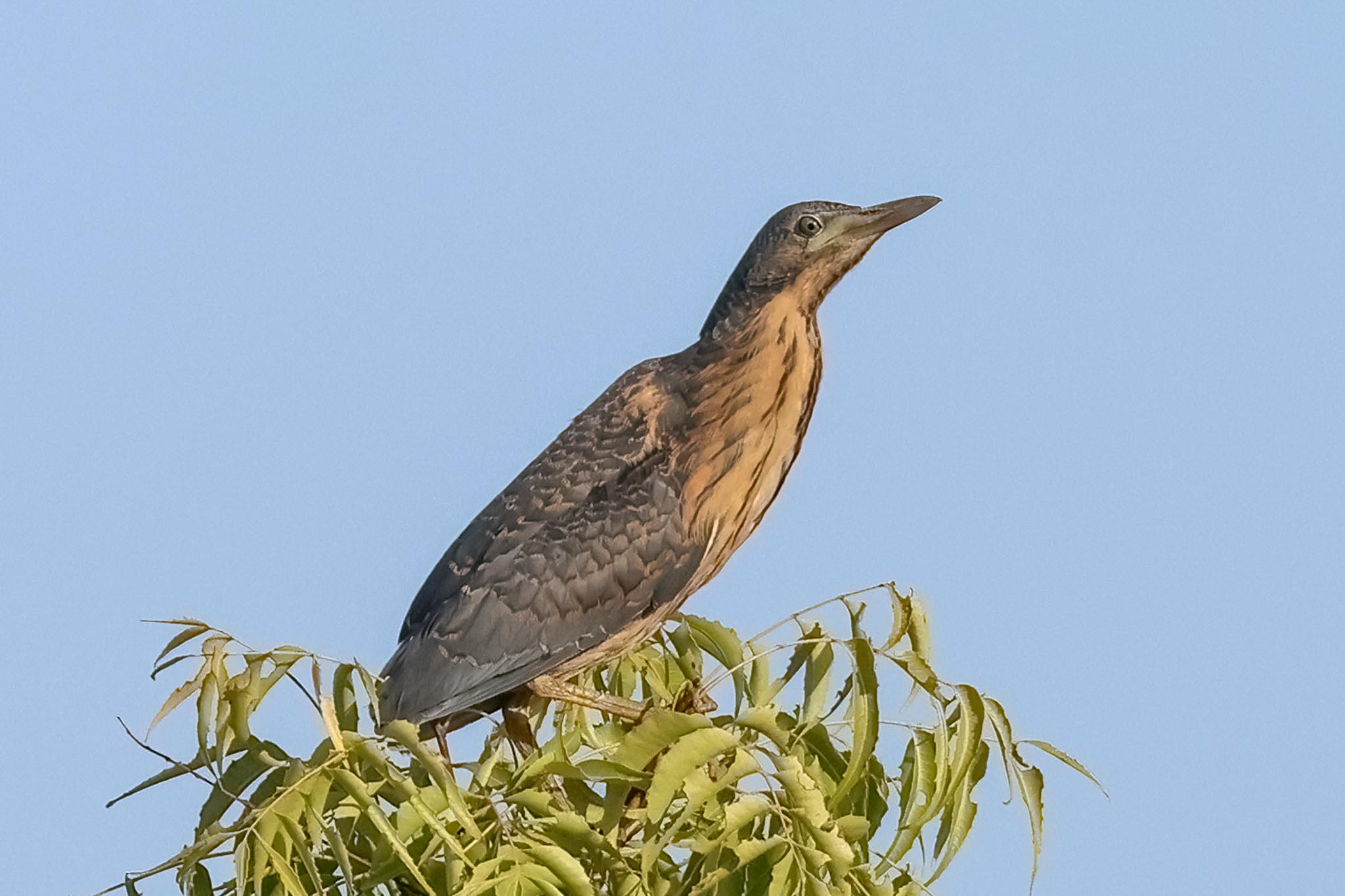
Working our way round on the bunds, the first couple of pools were dry but the next still had some shallow water and we found our first waders of the day, a couple of Greenshanks, two Wood Sandpipers and two Common Sandpipers. Several Little Terns were feeding further up and a few Gull-billed Terns flew in and overhead past us.
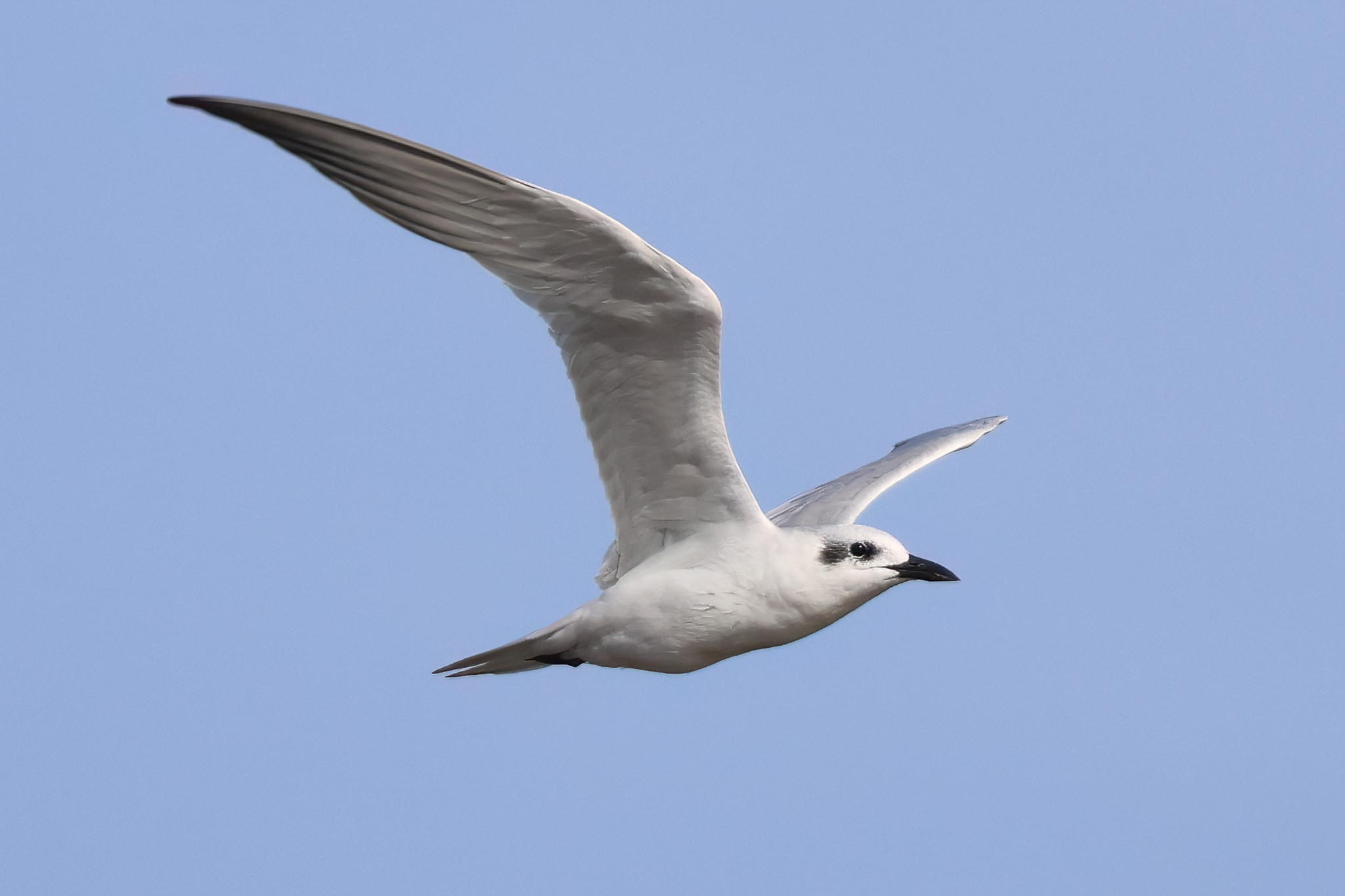
We heard Yellow Wagtails flying round calling and when they landed we could see one was a male Blue-headed Wagtail. A distant Long-crested Eagle in the trees beyond the village was getting mobbed by a Pied Crow. A Woodchat Shrike was perched in a bush across the far side of the pool. When we reached the next bund we found it was covered in roosting Senegal Thick-knees which ran away as we came into view. Two Lanners flew across and landed on another bank further back where we got them in the scopes, and we could see more distant Marsh Harrier, Osprey and Palm-nut Vulture too.
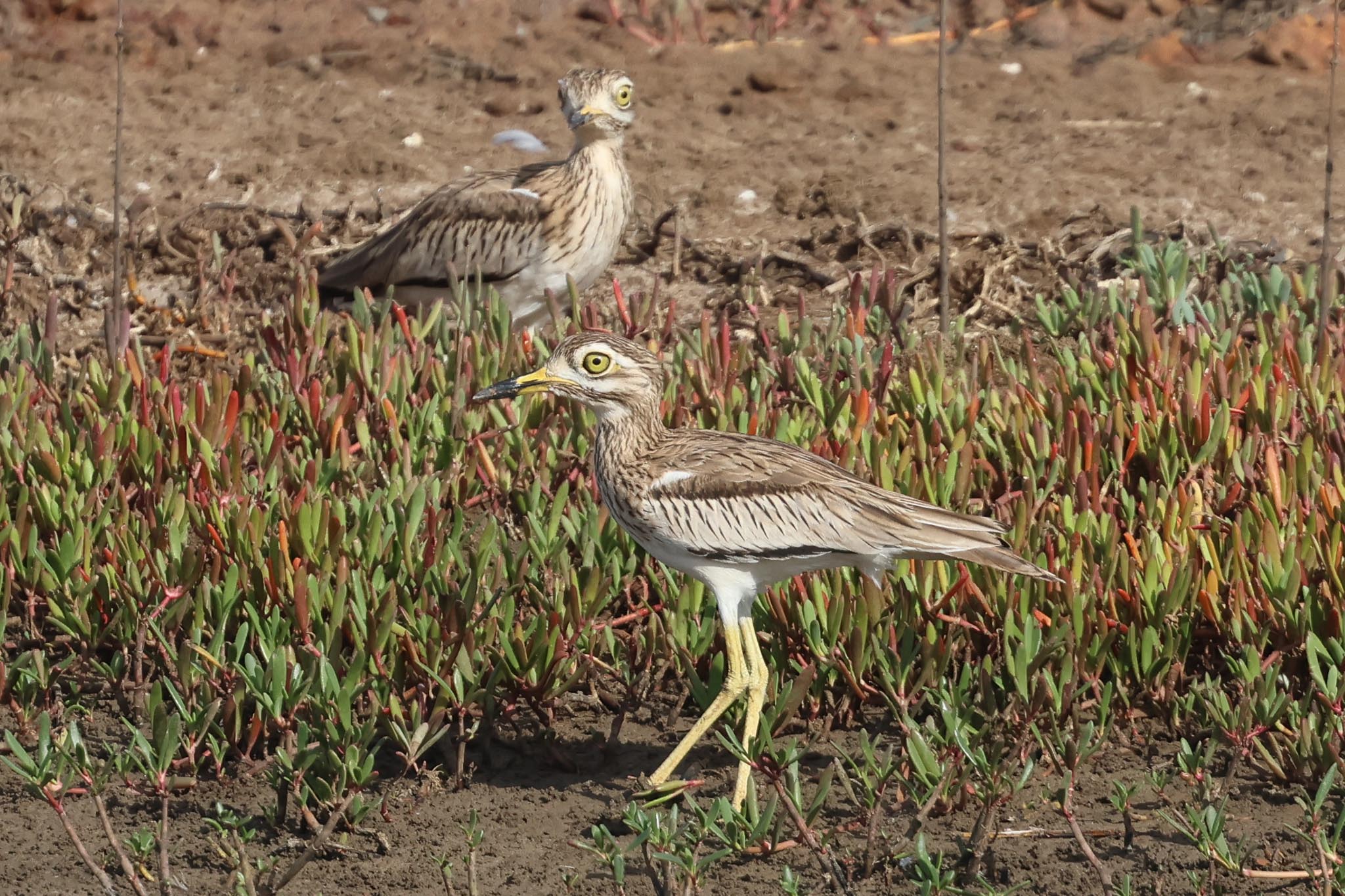
Turning along the top of the bank, we found a pair of Crested Larks just across the channel and more Yellow Wagtails, this time including a male flavissima in with them. A Western Subalpine Warbler in the bushes below the bund flew ahead of us calling. At the next junction we scanned the pools ahead and found a single Kentish Plover and a Hamerkop was perched on a nearby sluice.
Crossing over the channel at the next bridge, we walked on down the other bank. There were more pools with water in them here and more birds – at the first, we found a few more waders feeding in between the Greater Flamingos, including a Marsh Sandpiper with a Curlew Sandpiper and a Dunlin together in the same view. A flock of Sanderling was on the shore at the back and a Common Redshank was over in the far corner. At the next pool, there were even more Flamingos and even more waders, including a group of at least 25 Marsh Sandpipers, an impressive number for here, and our first Pied Avocets. A small group up along the edge, included a single (Red) Knot with several (Ruddy) Turnstone and another Wood Sandpiper. A larger flock of small waders in the middle was made up of more Curlew Sandpipers and several Little Stints, along with a few Ringed Plovers.
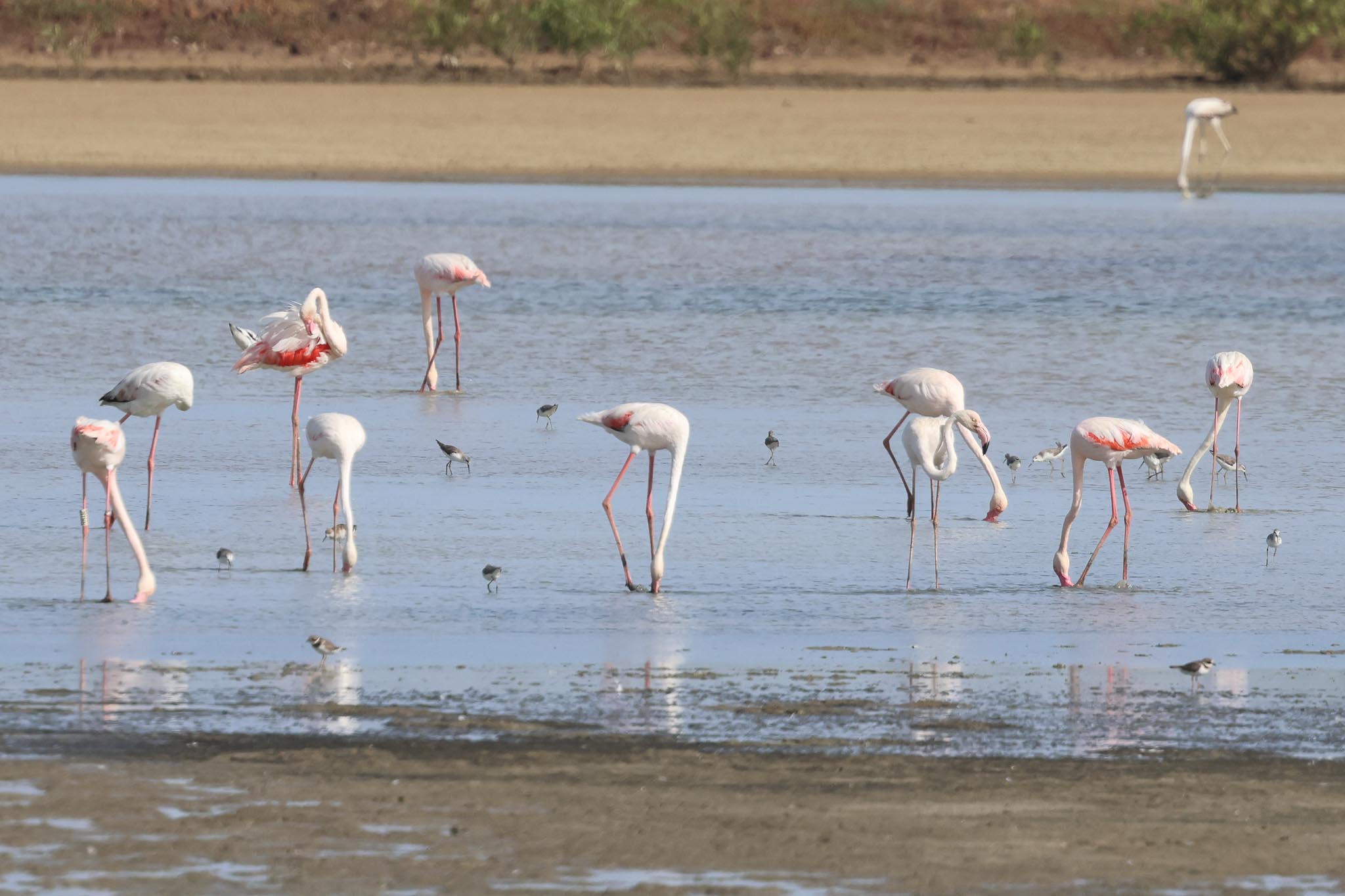
The next pool was dry, but we noticed a small plover on the top of the bund on the far side. It ran down onto the bare sand below and settled onto a nest – a female White-fronted Plover. A second bird on the bund ran down the other side, and from further up we could see it was a male in non-breeding plumage, with rufous in its breast side patches.
The channel widens here and there were two Pink-backed Pelicans on the island in the middle with a small group of herons which included Western Reef and two Black Herons, and several Little Egrets. The pools at the far side of the site have more water in and three African Spoonbills dropped in now beyond the bank but flew up again as we got to the corner. Three White-throated Bee-eaters flew over the water away from us and one perched briefly in the distance, where we managed to get it in the scope.
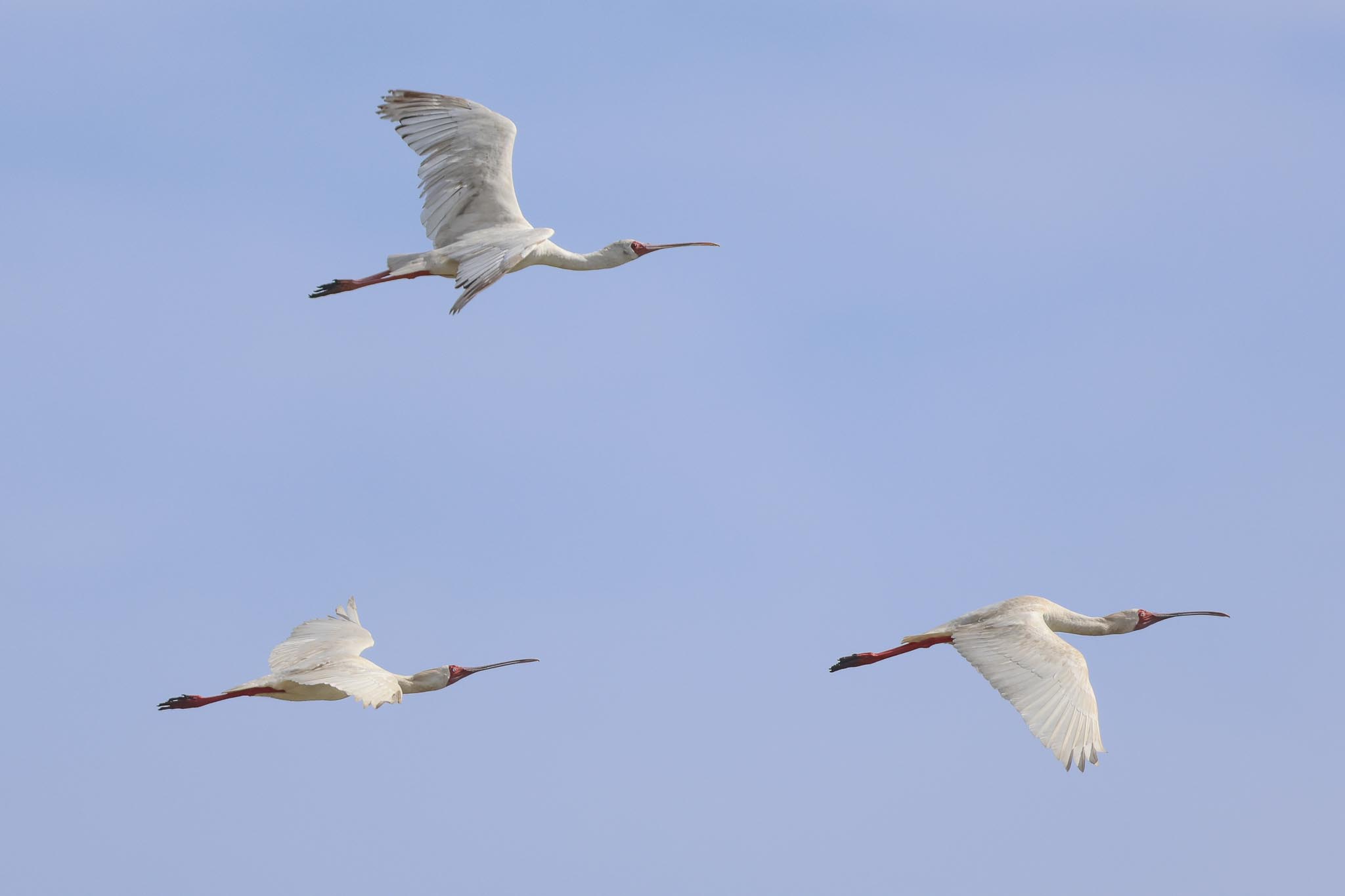
The next pool was chock full of roosting gulls and terns, with more Spoonbills, both African and European, and a few Pink-backed Pelicans. Looking through the terns, we found a mixture of Caspian, West African Crested, a few Gull-billed and at least one Sandwich Tern with them. The gulls were mostly Grey-headed Gulls, but with a single Black-headed Gull in amongst them, and a group of Slender-billed Gulls further back, including some still with pinkish underparts.
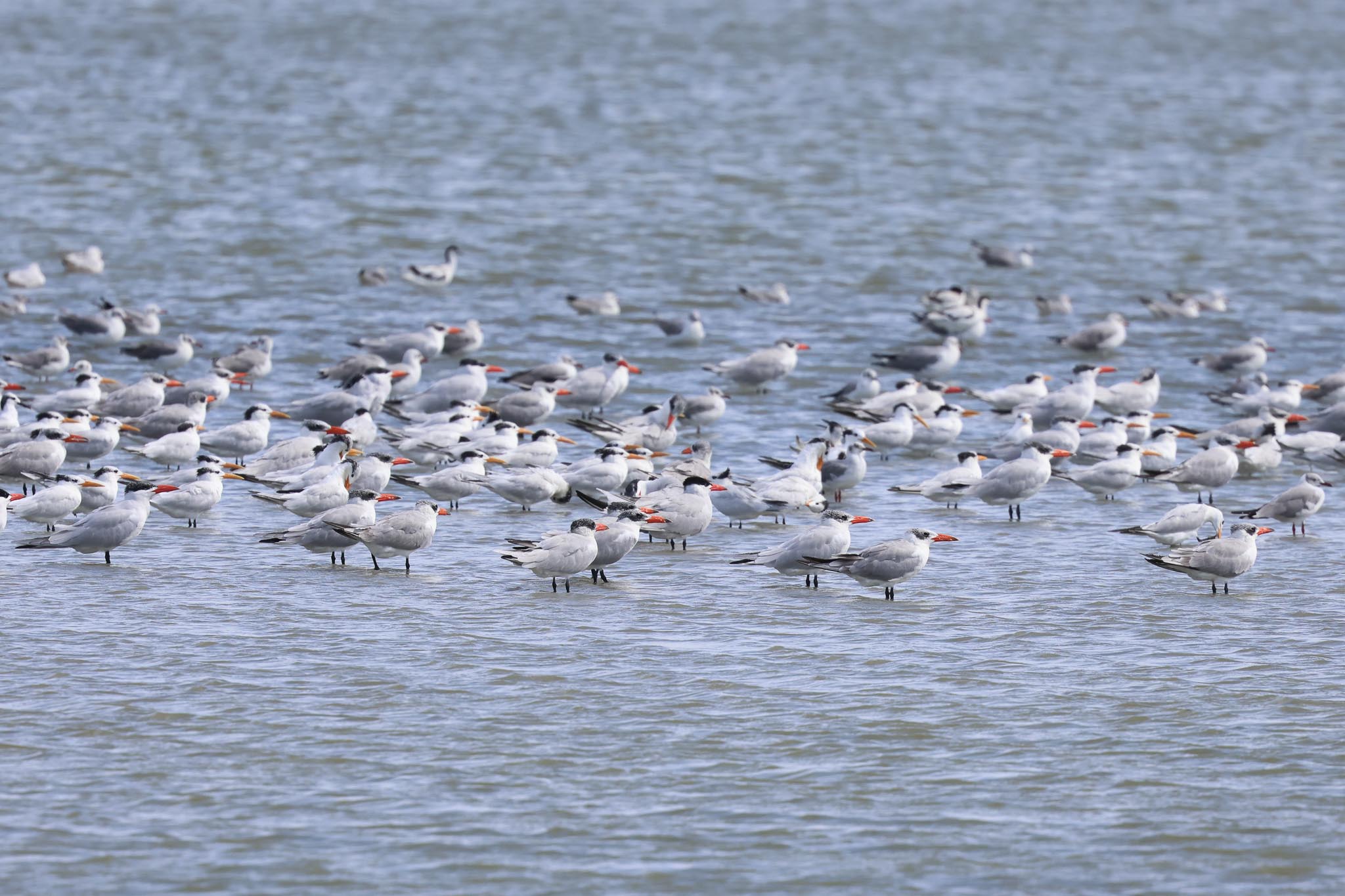
As we started to walk up the bund alongside the pool, a Collared Pratincole flew over and then another Woodchat Shrike flew off along the bank ahead of us. Two Little Ringed Plovers flew up and circled round calling, dropping down again over the next bund out of sight.
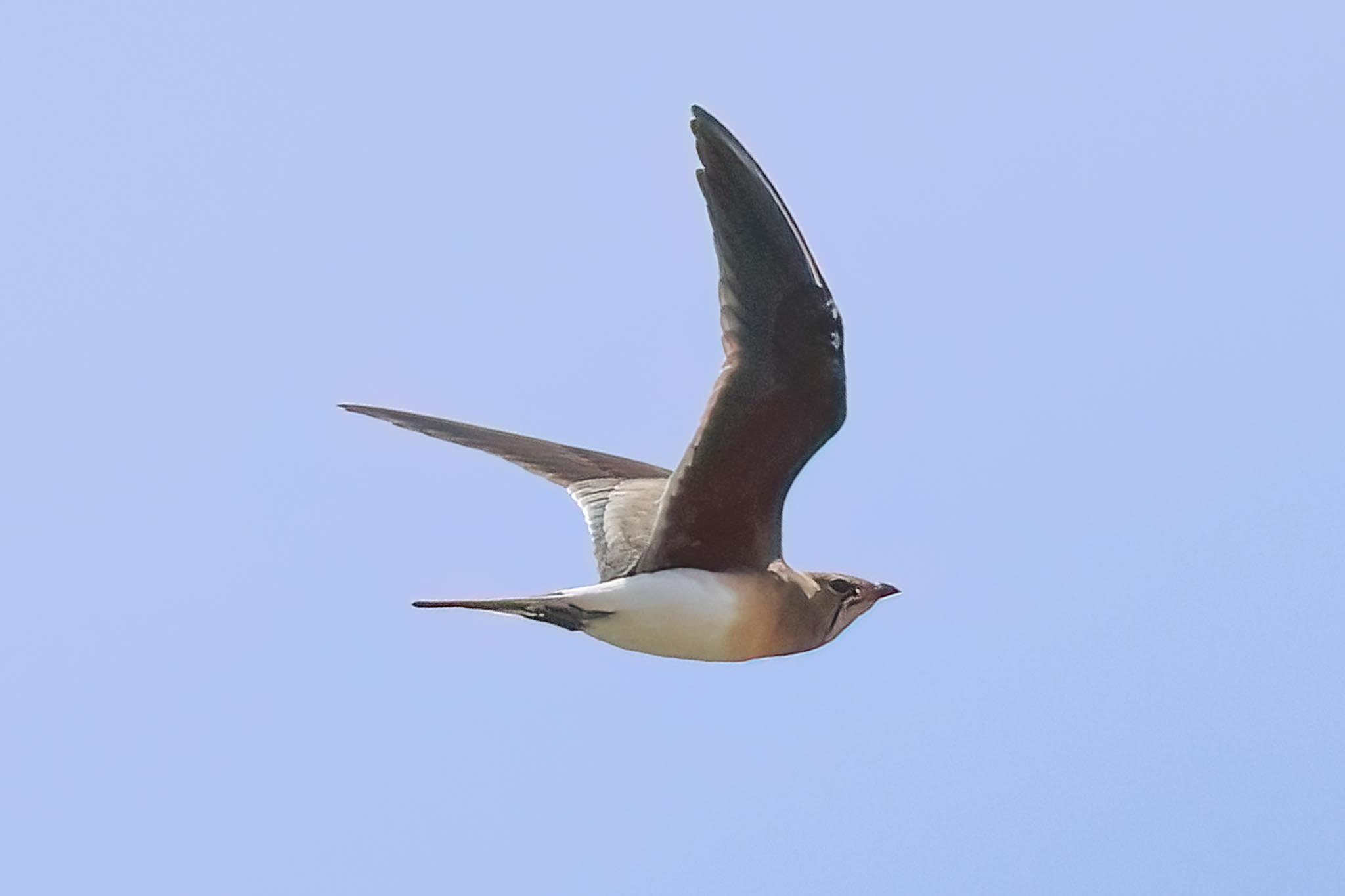
Continuing on past the next pool where there were more terns roosting, we got to another which was full of small waders. Scanning through, they were mostly Ringed Plovers, but we found at least three Kittlitz’s Plovers in with them and, further up, two more Kentish Plovers too.
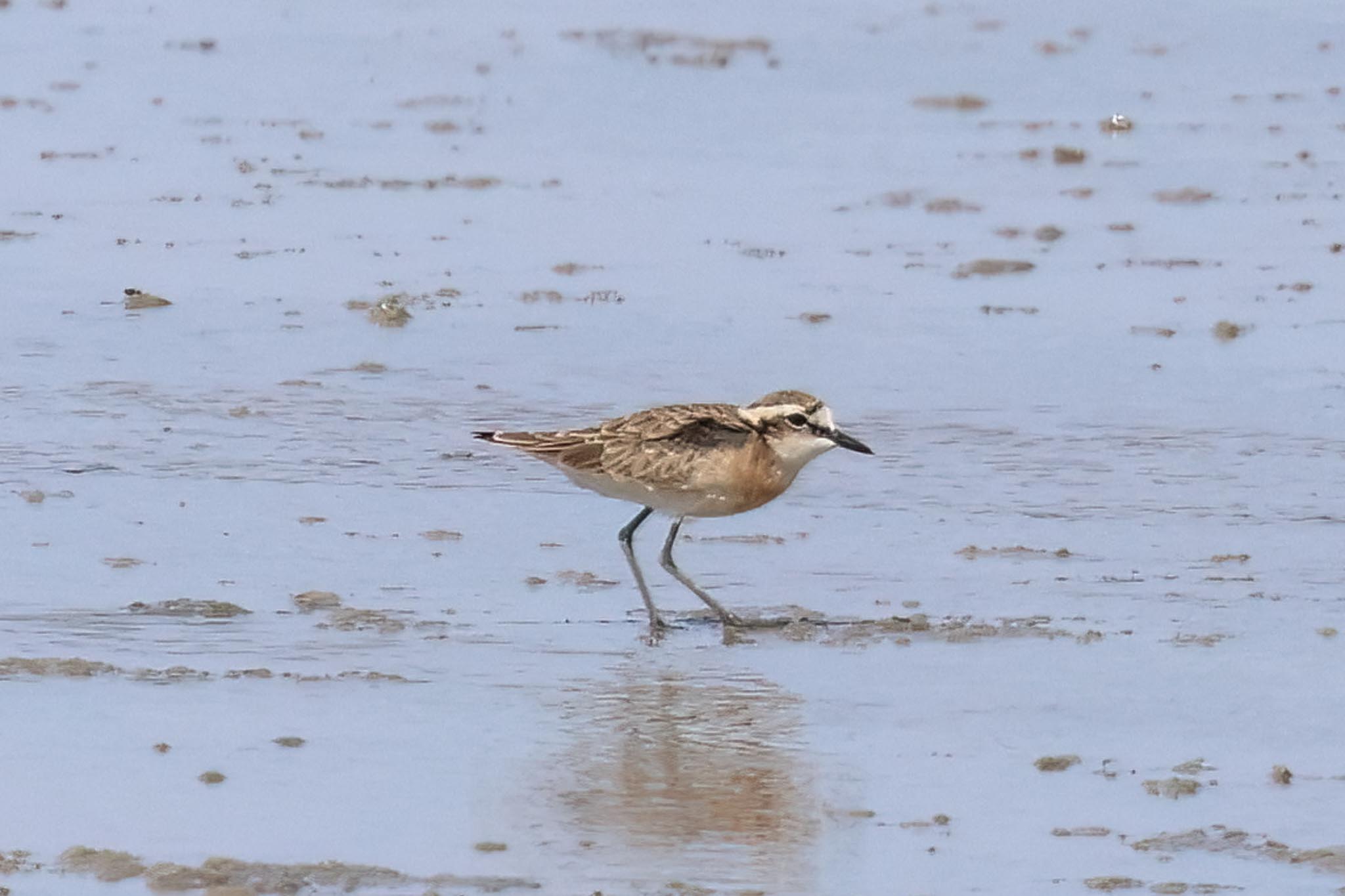
It was getting hot now and there is no shade out here, so we were thankful the bus was waiting for us at the next junction. We drove back out through the village, past more waving children, and stopped at a stall by the roadside for Modou to buy some watermelons. An Abyssinian Roller on the wires here posed nicely for photos from the bus windows.
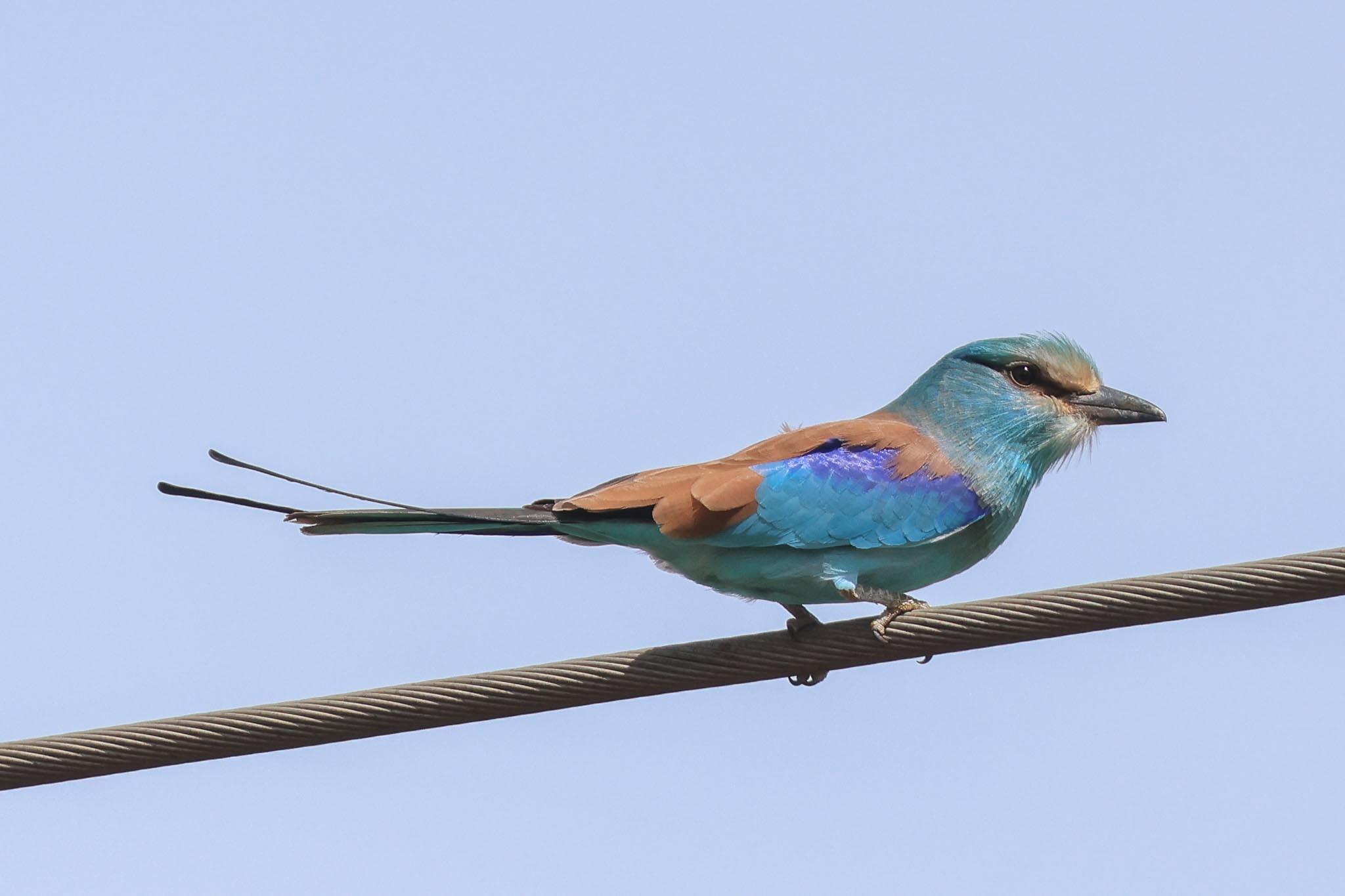
We called in again at Bonto Forest now, and Modou and the forest guides chopped up the watermelon for us to eat while looking at the drinking pots. The watermelon was delicious, so juicy and sweet, unlike anything we ever get at home which masquerades as the same fruit. A Little Greenbul, African Thrush, Orange-cheeked Waxbill, and two moulting male Northern Red Bishops plus several females and juveniles came in to drink.
After we had finished our watermelon break, we made our way into the forest again. It was fortunate that we had seen the Verreaux’s Eagle Owls yesterday, because they had moved on today, possibly disturbed by the troupe of Baboons, and unfortunately the area where we normally look for the Flufftail here is apparently flooded out at the moment, so we went to look for some forest birds instead. First we took the same side track and a Lesser Honeyguide was now in the trees where the Spotted was seen yesterday. As we stopped to look, a Collared Sunbird appeared high above us, under the canopy briefly, followed by a Grey-backed Camaroptera, a pair of Red-bellied Paradise-Flycatchers and a pair of Northern Puffbacks.
Back to the main path, Modou heard Green Crombec calling so we turned in again and tried to find it, but no luck. A Green Hylia was calling now too and was similarly reluctant to come in at first – a Yellow-breasted Apalis kept appearing instead until eventually the Green Hylia gave itself up. We could hear a Grey-headed Bristlebill but it proved elusive too, so Modou led us deeper in to try to find Blue Malkoha (aka Yellowbill). There was no response anywhere along the track where they usually are and it was getting late for lunch now, so we started to walk back. We hadn’t got far when a Blue Malkoha started calling now, so we stopped and saw it fly in and disappear into the trees. We persevered to try to get a better look, but it kept resolutely hiding in tangles high up out of view – we all had fleeting glimpses, and the lucky ones got some ‘composite views’, before we had to call it a day.
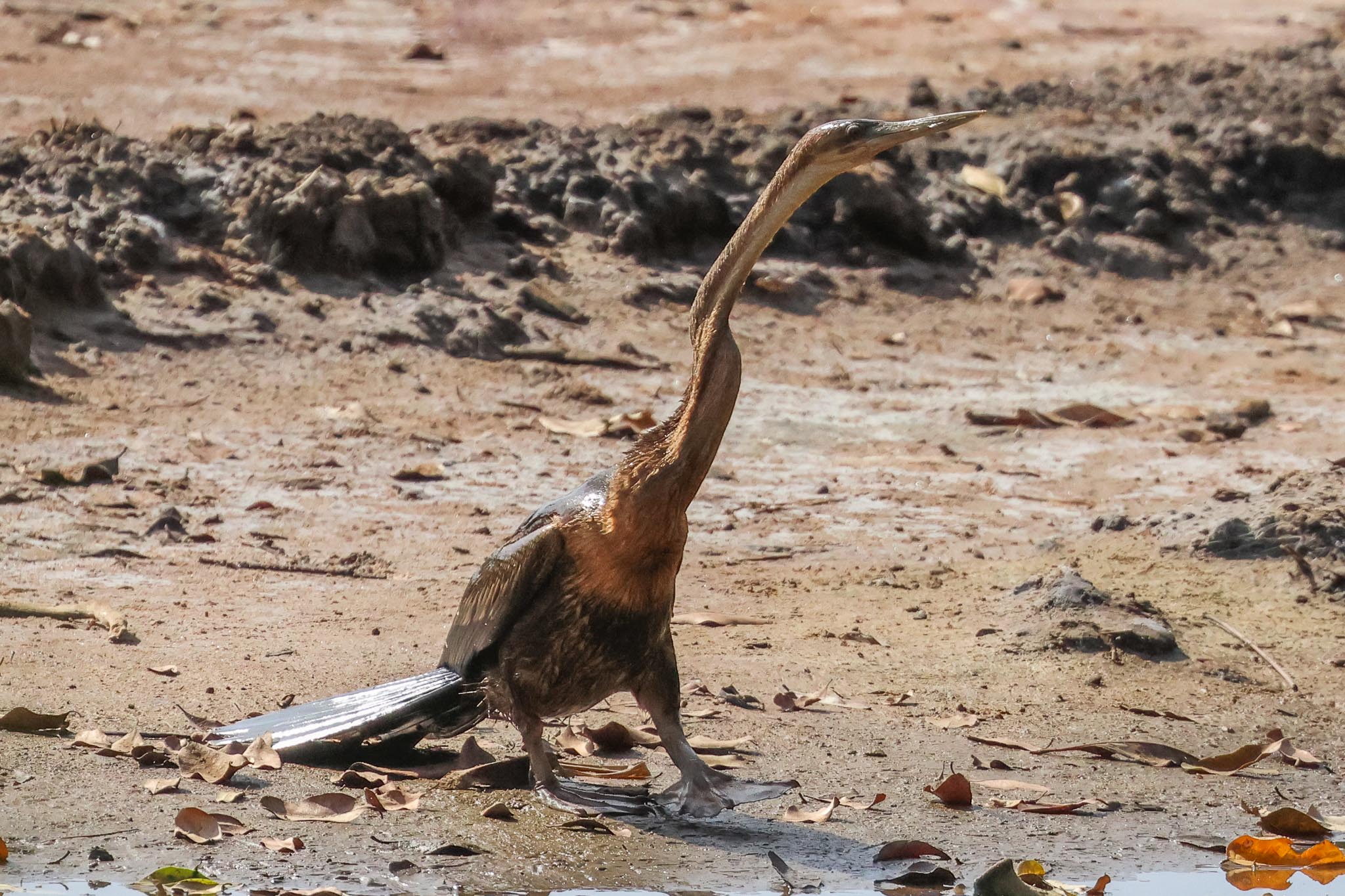
As a consequence, we were much later than planned getting to Marakissa for lunch, but Adama still managed to rustle us up sandwiches, chicken nuggets, chips and salads. An African Darter was standing on the bank of the river behind and a Giant Kingfisher landed in a tree right by the lodge.
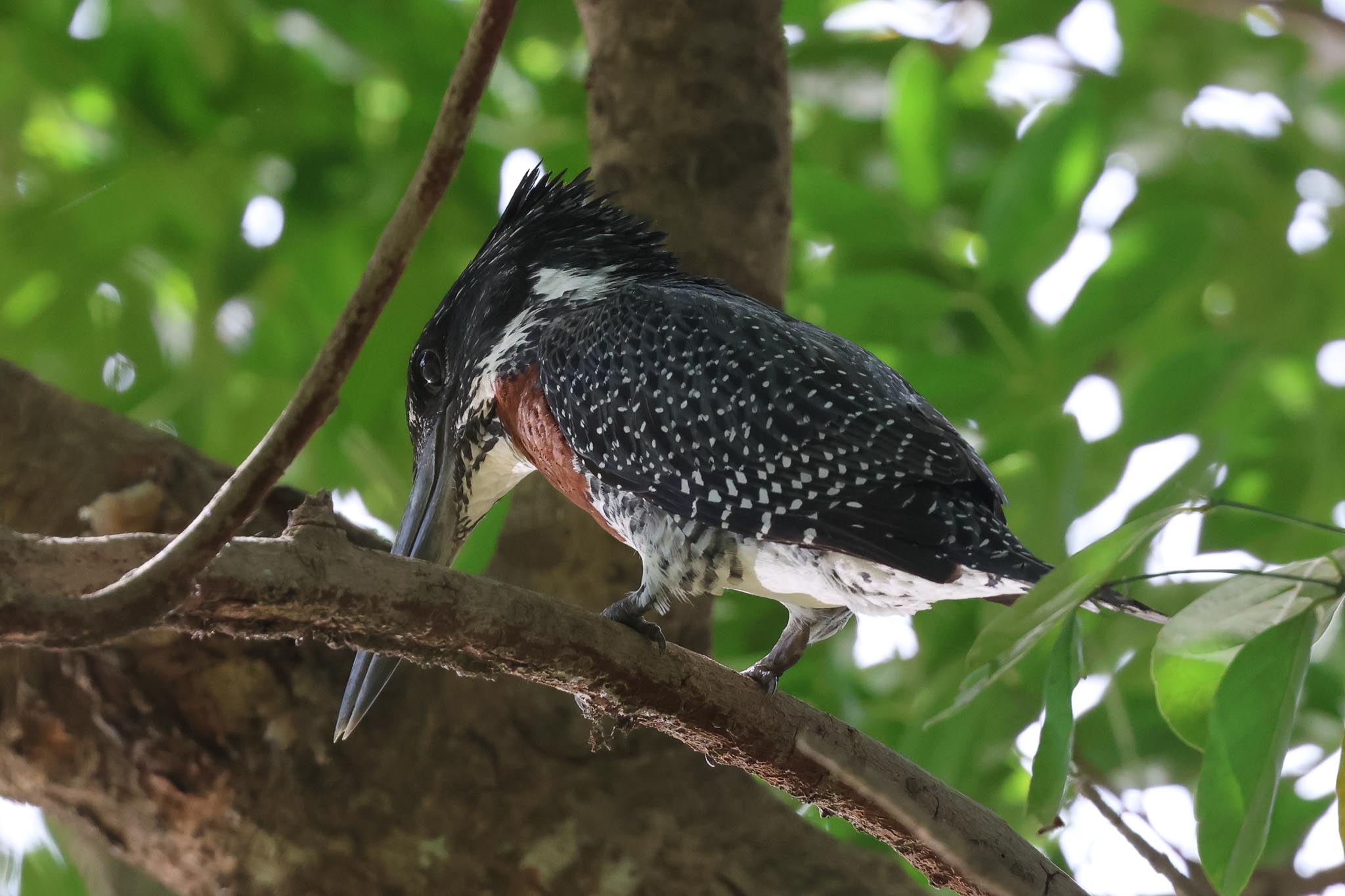
After lunch, Adama called a couple of the local West African Crocodiles in to be fed – ‘Croccy’ promptly came right out onto the bank by the jetty!
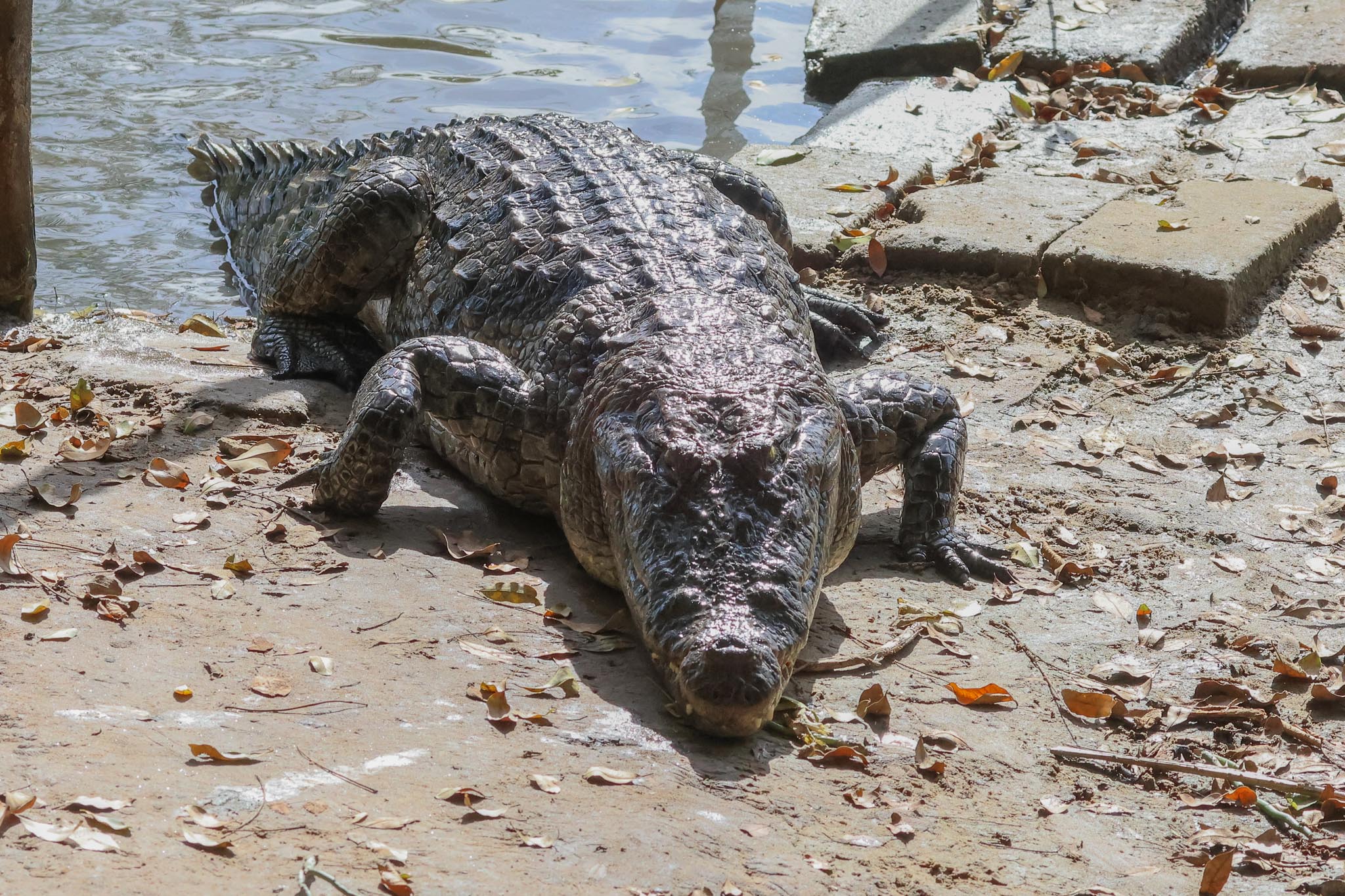
After the entertainment, we took a short walk now down along the road outside to a nearby bridge. Another group had stopped and got out of their bus there, and there was too much disturbance – we could hear Black Crake calling from deep in the reeds, but we couldn’t them. A Nile Monitor came down to the edge of the water for a drink. Modou led us to a path further up and then we cut down through the fields to the edge of one of the pools further over, where it was quieter. A pair of Blue-bellied Rollers perched in the trees above and lots of dragonflies and butterflies came up from the vegetation around us.
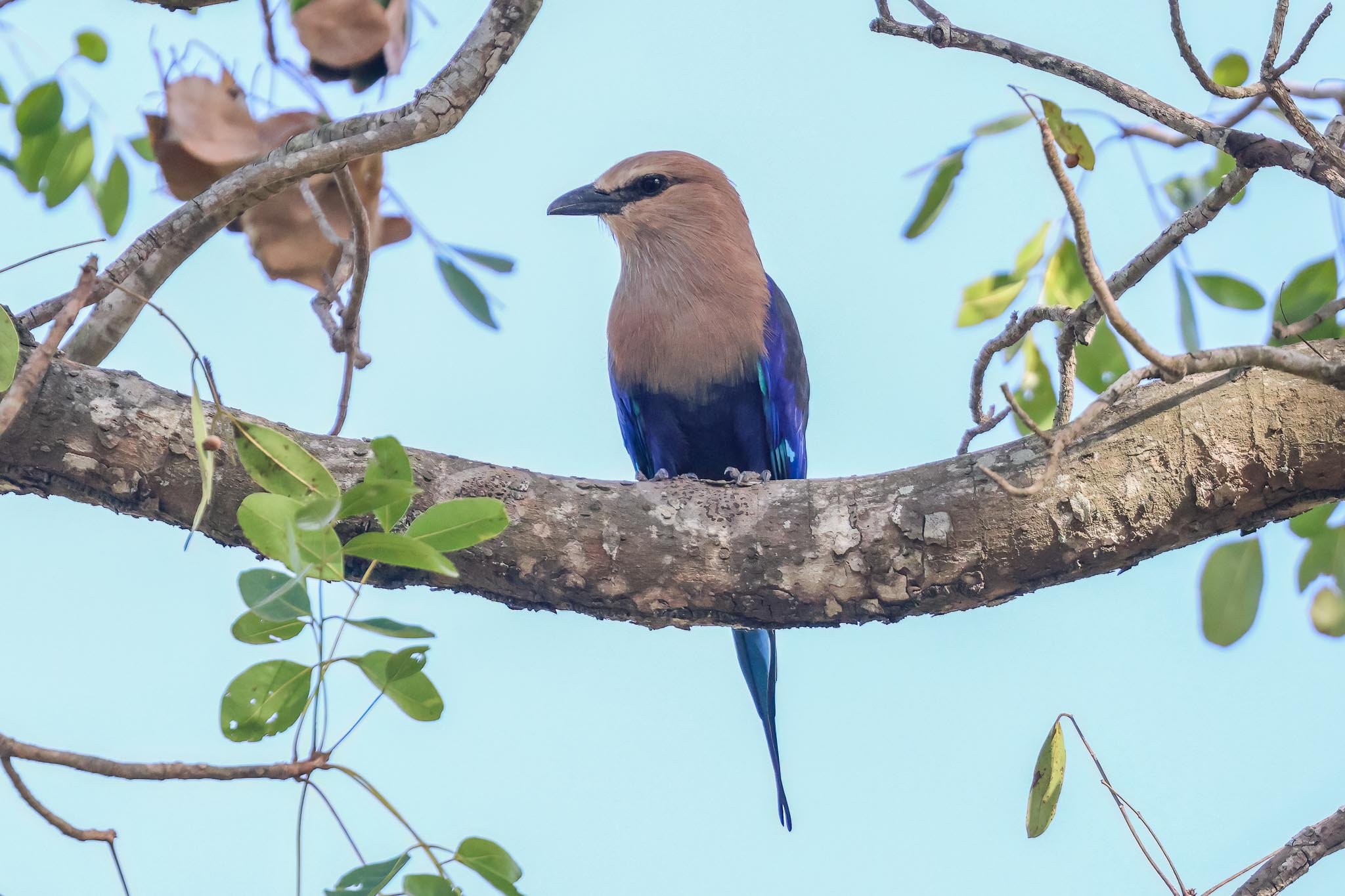
From the edge of the trees, we could look over the pools, where there were lots of lapwings, a Greenshank, a couple of Common Sandpipers, a couple of young African Jacanas. Several Pied Kingfishers flew back and forth and a Giant Kingfisher perched nicely in a bush in the middle. Modou found a male Greater Painted-Snipe skulking in the grass on the far side and although it was rather elusive it eventually came out so everyone could see it in the scope.
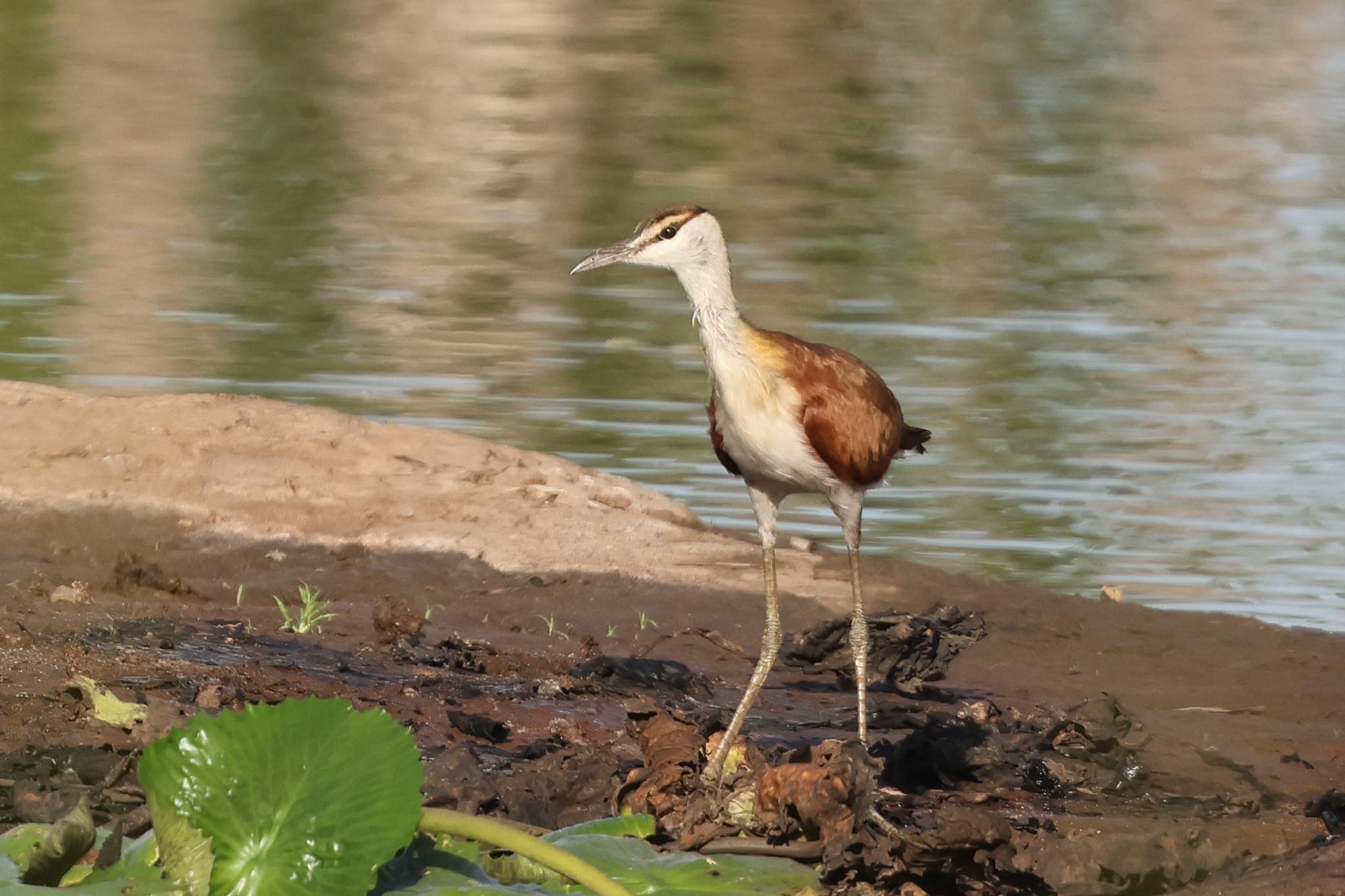
A Long-crested Eagle landed in the trees beyond the pool briefly, and a Lizard Buzzard was calling and we eventually found it perched in a tree too. Then it was unfortunately time to drag ourselves away for the drive back to our hotel for dinner.
THURSDAY 23RD NOVEMBER – Sunny, patchy high cloud, fresh breeze, 34C
With a long drive down right to the Senegal border at Kartong, we had an extra early start this morning, meeting at 6am at the bus. There was little traffic as a consequence and the drive only took about an hour, with the sun rising on our way. As we pulled up on the track by the village, large flocks of White-faced Whistling Ducks circled round calling and a succession of herons, egrets and Hamerkops flew past.
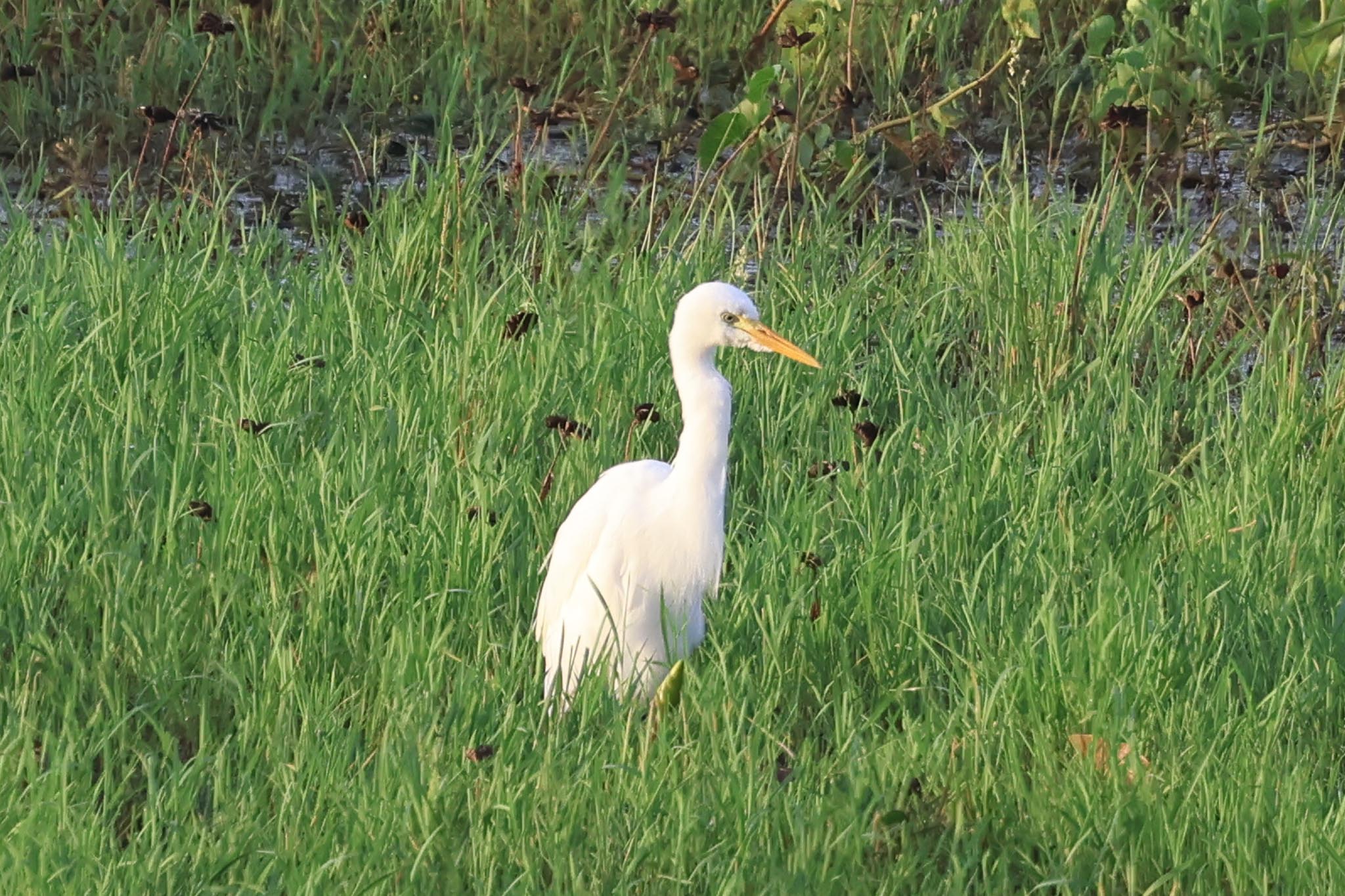
We walked round to Kartong Bird Observatory where we met Colin and Binta. While the kettle boiled, we had some time to scan the pools in front from the terrace – an Intermediate Egret was feeding down in the water, two Allen’s Gallinules skulked in and out of the vegetation, a brief African Swamphen appeared along with a couple of Moorhens, and five African Jacanas flew up and back away over the reeds. A Great Reed Warbler was singing and several Yellow-crowned Bishops were perched in the reeds (although unfortunately not a bright breeding male). Our first Ospreys of the day circled up beyond – they would be pretty much constantly in view this morning, and checking through photos later, we realised one was colour-ringed. It had been ringed last year in Finland!
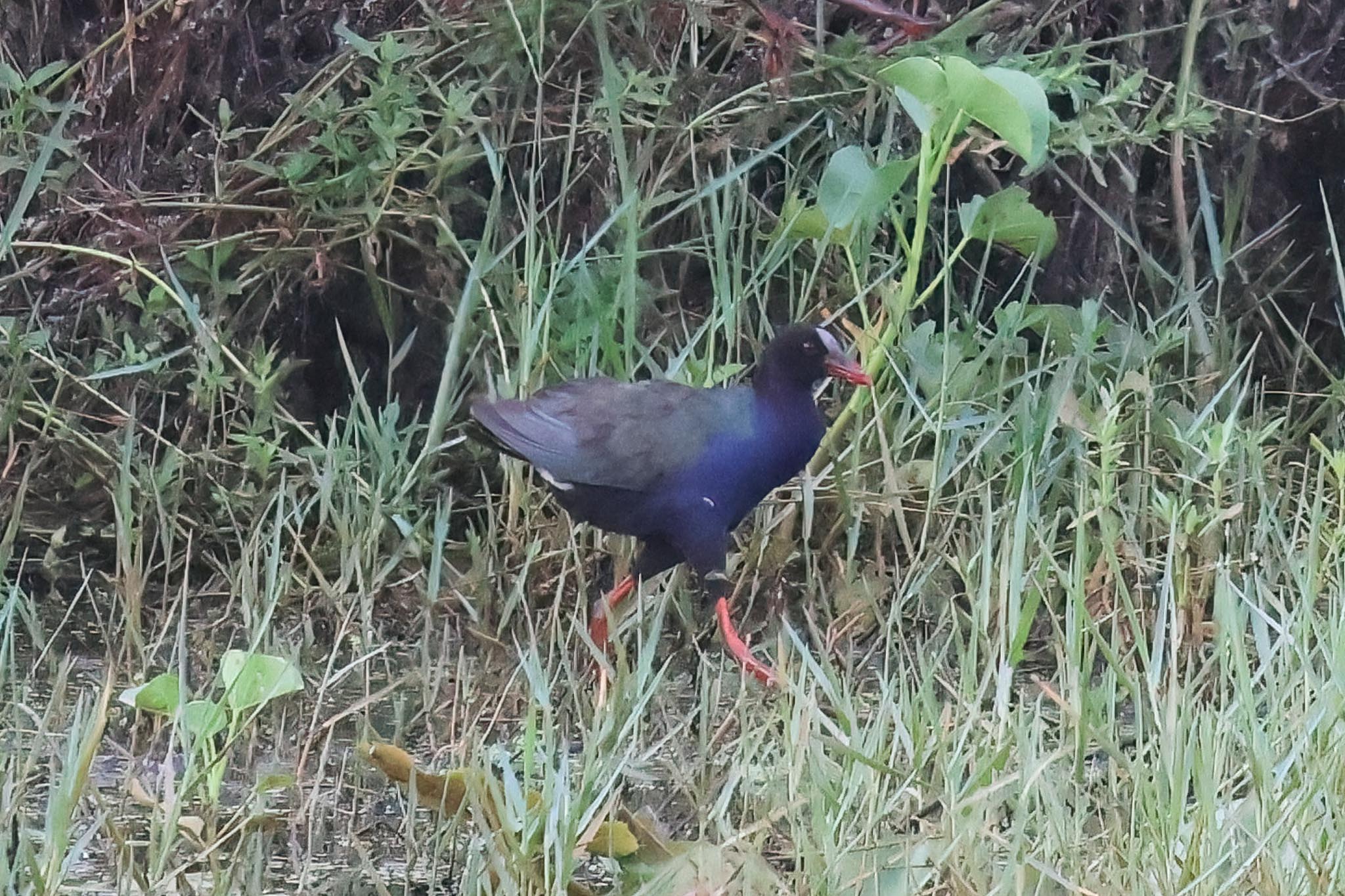
Colin then showed us the bats roosting in the ‘bat cave’. While we ate the packed lunches we had brought with us from the hotel (not the most appetising breakfast of the week!), Colin talked to us about the work of Kartong BO and some of the challenges facing the local community, not least the almost complete exodus of young men from many villages.
After breakfast, we made our way back out to the track and walked on further. Another Swamphen flew up out of the reeds but quickly dropped back in again, a Black-crowned Night Heron flew past, several Squacco Herons too and a Purple Heron landed on a bush where we could get the scope on it. A Sedge Warbler and another Yellow-crowned Bishop appeared on the edge of the reeds. We stopped periodically to scan the pools – there were lots of flocks of White-faced Whistling Ducks, and in with them we found a pair of Shoveler, two Spur-winged Geese (an adult female and a juvenile), a young Knob-billed Duck and a single Garganey.
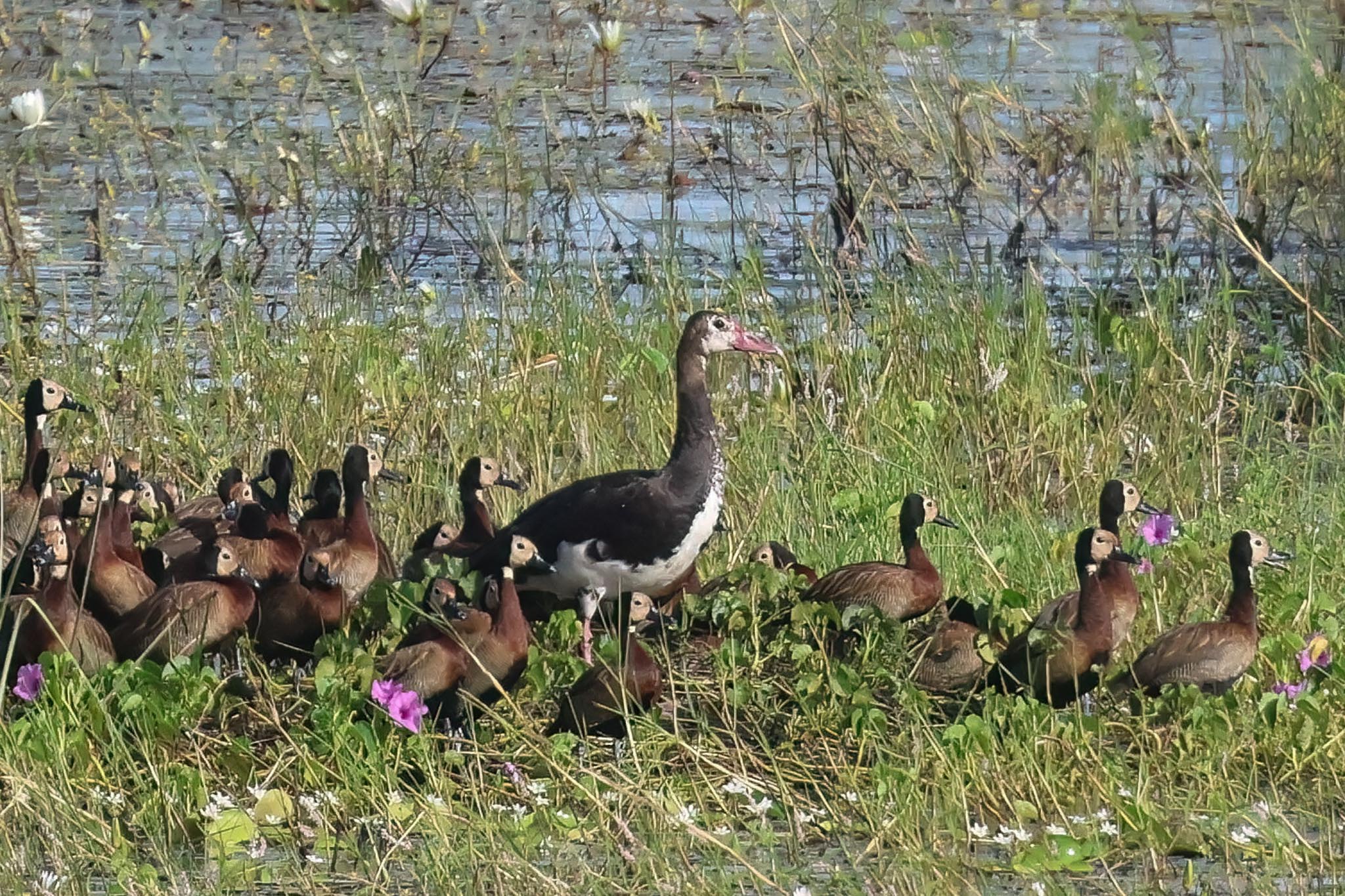
There were birds everywhere – lots of Pied Kingfishers and a pair of Malachites, another pair of African Swamphen gave better views now, Black-winged Stilts and Common Sandpipers picked around the edges and a pair of Common Snipe flew over and dropped into the vegetation. Lots of herons and egrets, African Spoonbills and Pink-backed Pelicans were perched in the trees and three African Sacred Ibis dropped in too. A Little Grebe was diving between the waterlilies at the back, a Plain-backed Pipit flew over and a couple of large Nile Monitors were hauled out on the sandy banks.
As we cut in through the scrub, a selection of butterflies and dragonflies came up out of the vegetation. Several Tree Pipits came up out of the grass too, along with a couple more Plain-backed Pipits, one of which posed nicely in a small acacia bush. Other bushes held a young Woodchat Shrike, an Abyssinian Roller, a pair of Northern Crombec, a family of Green Woodhoopoes, and a pair of Striped Kingfishers. Several Yellow Wagtails were following the cows as they walked past us through trees.
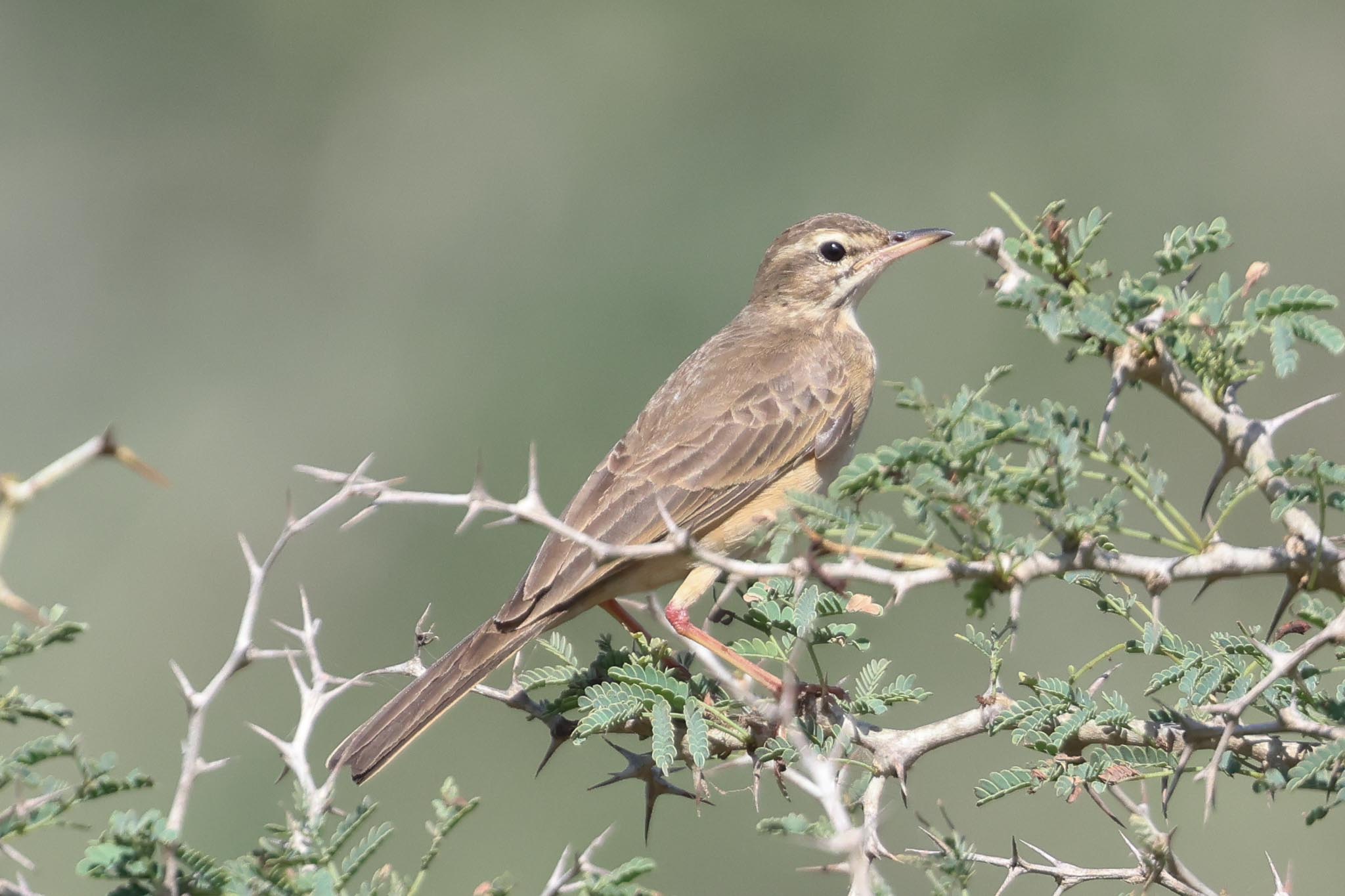
Lots of Blue-cheeked Bee-eaters were flying round, with more perched in the trees everywhere we looked, and a constant stream of swallows – Red-breasted, Mosque and West African, several Sand Martins and at least one Barn Swallow – flew round overhead. We picked up a single Pied-winged Swallow too, flying through the trees. The wet areas in the grass were full of more herons, egrets and pelicans. We stopped to look at a Grey Kestrel in an acacia tree, then turned our attention to a couple of Black-winged Kites, one of which was feeding on some prey and allowed us to get very close views.
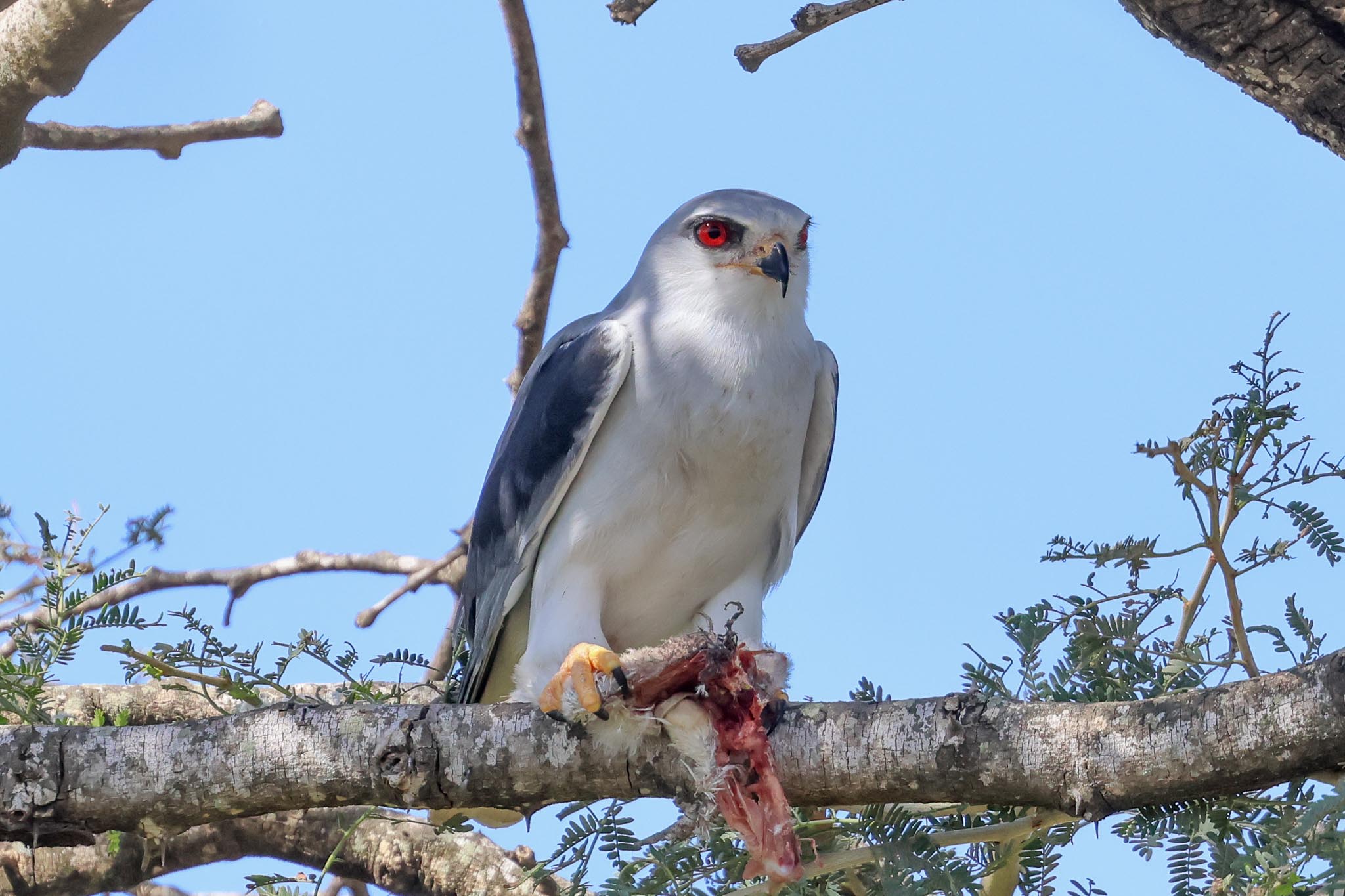
Down towards the edge of the mangroves, we found a couple of Western Subalpine Warblers and several Western Olivaceous Warblers in the bushes. Spur-winged and Wattled Lapwings were out on the mud beyond, along with lots of Fiddler Crabs. One of the group spotted a distant Beaudouin’s Snake Eagle hovering over the scrub now and it was joined by a second, the two of them gradually working their way closer. An African Fish Eagle drifted over high too, stopping to circle with a kettle of Hooded Vultures and tussling at one point with one of them.
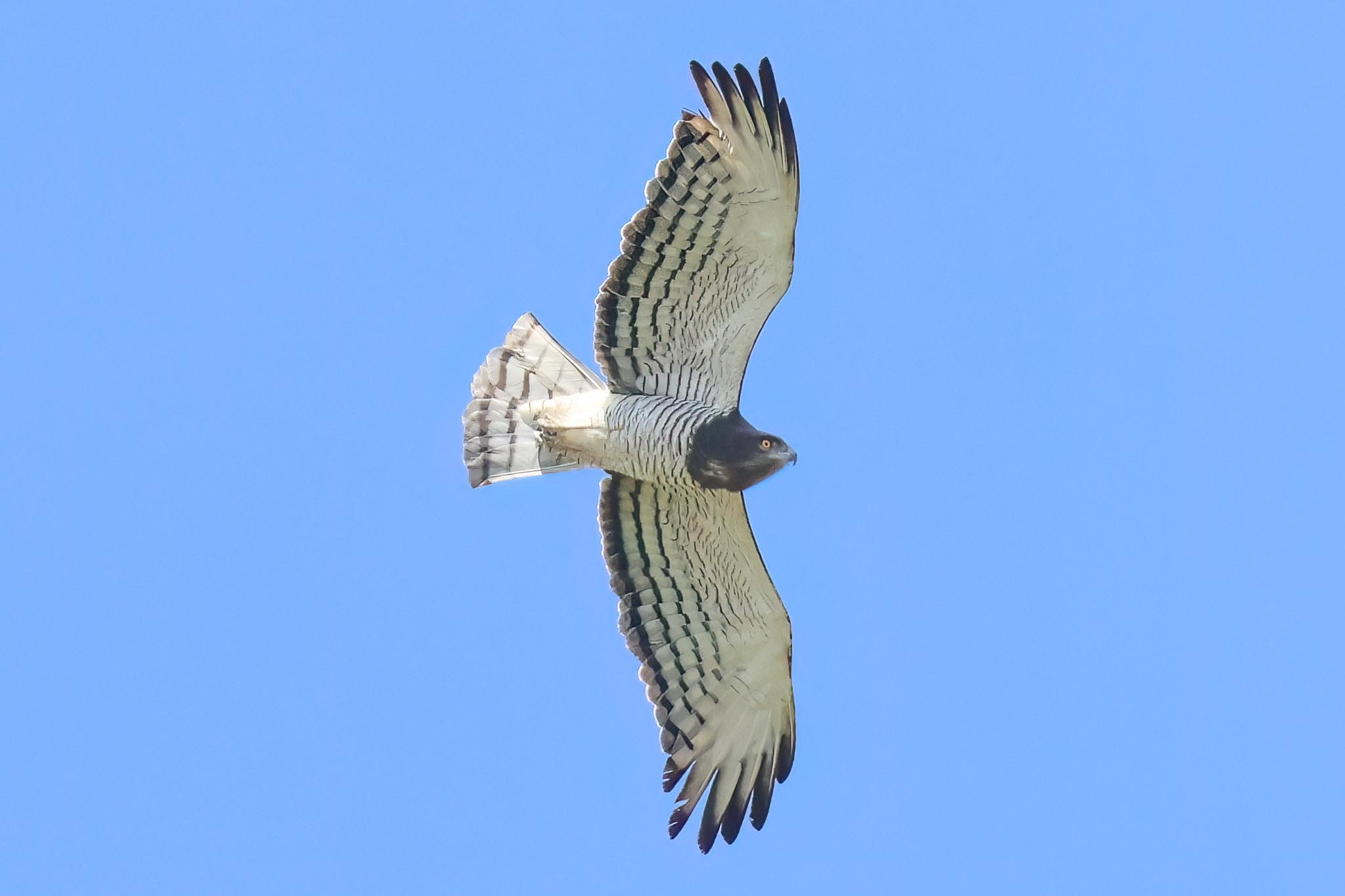
Modou was suffering with bad toothache, but still managed to locate a Grey-headed Kingfisher, which perched in a bush, and when we stopped to see what else we could see on the edge of the scrub here, as well as the usual warblers and Gonoleks, a Red-shouldered Cuckooshrike shot across and disappeared into a tall tree. It was impossible to see in the foliage, but then flew back out and across in front of us a second time, flashing its red shoulders.
Back out by the main track, several Little Bee-eaters were in the bushes, along with a Singing Cisticola and another Subalpine Warbler, and as we walked down towards the beach, a Nightingale was calling from deep in the scrub. Lots of insects in the low vegetation along the track included African Grass Blue butterflies and Blue Basker dragonflies.
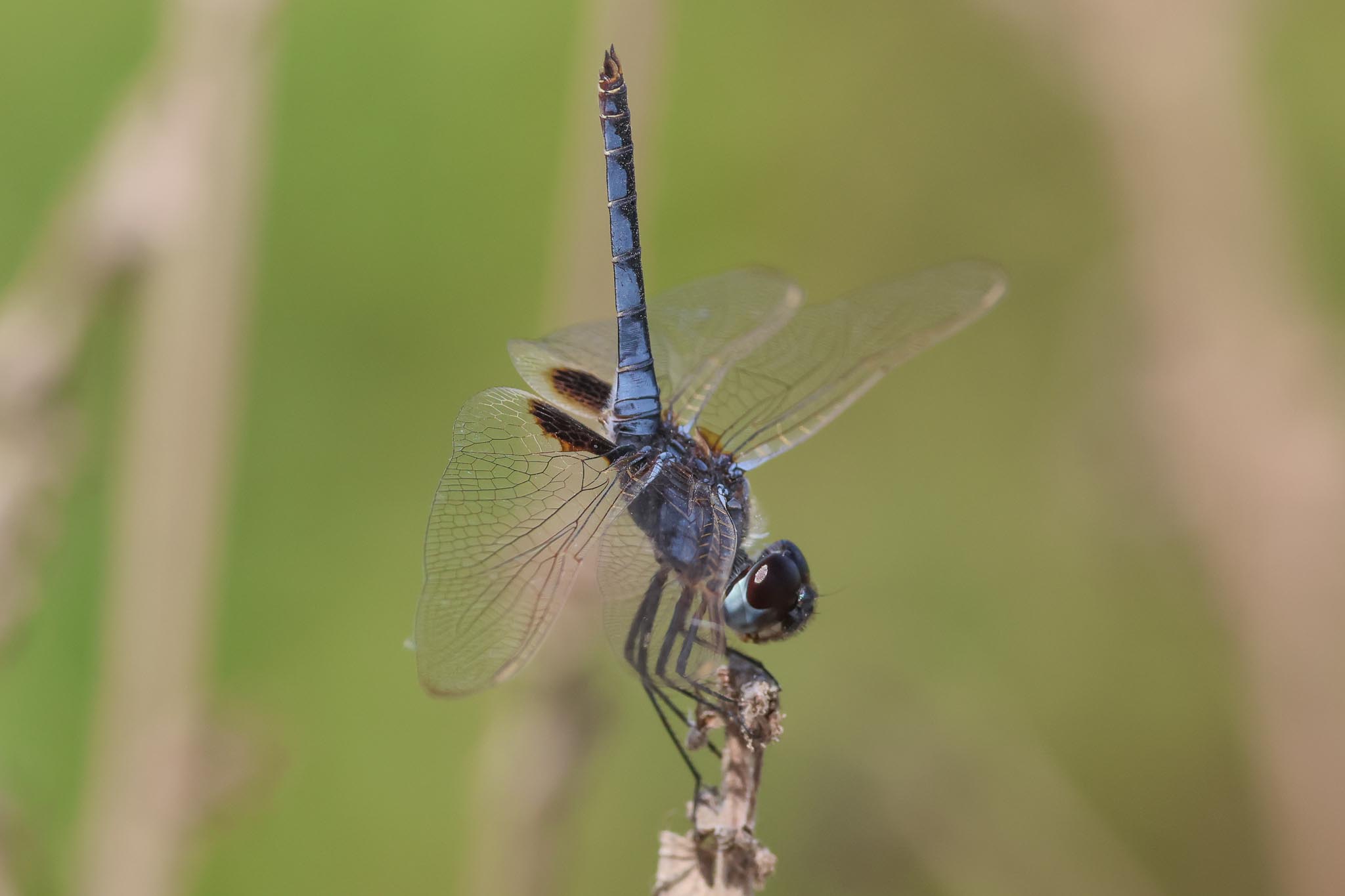
There was some welcome shade at the ‘Refreshment Centre’, a shack on the beach, with a selection of cold soft drinks available and delicious fresh orange juice squeezed in front of our eyes. Very much appreciated after the long walk down through the scrub. From the shelter, we could see a selection of waders on the rocks just offshore – Turnstones, Sanderling, a single Grey Plover and Whimbrel, and a Ringed Plover. A Northern Wheatear appeared briefly too, before flitting on down along the beach. Several Sandwich Terns flew past just offshore.
After a rest and a drink, we walked on down along the beach. Several White-fronted Plovers were on the sand, with a pair on the top of the beach, which gave nice views of male and female together in the scope.
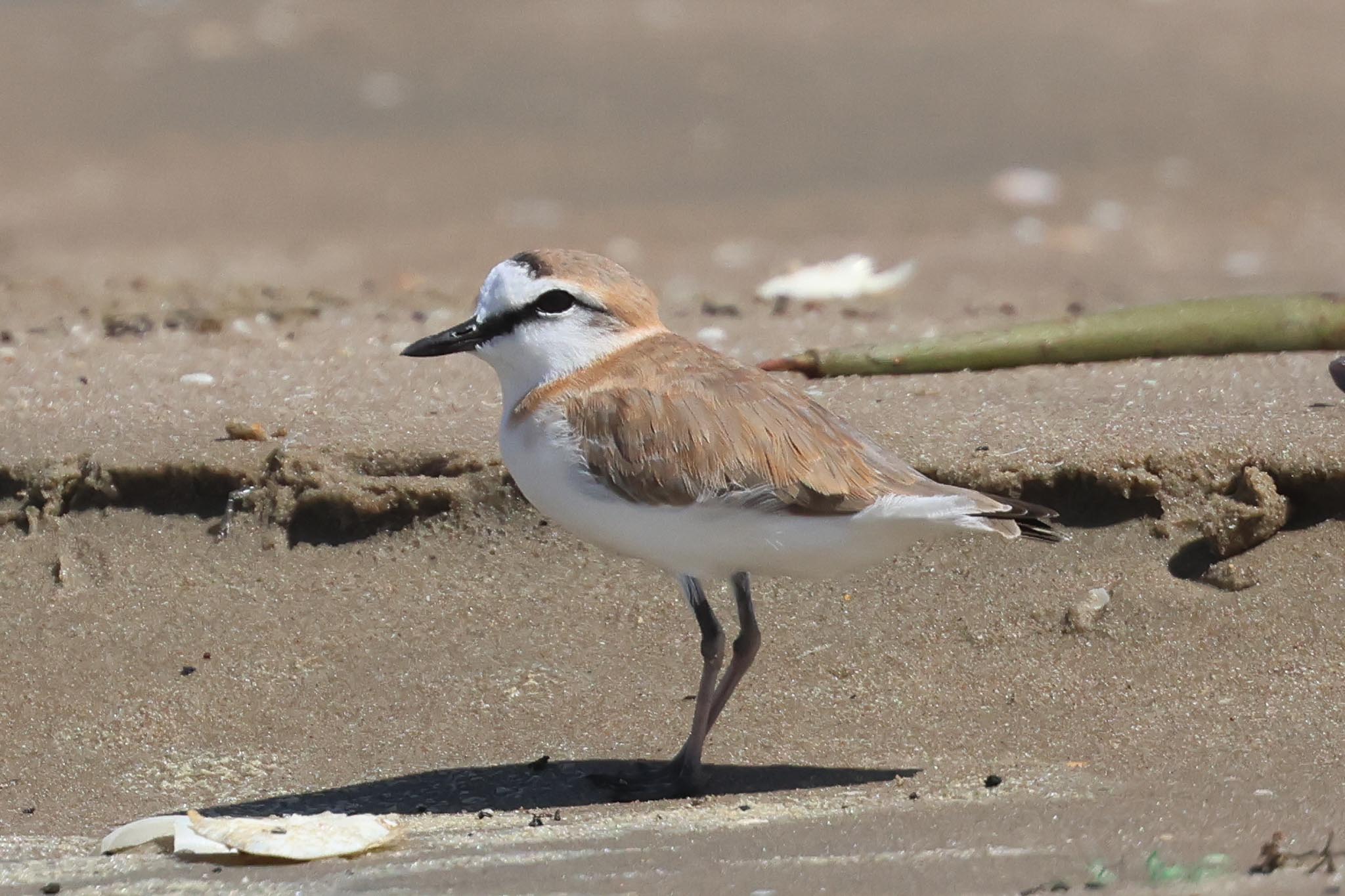
Lots of Western Reef Herons and a couple of Long-tailed Cormorants were lurking on the edge of the mangroves behind and several Oxpeckers were riding on the cows which had now come out onto the beach.
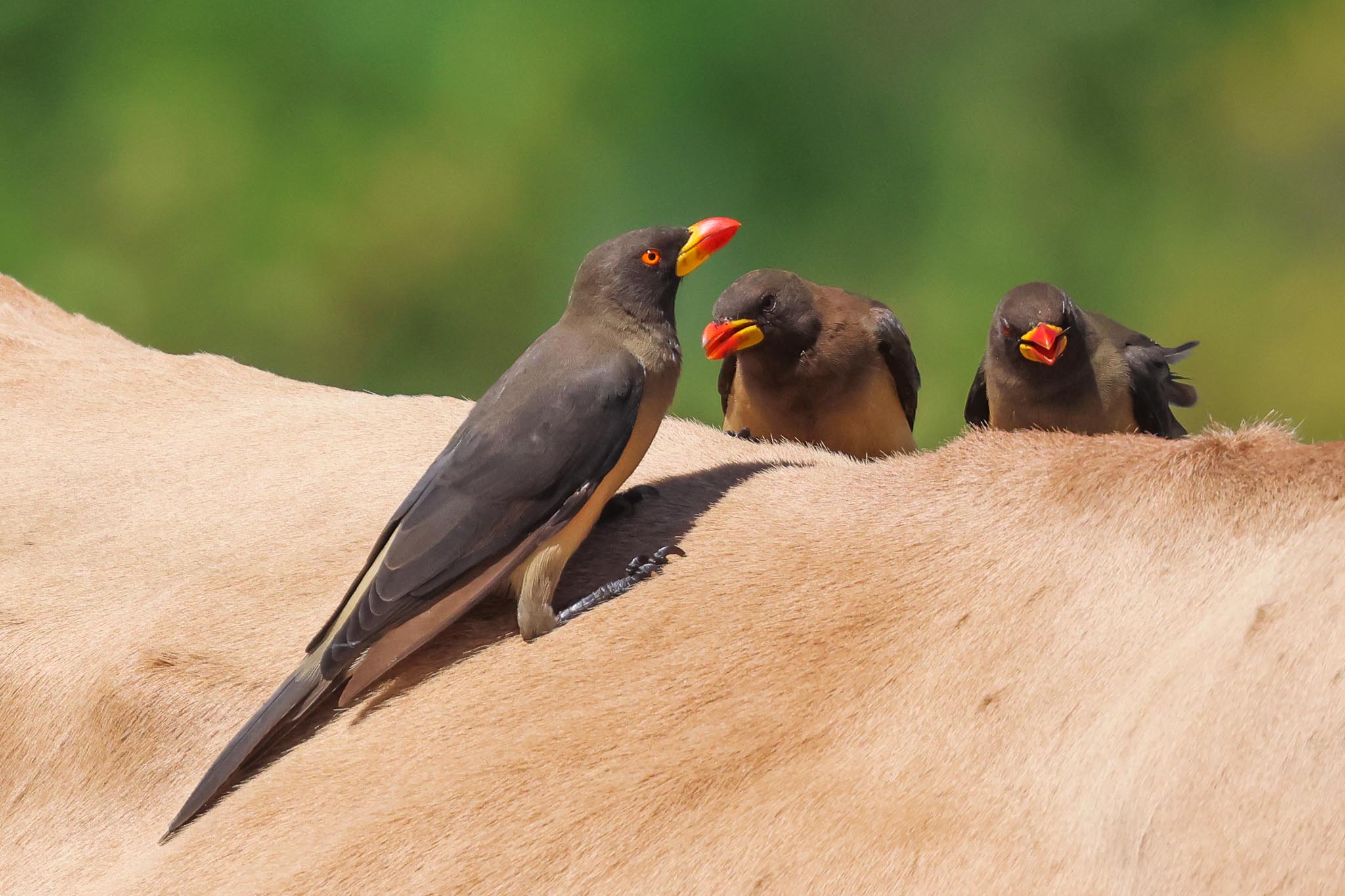
Further down, there were lots of birds gathered on the shore. We walked down for a closer look, and found a large roost of gulls and terns – large numbers of Caspian, West African Crested, Sandwich and Common Terns, plus a group of Lesser Black-backed Gulls. There were more waders too – a large flock of Whimbrel with a few Bar-tailed Godwits, Grey Plover and Redshank. Four or five Oystercatchers on the sand were new for the trip list.
Back up the beach, we got out of the sun again in the beach shack and scanned the sea. There were still mainly terns passing offshore, plus a few Pelicans but then we picked up a distant Arctic Skua chasing a tern before it succeeded in getting its target to give up its food and dropped onto the sea.
The bus had driven on to meet us down by the beach, so we climbed aboard and drove back up the track. We still had a little time before lunch, so we kept stopping to scan the pools from the bus – there had been some Pygmy Geese here a couple of days ago, but we hadn’t seen any sign of them on the way down. At first, we found a Black-tailed Godwit in with a large mixed flock of herons and Sacred Ibis. A mixed flock of egrets allowed nice views of Intermediate and Great White Egrets together for comparison, plus several Cattle and a couple of Little Egrets too. Then scanning across through the White-faced Whistling-Ducks we noticed a paler, more tawny brown head in one of the flocks. A Fulvous Whistling-Duck! Rare in the Gambia, and the first record for Kartong, everybody piled off the bus now for a look.
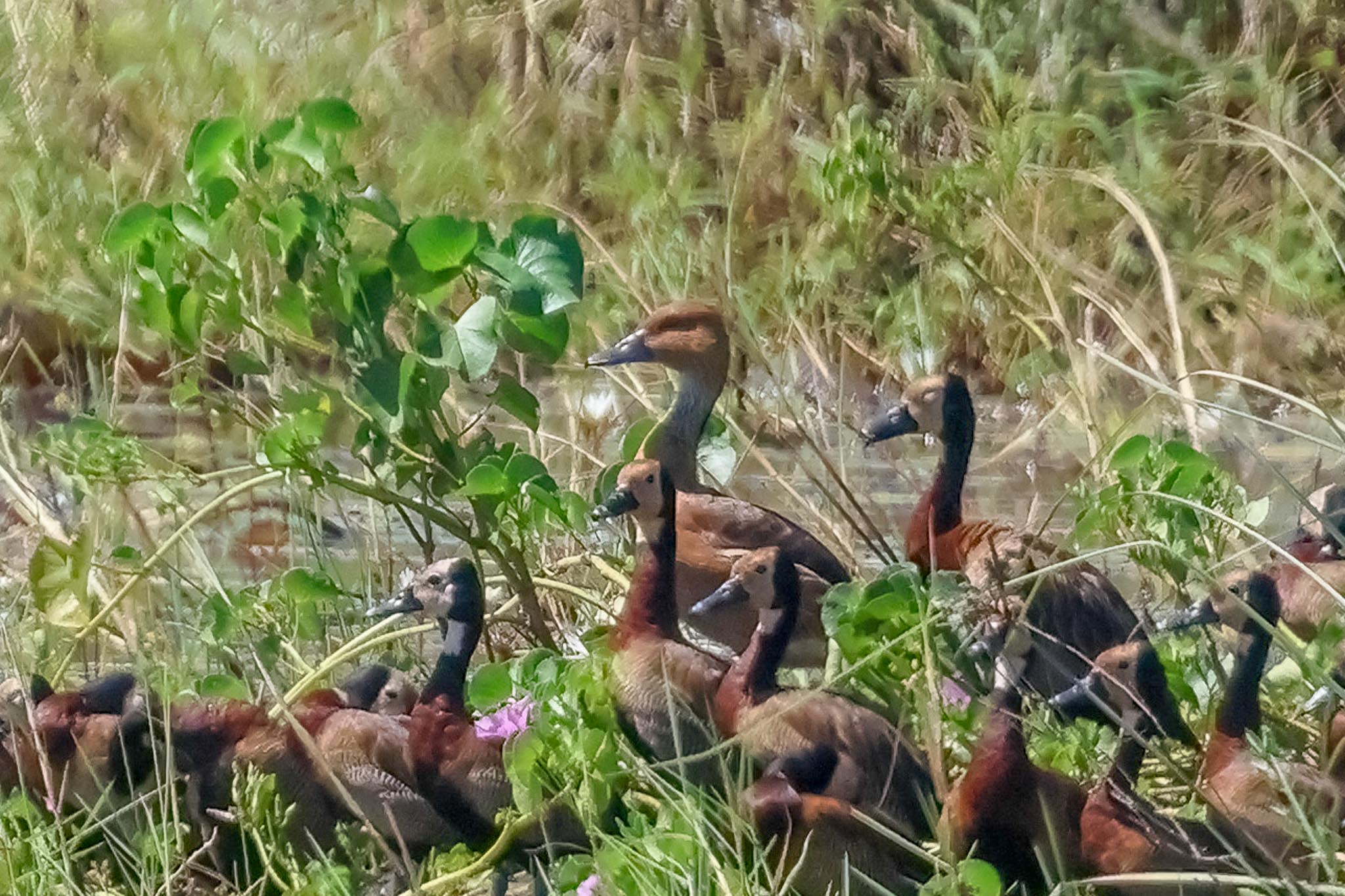
After that excitement, it was now time to head round to Stala for lunch. Lots of Fiddler Crabs scuttered over the sand as the bus weaved round the edge of the mangroves. The tide was high, but scanning the river in front of the lodge, we found Whimbrel and Greenshank, plus a few Grey-headed Gulls. As we tucked in to another delicious lunch on the terrace, possibly the best yet, an Osprey flew past. After lunch, while we were waiting for our boat, we scanned the edge of the mangroves and were rewarded with a Mouse-brown Sunbird which came in to the call of Pearl-spotted Owlet.
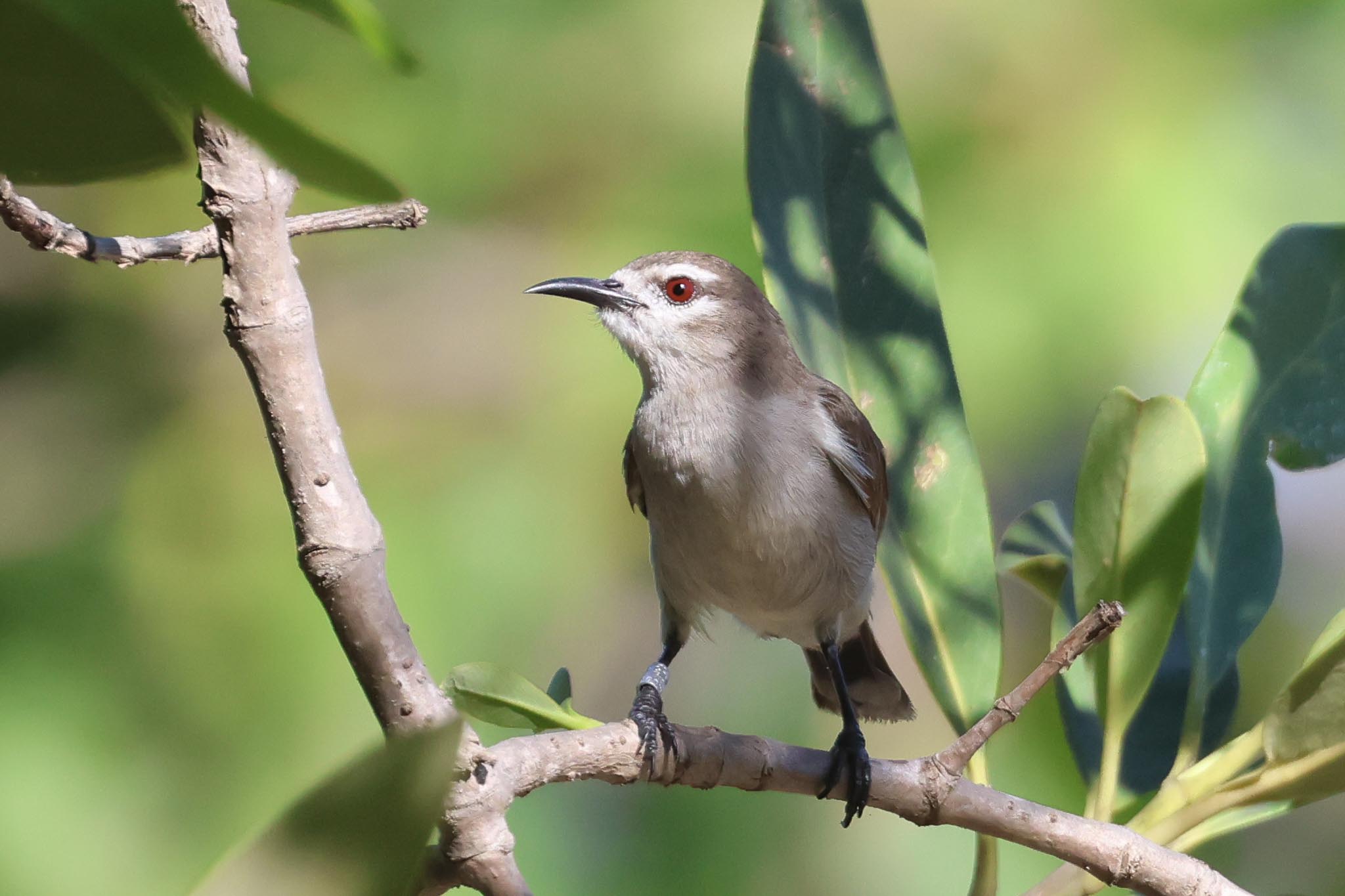
It is not normally ideal for a river trip with the tide high and not so much mud, but we hadn’t gone very far when Modou noticed a Goliath Heron tucked in the edge of the mangroves. The boatman cut the engine, and we had a good view as we drifted past. Continuing on upstream, there were a few waders still, despite the tide – Whimbrels, Greenshanks, Common Redshank, Senegal Thick-knees. We managed to find a few Atlantic Mudskippers too, on the areas of mud which were still exposed.
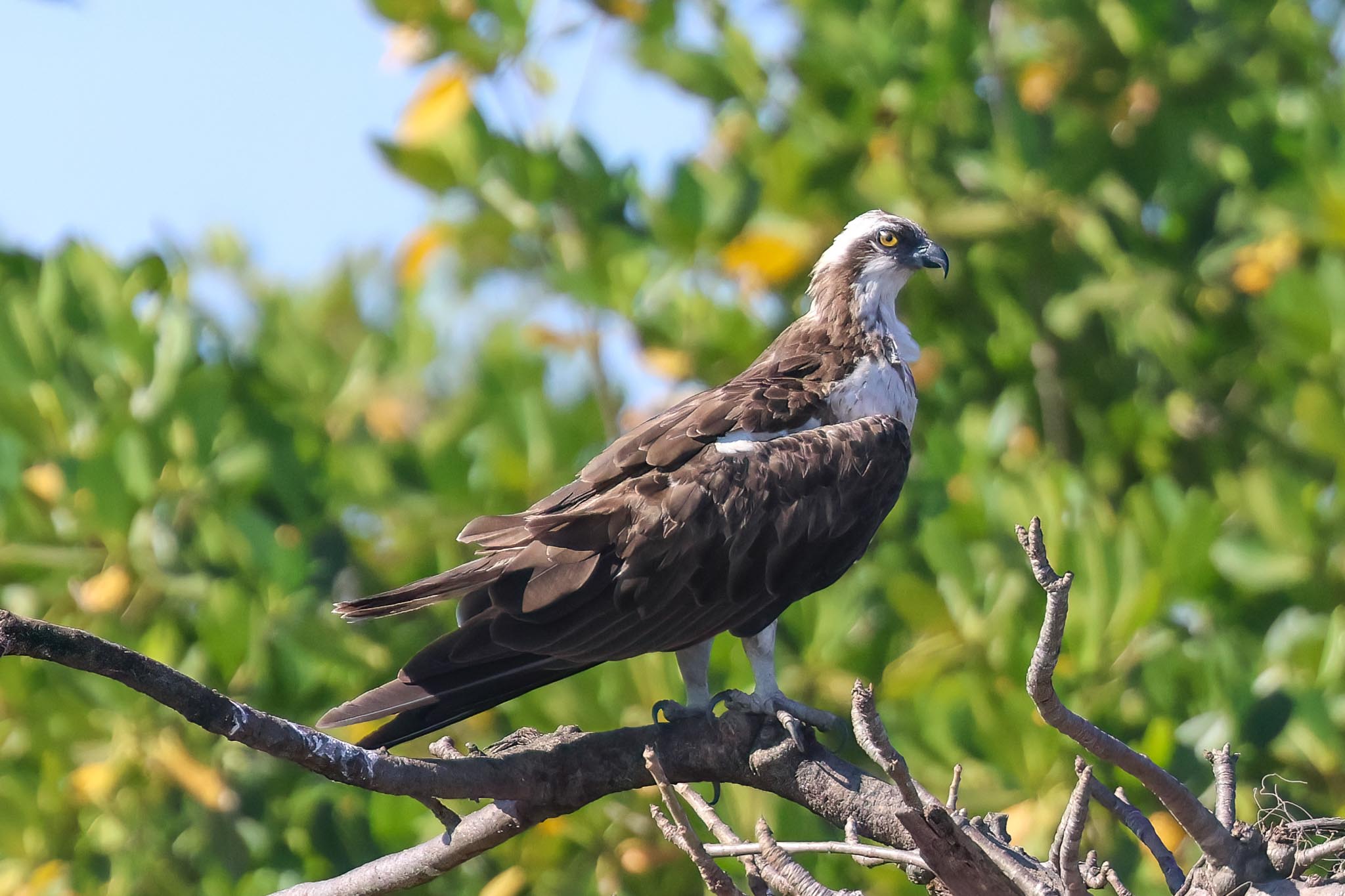
A succession of Ospreys flew out of the mangroves ahead of us, dipping down and dragging their feet though the water behind them – were they cooling themselves? We went a bit further up the river to try to find Yellow-billed Stork, but they were not in their usual favoured tree, although a Pink-backed Pelican was instead. Fortunately, as we turned to come back, one of the group spotted two Yellow-billed Storks circling over the Senegal side of river.
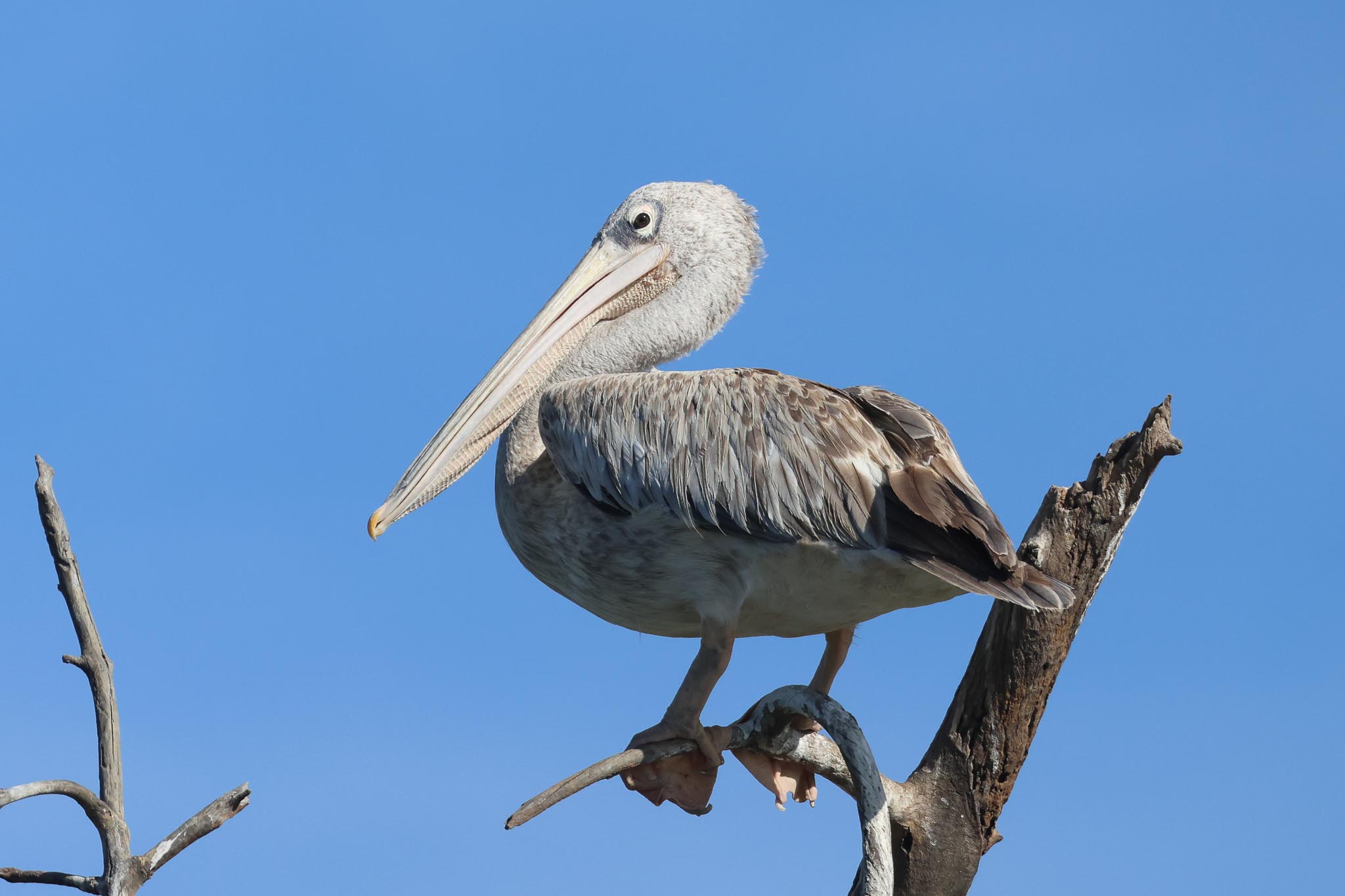
A Rufous-crowned Roller was perched in a tree on the bank, a couple of African Harrier-hawks and a Palm-nut Vulture circled up, Giant Kingfisher and Blue-breasted Kingfisher flew across and as we passed on our way back we had good views of the Goliath Heron again.
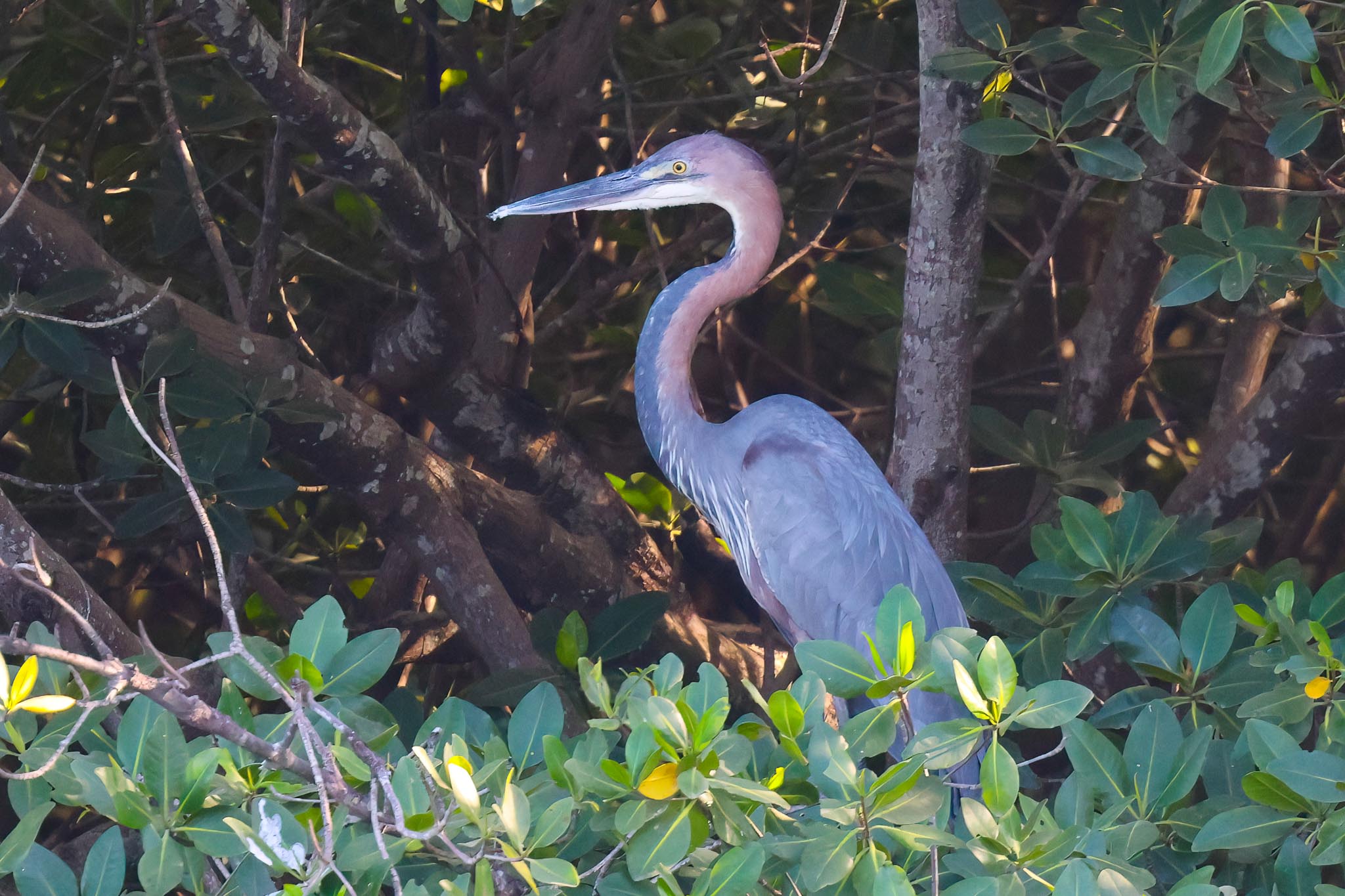
We boarded the bus again back at Stala, and droving out through the mangroves a young Diederik Cuckoo was flapping around on the track. It was wet from the puddles, but didn’t seem well either, so our driver picked it up and put it in the bushes out of harm’s way. Even though it was already the time we would normally be making our way back, as it was our last evening we decided to make the most of it to try to catch up with a couple more birds on the way back.
We stopped first at a track through some cultivations, and had a short walk. A Splendid Sunbird and Willow Warbler flitted around in a flowering tree, and a couple of Double-spurred Francolins flew up but dropped back down out of view. We checked round a couple of fields and eventually found the pair of White-fronted Black-chats we were looking for here.
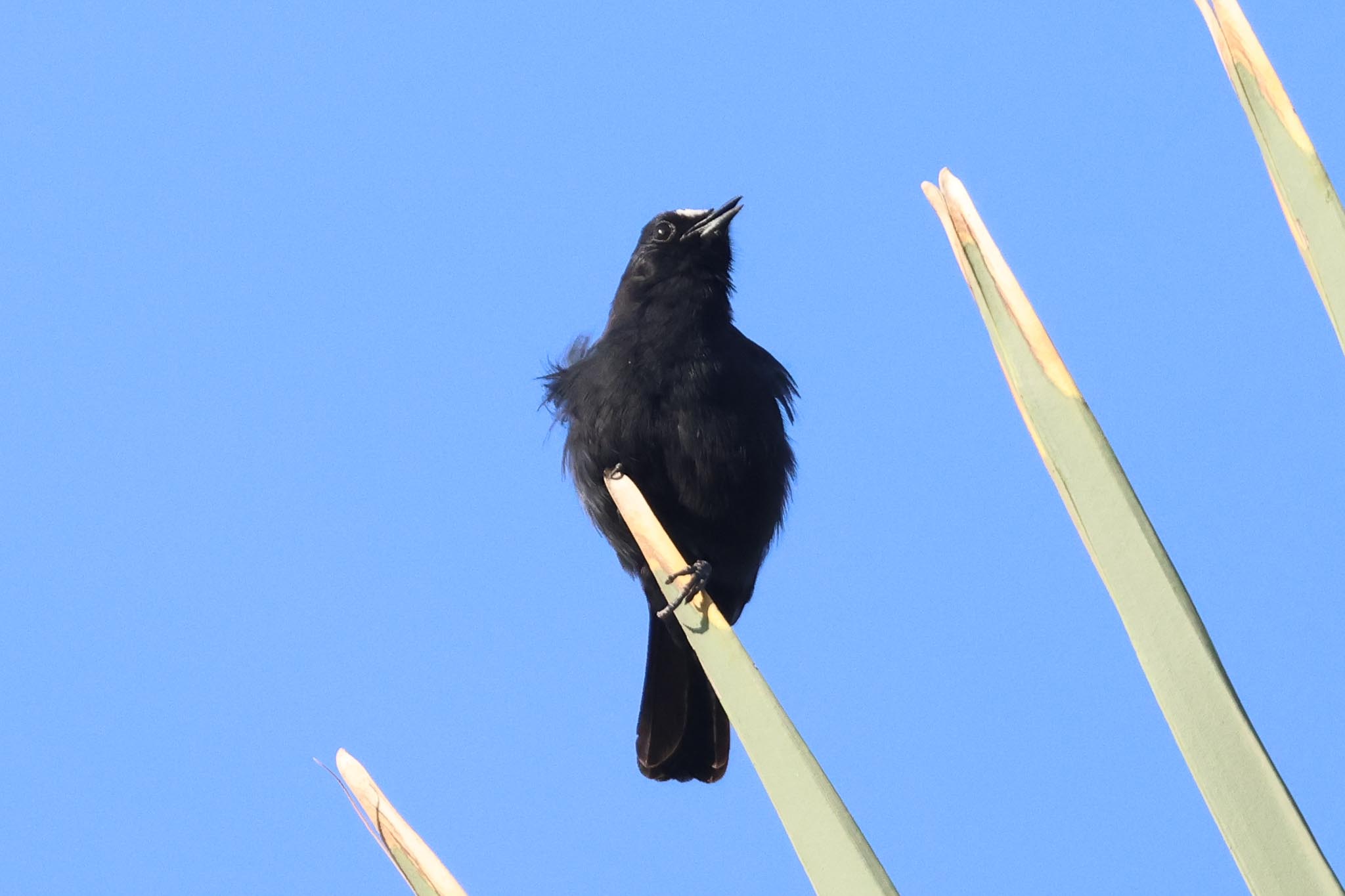
As we walked back towards the road, we were hoping we might run in to some different weavers too, but all we found around the cultivations now were more Village Weavers. We tried the call of Pearl-spotted Owlet again and a Whistling Cisticola flew up onto the wires, several Yellow-fronted Canaries appeared, along with a Yellow-crowned Gonolek and a Snowy-crowned Robin-Chat, but no more weavers.
Back on the bus, we turned off the main road again at Tujareng. As we drove down through the scrub, we could see an amazing sunset out over the sea. Several Ospreys and a couple of Black-headed Herons were perched in the trees. We were hoping to find Chestnut-bellied Starling here, but the light was going fast now and we drew a blank at the first place we stopped. Driving round to one last spot to check, a starling appeared on a bush by the track, and by luck was indeed the Chestnut-bellied Starling we were looking for. We got out to check, but we were looking into the setting sun and the bird was silhouetted, so we edged round to the other side and could finally see its chestnut belly properly. A good bird to end the day and the main part of our birding here.
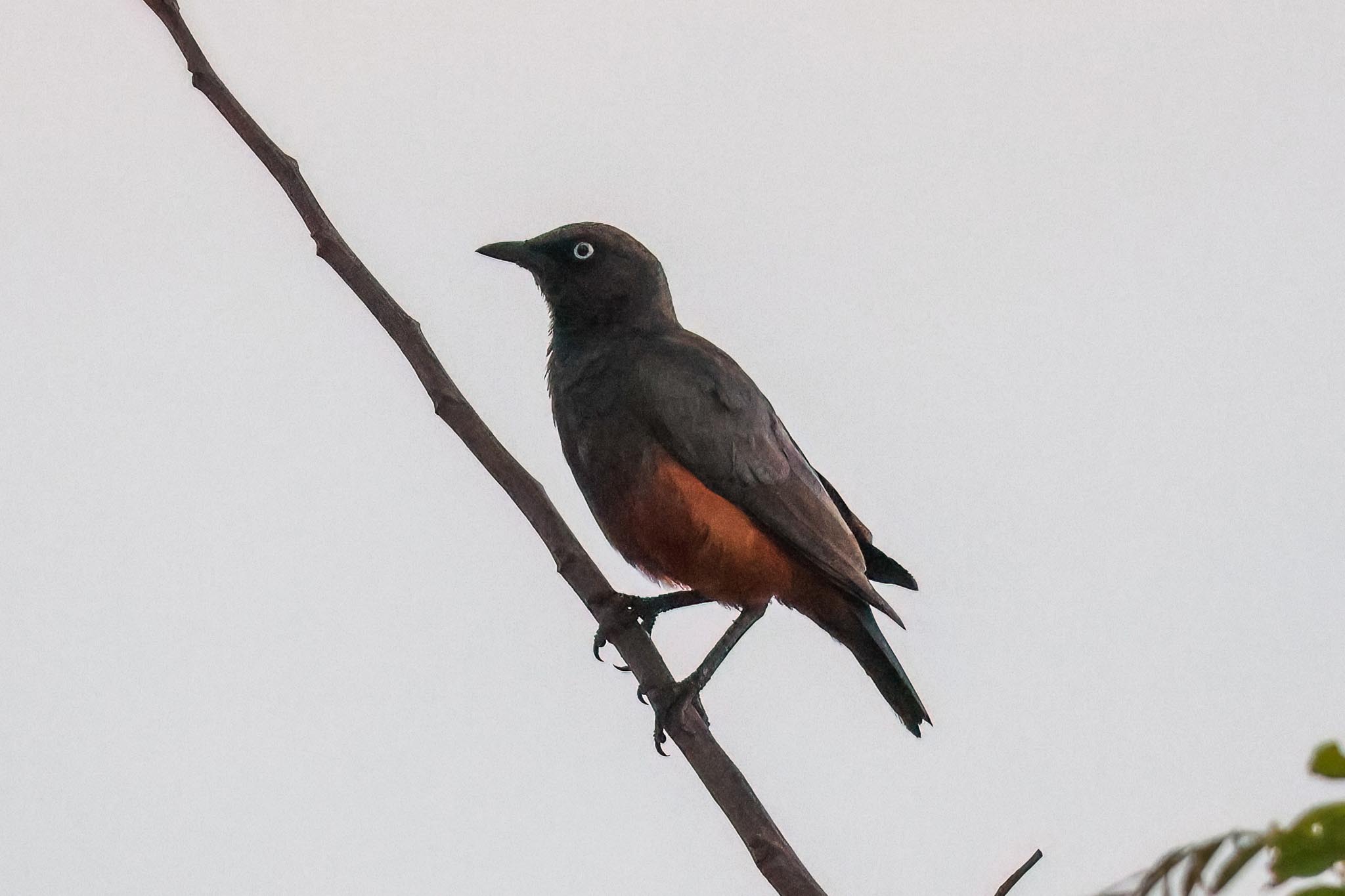
The sun had dipped below the horizon and it was getting dark, so now we had to call it a day and head back to the hotel. Despite it being later than normal, the traffic was still bad where we had to come off the new road and try to get round the dusty side streets. Rush hour doesn’t end at 6pm here! When we got back to the hotel, we stopped to say goodbye to Modou and our driver and thank them for all their help, and Modou Taal came over to wave us off too. Then we had a chance to quickly freshen up and met for our last dinner down by the pool.
FRIDAY 24TH NOVEMBER – Clear skies, bright & sunny, 36C
With a morning free before we had to catch the bus back to the airport, we had the option of a more leisurely start today, but several of the group were still up as usual for breakfast at 7am. Afterwards, we had a chance to wander round the grounds again or take a swim. The usual birds were around the hotel buildings and we had a bit more time to appreciate them now, lots of Hooded Vultures and Yellow-billed Kites in the trees, and a couple of Broad-billed Rollers trying to chase the kites out of their favourite tree over breakfast.
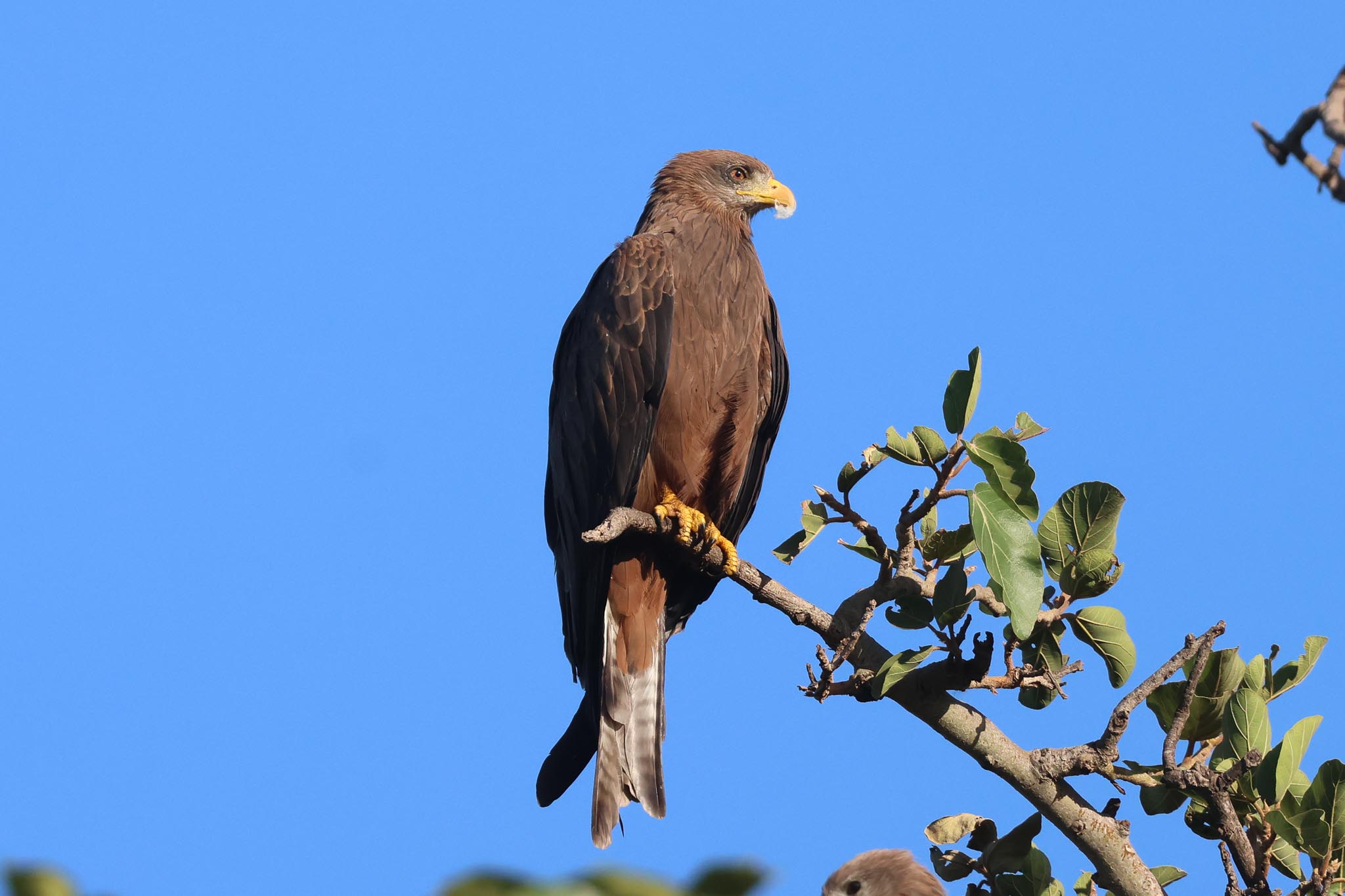
Walking down past the pool, a group of five White-crowned Robin-Chats were in the grass, with Common Bulbuls calling in the tree above.
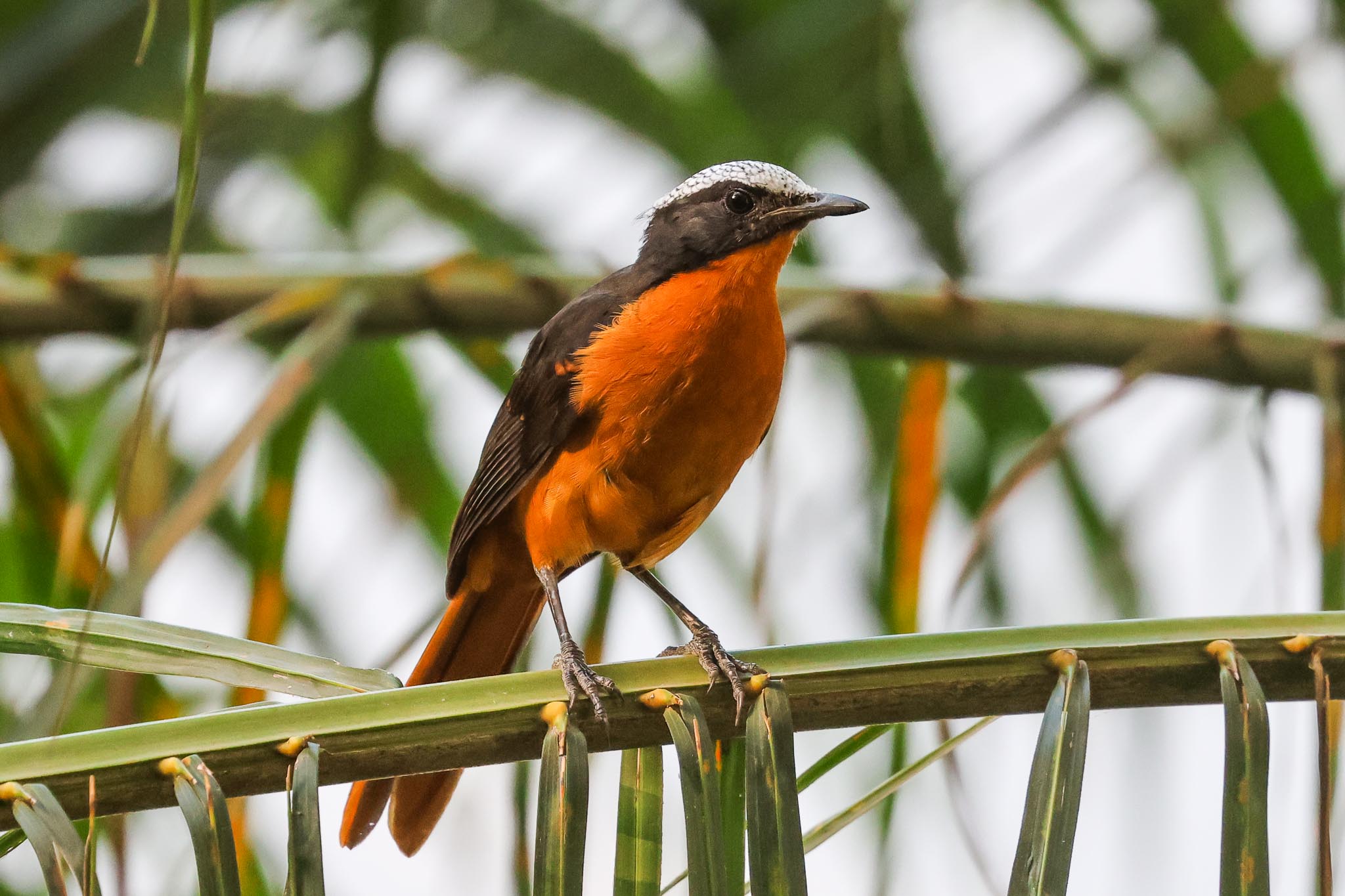
Several Western Plantain-eaters and Western Red-billed Hornbills were feeding on fallen fruit in the trees behind the beach.
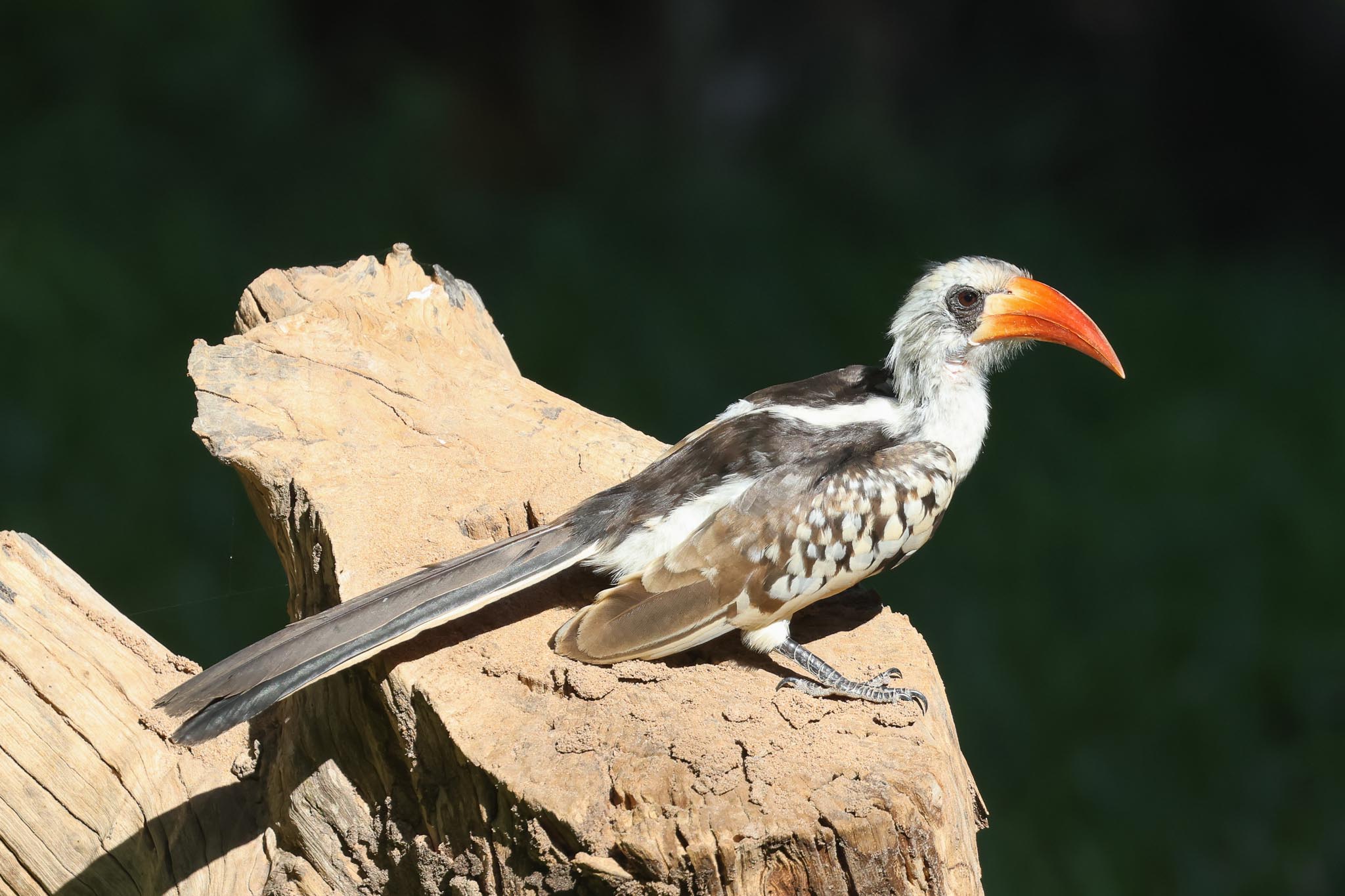
A group of Piapiacs came to one of the sprinklers for a bath and a drink, followed by several Red-eyed Doves.
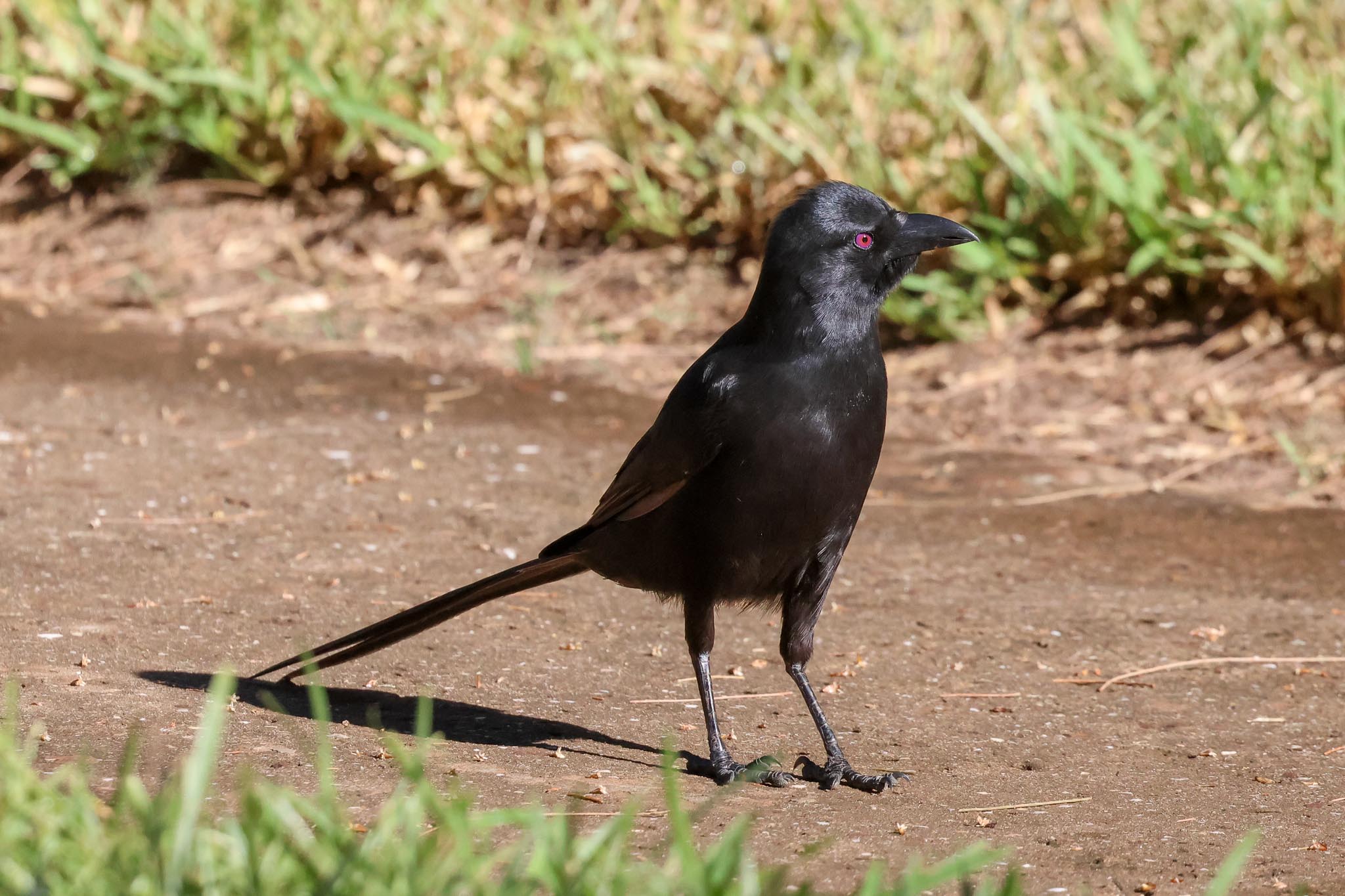
Long-tailed Glossy and Bronze-tailed Starlings were hanging around the beach searching for scraps. Looking out to sea, a few West African Crested Terns and White-breasted Cormorants were passing by, some very distant Yellow-billed Kites were circling offshore, and two or three immature Northern Gannets were plunge diving too though a long way out, a last minute addition to the trip list. Back into the gardens, a group of Blackcap and Brown Babblers were chattering in a clump of bamboo with a couple of Yellow-crowned Gonoleks.
Then it was time to pack up before we met for a quick bite of brunch down at the beach bar, for those who wanted it, then back up to reception to check out. After a short wait before our bus, we arrived at the airport to find it not very busy, so got through check-in and security very quickly. We had a slightly longer than expected wait at the airport – the inbound flight was about twenty minutes late arriving, and then the staff discovered they were short the right number of meals on board for the return flight. We finally took off at 4.40pm, about 40 minutes later than scheduled but made good time on the way and landed at Gatwick only 15 minutes late.
Unfortunately, when we got to the terminal none of the ground staff seemed to know how to operate the airbridge so we were all stuck on the plane for another 45 minutes. Apparently they couldn’t bring steps up to the plane either because the door to the terminal was blocked and we wouldn’t be able to get in. After more and more vehicles with flashing lights had arrived and more and more people in high viz had stood around scratching their heads, finally a bus with three engineers on board drove up. One of the engineers climbed up the steps to the airbridge and manoeuvred it straight over to the plane – maybe the others had forgotten to disengage the handbrake! At least the delay meant our luggage was waiting for us when we got to the carousel and we said our goodbyes and headed off into the chilly night, a bit of a change from the balmy nights in The Gambia!
















